TAPE 80/SHJ/01
THIS TAPE HAS BEEN RECORDED ON MAY 15TH 1980 AT 119 BURY ROAD, HASLINGDEN. THE INFORMANT IS ROLAND TAYLOR, JUMBO OPERATOR AT SPRING VALE MILL. THE INTERVIEWER IS MARY HUNTER.
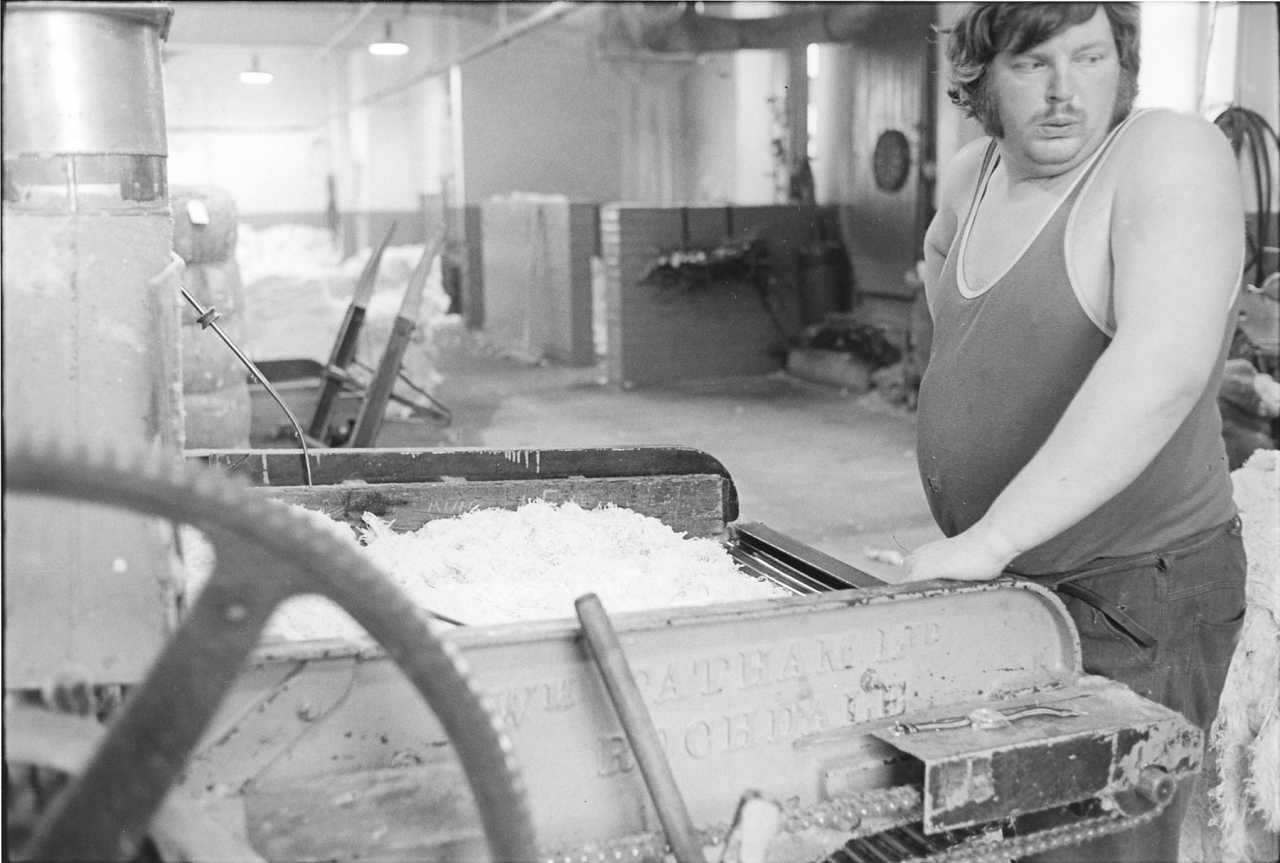
Roland working on the jumbo breaker.
What sort of work did you do at Spring Vale, Roland?
R- That's a good question. Starting wi’ weft carrying, that is take the empty trucks into the spinners, and take the full weft away, the pirns when they were full, I used to take them and load them on the wagon. And after that I went on to the baling press. I were on there what? Perhaps six years on the baling press.
Is that the press where the stuff came through after it's been blended?

The baling press.
R – Yes. It's a press, it bales it up .. well bales anything that they want baling up. And after that I went upstairs like, I were on putting the mixings down. I were on the Jumbo, unloading the wagons, like there used to be a lot more wagons of bales coming in then than what there are now. Well there were like you could have said a ... what? At least one wagon a day come in with what’s like the bales that we make on the press now, but then we used to have Lambert's, they used to be running that down to Carr’s, Flash used to run, Grane Road run, and Higher Mill run, we used to keep them all going. (50)
Did you?
R - In fact Paul wouldn't have done it, he wouldn't have made enough bales to do it.
Who wouldn’t have done it?
R - Paul that’s on now. Now in fact the lads that’s on the blender now wouldn’t have done it. Like when I were on there we used to do thirty-six a day, and normally twenty on Friday because we used to stop about two o'clock Friday to clean.
By thirty-six you mean thirty-six of those big bales that are on the pictures?
R - Them ones that are in the warehouse then yes.
Good heavens.
R - Well they’re lucky if they do twenty now, they are lucky if they do twenty a day, when we were doing thirty-six and you needed them because we used to go through, of a day, work it out for yourself, forty eight a week to Grane Road, thirty six a week to Higher Mill, thirty six a week to Lambert’s and twelve to Flash.
Lambert’s is a different firm altogether isn’t it?
R - Well it were their mill, but they traded under Lambert’s.
Oh I see yes.
R - In fact it's where I'm working now and it's called Gibb’s now and it is doing chemicals.
Ah so it's different again altogether yes?
R - It is.
So how long is it since you've not had to make that output per week? (100)
R- About six, seven years now they haven’t had to really push it. First with Lambert’s shutting, then with Flash not wanting them then with Grane Road spinning going out, they didn't need them there either so all you had were higher Mill. And once you shut that, well they were on a doddle, two days really would have been enough.
So presumably then you were asked to do all sorts of different jobs, and you weren’t just on the jumbo then.
R - Well you kept mostly on that you see, you had a hell of a lot more time to yourself where like before you just didn’t have time. Like you start, like even now I’m not, I weren't allowed to set the Jumbo on at half seven if it were Winter, because it took the power off the devils, and it ... Well he said “Set the other buzzer on” and if that buzzer went off it would stop the devils because your electric load were too high. You were using too much of it you know. See ours were rather expensive to run, so if I had me jumbo going, which I think it’s in that motor on top, it's a bigger motor than almost anything else in the mill.
Oh yes, definitely yes.
R - So if you get that and the devils going as well as all your mill running. Well in fact we used to do it on purpose sometimes just to get a break to do another job .. till Johnny twigged what we were up to.
That's John Greenwood is it?
R - Right. He weren’t green weren't Johnny. Green be name may be but not be nature!
So I shan’t go and play him the tape?
R - No he knows. In fact he said “I know what you buggers are up to. Cut it out! Don’t run that till after half eight. I know what you're up to, you want to have it stopped because of you!” See ... like I could run it even then and not fire the overload alarm off if I took it nice and steady, just so that I could feed on. But I wouldn't, I didn’t believe in little feeds in there, get it through. So you like then, with doing thirty six bales a day you were having to put at least one mixing a day down, at least one right? And this last time you could go two days without putting a mixing down, and then you had to put at least one down a day. And you know you've got one, two, three, four, five, there were six mixings down then.
What do you mean by mixings Roland?
R - You know where you've got bales down at each side of the machine?
You don't mean the Jumbo, you mean the blender don’t you?
R - The blenders yes.
Ah yes, right. So when you say 'putting a mixing down’ what do you really mean?
R- It’s putting a blend of cotton bales that we’ve been getting. So you can get them from Japan, China, Africa or even Russia. See you’ve got a, a blend of, like you've got good long fibres and you’ve some of them are short. So you want a blend, so you've got a firm mixture, and a bit of dark cotton, a bit of light cotton .. like each country has a different coloured cotton. Yes you’d think there isn't but it is different coloured cotton from each country. So you've got them down so you get at a fine blend between the lot.
The material that you put through the jumbo what sort of quality is that?
R - Well that’s stuff that’s already been used and it's like cop ends and then there were cops that were no good and then they throw them (200) out. Well we fetch it and break it up and put it through so we can run it through again. So we keep on using the stuff. Like it's not a first use cotton place it’s a waste cotton place. Somebody else's used it before we can get hold of the cotton.
So you could have full threads in there all matted up together that have to be broken down?
R - Yes.
Anyway we got a bit sidetracked there, but it doesn't really matter. So if it came down to giving you a title for the job that you did at Spring Vale that would probably be rather difficult to do, wouldn’t it?
R- It would. All round worker's more like it.
Yes because I would have said that you were the operative, or whatever the word is for that machine but since talking to you I’ve realised that you’re Jack of All Trades.
R - There were a bit more involved. Like even with, when on the jumbo, like you’ve got your jumbo to run. Really, when I first went there that were a part time job, you know, “If you got a spare moment” job. But it got to such a stage when they were selling the devilled stuff, it got so as that were the main job, an your other got to be a ‘Do it when you've got chance job’. And when I first went there, well with the mixing, they were putting down like, well I’d say at least one mixing. Now we were lucky on them days when only one mixing went down, there used to be about two, they used to have two go out together if you got (10 min) (250) them two top machines going out together in an hour and a half to two hours, putting them two mixings down. Oh well, opening, you were putting them down and opening them. Say for .. you happen to have your stack low on your jumbo and you’ve got them out at the same time, you've got troubles, because you can't do both at once.
When you say an hour and a half to two hours, to fetch the right bales in?
R - Well you’ve to send them down from upstairs, and then wheel ‘em in and then open them.
Before you…?
R - .. they've all, they’ve all got to be cut, opened up .. you know your strings off. So your tare folds up on top. Because once you get them down here and you tip ‘em off. It you're going up against another bale you can't get behind to cut the tare off and if you can’t get the tare off you can’t use your bale, so you’ve got to cut your strings off upstairs before you send them down. Now when I use them I've got to cut all the wires off downstairs and some of them aren’t the easiest wires in the world to pull off once you've cut them. You’ve got to fiddle around with them to get them off. The wires aren't too bad, most of then would pull off, well easy for me, but with somebody who hasn’t got that much strength, they can sweat a bit just with them. But you get them bands, especially from the Arabic countries and they are all joints, they are not like one piece and one joint, they have a joints and so if you get some of them joints underneath and you try to pull it out it pulls into the tare does the joint so you've got to try and lift the bale and pull it out at t’same time, and it’s not the easiest job.
Now we know why you are in the job, with all the strength you've got.
R - Well it's the same when they actually land on the truck on that platform from upstairs. Now Arnold’ll tell you this, him and Fred Lewis, him that used to be overlooker’s mate. Now he's, Arnold were the overlooker and Fred were his under man, stood right where Bill is now, or was. Well they were saying you see “You've got it easy!” I said “It’s not as easy as it looks, because I make it look easy to pull that.” And Johnny had just put one down, sent one down on the truck so I said “ You think it's that easy Arnold, there's the truck, pull it in for us!” And Fred and Arnold together couldn't pull that bale up over that step, because there's an inch step from that platform up on to, into our floor. That platform were an inch lower down than what the floor were. So you've got to pull up once and now .. they hadn't got the idea to run forward and pull back, they’d just picked up and pulled it slowly. If you're going slow you know, like in a car it
(300) you hit a kerb going slow, you’re not going to go up, you’ve got to get a bit of speed up to go up over it. Well they put it down and left us to it and they never said a word for at least twelve mouths afterwards didn’t Arnold about how easy my job were.
Yes, that's it.
R - In fact ever after that he never actually got on to about how easy it were, he’d say I had plenty of time to meself but he never said me job were easy.
So, two hours to put the right number of bales down, that’s before you even start the blending machine off.
R- Yes that's before you can set them on. Like .. with us having a mixing on either side it didn’t actually stop us ‘cause you, they could use that other one. But you had to get them down before they used that other mixing up, 'cause if they used the other side as well then the whole lot stops until you get the mixing down. While if it's taking you a couple of hours to get enough down then they are going to be stopped for two hours which in about ten bales.
And why was it that you were responsible for bringing those down rather than the people who were working the blending machines?
R – Well, yes, if you were working the blending machine you can’t go, you'd have to stop them again to get them bales down. Well if you haven't the bales that you wanted, you just hadn't time to stop them to put mixings down so you had the job of putting them down for them.
Yes, right. All this of course could have come with the photographs, but we've got so carried away with… (15 min)
R - Probably could and all.
Now I'd better ask you, and I should have asked you right at the very beginning, if you don't mind answering this question. When were you born Roland?
R - Twenty sixth of February nineteen forty seven.
Twenty six of February nineteen forty seven. And you told me before we started that you’d been working at Spring Vale for fifteen years.
R – Yes, I’ve done 15 years.
So that must have been your whole working life.
R - Well most of it. I did two and a half years at Porritt's before I went to Spring Vale.
Porritt’s?
R - Porritt & Spencer’s.
And what firm is that? What do they make? (350)
R - It's a woollen place, they make felts for the paper mills, they make it all over the world. Theirs go all over the world, even now they still do.
Are they a local firm?
R - Yes. Big local company and probably the only one that won’t go out of business.
Have they a mill in Haslingden?
R - Yes. Well they're on Broadway, off Broadway, well they've got one there and one at Stubbins and another one at Bury and they’ve got one in Canada, one in Australia ... I think they've one in Blackburn and I’ll say it’s Scapa Porritt rather than Porritt and Spencer. It used to be Porritt and Spencer and Scapa bought Porritt’s out. You would have thought it would have been the other way round. Like Scapa started with a director that were fired at Porritts so he set up on his own and they called it Scapa. So for, when one director's come off Porritt's and he’s bought Porritt's out.
It's the way of the world, Roland I am afraid.
R - In fact the mill where I worked at, it's been pulled down for years now, and they used to have one down Helmshore, Sunnybank Mill, and they pulled that down, there in nothing there now.
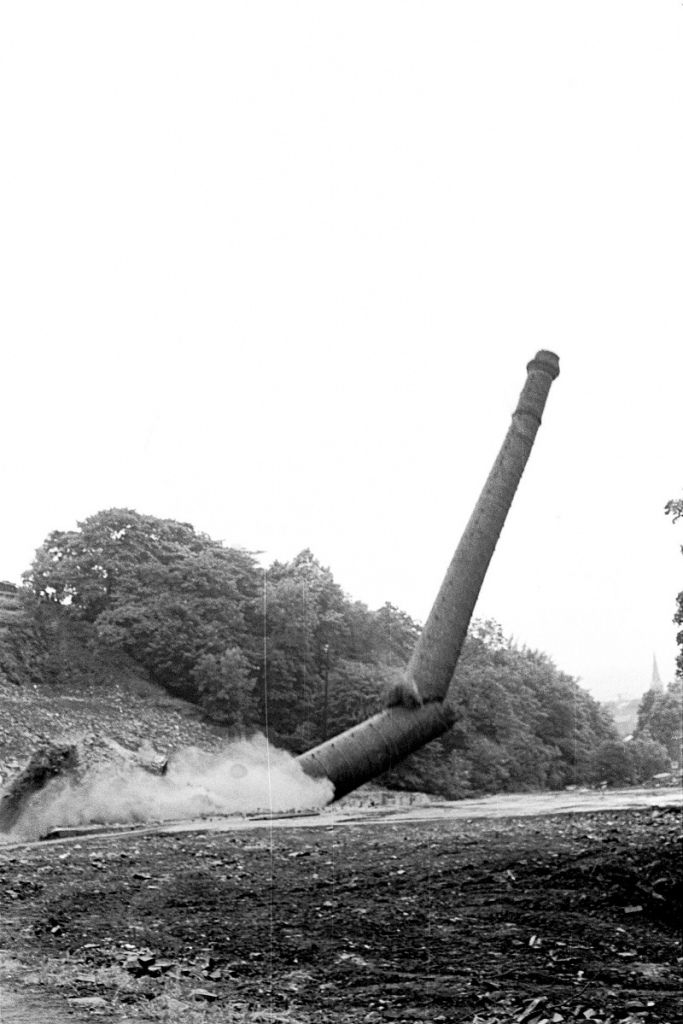
Sunnybank Mill chimney felled b y Peter Tatham in 1977.
What did you do there Roland?
R - Oh I were in the warehouse when I first went there, and I used to see all tin lined boxes like into which I used to put felts. Well where they used to send them, all over the world, like you got different insects and it's laughable when you think about it but they once showed us a list, one of the salesmen, he said “Now these different insect [all attack the felts]” See, they used to wrap them in .. some of them [that went] abroad they used to put them in a plastic, cellophane. Well not cellophane, plastic you know, polythene and seal the ends up with an iron. And you’d to put DDT inside the felt before you sealed it up with polythene and you wrapped brown paper round It and a sacking and it used to go in a tin box and that was inside a wooden box that were painted, some of them were painted green, that Cuprinol stuff. This salesman was saying this insect can eat through paper so you've got to put your sacking on and this one can eat through sacking, this one can eat through polythene, this one can eat through tin, another ant can eat through wood. We were trying to counteract every insect that could possibly get into it. The felts cost too much for them to have ’em spoilt with the insects before it ever gets there. And that's when they first started sending them they found that out, trial and error, it ware an expensive way of finding out though.
I’ll say. So you were responsible for this packing?
R - Well you see there is all the tin liners to set up and nail the box up and mark them, pack all the bales up. Then I went over to being second man in the picking room, they called it picking ...
Picking ... ?
R- I used to put them up over the rollers and [inspect] them. If there's any faults we used to put them right you know, any faults on and trying, if it were possible to put them right without having to go all the way back to the start again. Well I were up there about two years in the picking room. In fact I taught the last foreman the job before I left. I taught the foreman the job. See they wouldn't give me the foreman’s job because I were only seventeen then and they said an older man wouldn’t take orders from me. What made us laugh in there, they used to have to [come to me].. I taught the foreman the job, I had got one bloke up and taught him the job. They didn’t use to ask him what had to be done, they'd still come to me rather than him and he were the foreman. And it makes you laugh, I said “There's them saying they wouldn’t work under me and yet it’s me they used to come and ask “Has this to go?” So you got a list at the beginning of the morning or the day before, what they wanted out. Well not only that but on Monday they'd give you a rough idea what they wanted out that week. Like you'd have some that they were rushing for. So you’ve got to see such and such and each one were marked with a number sewn into it so you could tell which one you were looking for. And they'd give you a certain number “We definitely want these through as soon as you can, in fact before you get ‘em!” You know, that sort of thing.
Yes. We want them yesterday!
R – Yes. Well if you got through them then you push something where there's no call for it, might be six months before you want that felt. See we used to have orders for twelve months in advance. Well it used to be when they made one we’d say "We’re not changing over, not now, we'll go through a few orders for a few months in advance.” If you got the ones that, those numbers they wanted out then you sorted for them, like when they came into my room I'd check through all the ones that’d come in then I'd take all the numbers and I'd go through me list to see if any of them were the ones that I wanted. Anything that weren’t on the list were taken off the rollers, even if they hadn't finished and put to one side to do the [urgent ones] first. I had a few that I knew, as now then when you’ve done a job a while you know .. really you get to know what’s wanted anyway, even without being told, you've an idea. If you see a certain felt and you know who it's for you know they are always pushing for their stuff. I got so I could see 'em before they did. Moment they'd come in some of them. In a way really you start getting that off, [you know] that one's going on before you can even see the felt to look at the number on it. “That ones going, they want that.”
Why did you leave Roland?
R - Money.
You wanted more cash?
R - Plus the fact I left when the manager were on his holiday and all ‘cause I think he might have talked me round. And he were on his holiday when I gave me notice in and finished there. 'Cause when I started there I were on £3-14-8d that makes you feel sick when you think about it.
It does doesn’t it.
R - And what were it, 45 hours then, £3-14s and yes, £3-14-8d.
Can you remember what you went to Spring Vale on? It mast have been more I suppose?
R- Yes, because me wage’d gone up then it were… I think it were about £10 I went to Spring Vale for, 40 hours at £10. Have more than that now. Like that Jumbo, like I said it used to be a part time job. Now you got paid half a crown a bale, for each bale you put through. You got half a crown each bale. Now that never went up from when I set on to when I finished two weeks ago.
Never?
R - It never went up once what they paid you for that bale.
In fifteen years?
R - In fifteen year it never went up once. And what I were trying to tell David Hardman, oh a year or two back and he changed the subject nicely.
David Hardman?
R - I said “Now look, when I first started getting that half a crown, there was a man, and I worked with him, that died there. Now he used to live at Rising Bridge. Now he could catch a bus at Rising Bridge, go to Rawtenstall, go in and watch the picture, buy an ice cream, come out and buy a bag of chips, and go back home and have a penny left out of his half a crown. Now you work out the same thing today and just think what you’d have to pay me to do the same thing. It’ll cost you 40p bus fare, 60p to go in the pictures, 10p for the chips and 8p for the ice cream. That’s nearly thirty bob it’s cost you. You’re getting for half a crown (twelve and a half pence) what it’s really costing thirty bob when you first started paying us. And he changed the subject and went away. But it’s right is that.
So you’ve got a set wage, and then you got a bit of piece work on top.
R – Yes, you got twelve and a half pence each for every bale you put through. Like today for instance, even for me to come from Haslingden, never mind Rising Bridge, it’d cost me 21p I think to Rawtenstall.
Return or single?
R - Each way, that’s forty two pence, that’s just from here. It costs, I think it's one pound fifty now to get into the pictures. And then you've got chips .. our cheapest chips is now sixteen pence for chips, your cheapest ice cream in the pictures is fifteen pence. That’s pushing two pounds and it is still only twelve and a half pence for that bale. I said “That’s how you’ve been making your money. You’ve been making it off us.”
It is isn't it? Ridiculous. Were you born in this valley?
R - Yes, I were born in Haslingden.
And what about your parents, were they local?
R - Well .. No, me dad were born in Bacup and me mother were born in Suffolk.
Ah, now that's unusual isn't it.
R – It’s a long way away.
Because all the other people I’ve spoken to, their parents were both local.
R – Oh, she’s lived here most of her life from a baby, her other two brothers were born here.
Oh I see.
R- But she .. going back me grandpa and grandmother, she is a Suffolk woman that’s how you get the Suffolk part.
I see.
R - And she married a bloke from Blackpool.
And have your parents been in the textile business?
R - Oh aye me dad’s still in, so were me mum. In fact me dad’s retired this month.
And what’s he been?
R - He’s on all sorts in cotton now, he is one of the few around that has a green card off the Union to say that you're qualified to do such and such a job. You ask about if you like. If you see Johnny again, ask him, very few of them green cards around, very few.
And it literally covers everything from blending through spinning through weaving through finishing?
R- Well not your spinning and weaving, just your card room end. But there’s very few people who have them green cards.
Oh I see. And they're issued by the Union are they?
R - Yes.
Which Union, do you know?
R – I’m not sure now which one. Textiles & Blowers Union I think it were then.
Textile and …?
R - Blowing Union I think it were called. I think that’s what it were called then but he is also a qualified cook and baker.
Is he?
R - He is but there were no money in cooking and baking then. Like he were cooking and baking in the army.
I see.
R - In fact he is a bit [of a dark horse] In the Army on the quiet he were in the commandos and all. You wouldn't think to look at him. I found that out when I were about seventeen when I argued with him. I was so big, I were twenty stone then, and me dad, he is only ten. He turned round and hit me and he literally lifted me off the floor and right across the room, I hit the wall at the other side. I never argued with him for a while, in fact I never spoke to him for two week afterwards. You'd be surprised though he doesn't look that big but he said afterwards, he said "Look, when you are in the Commandos they teach you how to hit, you know just how to hit and no matter how big you are you can go down. They also taught you how to kill easy enough, watch that part and all.”
Watch it. What’s he done in the textile trade then? (600)
R - Oh anything in the card room. He can literally, where he were working, if they'd had break downs on the cards, the carder and the Undercarder have, before today, left that machine, they’ve given up to him, and left a little note on it “Bob, can you fix this?” And he’s fixed them and all.
I bet. And what about your mother?
R - Oh she's been a machinist for blanket folders and things like that in textiles.
So was it expected that you would go into this trade?
R - Well sort of I suppose. But like I made a mistake when I left school, you know what you're like when you are young? You are cocky; and I applied for a job as electric mechanic at Howard and Bullough’s down Accrington. Now I applied before I left school for the job. Like when I left school they'd never let us know, yes, no or indifferent and that were two months before I'd left school. So I thought oh they don’t need anybody, never bothered and asked. I started work at Porritts and I had been there two week and I got a letter from them “Could you please come and start work for us?” I thought, well I don't think much of anybody where it takes them nearly three months to let you know whether there is a job or not. At least they could say "We were thinking about it - or - We'll let you know" Well no, I don't want to work for anybody like that, so bugger them, I never bothered. Now when you start looking at the trades, electric mechanics are a damn sight better jobs than labouring around. But in them days you don't think of things like that, you think the sod took three months and never let me know. I'm not going to work for them.
Well you can’t see into the future, that's the trouble.
R - Well, you can change your future, you can't change your past.
Well there is something in that I suppose. Yes. So to come back to where we are now what about the closing of the mill, did you have any inkling about it, before you were told?
R - Oh aye, three or four months before.
What gave you the idea?
R - Just be, what shall I say? Little things like not ordering bales that they used to order. Like in using stock rather than buying a lot more in. You see where we had that bale store? That were always full of bales.
That's the room above where the blending machines are .. ?
R - No, besides that. You know the new one outside, you know where you park your car outside .. ?
Oh yes.
R - Well that were ram jammed full of bales, always full of bales. In fact at one time they said there wore eighty thousand pounds worth of bales in there, so you can tell how much stuff there were in. So when it goes right down, and they don't put any in it and like don't really keep the one upstairs full as well, and like that’ll only run, if it's full it keep you going about three weeks or a month. That’s the top side. So if they’re not keeping that full, it's only a month’s running, and they are not keeping it full, you start wondering why aren't they keeping it full?
Well, what's the difference between the store up above your room and the one, what I call the warehouse?
R – Well, that warehouse were built so they could buy in bulk so it were cheaper, like once they bought some from Russia and there were four hundred and odd bales come in at once, and you'd to stack your two hundred and odd bales down there. No way you could get four hundred bales up there; it were built specially for buying in bulk. Like you get your Russian and some of your Japanese that they don't send it out all the time, they release it from Russia every so often, it’s not all the time. And they got so they were getting it when you needed it, then after so long you went months without having any. So that’s why, if you buy in bulk you've got it there when they are not releasing it, you’ve still got it. So you don’t have to keep changing your blending. See if you haven’t got a bale you've got to put something else in its place.
Right.
R - Well you keep swapping around if you haven’t got them bales like if you had them in stock like they had, they had them for months . When they weren't letting then come in they still had them.
Yes I am with you. So really they were both store rooms.
R- Yes.
Yes. What other indications were there that the mill was closing down Roland?
R – Eh, this may sound funny like. Just got that feeling. And then a week or two before they actually told us you had people coming round measuring up. You are not measuring up for nothing.
No. And were there rumours flying around?
R - There was always rumours. But when you see them all measuring up, now they are not measuring up for nothing ...
So that was a bad day for you was it, when they told you?
R- Well it were no surprise.
Do you think you’d have stayed with them for a long time?
R – Yes probably. Probably for a year, a few years. Or as you say, if they had knocked overtime off then I think I’d have been looking somewhere else because of the money. It weren't that good on a flat week.
No. And what sort of jobs did you do on the overtime? (700)(35 min)
R- You’d run your devils, then you baled your stuff up that you'd run on your devils. That’s why you had your overtime, they were selling, in fact they could still sell all they made.
Did they?
R- Off the devils they could.
Why do you think the mill has had to close down?
R - Too much foreign stuff coming in cheap. Far too much. Like ours goes abroad, had a tax on it, comes in here there isn't, but their government subbed them. All our mills, they’ve had them shut.
Do you think the days for the condenser trade have gone now.
R - I think they have, yes. In fact I think cotton’s near enough gone.
Because with, what's it called? Continuous what’s it called this, the new method of spinning?
R - Open end spinning,
Open end spinning and ring spinning. There presumably isn't the same sort of waste is there?
R - There isn't. It’s also quicker, quicker and cheaper than mule spinning but mule spinning’s far better cloth.
Quality, yes.
R - But it cost’s that much more.
That’s right.
R - And these days they go for cheapness rather than quality.
Yes. Do you have any waste coming from ring spinning and open end spinning?
R- They have had bits of it. Like that thread waste of ours that was here on the Jumbo a lot, a good bit of that'd be ring spinning waste.
Is it?
R - Like it comes from other mills, well most of them other mills are ring spinning so it has to be ring spinning waste.
That's right. What other waste is it that you get from abroad?
R - Now what do you mean by waste?
Well what sort of stuff is it that you're bringing in from abroad? The bales that you get from abroad?
R- Oh it's your, what should I say, second class cotton really. Now, with being a waste industry you get what your main, your good quality people don't want.
So in fact it's raw cotton, it hasn’t been used in any process?
R - A lot of it is raw cotton, yes. Now, all them bales on the blenders is raw cotton.
I didn't realise that, I thought it had all been used in some way once.
R – No not all. I mean you look at it, there in no way sommat like seed is still in the cotton. Well, if your seed is still in the cotton it’s never gone through any process. (750)
No well that’s the one thing I haven't really studied and spent some time looking at, those blenders. I haven't really seen them running properly.
R - You won't now. I've seen Brian must have had something going through this week though.
I think Brian’s been on it this week, yes. Well I think we've exhausted your life history haven’t we Roland, so perhaps…
R - Yes, we're right.
.. we are able to start with the spinning folio number 1. We'll go through the whole of the blending process with you if we may. OK? So, number 1, what have we got there? [Spring Vale folio, Svbreaking section]
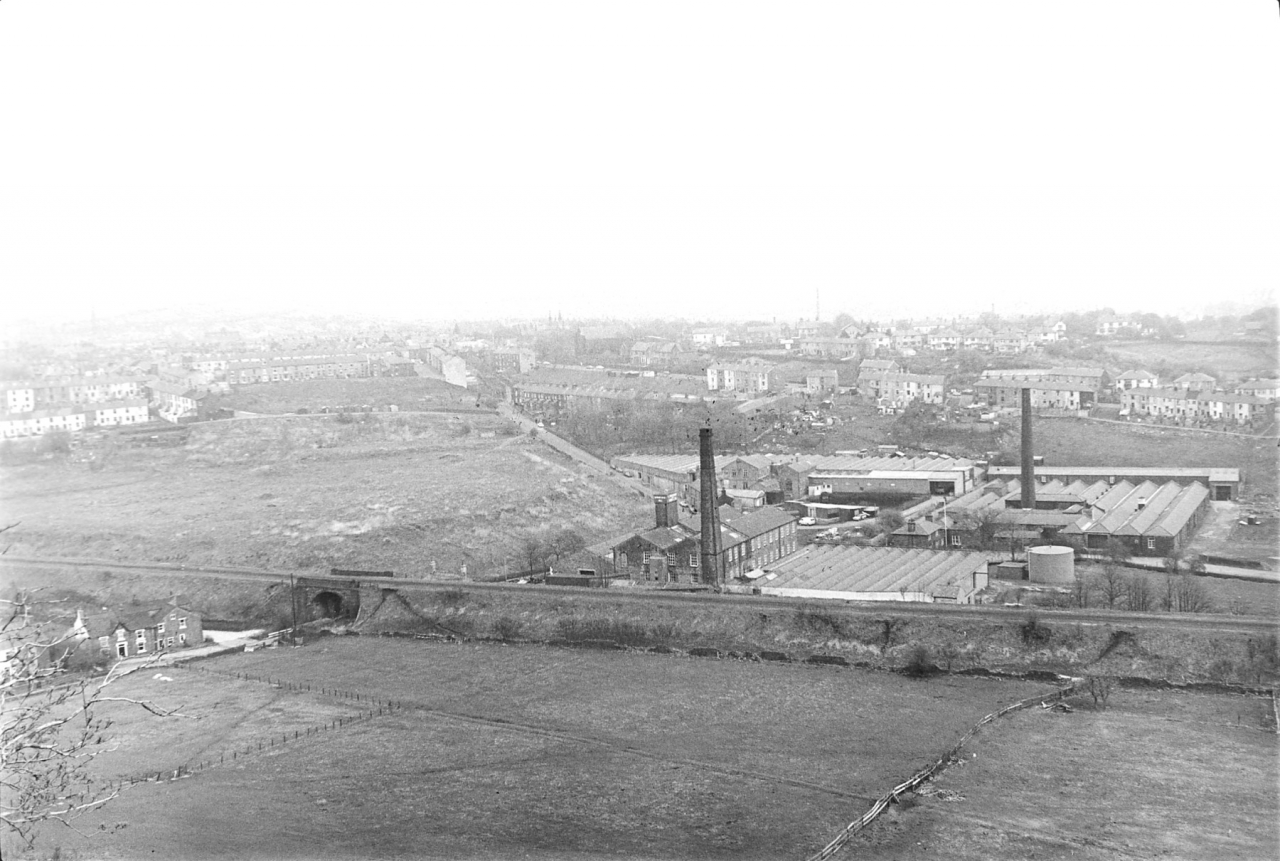
R - That's the aerial view of the mill at Spring Vale. That's changed too, they are putting all that roadwork stuff on there. That’s gone, the railway line’s gone. He should have took another one now you know?
I’ll probably get him to do one.
R - Can say that, all that has gone now, in fact all that’s on there.
All what?
R- All this.
Railway line?
R - All this stuff and reight, lower down than that, they've all gone.
What's they?
R- That’s what used to be the Flip Inn many years ago. Now the buildings, they've all gone now, because they're, that road's, well the wagon's cross there, they're tipping most of the dirt on there.
Lt’s going to be a by-pass for Haslingden is it?
R- Yes, to Burnley. It’s going to just cut the end of the mill. In fact it were going to go through the mill...
Ah, was it?
R - and they changed the road.
It’s from Burnley to where? Accrington? (40 min)
R - No it’s, when I come off the motorway at, where you'd come off
Oh, M65?
R - At the bottom there, road end ... it's going to go straight through to Burnley.
Ah well, that'll be a good do, that'll make travelling into Manchester really easy won't it?
R- It’ll take over eighteen months though before they finish. That’s if they finish in time is that. You never know with this lot.
Do we know who bought the mill or what's going to happen to it?
R- I've no idea right? Just rumours and you can’t credit rumour.
No well it’s perhaps as well not to. What’s the hill behind?
R- Cribden is that one at the back. A long while since I used to walk over there and all.
This second chimney behind Spring Vale .. what is it?
R- That one, that one were Waterside.
Is that not there any more?
R - It's there but it’s shut like a lot more.
Whose mill was that? (800)
R - Higham’s had that from Accrington.
Are they slippers?
R - No, cotton. There’s another one there. See, you’ve got two different firms moved into them, one’s filtration and the other one is a slipper place.
One's Automet isn’t it?
R – Yes.
That's opposite Spring Vale isn’t it. Right, number 2.
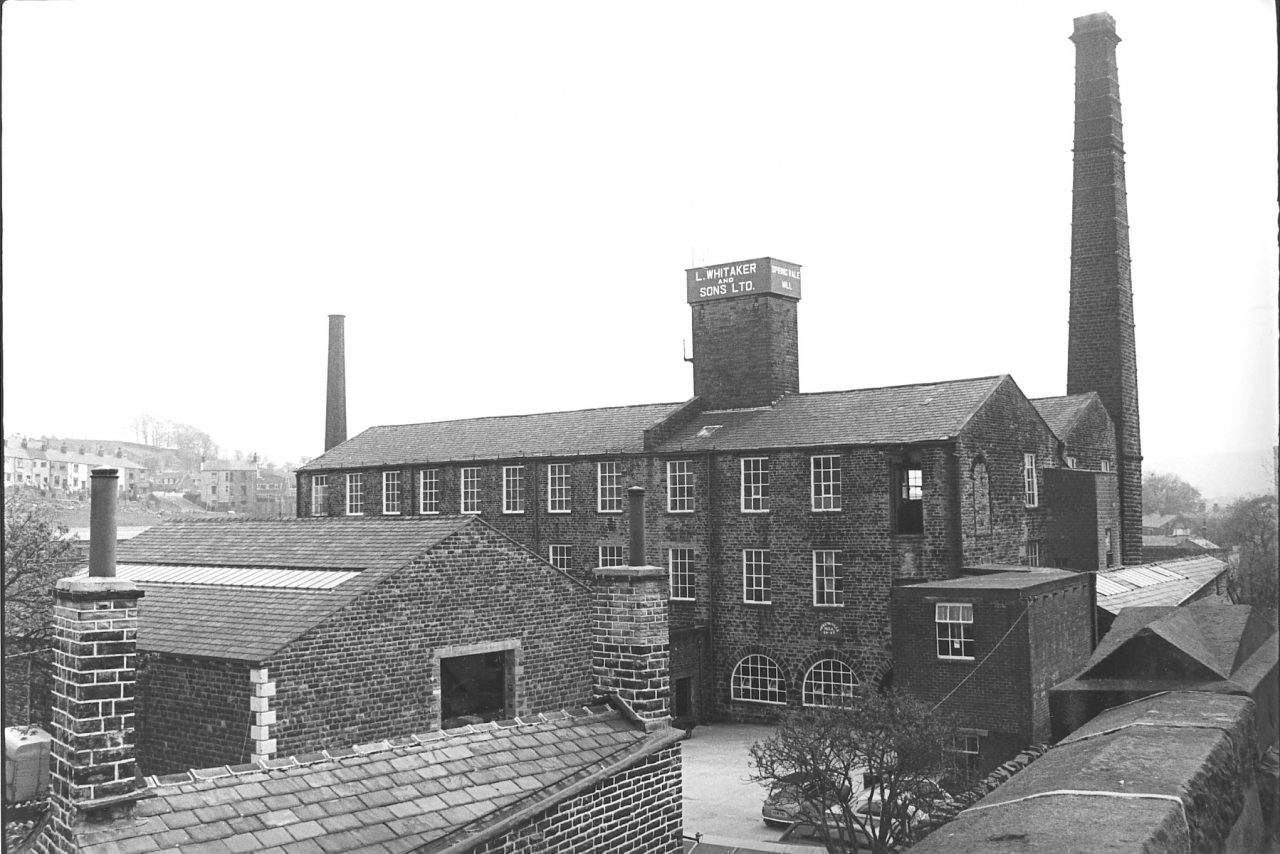
R- It’s a closer view of, that's the yard, that's your bale store that were built just for the stocking up.
With the long line of windows?
R - Yes, our own brickies built that.
Did they?
R - Yes. I wouldn’t like them to do mine. For one thing you'd never knock that down if you’d drop a bomb on there. That’ll stay stood.
Well .. why do you say you wouldn’t like then to do one of yours then?
R - It cost too bloody much.
Oh I see.
R - Do you know how much it cost to build that?
No.
R- Thirty thousand pound, it did. You can’t see the foundations on there. They had a Council building Inspector come and because he hadn’t seen the foundations going in he had them digging all the way around and putting more concrete under. And they were what ? They must have been about six foot of foundations, the concrete and on top flags, before he had the extra put in. And the floor inside, what used to be the lodge, the lodge used to be underneath that warehouse and they've put cinders, and then about four or five foot deep of concrete, then they put reinforced concrete on top of that. And that floor’s round about ten foot deep in concrete. So as I say if you drop a bomb on it, it won’t shift. You've got stone outside walls then you’ve got a cavity inside with broken bricks in, not solid but in between. Then on the inside you've got double brick inside it.
Double brick inside?
R - Double brick inside.
So I suppose it had to be definitely dry did it?
R - Oh aye, it has to be really dry.
Who lives in this house that we can just see with the two chimneys on.
R - He's one of the weavers. It's firm's house is that.
I wondered if it was.
R - Yes it's the firm's house and they own it.
So really, should the manager or someone live in that?
R - It used to be the gate keeper's house years and years ago.
Oh I see. So that was when there was a sort of gate?
R- Yes well that’s how they used to have a ... like I've said the lodge used to he there and they used to have a gate across here.
I see.
R - And they used to have a gate keeper there.
And, and this sort of wing that comes off the main part of the mill on the right?
R – Well, that were built afterwards, aye.
That’s where Brian’s office is, isn’t it?
R - Yes it is now. That's where we used to store our bales for the jumbo in there till they pinched it off us.. (850)(15 min)
I've never seen down there yet. Brian's promised me a visit so I shall have to see what happens.
R - And at the back that's your boiler house.
What's happened to that now?
R- Still there is the boilers. It used to be coal but it's oil now. In fact when they had coal that used to drive all the power in the mill. We never used to have electric power that thing used to drive the mill.
Where was the steam engine then?
R - It were in the same place. It were run off the boiler itself.
Yes but it was in that same building was it?
R- Yes, it were in that same building.
I've noticed that everybody refers to the heating pipes as if they were steam pipes which is going back to when it was steam power.
R – Well yes, but you see your heat is still steam though, it’s still steam in them pipes. in fact they probably still call it steam pipes.
Well in the sense that it's hot water you mean? Or is it really…
R - It is steam, it’s the cheapest system. It's hard work pumping water through, it's easier to let the steam go through and by the time it comes back it's water again. See, the water come back on its own, water always finds its own level and it comes back on its own. And you've only got to drive your steam through.
That's true enough.
R - And the tank at the top is your old sprinkler system. That's full of water, in fact I think it’s still full of water which is a tank an top of the roof that used to run the old sprinkler system before they built that big tank at the back. The big water tank at the back and they re-piped the sprinkler system.
Is that for fire?
R - Yes
Number 3.

R - Well, that’s your date stone.
Do you know anything about its history?
R - I don't know much about it at all. Not so many do now.
No. It was an old water site which of course you said by saying that there was a lodge where the warehouse is now. Nothing much to say about that. I think it was Charlie and Joe that were telling me that those arched windows were originally the doorways.
R - I think they were yes many years ago. Like them, the windows that’s in now aren't the windows that were in when I come, our joiners made them 'cause they rotted away while I were there. Like a lot more things that weren't replaced.
Yes. Well we’ll move on I think. Number 4.
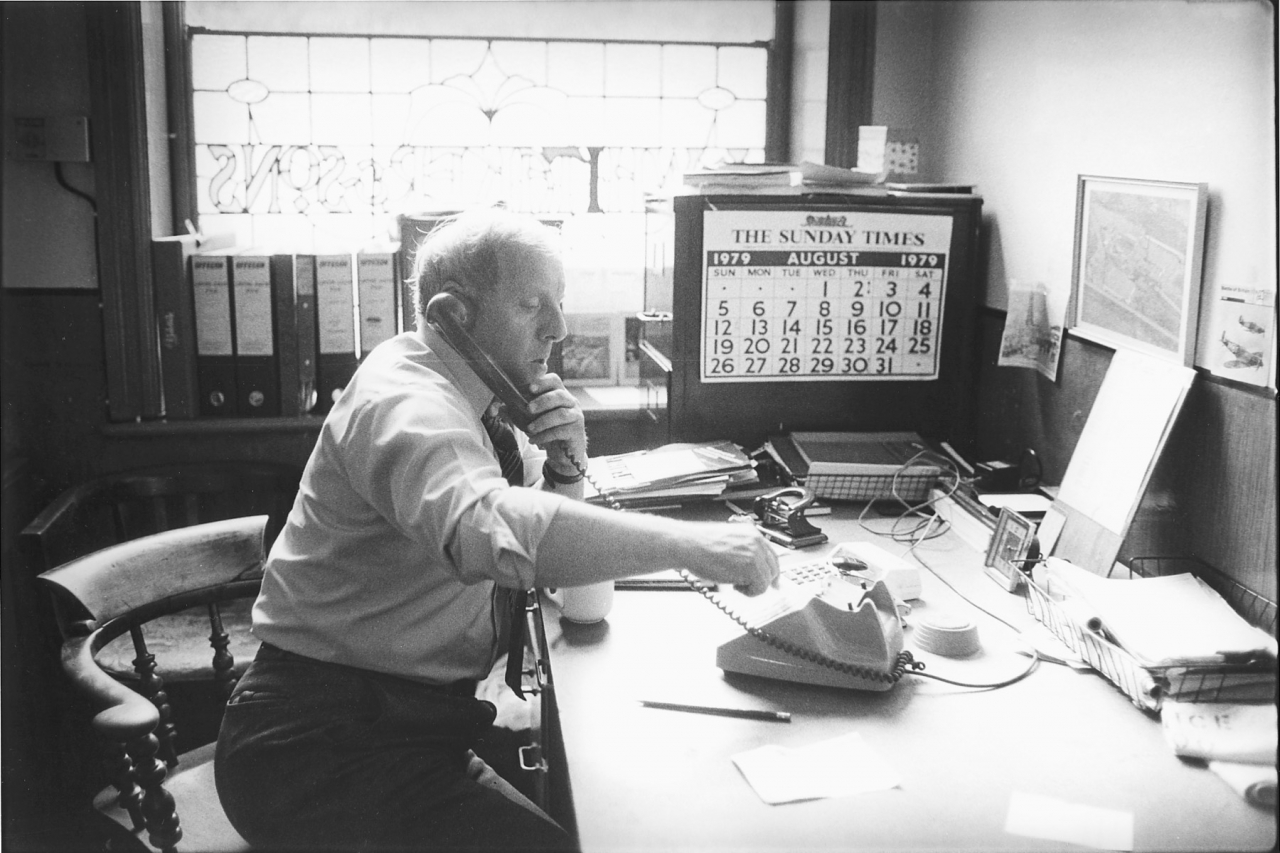
R - Mr Roy Tomlinson’s office. That’s been there a few years too.
That office? Was that the one that John Greenwood had?
R – Yes he had that. It’s been there a long while ‘cause you can see it's all stained glass. It has L Whitaker's on that window and they don’t make windows like that any more.
I was going to say, that would be worth a small fortune will that window.
R – It’ll be worth a bit aye.
Because I had a quote to have one small pane, I don't mean a pane of glass, I mean the coloured bits replaced, somebody was giving a quotation for it and it was something like sixty quid just for a small bit and that was a few years since.
R- It would be something like that..
Yes. So that's where it all happens from is it?
R - Well that’s where it all stops. Whichever way you look at it. It won't be happening from there much longer.
No it won’t will it.
R- Looking serious is the lad.
SCG/01 July 2003
7,593 words.
LANCASHIRE TEXTILE PROJECT
TAPE 80/SHJ/02
THIS TAPE HAS BEEN RECORDED ON MAY 15TH 1980 AT 119 BURY ROAD, HASLINGDEN. THE INFORMANT IS ROLAND TAYLOR, JUMBO OPERATOR AT SPRING VALE MILL. THE INTERVIEWER IS MARY HUNTER.
Now where were we? We finished on number 4 I think didn’t we.
R - Yes.
So number 5 Roland.
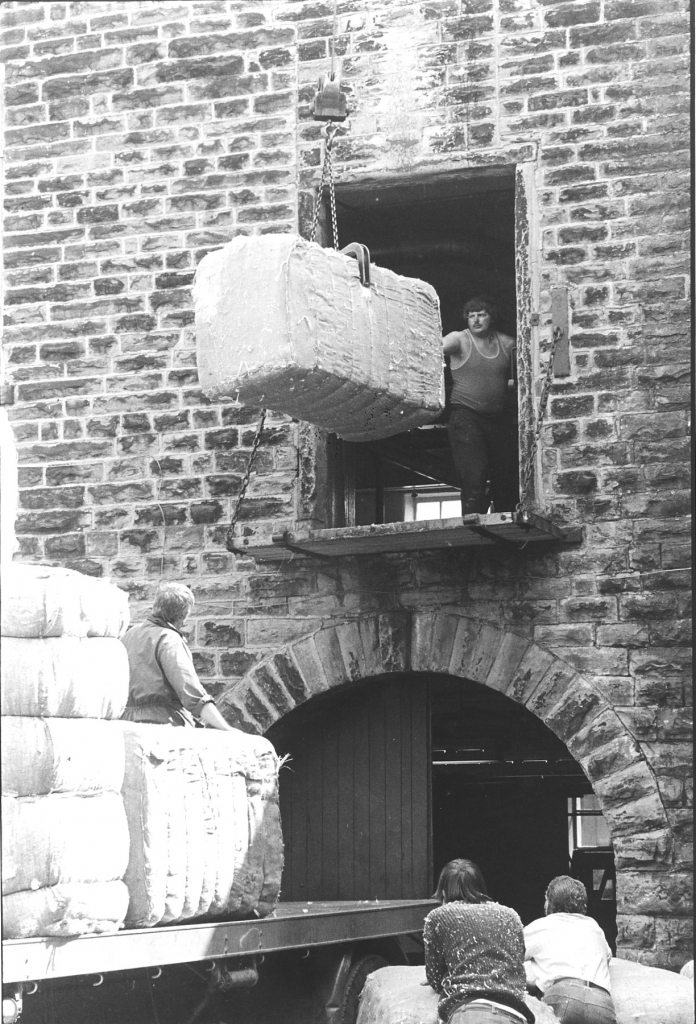
R - That’s bales coming in from John Hall's is that.
That’s a waste firm is it?
R – Yes, Oldham, a waste firm.
So they would be agents would they? They wouldn’t be a textile firm would they?
R - They just supply the cotton. Is that them two with nothing to do, and Stanley has been watching me.
Yes, that’s you in the doorway.
R - At the doorway grafting while they are watching.
You remember the photo do you?
R- Yes, that’s why I’m smiling. I were thinking, they don’t know they are getting caught on a photograph.
Do you know where those bales are coming from? Where they originated?
R- No, because the stuff can come from all over Lancashire going to them. Because they’re collected from all over them bales. They are our thread bales, for the Jumbo. That’s why they are going in that room. If they had been ordinary comber cotton they’d have been going upstairs and you wouldn’t have seen me, I’d have been higher up.
Are they all the same these bales on the wagon?
R- No. That’s the thread bales at the back. You can only see one here, them are comber bales and they’ll be going upstairs.
They’re on their ends aren’t they?
R- Yes.
And they’re comber waste?
R- Yes. That’s comber waste.
Now, can you just tell us exactly what comber waste is?
R - Well comber waste is your raw cotton. That’s what you use before we blend it. You get all different sorts of comber waste. By different I mean your different countries where it comes from which makes it different cotton. That’s why we want a blending. Your thread waste is all the stuff that’s been used, stuff that we re-process.
So the comber waste has not been through any manufacturing process. It’s been through certain processes though to get it to that stage. (100)
R – Yes, it’s been sorted.
Right. Straightened out, the fibres have been straightened out have they?
R - No not necessarily that, just…
Been cleaned.
R – No, they haven't been cleaned, it’s just been sorted so they have had the good stuff out of it.
Right.
R- This is the stuff that your quality users don’t want.
I am with you.
R - It's not good enough for the stuff that they use but it's good enough for our uses.
Presumably this system of hoisting the bales up is a fairly antiquated system?
R - It is. Like I once told you once over there, it’s like they used to have at the docks. They used to have a counterweight, like it’s electric now is this but it’s on a weight and electric drive’s it. Before they used to have weights on and there were like a shaft and the weight of your bales literally took it up. And to make it go down you put the weight on at the other side to make it come down again.
That’s what was the system here. (5 min)(150)
R- I wouldn’t have fancied working here when they first opened that mill when they started using electric, well, steam power they started using. A crane like that, I’ve forgotten me dad’s year on a crane like that somewhere, but it’s a few years old is that crane.
So they were using that system when you first came here?
R - Oh aye. They've been using that for years on end.
So how much physical strength is needed to manhandle these with the present system?
R - Well quite a lot like. Your crane takes them off the wagon, you put a truck on this platform here and you drop the bale on it and from there it’s all manhandling right the way along the line. Same as when it goes upstairs there, you drop the bale on your truck and it’s all manhandling again to put them away. Say when you are letting them down again, all pulled over on to the truck and manhandled again.
They are brought down from upstairs in the lift are they? [006]
R- No, the same way. That’s what I say, when Arnold and Fred couldn’t get it off the platform because it were too much of a step from the end of the platform on to the floor. Your platform is just that inch lower than your floor is.
How heavy are those? I know they vary but…
R – Well, in them thread bales there’s normally, how do you want it, in pounds or in kilos?
Well, we’d better have them both I think because I only understand pounds but in a hundred years time they’ll only understand kilos I think.
R- Well, in kilos, they're probably about between 350 and 400 them thread bales and that’s about what, 800 or 1000 pounds. (200)
That will take come shifting.
R- Well, aye, especially if you haven’t got ‘em balanced well on the truck. A lot of people, they think they look even when they’re on the truck but there is a knack to getting them on the truck right.
Is that so?
R - You get them trucks, the weight is all on your arms, it’s damned hard work.
You have to put them down on the truck vertically as opposed to horizontally.
R- The way that is now, your truck rides that length of it. When you come down on your truck, it’s there and that runs that way up it.
On another picture are we? All right then, try and describe this picture.
R- Here’s your truck… [007]
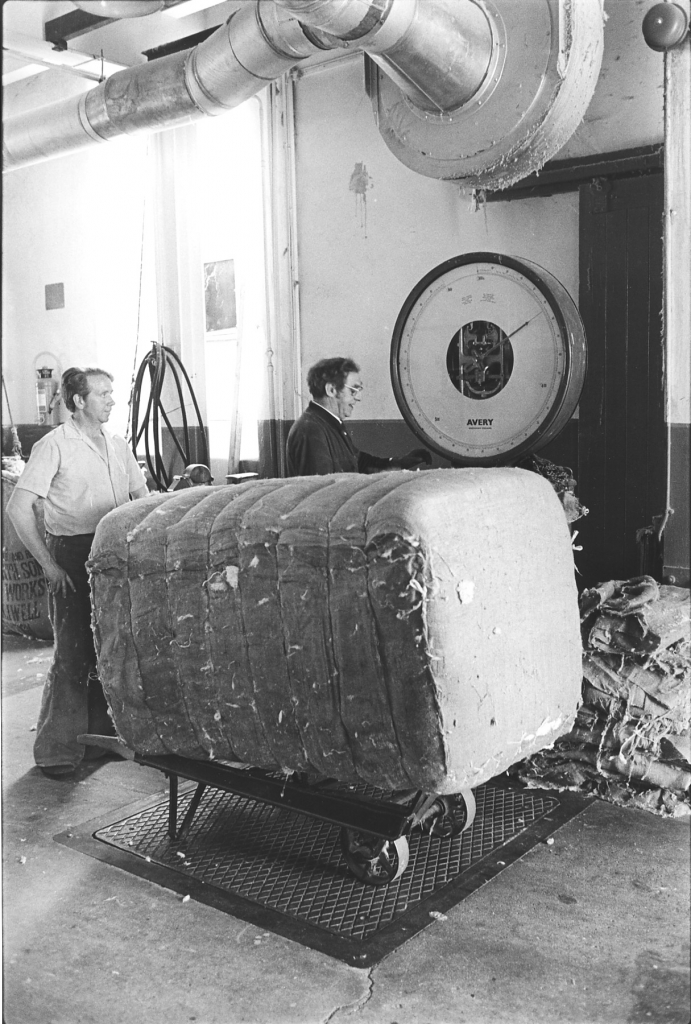
Oh I see, you’ve laid your truck flat, yes I’m with you.
R - Now your bale goes on that way.
Right.
R- And like I say, if you get your bale too far up this road you've all your weight on your arms. And you've got your step there that you pull it up on, so if you've got all your weight there as well as having to pull it up…
So, just a minute, wait while I try and describe it. Presumably that end of it isn’t over the wheel like that is it?
R- Yes.
Is it?
R- It’s over the wheel.
It won't fit on?
R- Well, it won’t fit on as I say, the further you get up you get the weight on your shafts. (250)(10 min)
So the long side of the bale is laid on the back of the truck?
R - Of the truck, yes.
With a little bit hanging over the bottom end of the truck.
R - Well normally when you have your wires an your bale, most bales have a wire at the foot end of the bale and you try to get that on the footplate of your truck because by that it’s balanced and you don’t get too much weight on your arms.
Yes, I am with you. Thanks for that. What about comber bales?
R - They go the same way.
But they won't be the same weight though will they?
R- No they’re not, it depends on how big the bales are. Like you've got some that’s only about 100 kilos, that’s just over 200 pounds, round about 250 pound. But then again, if you’ve got, some of them combers are about 250 to 350 kilos which is about 600 or 700 pounds. You can get that but it’s very rare you get them that heavy, they are normally about 600 pound. Comber bales, between 400 and 600 pounds, that’s your normal comber weight. Your rovings again are like threads that go upstairs. The weight, in fact some of them rovings are heavier than other threads are, we had one the other day, the other week, that were 1060 pounds which has to go down in the hoist. And the hoist is one of them things which doesn’t like too much weight. So, unless you are sharp on that button you drop about six inches underneath your bottom floor so you have to fiddle around with it and get it lifted so you can get your truck out. And like I say, you’ve got 1000 odd pounds in the bale, and you’ve got me at 200 pounds and Brian and Jimmy at about 100 each so you’ve a bit of weight in when you’ve got the three of us and the bale in.
Oh I see. You used to go down with it did you?
R- Yes ‘cause it’s the only way it would stop. You see it’s not a passenger lift, it’s a hoist. A passenger lift has buttons to control it but my hoist, it only has ‘up’ and ‘down’ so if you want to stop it at the middle floor you’ve got stop it yourself but it’s not made for passengers really. It’s just made for carrying stuff.
Oh I see. I am with you, you’re not talking about this, you're talking about the hoist in the mill.
R- No I’m talking about the hoist. You could get played hell with if you brought somebody up with that. [The outside hoist or teagle]
Well that’s what I thought.
R - I know I’ve done it and got played hell with by Johnny. I got that bale down there and somebody sat on it and it come up and we both got a really good telling off about that!
It’s not very safe I wouldn’t have thought.
R – No it’s safe enough but he just said “What would happen if the chain snapped?”
That’s what I mean. It’s not very safe.
R- Well normally when it goes in like that they’re safe. Them hooks are gripping hard.
Yes, I can see it…
R – But John, Johnny were saying that if they were wanting sharpening, if they were ready for a sharpening there’s always a chance they could slip. If they’ve just been sharpened they were all right but if they’re ready for sharpening there’s just a chance they might slip out. (350)
Yea. So you say that you’d have a wagon once a day but not towards the end.
R - Yes. Well it used to be sometimes more than one wagon a day. But at the end you were getting one or two wagons a week. If you were lucky, not always that. In fact it got, that last month, it were very rare we had a wagon in except for taking bales away, it were only very rare they come in. And John Hall’s were only coming once a fortnight. In them days it used to come every week. Like when I first went there, Hall’s came every week, Brooks come every week, and Padiham came every week with their own wagon with bales and you were using them. Now Padiham and Brooks haven’t been at all for three years. (15 min)
What, are they another…?
R- Yes, they are another cotton distributor and Padiham’s the same. Padiham Waste, and they haven’t brought any, they use their own wagon. Well our firm says it’s not worth it, we have got our own wagons to fetch it in when we want it.
Yes. Right, 0K. Well let's move on. Number 6.

R - Well that's so you can see how we put the truck underneath a bale. And again there’s Brian on the right side there and Jimmy on the truck and me on the left. Well even there you've to make it easier for yourself. If you put it down flat you’ll drop it altogether, you've got to pick it up and it's dead weight. Now if you put the bale on the truck with him still (400) holding it then he hasn't got to pick that dead weight up, he can just wheel it in, that's why you've got Brian, and me on this side, we've got to pull that bale. See you've got your wall there so your crane won’t come right in to where you want it. So you've got to pull it in on your cable on your crane, on to the truck so they make it easier for him. And then it’s to be weighed on the scales there.
Yes well that's the next I think .. if you've done with number 6, have you?

R - Yes, that’s number 7. Yes that is on the scales there. And the truck goes flat on there your tare weight's taken out for your truck.
The tare weight in really the gross weight isn’t it?
R – No, your tare weight on your scales is that truck.
Not the sacking?
R – No, just the truck so that the weight on them scales is all that’s in that bale. Like your sacking, your cotton, your wires, the lot. That’s in that bale, that's what you're weighing.
So presumably you have this scale set at whatever the truck weighs.
R- Yes. And that ones 350 odd kilos I can see that off them scales. That’s on it’s way for 800 pounds is that one and I can see Jimmy is not looking too keen about it.
And that one will be thread waste will it?
R- Yes, that’s thread waste, that goes behind the Jumbo. That’s your dust fan, your extractor fan.
This at the top left?
R- It takes off the jumbo and the four blending machines all through there. It were a right job getting that up and all ‘cause I gave them a lift. I think there’s 8cwt in that fan there and it had to be lifted up[ with a block and tackle up on to the girders and then held there while it were fastened on. (450)
When was that put in, can you remember Roland?
R- I should think about six or seven years ago. Like before that was there, the extractor fans we used on the jumbo were on their own, it drove off the drive belt on to the side of the jumbo. And your fan for your blenders were on the bottom end of the room. We used to go and empty their own bags you see. You had to empty your own fly there and take it into the back room and all too. Like your devil extractor fans were in there to start with, so they put the others in with them. So all your dust bags were in one place. If you’re wondering why they were all put in one place instead of being separate, we had a fire on our Jumbo and it set the stack afire as well. So we lost a few pounds there. Rather than do that they put them away where the only thing that can burn is the bag, the dust bag, the extractor bags. They won’t burn anything else, that's really why we had that put in.
You said you had the stack afire?
R- Yes. It were like, you know when you ran the jumbo waste, we used to stack it on the left hand side at the side of the chute.
In a sort of basket, in a wicker basket was it?
R- No, we used to pile it up on the floor.
When it has been through. Yes I know what you mean.
R- Yes. It's ordinarily piled up there.
What, here, on this side of the chute on number 6? (500)
R- Yes. Well you’re back there then when we were waiting for the bales coming in. In fact we were that low, well it’s normally piled right up there all the way along. Well, before when we had our own fans the dust bags used to be at the other end.
Right, near the door.
R- Near the door you come in from the steps, well, they used to be there. Well we got a spark off the jumbo that went into them bags.
Ah, I see. And…
R- Now It fired them. Now they were next to the stack, so your stack caught fire, so your stack were burning then. So after that they had that put in. It cost them a bit but I think it saved them in the long run ‘cause it fired a couple of times since. That was in the back but it’d only burn the bags, well they can replace them easy enough, but if you have your stack burned that’d cost them a bit to replace it plus the fact that they've used the stack, they've no stack to use till you run. And that bell, if you're wondering what that’s for, that belongs to the boiler, if your flame on your boiler fails you'll have no steam going through, you'll get no pressure, so your pressure comes down, you get not heat in the mill. Well, if your flame failed on the boiler that used to ring and it did ring. So when that rung you used to, well I used to do it at one time, but then Brian, when he come, he started doing it, when that bell went you went down to your boiler and got it going again.
Sharpish.
R- Yes. I’m not bothered about re-setting the boiler, I just want to turn that thing off. Have you ever heard the bell on a fire station?
Yes, dreadful!
R- Just what that sounds like. It was worse on a Saturday morning if it ever went off. Like if you had no key to get into the boiler house. Well you know that cottage you were on about? Now he has a key to the mill, and a key to the boiler house, he has that in case somebody comes or there's a fire or something like that, for him to get in. Now you can't go knocking him up at half past six at the morning just to get in to knock that boiler off. I know what I’d say if somebody were coming knocking me up at half past six when I had no need to get up. So you’ve got to wait for him getting up, so sometimes like with being in at half six, now that bell's going then till say about half past eight when he gets up. Now two hours of listening to that bell, it drives you, just a bit round the bend. ‘Cause I stopped it once and I got played hell with because I stuffed it up with cotton all round so we couldn’t hear it. I got played hell because I forget to take it out again, so the flame failed and nobody heard it. It were off all morning, and so we had the flame fail and nobody knew until it started to get cold.
Naughty . Number 8.
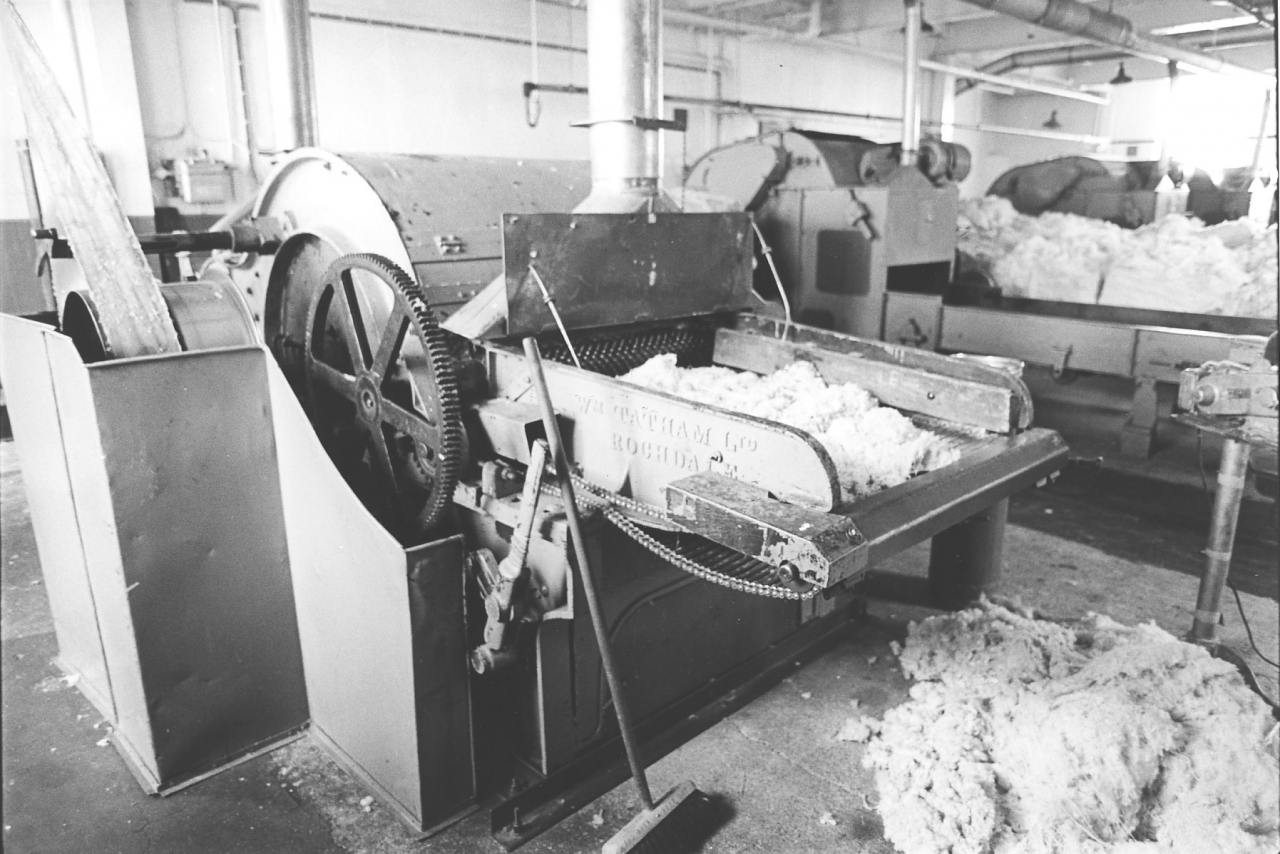
R- Well, that's our jumbo.
Is that it’s proper name?
R - I don't really know what its proper name is, because each mill that had one had their own name for it. Some people call them willows, breaking, running down machines, breaking up machines, jumbo, there’s different names in different places for them. But ours has always been called the jumbo, why I don’t know, it’s been that for years and years, only jumbo.
Presumably because it has the hardest job.
R- Probably, because it does a big job, aye. And like that machine there, the little one on the right, that's a cutter, that’s in case you get a lot of long stuff to do because if you get long stuff going through there it just scorches it.
Scorches it?
R - It scorches it aye. And chance of breaking the wheels at the other end. And till they put that other drive on it used to shatter ‘em quite often. 'Cause they had one, that wheel on the far side it shattered and shot a piece this way and it went through my head and it cracked the glass on the scales after it had gone past me. I thought it had gone through me head. Who were on at the other end? Eh, I’ve forgotten now, there were young Frank Smith, that were right, that young lad at the other end and he had a habit, if he had a hard lump gone through he’d chuck it over to go through again. I thought he’d chucked a lump until I heard the crack and looked at the back of the scales and “Hell! That’s not cotton!” It used to be quite often, you’d get a lump in and the weakest part of your machine broke. Well the wheels were the weakest part of the machine. So you got that cutter just for to cut it so that you didn’t get any really long stuff in.
I've never seen that working, actually.
R – Which, the cutter? I think it’s in the devil hole now. Well it were in the devil hole 'cause when they were running that single devil they got a lot of that roving that wanted cutting I know.
So this is the feed end of the jumbo isn’t it. The back end as everyone calls it.
R- That’s right. That’s the feed end.
And this on the floor is the stuff that’s going through.
R- Yes. And these spindles here you see, holding this cover up here, by rights they shouldn’t be there that’s my idea. See, if you get some of your cotton going through there and it catches round your roller that’s a right mess and I can’t see it if that’s down until it’s too late.
And you’d have to cut it off?
R- More than that. Sometimes it wouldn't cut off and if you didn't… I know when I went there at first we did it once and we’d to take all this trunking off, take all your brackets off and take them rollers out and them rollers are heavy.
Even to you?
R- They are heavy, yes they're a fair weight. And it's all time wasted like. It’s a good two hours work to take them out and put them back again, just for the sake of seeing that going through.
How can you stop that then?
R- Well, this handle on your left here, next to the long brush, if I knock that forwards towards that wheel it stops this lattice going. It doesn’t stop the rest, but it stops the lattice so if you get something in you can wind it back, turn this big wheel and I can wind it back out.
You can wind it backwards in fact.
R- Yes. I can wind it back out from there. But if you want to stop it altogether, the handle here on your right hand, you can just about see it there underneath the guard rail there. (650)(30 min)
At the very front?
R- Well yes, on the right hand side, that’ll stop the lot, it’ll stop the front end as well. But I only use that if I’ve used the bale or I’ve another job to do. I always said that were dangerous though, that lever that stops the lot. Like if you push that down there, like it’s all right if you’ve got a small hand, but I got in the habit, I held my hand on the inside there knocking it that way. That way I’ve always got the chance of cracking my knuckles on that big wheel as I let it go ‘cause you’re very close to that wheel as I let it go. ‘Cause it’s close to my hand is that…
And presumably that cog wheel can motor round?
R- Not to that extent. But even if it’s going slow and it hits your knuckles…
You’d know about it.
R- Even when it’s stopped and you go like that you’d know about it. You’d crack against it because, no it doesn’t go like that, it goes like that and when you do it’s like that because there’s the weight of it underneath, pulls it down. Like you’ve to really lift it up you see, to about straight up.
Twelve o'clock.
R- and just start turning. And once you got past twelve it goes down with a jerk. So if you happen to be looking somewhere else when you're knocking that off, which happens quite often if I'm looking to see if there is a mixing out on them blenders. If I don’t look what I’m doing and I let it go and don’t let go of the handle as it goes down I might have cracked my knuckles on that wheel.
Did you find those guards a bit of a nuisance?
R- No, they weren't, until when we were stacking and we were making a fair stack. Once you started carrying them from that back end you had to squeeze past them, otherwise they weren’t that bad.
Now for some reason, 8.01 is back to the bales.
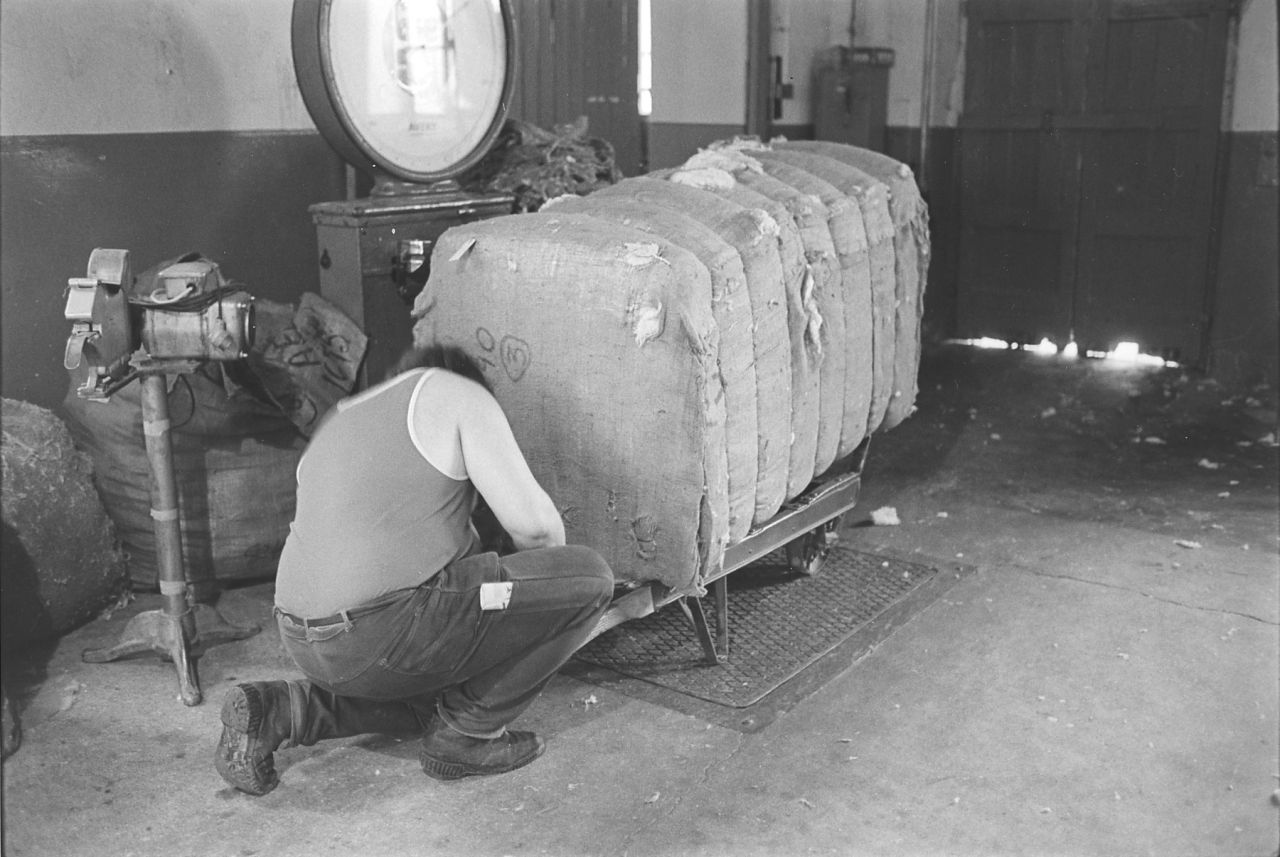
R – Yes. I think that's when we'd finished fetching them in. That were the last one. Like I say, we were waiting for ‘em coming, ‘cause I’m getting ready to take that one behind the jumbo to open it up ready for using on the jumbo. (700)
What are you doing there?
R- I must be getting ready to pick it up, no cutting the string.
The underneath one?
R- I’m cutting the string yes. It’s tied all round the edge is your bale with string, I’m cutting the string underneath the bale there.
To get this end piece out?
R- Well, it doesn't actually quite, that goes all the way across but you fold it over so when you tip your bale over it goes underneath your bale and this big one, it goes all the way round from there right underneath and up to the top. So when it goes over that big piece comes off on its own, it comes off in one piece. And you’ve got the long one that goes over, just over the top, and up the sides. That comes away when you’ve finished your bale, that’s left on the floor.
Yes, it’s quite an art even thinking that one out! OK, let’s see the process, so 8.02.
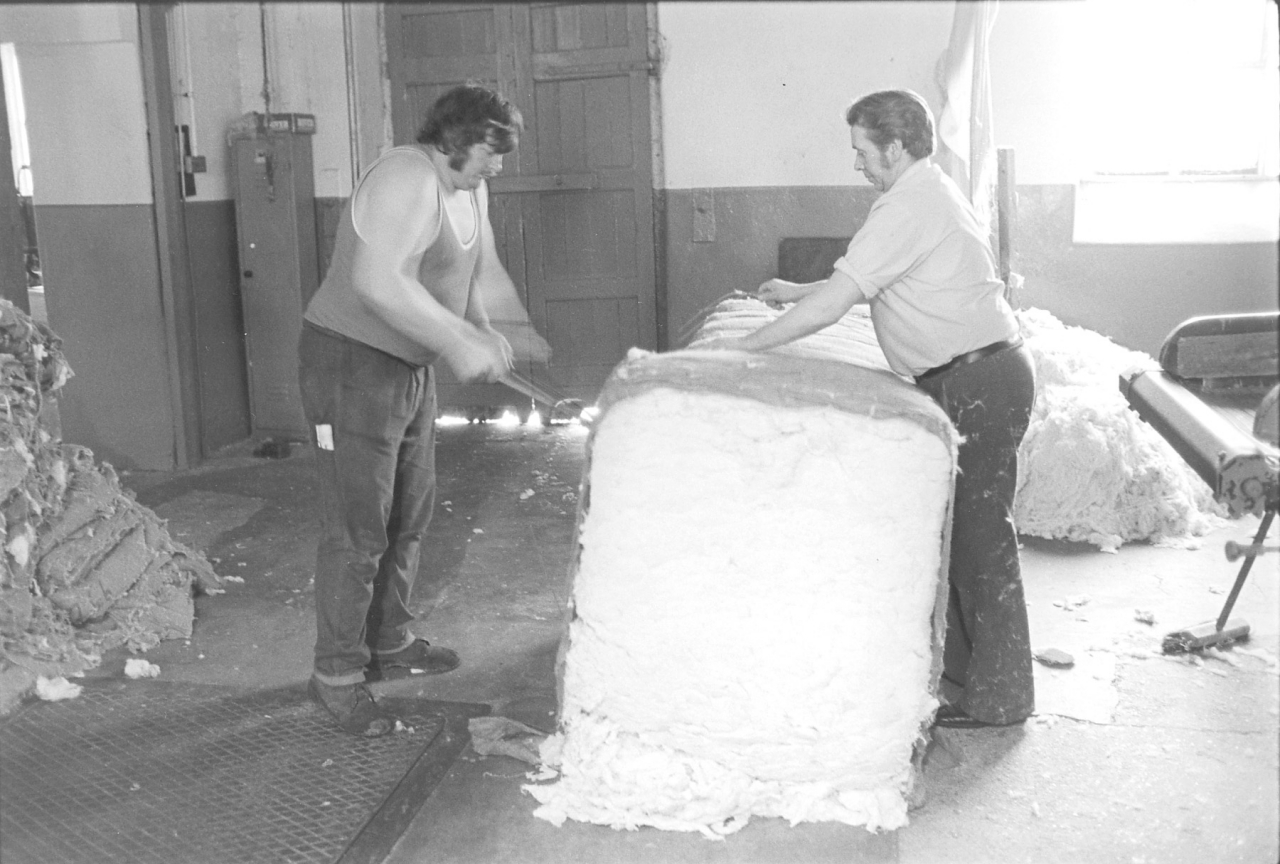
R- That’s a bale that we’ve taken off the scales and put behind the jumbo. I was there cutting the wires, then you can see where I’ve took the tare underneath, like this one you can see now. That’ll come off in one piece. And the wires like, you cut them and if you look I’m cutting near the top of them wires, that means the joint is some distance off the floor. See, when you take your wires off your bale they unclip. The joint runs through like a clip and you can unclip them. Once you’ve unclipped them you’ve got your lengths near enough the same size. If you make them odd lengths, by the time you come to tie ‘em up to throw them away for scrap if you cut them all different sizes you are more likely to cut your hand when you’re trying to tie them up. Get them all the same size and there’s less chance of cutting your hand. Like I cut me thumb once on somebody else cutting one. They’d stuck it through the tare with it being a long one. Well I got used to cutting me own and it were also the opposite way to what I put them on. I always put them on so all the round ends of the wire were all at one end and all the sharp ends at the other so you know you are careful on them sharp ends but you’re all right on the others because you can’t cut yourself. But you get some silly twit who puts a wire on the opposite way round so you don’t know about it, and also it has a tare on the end of it, well, I went like that to get hold of the tare and that wire were the other way round and through the tare and when I went to get hold of it went right through me hand. I had a lovely dance and all. I told everybody in the mill to make sure I got the right person, the one who put it there. (750)(35 min)
Presumably there is a lot of pressure on these wires so that’s why your mates having to hold them down?
R- Yes. In fact that’s probably where I get me speed from. I can move me head faster than most boxers. You get that, you cut them and it’s just like a whip lash. Have you ever seen an elastic band when it breaks, well the wires are just like an elastic band when you cut them, it flings the wires up, like you can stand that far away and still get caught by them. With the length like. You can stop them coming up that way but you can’t stop them coming down. So if you happen to be stood too near there, like one bloke that I were telling you about the other week, he caught one one day and his wife had nothing to do with him for a week or two because it caught him in rather a tender spot.
Not too good!.
R- Especially when he went to have it doctored. He didn’t think so.
Yes right, we’ll move on to 8.03 before we get side tracked Roland!
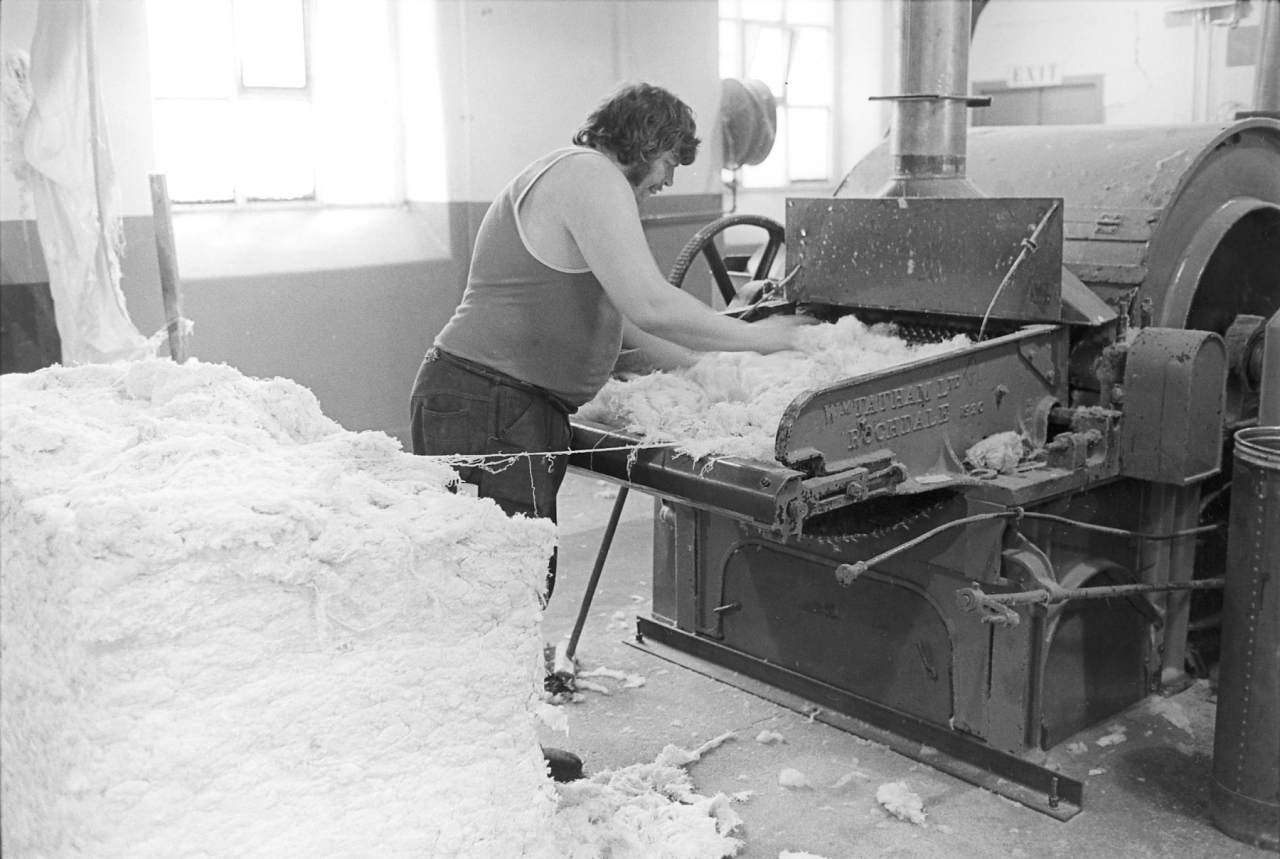
R- Well, that’s the same bale that I’m starting to feed on to the jumbo. You can see there is one or two long pieces there, strands like that are all right when you get thick lumps that are long but that sort needs cutting. Now you can see the arm that can knock the jumbo off a lot easier than this one on the right. It’s the one with a proper handle on it.
Oh I see, with a sort of triangular end piece.
R- Well you turn it right the other way and it'll stop the whole lot.
What’s this one then?
R- Now this long rod one. It's like a .. so you've got your cylinder there and underneath the cylinder there's like a trap door. If you got some metal in you can hear it rattling on it. Well if you leave it there too long it could fire it. If you push that rod it opens that trap door at the bottom and anything heavy is going to drop out underneath the cylinder and just pull it back and it shuts the door up again. (800)
I’m with you.
R- I know what there is there.
Do you know?
R- Like that’s where the hose pipe is.
On the window? Yes.
R- Yes. Now that's where the dust bags used to be. See, they used to be there and I’d covered them up with boards. They had some long like doors, I had that so I could stack round otherwise I could only go to there and that wouldn’t last long.
It was falling into it, yes.
R- No, it weren’t that. It just wouldn’t last that long when you were getting your bales down. But if I covered them up I could stack all the way round them. Once it fired and it went over the top of the boards into the stack, it also set fire to the doors. And like your hosepipe, I don’t think it were there then, it were put there afterwards. So we had to get the hose pipe from down here somewhere which were a fair way to go with it. And there weren’t much pressure on it if I remember right, it were a dry summer and they were short of water. It’d be about ten years ago now, during the summer.
1968 was it?
R - I’m not sure what year, it’d be about ten years ago anyway. And there weren’t much pressure on the water mains. No, we were having a job putting the fire out.
Do you know why are the window cills all sloping?
R - I don’t know, I have no idea and they all do, all the lot in the mill.
I just wondered if it was to stop people putting stuff on the window cills and stopping the light coming in.
R – No, I don’t think so. I don't know whether it was right but I got told it was to stop people having a brew when they weren’t supposed to be having one.
Oh I see. Because there was nowhere to…
R - See, you couldn't put your pot down and go on the floor. Now whether it were right or not I don’t know. But going back when them mills were made I can believe it’s right.
Yes. OK. Picture 8.04.
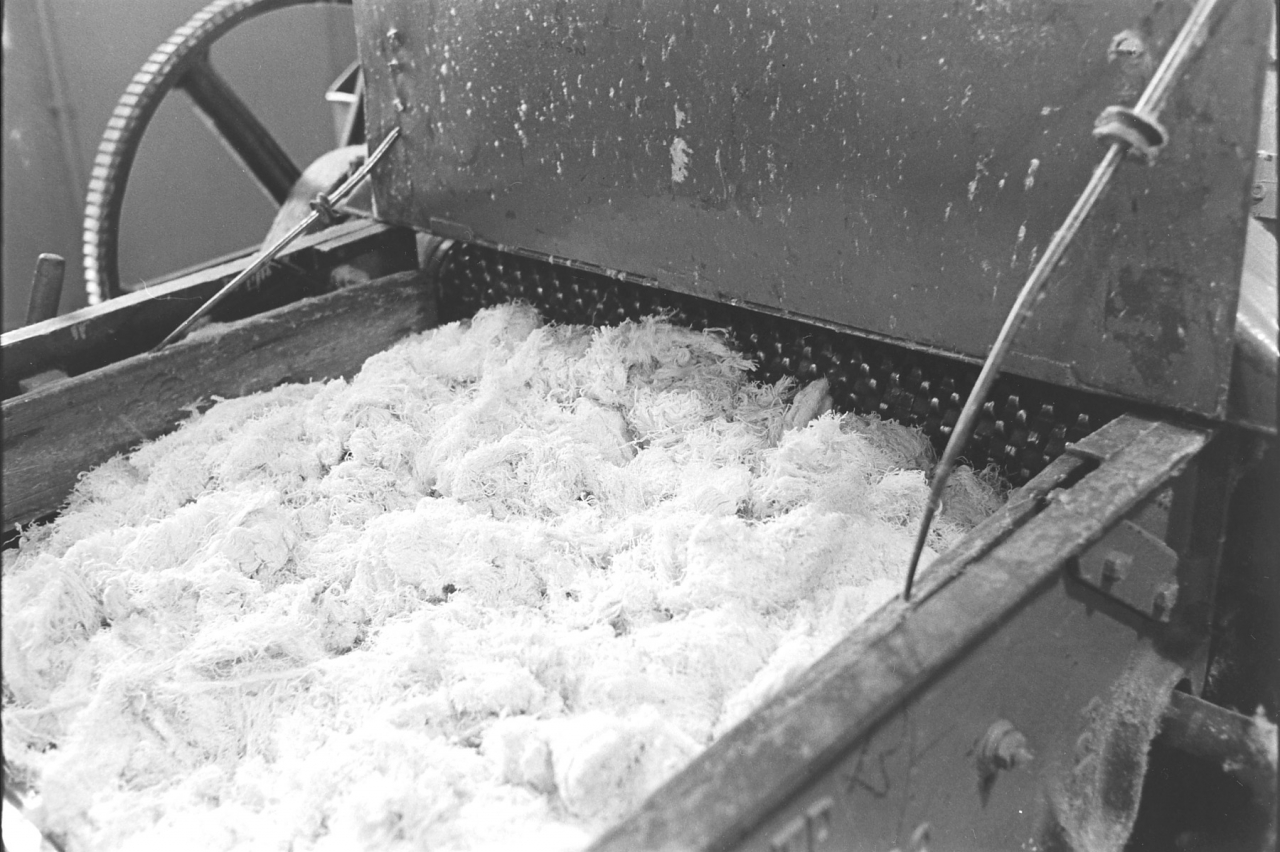
R- Well that’s just a close up of the lattice with a feed on.
Is that a normal feed?
R – Yes that’s a normal feed, not even hammering it there, probably because I were being watched. Again you can see me so you can see how far down that’d got. It’d be down to there.
You wouldn’t see a thing would you.
R- I wouldn’t see anything wrapping round there. (850)(40 min)
But presumably it has a safety catch?
R – It’s supposed be a safety thing. See, you’re supposed to have that down really, to stop you putting your arm in while it’s running.
Wouldn’t be much left of your hand if you got it in there would there?
R - It wouldn't do owt to mine, because I just go like that and it’s too thick for it to go through. But if you let your finger run through it can make a mess. Like if you let your fingers go right through to the cylinder, your cylinder would rip them to shreds, there wouldn’t be no such thing as stitching them back on. I once had a piece wrapped round me wrist and pulled it in that, went over the top and just caught me thumb and it only caught one thread so I snapped the cotton. But somebody like yourself, or a smaller person couldn’t have done that because you wouldn’t have been able to snap it. Because it were about that thick were the cotton that’s wrapped round me wrist. It marked me wrist but I just snapped it as it pulled. In fact I had to have three stitches put in round me thumb there. And that were through a piece of cotton just wrapping round, just pulling me arm. Now if that guard had been down I’d probably have broken me arm because me arm would have cracked up against there. There are advantages and disadvantages with all these safety things they put on sometimes.
Yea there are.
R- But again, that’s what it’s for, it’s a safety to stop your arm going in. I never used to bother like that ‘cause I used to get played heck with off Johnny here for that, ‘cause if I got cotton wrapped round there and it were only this I’d pull it off anyway even while it were running and Johnny never did like me doing that.
No, I don’t suppose he did.
R- But he knew he were wasting his time telling me to stop it, I still do it.
8.05. Roland. Now what’s that?

R- Yes. Now that’s my mate Jimmy at the other end.
You call that the front end don’t you, the delivery end.
R- Yes. That’s the delivery end. Now that is down .. you'd think he were praying, always praying were t’lad. You have a roller underneath where he is and some of the stuff is short, it drops through instead of coming up through these two rollers at this end here. It drops underneath. So you've got to get down and scrape it out from underneath. Now your two arms there are for lifting this top roller and you lift that if you get a thick lump, it starts sticking on it if you lift that up it gives you a bigger gap there and you've a chance of that lump coming through. (900)
Like a mangle I suppose.
R- Yes, it is similar to a mangle. Like if you lift it up it allows that bit extra to come through.
On the left?
R- Yes, on the left hand-side. Now then that were the wheel that kept breaking with the old drive. Now this is the new drive they’ve put on with the ‘V’ belts and it runs on a motor from underneath. Now before, it used to run off this itself, off the main drive which were where it got all that power from. See, with putting this small motor on they’ve cut the drive down so it drives off the small motor whereas before it were driven off the main drive which is a few thousand revs a minute. So when it went, they could go every week them wheels, it used to fly all over. In fact the main reason why they changed that were because they couldn't buy any more of them wheels, and even them that make them hadn’t got any more. And to make another wheel, a special, like that it would have cost them three or four hundred pounds apiece. Well it weren’t on weren’t that, not the way they were cracking up.
How often was it breaking?
R- Well, the last, before they changed the drive, that last twelve months it broke nine wheels. But you see, if you like, say we had a few spares like they had two or three jumbos at one time, and they’d gone through all the spares by then. Well, they would with nine breaking. And they bought two and that cost them five hundred pounds I think for two new wheels and it bust them in two weeks, the two of them. So they were saying that were rather expensive.
What was causing them to break?
R- When you get a lot of this really coarse stuff it takes a lot more breaking. Like normally you just get a bit in a bale now and again but when you’re getting a few bales with a lot of it in there’s nothing you can do about it then, even, I tell you, I used to try to feed it, it’s likely to gather round your main cylinder, you know it wraps round it doesn’t pull it all off. So you’re starting getting a lot on your cylinder and it goes in bump, so that the weakest part it bumped against broke.
I see.
R- I don't think there’s anything else on that one. 8.06 now that's where your feed’s coming through there.
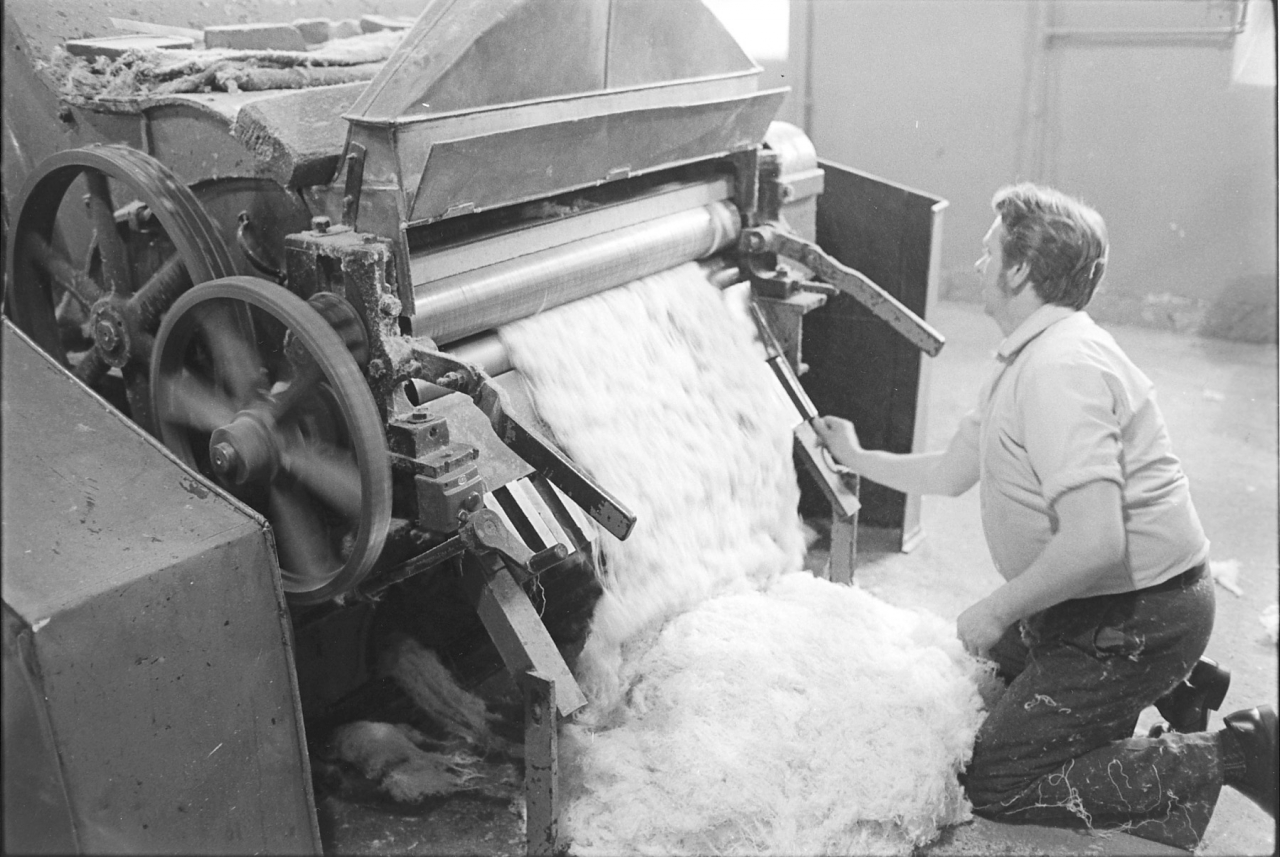
Does everything look normal?
R- Apart from he’s getting a lap on his roller (on the right hand side). He’ll have to pike that, on your right hand-side on that top roller he's got a bit of a lap going on. Again, he shouldn’t be running like that, that cover there should be down.
But then he wouldn’t see that it’s lapping.
R- No. You’d see that there because it only goes at that but you wouldn’t see if there were a lump on the doffer, that’s the small ones are called the doffer, the big uns are the cylinder. Well, he wouldn't (950)(45 min) see the lumps on that doffer it that were down. Normally he has that down anyway, but if it’s running bad and he leaves it up he can see if it’s not pulling it all off. Because if it doesn’t pull it all off, when you leave it on there it builds up and it scotches here. Them wheels scotch [jam] and you’ve to stop them trying to do that. If it doesn’t reverse back you’ve got all these bolts on the left and right hand side on this little plate, you’ve to take them all off so you can lift that roller a little bit higher to try and pull it out which is hard work. In fact you can see that’s that wheel goes at a fair speed but that's nothing to the speed it used to go on the main drive. Now you can see the rings on it there, your spokes. When it used to run off that main drive you couldn't see them spokes. So if it bumped, and away it went. ‘Cause like they were only cast iron, not like they were steel or owt like that. In fact if it was steel I think it’d break the machine so that’s probably why they didn’t make them out of steel, they made it out of cast iron ‘cause they knew that were the weak point. And that were going to go. 8.07. I don’t think there’s much difference there.

He’s taken the lap of though hasn’t he?
R- Well he has. I think that were what he were doing on 8.06.
Oh yes, in fact in 8.06 he’s got a piker hasn’t he. In his hand?
R- Yes, he’s got a piker. It’s like he were lifting up to take that lap off but it’s gone through. He’s deep in thought isn’t he.
Yes, he’s contemplating things here.
R- He is worrying in case it does it again. You can tell, there is stuff that is likely to wrap round your rollers is that.
Because it's longer threads?
R- No. It’s, what should I say, it’s fine stuff, like it’s fine cotton and the finer it is the more chance there is that it’ll wrap round , you only need a small rough piece on there and it starts wrapping round. And like his worst trouble is like, say he gets hold of a handful to stack it, between leaving there to stack it and coming back if it hooks on the moment he walks away and he hasn’t seen it, by the time he gets back that roller’s completely full and it’s a nice mess undoing it.
(1000) Oh there’s like blocks that the cotton is running over at the bottom. You’ve got a roller and then a plate and they might look like blocks of metal. Well I suppose they are blocks of metal but they’re magnets. They’re for, if there’s any bits of metal in your cotton that’s coming through the magnets will draw it out, or is supposed to do so.
I was going to say, does it work? Because I would have thought that it pulls it off again.
R- No, it’s surprising. They’re strong magnets, you can drop a big key [spanner] on it and hold it firm. But I mean you get your little bits like runners off ring frames, such as that and it’ll hold them as it comes through.
It's always amazed me that it is such a manual business. You’ve got to get down on your hands and knees to pick that up when it’s gone through.
R - Yes, no easy way to do it. I said I could do with a lattice running from there into the chute . I won’t tell you what they said to us. It might not be fit for a lady’s ears anyway.
SCG/01 July 2003
7,281 words.
LANCASHIRE TEXTILE PROJECT
TAPE 80/SHJ/03
THIS TAPE HAS BEEN RECORDED ON MAY 15TH 1980 AT 119 BURY ROAD, HASLINGDEN. THE INFORMANT IS ROLAND TAYLOR, JUMBO OPERATOR AT SPRING VALE MILL. THE INTERVIEWER IS MARY HUNTER.
Now, I think the last time we were here Roland we stopped on 8.11. So if we start on 8.12 and it’s over to you.
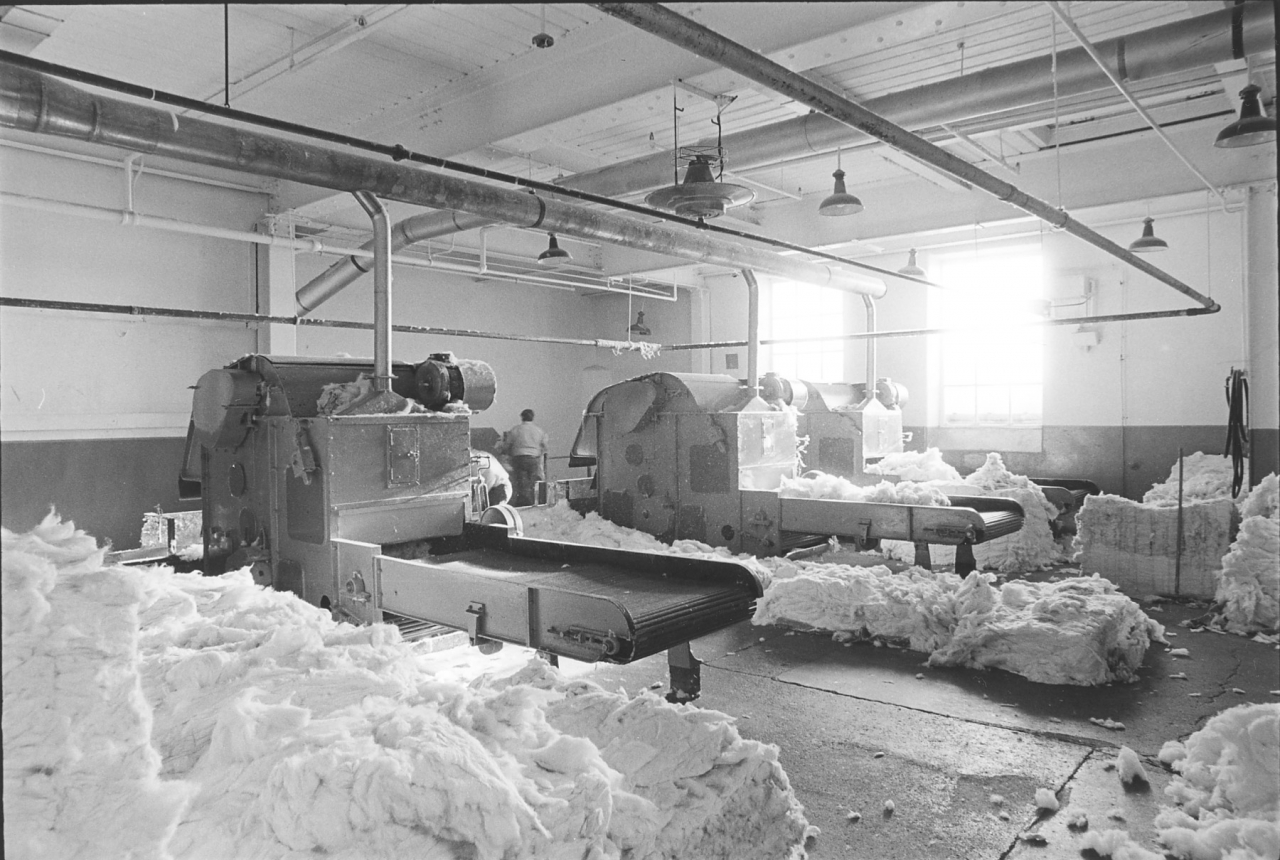
R – Well, that one's a picture of the blending part of the room. There’s three of the blenders there, there should he a fourth one higher up on the left. It shows you the mixing, the blending mixing down there. They must be crafty, they’re not in, some of the workers, must be brew time. Not much you can really say about with ‘em being stopped apart from the fact that the lattice here is fed cotton, a mixture of each bale on to the back of each machine on the lattice there. And each machine has a different mixture of bales for each one, they’re not all the same blends.
So there can be up to seven or so bales and they’d all be different qualities of raw cotton, is that right?
R - All different sorts, yes. Well there's going to be more, there’s only four in them because they’re the Pneumafil (?), higher quality stuff, there’s ten in that bottom mixing, them are all your small hard bales. Because that machine’s run slower than the others to break it up more. See , a lot of these are hard bales, hard pressed bales. So the machine’s set slower to break it up more.
And these machines are in the same room as the jumbo and the previous ones are they?
R- Yes they’re in the same room. Yes.
It seems to be quite a high room. Would that be for a reason?
R - No reason, no. It just happened to be that was a spare room at the time when they were putting blenders in. In fact 1 think there used to be some cards in this room originally. I can just see the humidifier on the top there, that’s for in case, I don’t if it were like it is now, it sends like a spray of water down. Well not actually a spray, like a film of water because cotton should always have a certain amount of dampness in it or it'll dry up and it’s hard work to run it. Get ‘em on mules and they’re dry and they won't run, they just keep breaking down.
They snap do they?
R- It’s the water that puts the goodness in the cotton. That’s why Lancashire used to do cotton more than anywhere else because it were so damp.
That's right yes.
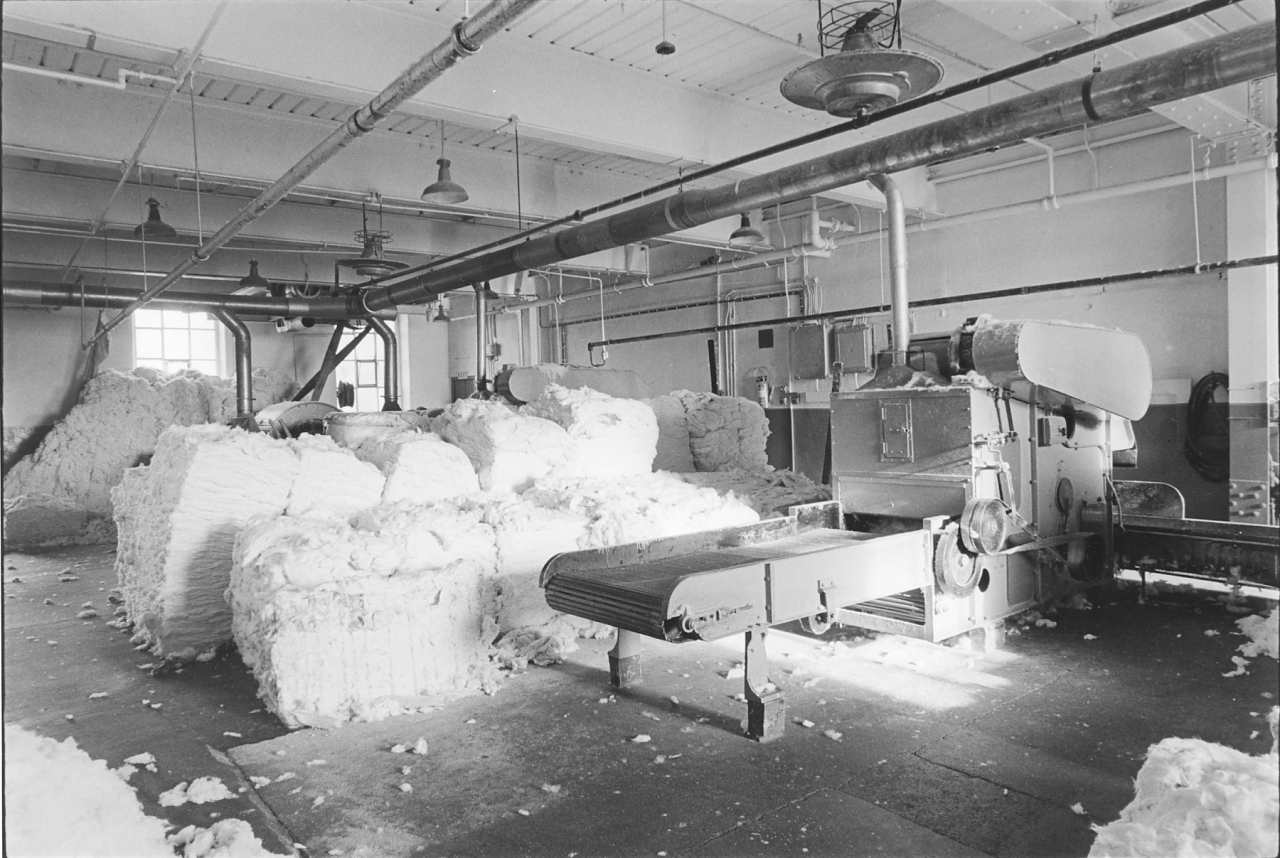
R – Now this is 8.13. It shows you, that actually does show you a row of machines higher up. You can just about see it and there’s actually one, two, three, four, five, six, seven .. you can only see, there’s nine normally and there’s two round the side of the… there's seven come out in a line and two go the opposite way at the back of them, right behind the machine. Because you couldn’t go any further, any other bales into these others and they ran out. (100)
Why do they put two, why do they put them the other way round or is there no reason for that.
R - Well they are that way for it's easier for the men like. If you put them the other way round you wouldn't get them all in that line, you’d have to put them doubles and they couldn't stretch over the top of it to get to the other bale at the back. Like they're going, they're running diagonal now. If they went the other way they’d have to put .. say they were having them set out now like they are there, you'd have to put two and you wouldn’t be able to stretch over to reach the second set of bales. Like, that way you see, and you can actually roll that, if you started there and you can roll the cotton off the bale, you roll with the press.
Oh I see.
R - So you can get an armful off. Well if you have it the other way you've got to pull and tug with it all.
Well how do you get say to this middle one on the far row?
R – Well, there’s a gap down there, in between the bale and the machine.
Oh I see. Right. Sorry.
R- You get, when you put these bales down them two mixings, they actually meet in the middle of the gangway, the gap down it, like you can see on this right hand-side one you can get down the side of the machine. And you feed off, just turn, get hold of an armful, turn round and you are right on the lattice. Again there’s not much you can say while they're stopped. It's easier to describe when they're actually running.
Who decides what the blendings are going to be? Or mixes as you call them. (150)
R - Well originally, well when Johnny were the manager he first decided what went in each blend. Well when Roy took over he, he knew enough to take over what Johnny left, the only time there were ever a change were if they ran out of a certain lot of bales and you’d have to change and put in something similar to it what you had, you happen to have. But it were, originally it were Johnny's blend. Like there's a lot of things still Johnny’s that were done there.
So basically they’re still the same, and any different ones Roy decides, does he?
R – Yes. Well, he sees Brian first. He decides what there is to decide and what’s to go in.
But I would have thought, getting…
R - Like it wouldn’t be long since, when were it? A month or two, a few months back that Roy and Brian were both off. When they went out and that mixing I knew normally what the mixing is but there weren't one of the bales in. He didn’t stop because neither of them were, I picked one at the side of, it were the nearest to them what were there. As it happened they’d have picked the same one so it, we weren’t so far out because as I was saying when you have been there long enough you have a rough idea of what can take its place. Again that was through working with Johnny so long too.
That's right.
R- Johnny would have put this and he faces them that way on this so I shove that bale in…
Am I right in thinking that getting the right mixing at that stage is probably the most crucial part of the process?
R - Right. You go wrong there and it's .. right the way down the line it goes wrong. In fact we were the ones that got cursed by the spinners if they have a mixing that starts going wrong. They say “What are you doing with your mixings. They're rubbish.”
But presumably, this sort of operation won't be found in any other part of the industry apart from cotton waste.
R- - No, I don't think you do get blending like that, not even in wool and I worked in wool too. They don't mix it the same.
Yes. It's peculiar to a firm like Whitaker's where they're manufacturing cotton from .. it's called cotton waste isn't it? (200)
R- Yes I think it is. Well the way… Yes, it is cotton waste. And like the trunking across that you can see on the top of the picture. That's the dust extractor, it takes away whatever dust is being made, and there is a fair whack as you can see on the machines, had actually come out of it, but that doesn't take it all away. But it’s bad, we had a break down once and we had to run with no dust extractors and then there were some dust in the room. Now 8.14, this were done on a Friday I’ll tell you, when he did those photographs.
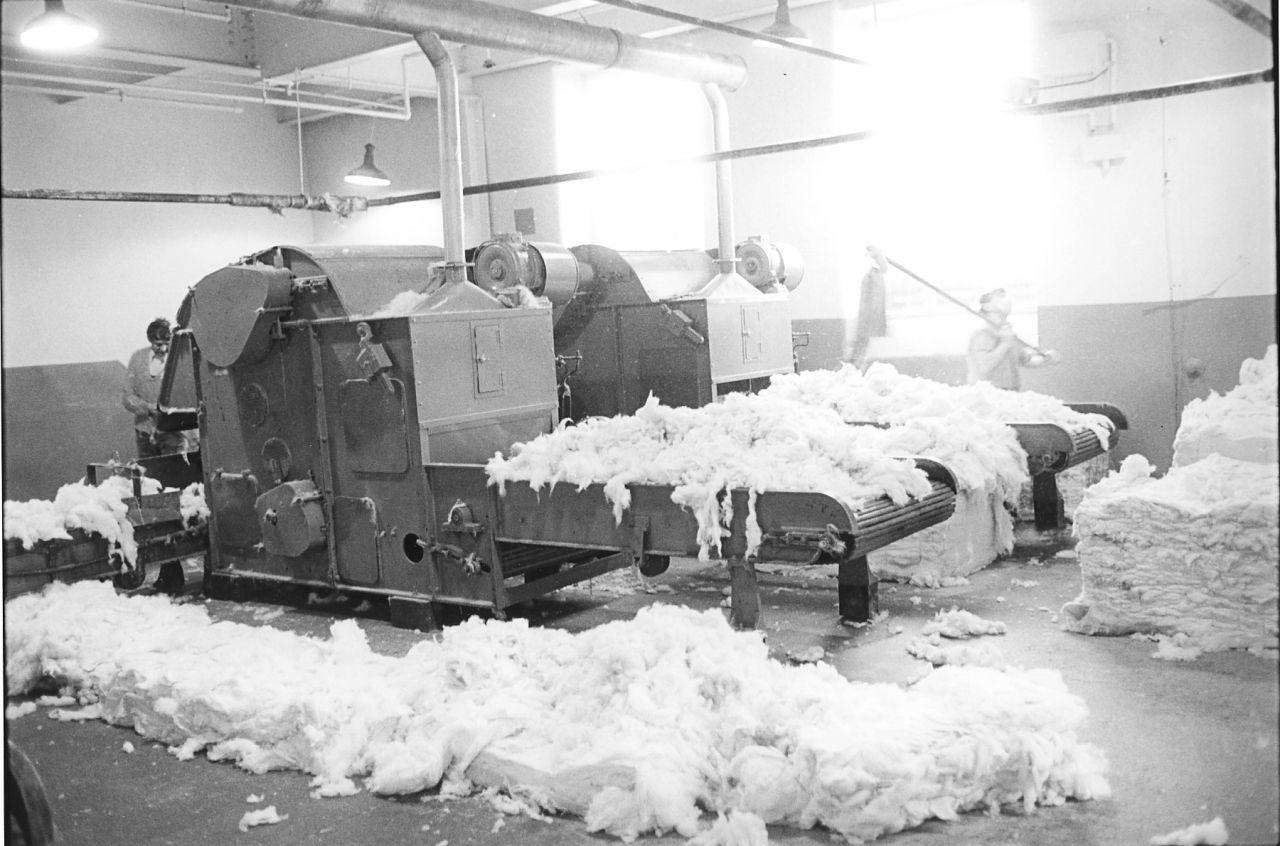
Probably.
R - It were, because they are cleaning. Again .. I wish he'd have come when they were running.
Are none of them running?
R - No. It is, it must he Friday for him to be dashing. The bloke on the right here has a dasher. It’s for dashing the cotton dust off the ceilings.
That job is called dashing off isn't it?
R – Yes. It's the cleaning you do before you start. Like it's no good to start cleaning your machines then dashing tops off, then you have to start cleaning your machines again. And you only start dashing off when you know you are not going to run them again 'cause it's a waste of time doing it if you are going to run them, you're only going to get dust back on them again.
So that's a Friday afternoon job?
R- Normally Friday but mostly, the last few months it’s been all day Friday. Well we've been finished by Thursday night, done all the bales we wanted. Like before then, when I started, it used to be two o'clock. (10 min)(250) Friday afternoon before we stopped so you only got two hours in which to get your cleaning done. Well, unless you’d have come in Saturday morning, we used to come in Saturday morning sometimes or Friday night. Like when I first went there we used to work till half past eight Friday night, we got four hours in. Instead of Saturday mornings we did ours on Friday night and got finished Friday night. It got changed to Saturday. See, it’s a lot easier to describe when they're running, you can’t really describe the machines when they're stopped. Like there’s a weight on the left hand-side of each machine, a weight on an arm on the left hand-side of each machine. Now that controls the lattice that the cotton's on, there’s like a door inside and when it’s full it shuts the door, and that controls the fast and loose mechanism on the pulley that drives it and stops and starts the lattice. When it’s full it runs on to the free-wheel, when it starts getting empty the door start’s opening again and it let’s the belt go back on to the drive wheel and consequently your lattice puts cotton into the machine again.
Well that was a very clear description Roland. Don't worry.
R - The cover on the left hand-side at the top…
The half moon shaped one?
R - Yes, well that has a chain drive in there and that drives a beater at the top of the blender and there’s a beater there. You have to open it up a bit. Now the one on the left at the bottom, that drives two rollers inside that turn a spiked lattice for the cotton on to which your cotton sticks. The beater knocks the excess off and back into the bottom so you only get a certain amount going over all being well.
Right. That’s circular as well isn't it? That bottom one?
R- That's the one that I said drives the…
Yes. Is it circular? Just for the purposes of identification.
R - Not really, it's almost square in fact. Just rounded corners on it. It's rounded corners on it, it's not actually a round un. Again you can see a bearing just before you get into your cotton box at the end of the lattice. Again that’s one of your shafts for your lattice. You get cursed and all if you don’t oil them up every day. 'Cause it starts stopping and when you start stopping, your (300) lattice has a tendency to snap, like they are only wood. If they start jerking and they catch, you are liable to snap them. And you can just about see one underneath there that’s the roller that drives an ordinary wooden lattice inside and that one just drives up to the spiked lattice, carries your cotton on to that so it keeps dropping on to your spiked lattice as that's going up. I don’t think you can say much more on that one.
Is that a typical feed going in?
R - That's what a typical feed should be like. When Arthur gets busy that's only about half of what he crams on to them.
Because that’s actually quite a hefty feed compared to say, what you put in…
R - That's a little, no that's a little feed is that, to what he normally puts in.
But that’s about right.
R - That is. See, you can just about see the .. well on this other one there’s no actual door on that one, and there is a door inside as well.
On the far one?
R- Well there’s a little one there and there isn’t on the bottom one. Now by rights, Johnny use to say like “Your cotton should not be higher than that because it's not going to go in.”
Right.
R – But it will go in, it’ll force its way in, but by rights you’re not supposed to go above that, only supposed to be level with that so it goes straight in. Nothing else there about that one.
Am I right in thinking that this feed that we've got in the foreground, the bales have been used quite well because they’re nearly all about the same level which means that it’s been fed properly, it’s been blended in properly.
R- Yes well, near enough. All being well he’s taken a bit off each bale all the time.
That’s right.
R- But I’ve known some that would come and take a great big load of this one and then another and if someone comes in it looks as though they have gone in level.
Right, so basically you take a little bit off each bale per feed on that, that’d be a mixing?
R- Yes. Well, you could take a couple off that on there and then a couple off your other on to the lattice. Because it takes about ten minutes or a quarter of an hour, if you didn’t put any on, to empty that box inside. (350) (15 min)
Does it?
R - So as long as, within an hour, you’ve got some off each one, you’re going to get a mix. Well, as I say, if you get a big armful off one and another big armful off another you are not going to get it mixed because it’s going to be empty before you get to your last bale.
Right.
R – Now, different number. That’s 79E2027.
Well yes, that’s…
R - Number 009. we’ll start on that and go on just to single numbers.
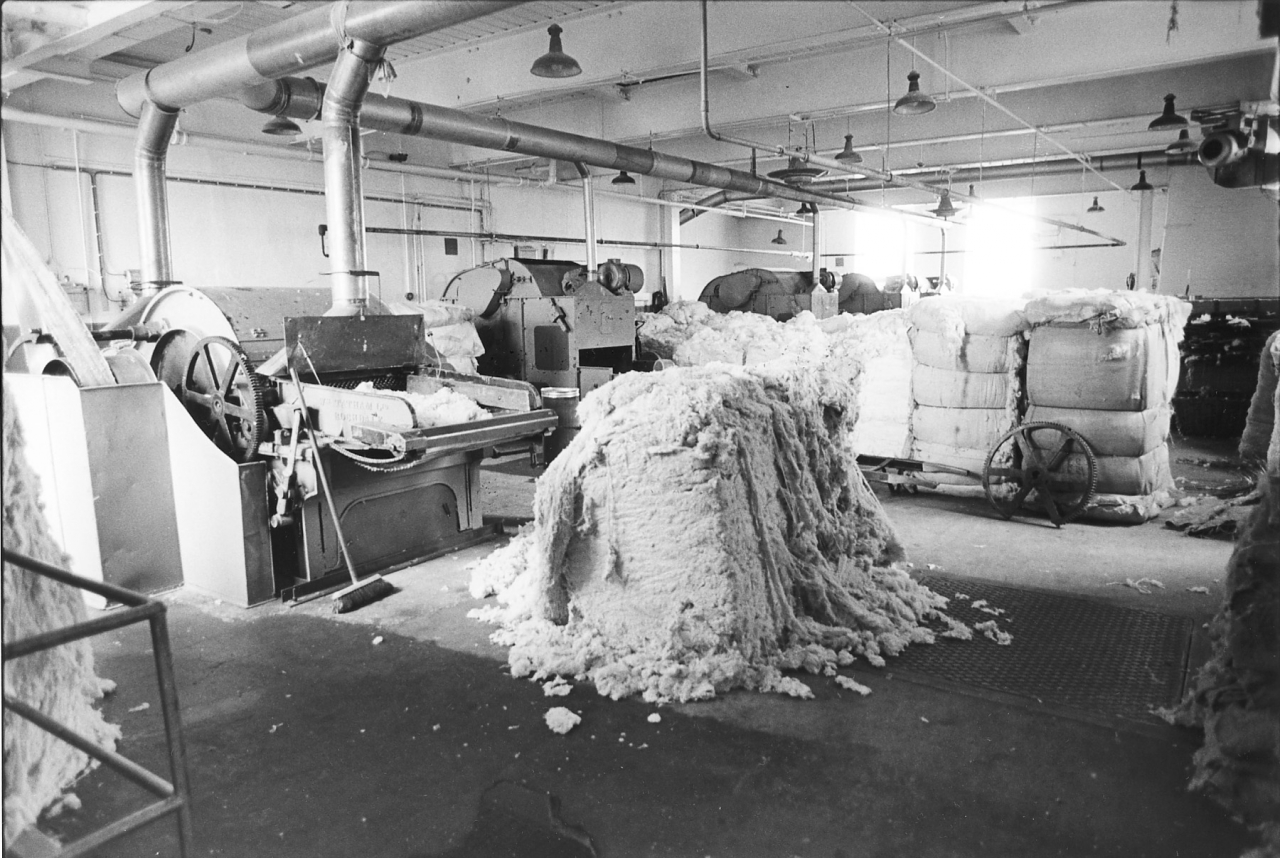
That’s right.
R- Again, that’s a photograph of near enough the complete room now. You’ve got your jumbo there, and all your four blenders. And do you know I was telling you about that wheel that keeps snapping? If you look against the bale on your right hand-side you've got one there with, it snapped off on the bottom there.
Yes.
R- And the bale’s just been opened there and all. It looks like it went when I just opened that one. Again it's stopped so it could have been lunch time when he took that ‘cause I don’t remember him taking that one. Yes, nothing much you can say about that one, just a photograph of the room.
Of the blending room.
R- Yes. But it is a complete photograph, you can see the jumbo and all four machines in that one. I thought the humidifiers were running but they’re not.
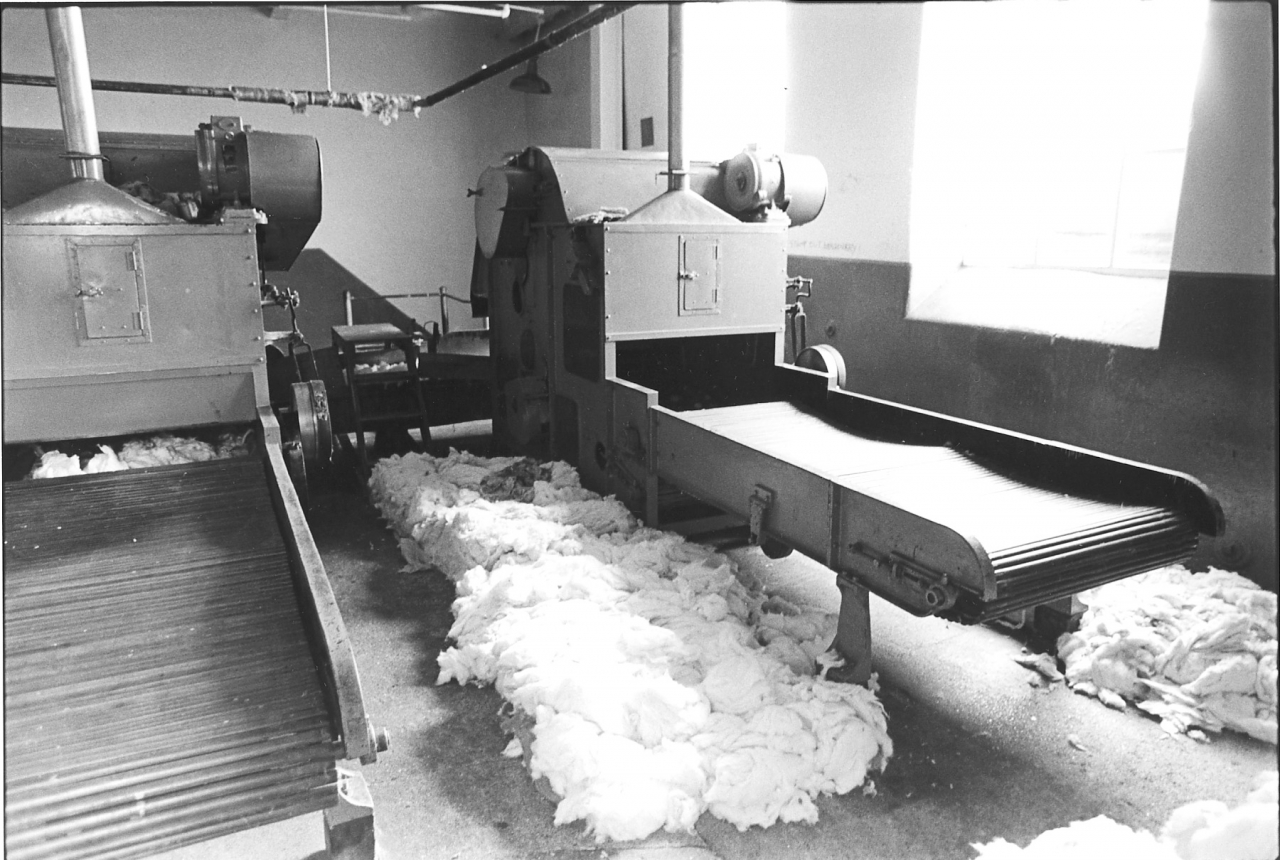
Now number 10 is, again it’s a Friday, ‘cause whenever it’s on a Friday you’ll see all the lattices and normally the machines are empty. Because on Friday you’ve to lift the door on the top of the blender. Now you’ve to climb up on the top of each blender and lift the door up and clean the spiked lattice. On the right hand side you can see a door that covers, you can just see the motor on top there. Now that drives the belt that drives the spiked lattice. Now that one, like there's a door on it, on the edge of it, you can just about see the edge of the door. Well that's let down and you take the belt off and you lift that cover up and you've to pike it with a piker in between each lath but you're on .. and it takes a good half an hour to clean, to pike each lattice, ‘cause you've to turn it on the side with your hand as you’re piking. That’s why you can tell there is no cotton in that machine, very little in there 'cause if they were full of cotton, it's hard enough turning when it's empty but if you get it full of cotton it's a hard job for two man there, never mind one. I know because I've done it. Number 11. Well…
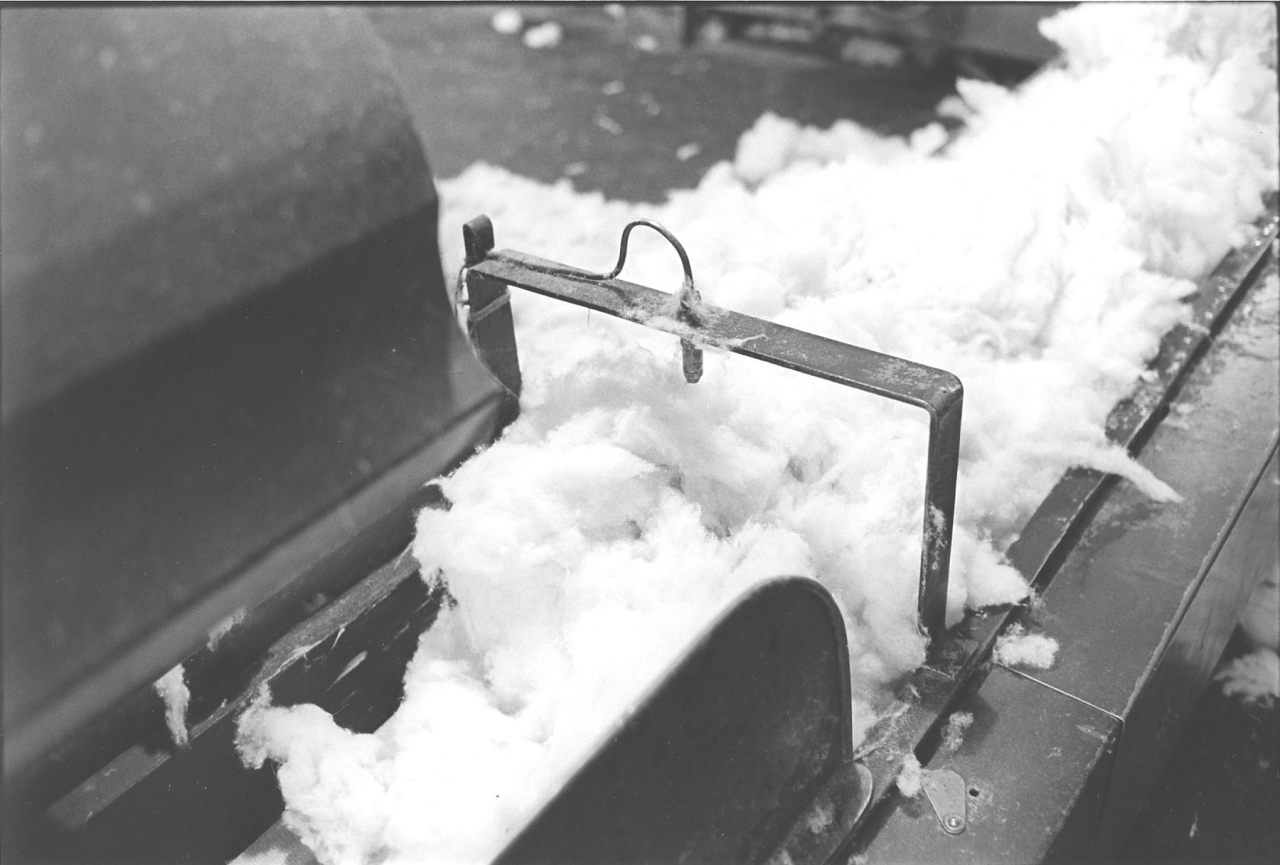
No, turn that one actually Roland. Sorry, it's showing through, I haven’t labelled it properly.
R- Well that one's a photograph of, you know we were talking about cotton that goes into the box and we empty that and bale it separate? Well that’s a photograph of the lattice taking that to the press. And I think you can just about see the spray going on to it.
Is it soap, or is it oil and water?
R- Well, some people call it soap and some call it oil but I can wash me hands in it so I call it soap. It cleans you if you wash your hands. In my book I call that soap and then Johnny always used to call it soap. I think it’s BP [the oil company] that fetches it. They do another one that mixes in with it, when we are mixing that soap there’s a textile oil that goes in with it. Mind you, that again is damned good stuff for cleaning, better than anything you can get in the shops. It’s that concentrated it’ll get grease off your hands.
Will it?
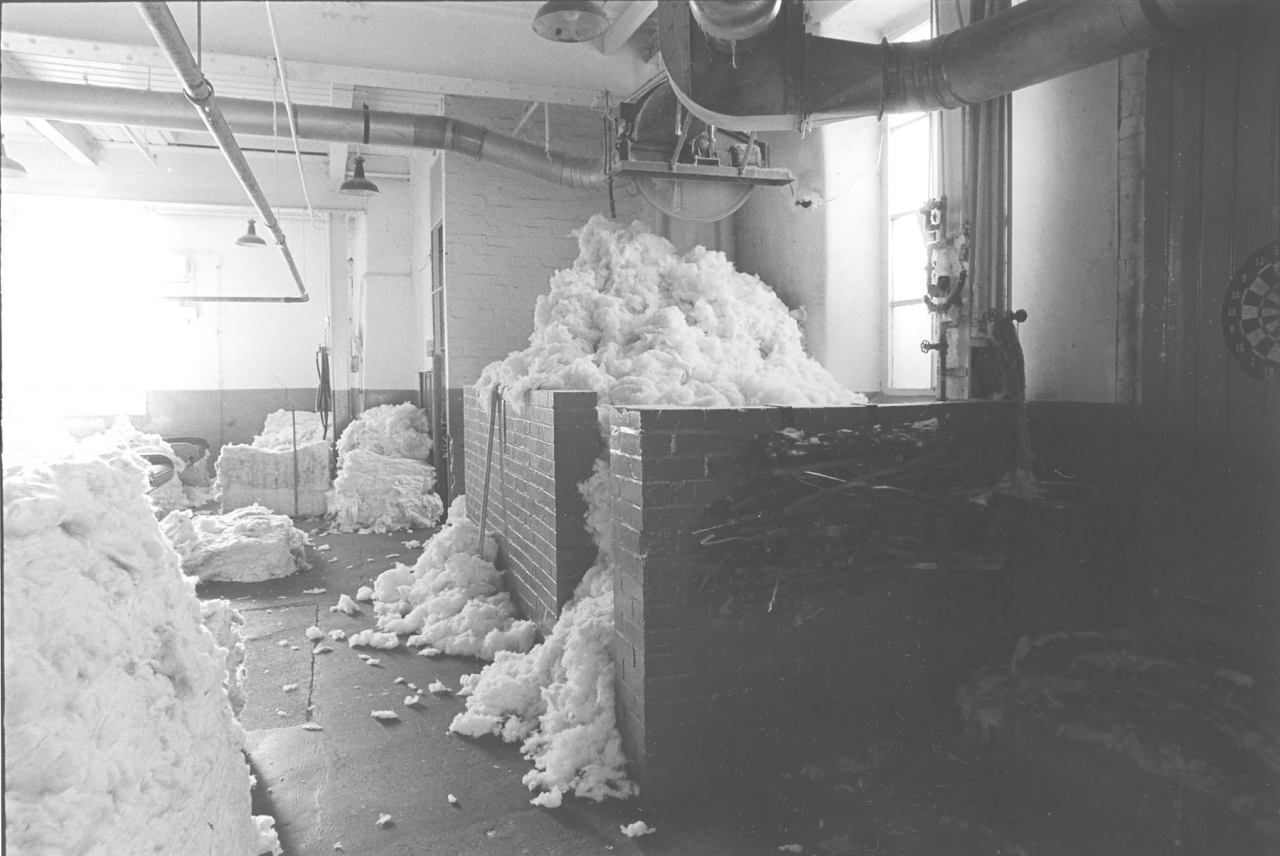
R- 0012. That’s your devil cotton going into the press. Ready for being pressed if it’s owt like. We have two lots of devils for cotton. There’s the sort we have for ourselves, which we have cotton we call rovings in with it. Well, you can see that there and it’s being sprayed. Now we always have ours with the soap on. Now the other cotton, devil cotton that we do, is for sale. Now that has no rovings in it and it had oil put on it, it were dry, they always wanted it dry. If they wanted anything else on when they got it they did it themselves. (20 mins)(450)
So this is the delivery end of the blenders and this is the continuous belt that goes past all four.
R- Yes it goes past all four, it’s about 80 or 90 feet of belt and it goes right round.
And, and just to make sure I’ve got this right, from here it is baled.
R- It goes into the top of the press and it’s baled. Yes.
It then goes into the warehouse to condition it, in other words so the soap or oil can soak through it properly.
R- Well, it’s not done for that actually. Once it’s had the soap on we can use it straight away. We’ve had to do that before now when we’ve been making for sale and we’ve had to rush some of our own through just to finish an order. We’ve to put it straight in. I’ve known us do the mixing here, bale it up and bring it straight back into the blending machine to be blended. You can’t just shove it straight in. We’ve done it like that, it’s been baled and brought straight back into the same room to go into one of them mixings. See, they’ve put one of those, one of our devilled roving bales, they’ve put one in the top mixing and two in the other three, two or three of them in the other three mixings. See that is better cotton than a lot of comber we can buy, that’s why we can sell it because it’s better than a lot of comber we can buy. It also makes our blend a lot better. Like if we didn’t put any of that in the spinners would be flying round with their hands in the air. Well, seeing as we are getting a bit confused now, this cotton on the conveyor belt now is not coming out of the blenders, it’s the devilled cotton that’s come out of the cotton box in the same room. (500)(25 min)
There you are, 8.10.

R- On 8.10 on the right hand-side about half way down the room you can see like a brick wall with two doorways into it. And you can just about see some cotton in it. Now the cotton from that box is carried on to the lattice by hand and the blenders are stopped. So the devil cotton is baled up on its own then it is brought back up to be mixed with the comber bales. Are you right now?
Right, now I understand. So in fact it’s merely being used as a conveyor, it’s nothing to do with the blenders at this point.
R Not at that point. But as you can see the blenders are there to feed on to it when they are running.
Right.
R- ‘Cause on that one you can tell the difference between your devil cotton and your comber cotton that comes out of your blenders because when it’s devil cotton like this it's all fluffed up and there's plenty on the lattice because you are feeding it on by hand. Now, when it's coming out of your blenders there is a lot less than that on the lattice, it's very low down .
So basically it's one of those sort of funny things that has developed because of moving new machinery into an existing place. Because basically what’s happened is that the stuffs come up from the devil room below.
R- No, I’ll tell you how it actually happened. Originally when I first went there, that devil cotton was fed into the first two machines.
Two blending machines?
R- Yes. It was carried, and you could keep up with a devil just moving it on them two machines.
From the cotton box.
R – Yes, as well as your blend. But we got two people working here, a father and son, one was a deviller and one used to feed on these blenders. Now they used to let the box pile sky high and instead of a bit going in every bale they'd stop the devils then and the father would come up with the son and it’d all go in at once. So you didn't get a blend of devil cotton then, you got it all in one or two bales. As I said the manager caught them doing it so he said (550)(25 min) “Well, we’ll stop this. As soon as you want to mix bales up like that, you can stop them blenders and you can bale that on its own then we’ll know what’s going into them bales.” And ever since that time they really caused the extra work because it is extra work, and you lose on your ordinary bale through it. And you could keep up with it by just putting it on them top two machines. Just put a couple of armfuls on each time while you were putting our mixing on and it kept level with your devils. But they just let it pile up and put it all in at once.
Yes, I see.
R- So instead of getting every bale with a bit of devil cotton in you're getting about, like I say we did 36 bales a day, well we’d get about 28 bales with none in and then you got about 8 bales with all of it in. So Johnny made them bale it separate so we knew what was going into every bale. That conveyor belt was actually used as a belt for your blending machines.
And presumably then, beforehand, it didn't get this soap, oil and water on it.
R- Oh yes it did, as I said, our own always had it on. So then when you started on your bales you didn’t put any on. And then again, if they hadn’t done that they would never have been able to sell because they never thought about selling it then. It all used to go into our machines.
So when was the oil and water put on the devil cotton then?
R- There's two sprays over the top of that cotton box we were talking about, there’s two sprays in there.
Right.
R- Now when you are running your own you put them sprays on, so you not only do it to get it off here, ‘cause like I say, on here you’d only get four sprays on it. Now when the blenders are running there are six sprays going on them. But you cut the top two out because you are not feeding from them, so you really need them two in the box when you are doing it for ourselves to make up for the two you are mixing on the lattice.
Yes, right, I’m completely in the picture now. Thanks Roland. (600)

R- Now 0012. Now that is a better picture of your cotton box where you actually see your cotton piling up there. The wheel is what we call a Shirley Wheel [after the Shirley Institute] and the cotton hits that and it turns it down into the box. Like, before we had that, there used to be a, a fan, a suction, and it used to go to the room above it then drop it down. We got a lot of bother one year especially, with static electricity and the cotton was sticking to the trunking, went all the way up, and you were finishing, you were running for about half an hour, having to stop, climb all the way upstairs and get a ladder up and climb on top of the machine to push it down because it was stuck to all the sides in the trunking going up there. And the best way to cure it is to get a Shirley Wheel. And again they're more reliable. Right on the middle of the picture on the top that's a motor and that, have you seen the size of the one on the jumbo? Well it’s very nearly as big as that. And yet on that, up there on a couple of block and tackles, damned hard work because I gave them a lift to put it up, and it were damned hard work getting that up there. And like they changed all the trunking with putting that there, that’s the only reason they started doing all the lot when they did it. They started it just before the July holiday and they finished it while we were on holiday, most of the trunking. And again like you can see just underneath the trunking of that fan motor a pipe with the nozzle where the spray is. And there’s one same as this on the other side of the Shirley Wheel. Well you can see it but you’ve got to look close. There’s, right underneath that fan is a nozzle like you see on a hose pipe, just there. You only see about six inches there but it's a bit bigger and there’s taps on the wall, just above your wall on the right hand side level with that dart-board which shouldn't be there. There’s taps on the wall there, on the girder there. Now the one on the left hand-side at the button, now that turns the oil off, stops it going into the pipes at all, it won’t touch that oil if you turn that off. Now there's like a twin one then comes out of that. There’s one on the left and one on the right. Now ones full of spray on the right hand side ‘cause if you are taking the cotton out you don’t want to be showered with the soap as you are bending down to pick it up. It comes out enough to wet you through. Now the two taps on the right hand side of the girder, now that pipe, and there is one on the other side next to that spray as well, that long one, you can just see the dark coloured one. Now they are like nozzles on a hose pipe and they are always fixed open and they had water in them. So if there’s a fire comes up from the devil hole into there you have at least a bit of something to put it out before you have to go for the hose pipes. While you are getting the hose from the bottom end of the room near enough the middle of the picture. (650)(30 min)
And there is one near your scales isn't there?
R- Yes, there is another one just farther up to your right hand side and another one at the other. Well, two more at the other side of the room. But by the time you get to that hose-pipe, if you haven't got those [fixed nozzles] on it, the cotton, like that will be blazing.
That’s right,
R- So you’ve got to turn them on while you actually go for the hose pipe. And there is a, where you see the dart-board here, just to your right hand-side there, there's a fire bell. First thing you turn on the fixed nozzles, then you turn the hose pipe on, you turn the fire bell on because there is no way you’re going to fight it on your own. I know because me and another bloke tried it once when they first started doing overtime and there were only two of us worked. There were him in the devil hole and me upstairs. Now if you get one row of devils firing and you are upstairs you are not so bad if you get that way. But that night, all three rows [of devils] fired at once. And not only that, they fired on the last cylinder. And when they fire on that last cylinder you've got trouble because it’s right on the lattice then when your fire goes and if it’s your left hand row of devils it’s straight down the chute and right upstairs. S he rung his bell for fire down there, I couldn’t go to help him because .. Now I couldn't go to help him with all these three because that was my fire, my cotton box were ablaze, and as I said the dust bag from the devils are in that back. Now they were blazing and all. So I had a hose pipe there and we are fighting a losing battle now, if there were four of us like they put on after that they might, like I said, they learn by your mistakes, they had four working then. But we had in fact, Jesse, he were called Jesse who were running the devils and he had to leave his devils blazing while he went to ring the fire brigade. In fact they said we did well to control all that because it didn't spread out of there, and his didn't spread off the devils. In fact the insurance bloke shook our hand, because he said “You’ve saved us a few quid. It's cost a bit as it is but if it had gone any further it would have gone into the bales.
So easily, so easily.
R- Like you see the cotton round here, it only needs to spread out and hit the other bales and the lot's going, and it's happened once.
I’m sure.
R- Well in fact it’s happened a couple of times, but once it were really bad, all the lot were going. And like I said, before that Shirley Wheel were put in it went straight upstairs. Now the fire went upstairs as well where we always had our bales stacked. It fell on them and all. So you had the top room going, the middle room going and the devil hole blazing at the same time and that cost a few pounds 'cause a lot of bales once they’ve been burnt they're spoilt. They have to be thrown out, they’re no good to you

Now your number 1201 [Spring Vale folio, Svdevils section], now that is the devil hole. Again it's stopped. Now again that must be a Friday ready for cleaning and it's not like him leaving a feed on unless he's had a fire and stopped before they got on again. 'Cause if you have a fire you knock the devil off, you stop them completely, if it’s a small one you just stop that row.
Yes. Now this in the room down below?
R - yes, this is the room underneath the blending room. It’s a devil hole.
Devil Hole.
R- No wonder they got that name, Devil Hole.
Yes, I’ve seen it and it always amazes me.
R- And I think it’s originally how it got it’s name because they called them Devils because they fired so damned much. Like the old fashioned folk, such as our grandparents saying “The bloody Devils are firing again!!” Like ‘devil’ used to be a swear word for our grandparents whereas it isn’t now. So you said “Devil!” And so it like got it’s name from swearing at the things firing rather than ….
Yes. I wonder what’s the proper name for them. Breaking down machines I should think.
R- Well, I would say they would be something like a breaking down machine but they could break a lot more than cotton too. They took one blokes head off did them, right off!
Did they? Really?
R- Took another bloke’s thumb off, because Sam Riding, one of the directors, it had stuck to… Again the bloke were doing what he shouldn't be doing, lifting the cover up before it had actually stopped. It had been knocked off but devils take a quarter of an hour to stop from the time they press the button. So again, if you’ve got your hand caught that’s really what them guards were put on for, so that you can't get too close to them but they are also damned inconvenience too. All right for that factory inspector saying "Do this, do that for safety”, but it doesn’t help the work. It can make it damned hard work and that really does make it hard work. Like you can only feed on that at the back, and if you’ve got three devils and that’s clearing in two minutes. (35 min)(750) Now you've got three to feed. It could take you two minutes if it needs sorting out, if there’s some rough stuff in. Now you can’t send lumps through because of the tendency to fire on lumps. So you’re sorting it out and by the time you’ve finished that you’ve got to start on this one again. So it got that you are non stop feeding all three. Well, without them guards you could feed a full lattice .. It takes five minutes to feed in. So you got time to feed, if you’d fed all three you could sit down and watch them for a second. But you are sorting out with that guard, feeding on the back of each one, you don’t get a minute. And it’s all right, like I say for those Factory Inspectors with their little rules and so on. Like on this front big wheel on the devil here, see, it’s covered in. Now every Friday all them have to come out and the same with them at the other side, you can see they’re covered in. Now all you’ve got is a finger tip to hold them and they are a fair weight. I’ve had my fingers trapped there, somebody slipping off and my fingers were underneath. Well before they went on, you could get hold at the wheel like that, no way your fingers were going to slip off them. But they said you could get your arm through them and get it trapped. But them wheels on there, they only move slow. Now I could understand it if it was one of them fast wheels, like your one with your rope drives on, now them are fast, they really shift do them, they need guards on. But a thing that is going slow, if someone is going to leave their arm in long enough to get their arm trapped they deserve it. 'Cause I think it takes a minute to turn completely. If you are going to leave your arm in a minute while it's turning then you want your arm trapping . There is no way it could happen. Again, it’s more of a hindrance to us than a safety measure. I think there’s four or five of us had our fingers trapped. Like if you’re greasing or oiling you tend to have a bit on the end of your fingers so if you get hold of them it just slips off, it’s not your finger that catches it, it’s the person at the other side. And by the time you’ve shouted it’s too late, it falls that fast you’re fingers are trapped. Because you’re watching your own hand not what your partners doing. Well, when you’ve done it long enough…You're used to your partner, you are not watching what he’s doing, you know what he should be doing. But if it slips off and your fingers are underneath and it damn well hurts. Like there’s two steel rollers and there’s no gap, well very little gap, I don’t think there is more than an eighth of an inch between them so you’ve got your fingers which are about a half an inch, a fair crunch when it comes down. You do shout then! And again, if you’ve noticed in them pictures there’s two buckets in the alley way because if it’s only a small fire a bucket of water will put it out. See, the more water you put on the longer it takes to dry out and the longer you have to wait before you can set it on again. And all the time it’s stopped it’s losing money. So you use as little water as possible. Again, if you put too much on you’ve a chance of rusting something, it doesn’t matter how much you clean, sometimes it’ll rust. Like it is now with them kids the other day. It’s really rusty now.
What, the devils?
R -A lot of things. No they got some kids broke in the other day.
Really?
R - When were it? T’other Sunday, and they let eighteen fire extinguishers off all over the cards, all over the scutcher, turned those pipes all over everything. Spinning room was flooded. In fact they were stopped all day Monday just cleaning up before they could even try to set on. And like they had hose pipes on there, well they are rusted, the mixers are not running now but it would have been the same if they had been running, you’d have had a job a real full day cleaning up again before you could set on. But as I say your fire buckets are there so if it’s only a small fire you can use them. That saves using your hose pipe, like you can see one hose pipe on your left, near enough the middle of the picture where the drive belt is on the left hand side. If you look at the bottom of there you’ll see another hose pipe there. Now where this photographs been taken from , on the wall where it’s been taken from, there is a bigger hose pipe, it’s the one we use more than any of the others because it has a bigger jet on it, you can get at the fire better plus the fact that it will reach right to the other end of the devil hole. Now these on the side, and same on the other side wall, they’re shorter, they’ll only reach about two cylinders. And again, aye, you can just about see the reel on the top at the right hand side, there is another big hose pipes up at the top end. So, if you’ve got a big fire and you put your fire bell on , if your grinders are coming in from the card room like, they’d come through the rubber doors at the top there and they can go straight to the big hose pipe if it’s a big fire. If it’s only a small one they won’t bother they’ll come and help where you are.
Now they've got six cylinders haven't they, those devils?
R- Yes, there’s three rows each with six cylinders. There’s two rope drives on the front of each devil and two rope drives at the back of them. Now you can just see on the left, at the bottom on this left hand side one. Now the top on the right hand side there you have a belt drive that runs from the right hand side on this front lot and from the left hand side at the back, opposite to where your rope drives are. See, it drives from the back end of your rope drive on the front one and in the back end of the rope drive from the far side. So you’ve got your belts running, one drives the front three cylinders and your back one drives your back three cylinders. And they drive off a shaft that comes straight out of the motor as drives all the lot. There’s one motor, you just see the doorway to it, half way down the left hand side. Inside there’s a big motor and by big, I mean big. [picture 1214]
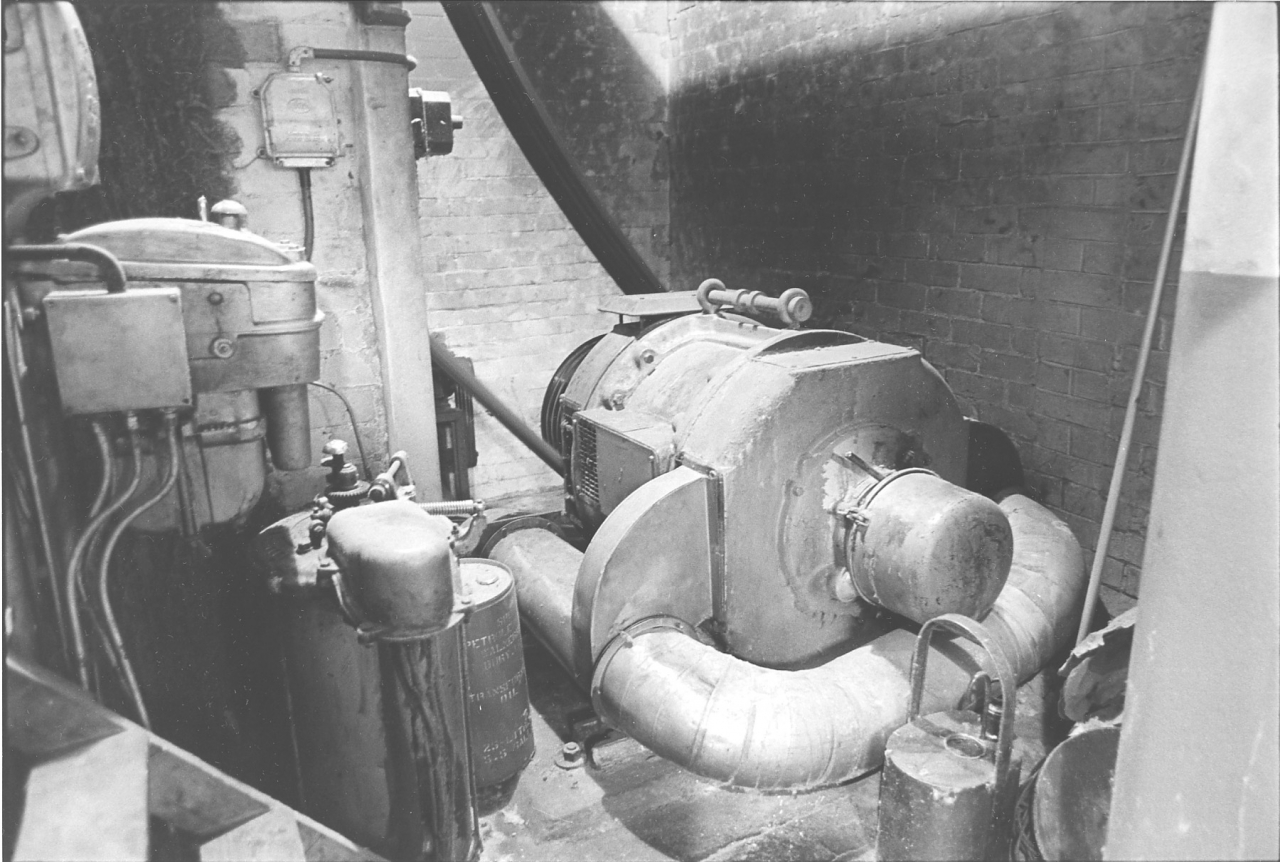
It will have to be to drive them all.
R- What is it? The motor itself is about two feet high and four feet wide, round about four feet square and about two feet high, that’s just the motor itself. Then it has ‘V’ belts in that drive actually running off the motor to drive the shaft. Now have you ever seen them ‘V’ belts, them pieced ‘V’ belts? [Dawson Speedona were a very common make in the larger sizes] Now they’re normally about that size and pieced together with rivets like it's what shall I say, well on the devils and the jumbo like you get an ordinary drive and on most of your smaller motors the individual pieces in the belt are about two inches long. Each piece before they make the belt up, and about half an inch wide. Now that is each piece and there are a lot in an ordinary belt. Now in the devil hole drive, them pieces are about 12 inches long and three inches wide and about two inches deep. So you can imagine the size and I think there’s four belts on. So you can imagine what power there has to be to drive four that size and that drives all the devils now. This first row, well you can’t just see it but there is a girder up above and there’s a smaller motor on there which will drive just one row. They put it on originally because that big motor is that old they’d have a job replacing it if it went badly wrong, that’d be it, finished. Like small things they have managed to replace them like new control boxes and wire boxes and so on, they’ve replaced them but the old motor, the big one, if that went badly wrong it’s that old they couldn’t replace it. Well they got that one motor on the girder to see whether it would run one row. And again they were thinking like if they got a big fire you’ve to knock the other motor off and stop all three rows. You couldn’t run two and fight the fire. But it also, well if you had one motor on each row you could stop that one row and just use the other two.
While it dried out?
R- Yes, or while somebody were cleaning it up, you could still run the other two rows.
Yes, right.
R - And you wouldn’t, like that motor was, Now I don’t know what it would cost now but five years ago it cost five pounds just to start that motor. So if you’ve got to knock it off because you’ve a fire it’s costing you, well I’ll bet it’s costing ten pounds now to start it. Ten pounds is a lot of money just to start a machine up where it wouldn’t need to be if you could just stop that one row.
SCG/02 July 2003
7,606 words.
LANCASHIRE TEXTILE PROJECT
TAPE 80/SHJ/04
THIS TAPE HAS BEEN RECORDED ON MAY 15TH 1980 AT 119 BURY ROAD, HASLINGDEN. THE INFORMANT IS ROLAND TAYLOR, JUMBO OPERATOR AT SPRING VALE MILL. THE INTERVIEWER IS MARY HUNTER.
R - I might say in so many years time.
Well I think we were still on number 1201 weren't we Roland, whether we had actually finished I don’t know.
R - I think we’d near enough finished 1201.
But perhaps while we are still on it you might just explain what happens when the cotton goes through the devil machines.
R - Well the cotton it's, the cotton that comes off, that’s opened up on the jumbo is sent down a chute into the devil hole. Now that’s fed on to the devils and that breaks it up so you see in that…
1211? (50)
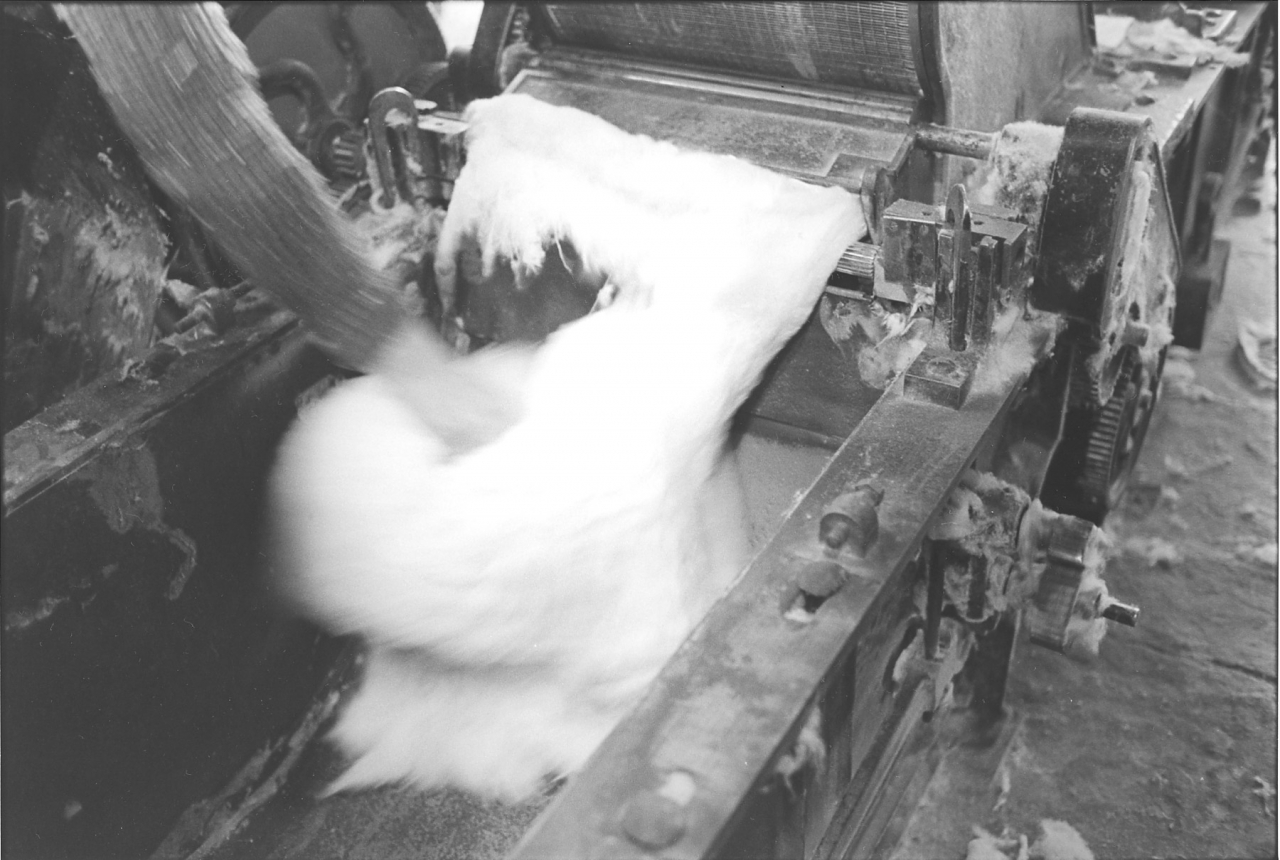
R - Yes. 1211. You can see it's fluffed up cotton. Well before it goes through the devil it's like ... oh what, thread, like white reels of cotton, that sort of stuff before it actually goes through the devils.
This is the first stage, isn’t it?
R - Well your first stage is through your jumbo. Your second stage is your devils and that breaks up till it looks like cotton wool. And it's just like cotton wool.
I see. I gather that some of the waste that you get in is of such a quality that in fact you can miss out the jumbo process and go straight on to the devils, is that right? Or did it all go through the jumbo?
R - The thread waste all goes through the devils. Now the only stuff that doesn’t actually go through the jumbo is the roving and even that doesn’t go through the main devils, it goes through what we call a single devil because it’s just one cylinder, it doesn’t need to be processed too much because it’ll spoil the cotton altogether, it would nap it too much. Now all your other actually goes through your main devils, just your rovings that goes through the single devils.
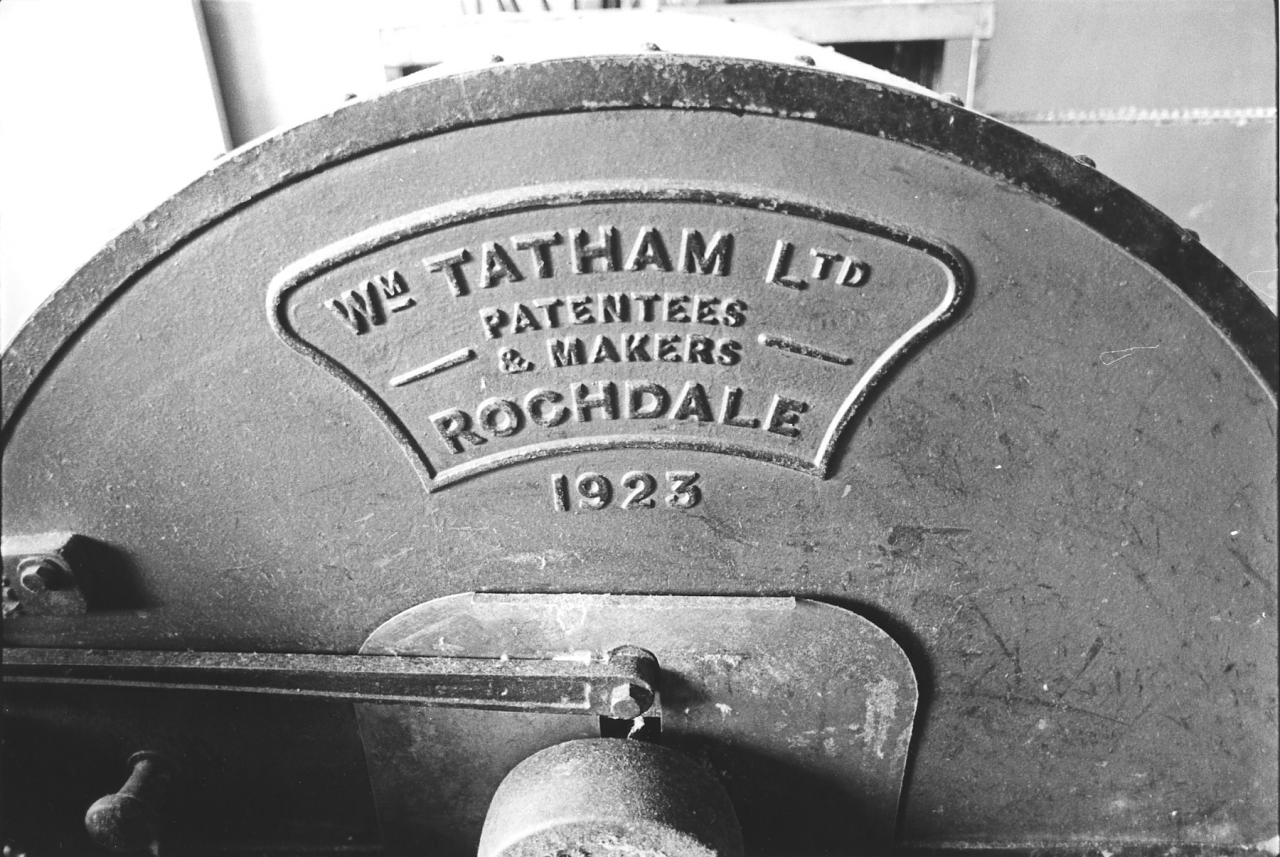
Number 0038. Oh he were being keen were the lad! This photograph is of the other side of one cylinder. Well it was William Tatham’s and dated 1923 that’s one of the young ones ‘cause some of them are older than that but that was perhaps one of the plainest ones for him to see. (100)
Are they still in business?
R- Yes. They’re still in business. In fact we had some of them wheels made that broke on the jumbo. They made them special but when it starts working out at over £300 a time it’s time to think of another method. And it’s what they should have done years ago, and they were told but they didn’t.
What happens when the cotton’s going through one of those cylinders. (5 min)
R - Well it’s like pulling it apart, so by the time it’s got to the sixth cylinder it’s, what shall we say, it’s like putting lumpy flour through a sieve, and it’s cleaned and smoothed and it comes out the other end.
And is each cylinder the same?
R- No, as you get towards the back you have less teeth in your lags and the nearer the front you are you’ve got more teeth in each lag. See, because it’s having to do more work. By the time it gets to the end, to the sixth cylinder, it doesn’t need as much doing, in fact if they had them all the same size there’d be nowt left by the time you got it to the last one, what’d be left wouldn’t be much use to you.
More like dust. (150)
R- No it wouldn’t be like that but it’s just that it’d been napped that much and nap is something they’re not keen on in cotton, it’s like small lumps all over it. Well it doesn’t spin that well.
What did you call it, nap?
R- N A P, nap.
Nap.
R – It’s 12.01 now I think.

Yes, that’s right.
R- Now then again you can tell it’s on a Friday because all your flutes, well, the things that are on the floor, they’re wheels and they are grooved, shafts on them, we call them flutes. Now them are the things I was talking about that were covered up and if they come down on your fingers you know about it. And again, the safety inspectors ought to work in a place like this before they start suggesting things. Like the one who did all that were fresh out of college, never been in a cotton mill in his life. I always say if you’re going to have a factory inspector, get ones who have been in the job. They know what they are on about, they know what can be safe and what can’t. And again, such like as him have put some mills out of business because they can’t afford to make them as safe as he wants them made. In fact I know of one or two mills that shut round here because they couldn’t afford to make all their safety standards that he wants and aren’t really necessary. Well, you can see all the covers that are up there and you can see the cylinders there with the spiked lags on. You have all your teeth at an angle they don’t go straight down, they are on a diagonal, same each time and they’ll go like six teeth, five teeth, six and five. And on the next lag it’ll be , I think on them first ones it’s seven six, seven six, and then six five on alternate lags on the cylinder. As you go further back you get less teeth in, I think your back ones only five five.(200)
Right. Yes.
R- Your very back one here, that’s only five five. But until, like if you’ve some broke, like them are £500 a time. We used to have them re-covered. So it gets so as you don’t send them in unless you really have to do. So sometimes you might get some in that it might be say six five where there should have been a seven six. Rather than keep forking out like they had there done about twelve or eighteen months ago. Well, I saw the bill, £1700 for three cylinders, well it’s a lot of money for three cylinders. (250)(10 min) And then these cylinders that you see on the devils here they were run what, well by rights, if they were going full time, like when we were doing overtime they were going 13 hours a day, they were running 13 hours a day because they were run like, through dinner times as well. Well when they were running that we used to turn them, what, three cylinders every fortnight. Now by turning I mean there’s a runner along the top of each of these devils, a small girder runs across with a runner on it that you hang your block and tackle on.
Yes, That is shown later on I think.
R- Now when we come to it again I’ll explain it. But then you lift these cylinders out and turn them right round, that’s what we call turning. Then put them down so that your spikes are turned. You see when they have run that long the they bend the spikes over. Well, you turn the cylinders round and it bends your teeth back again. Back into the position they should be. Otherwise if you didn’t turn them it’d be going through a cylinder a month, you’d want new cylinders every six months cause it’d snap them off after a while, they’d bend that far they’d snap off. Plus the fact they wouldn’t be opening the cotton either. ‘Cause they’d be bent the wrong way. You can’t see that so much on these. Like there’s two arms on the beginning of each row here, you can just about see that on the left hand side. Now the one that's pointed forward, that’s a lever that turns your lattice so it goes forward, or pull it right back and it will reverse your lattice so it doesn’t wind out. Now your one with the cotton round the angle it shouldn’t really be there but it’s easier to identity like that. Now that’s the one that actually starts your row moving. There’s like, well, you can’t see it with the flutes being out. There’s like a catch there that holds it in place when they are stopped so it won’t set on. You’ve to lift it up and then let your arm go forward and they’ll set on. Now you can see just behind it there’s like a small wheel behind it with a cover on. Now there’s an cage inside there. Now there again when you clean they have to come out as well but you'd only take them out as you do each cylinder ‘cause you’ve to drop the cover down then open that one up. And they all have to be cleaned and all that’s really just loose cotton that, as it’s going through, like you always get a bit left behind. Well, it also opens it up in them because your air’s blowing through it and the air actually helps to open it up.
Yes, I was going to ask you about that. There’s a gap isn’t there at the back of each cylinder?
R- Yes, about six inches, it comes out of them cages to the next cylinder.
Now is that to let the air in or out?
R- Yes, just to let the air blow through it. Really, as much as anything to cool the cotton down. Imagine something being pulled apart at 16,000 revs a minute, which is what them cylinders is going at. Well, they start getting warm so really, when they’re going through them cages it helps to cool them down. Otherwise if it didn’t have owt like that there , there’d be a fire before you got to the third cylinder. Each time it cools it off a bit.
So where is that air let in? From the front?
R- Well it’s only like a half cover on that cage, well, a quarter of your cage is open to the air all the time. Also, it’s all open underneath so your air can get up underneath it.
So it’s not artificially sucked in?
R- No. Well it goes in on its own, it’s not artificially sucked in, the turning of the cylinder sucks the air in.(15 min)
Well It will yes. Is the amount of dust on the floor normal? Cotton dust?
R- Not as much as there is there. They haven’t cleaned up yet.
So this is the cleaning operation?
R- Yes, but you get something like that every day. Just with them running, all the dust actually goes on the floor.
Right. Yes.
R- There’s a lot more than that when you actually start cleaning. Like that row hasn’t been touched yet, with them covers up ’cause I can still see the cotton hanging about on it. Somebody hasn’t cleaned them down right well and it isn’t me.
Cleaning in the devil room must he highly important.
R- It is. And I know that it hasn’t been done because we used to do that every night that row. It’s my row because I’ve took them out, I remember that. I’ve took them out, I always used to take them out before I went home for me tea. It used to save a bit of time for the lads when they come on at night because it’s a long job taking all them out if you’ve got to start from scratch, to do it right anyway.
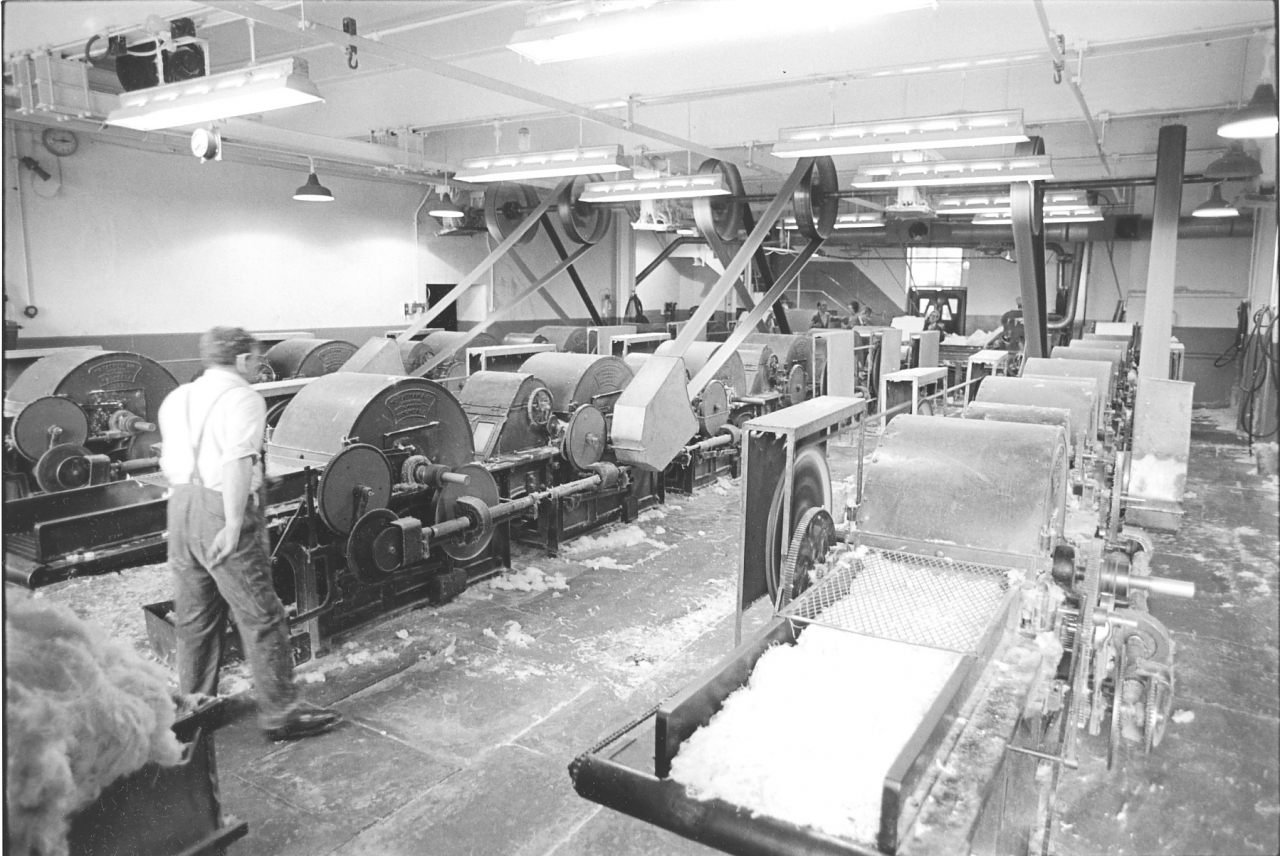
Now 12.02. Well, they are actually running there ‘cause that’s Maurice, the deviller, on that middle row there. And by looking at it I’d say he has a small fire on because he’s looking for a fire in fact. It’s actually stopped. He can’t see anything though, he can’t actually see, you smell it and you look. In fact you actually sniff at them cages I were telling you about , your actually sniffing each one of them. In fact the one that smells strong, then where your fires likely to be is in the cylinder in front of that cage, not the one behind. Like most people who don’t know it would go to the one in front. But them that’s actually running it they go to the one behind because they know that’s where it’s coming from. In fact at the back you can just see a small machine with cotton coming out on to the lattice at the back. Now that’s what they call a side end machine and it’s drawing the cotton off the single devil that’s in this corner at the left hand side where you can see it up there. It’s in the left hand corner there. Well that feeds through there on to your lattice and that's your roving on that single devil. In fact you can tell the speed that they are going at. These big wheels, you can’t even (450) see the spokes on the wheels in fact the cotton's all round. It looks like it is on this one, like if you just look at the thing it just looks like a painted mark and it isn’t. It’s just a lump of cotton on each one and it looks like a painted mark on the wheel . As I said, they’re going at 16,000 revs a minute which is if you, as I say if you ever get your hands in there, even when you’ve stopped it, it’s hard luck because it takes a quarter of an hour for it to stop. So if you’ve got your hand in there it’s going to be a hell of a mess. One bloke had his thumb taken right off with it. It had only been stopped ten minutes when he opened it. Just its stopping speed was enough to take his thumb off. We had to pull it off the cylinder because they wanted it at the hospital to stitch it back on and nobody would take it off. {blank on transcript] director, he weren’t so bad , like I say, that director came right up through the mill, he’d start off as a bobbin piker and went on to be managing director.
That’s Sam Riding is it?
R- Which isn’t a bad thing.
No it's not.
R- Like he, he just retired from the Board now. He’s about seventy so he’s had a fair innings. Now I can just about see that motor round about that first cylinder on the left hand side corner. Just above the light. See the dark patch there is the motor that actually can run that row on its own, or could do until the girder went. In fact they never bothered with it because when that girder went we heard we were shutting so they never bothered with [it]. (20 min) (500)
That could have been dangerous if that came down*
R- No, it didn’t actually snap, it just, there's like a metal strap that were holding the motor on to the girder, well that'd snapped and it had snapped the edge of the motor off, you know, they have like a leg on the motor it bolts on. Well it had snapped that across here and that motor had turned slightly, so it weren’t running proper. Nothing much there. Mind you, you can see in here the amount of cotton you got, but in fact that’s not all I think. I’d say you've an hour or two more, it looks like it's quarter to three on there. Well you imagine that at round about quarter to seven when we are knocking off, you've another four hours to go on top of that running there's a fair bit more dust on there in your normal day.
Stone flag floor?
R - Had stone floors, aye. It wouldn’t really do to have much else if you think about it. Like the mule room, it’s wood you know. It’d be burning would your floor so long. Again with your whatsit floors, composition sort of stuff. That’d melt, it would be expensive having to replace that every time you had a fire.
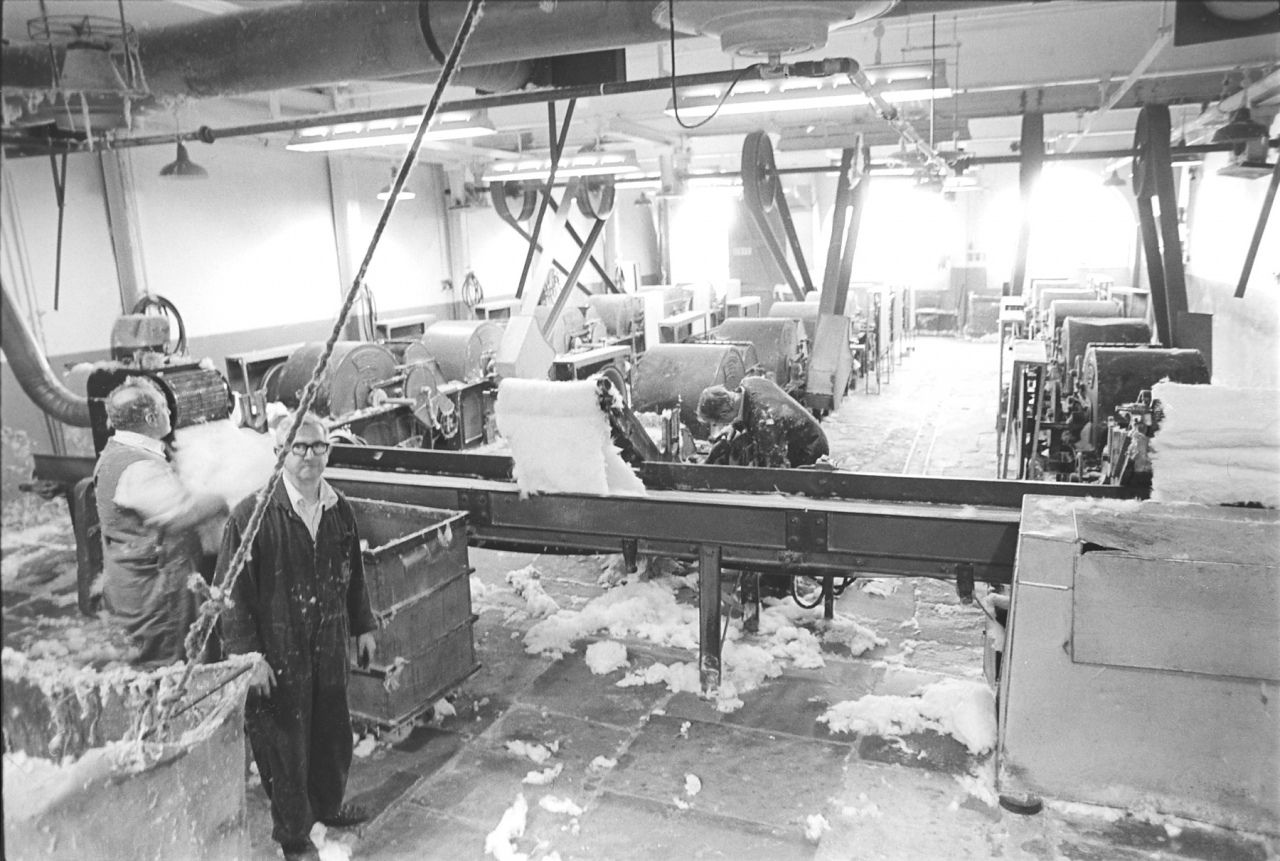
Right, 12.03. Now this is the back of the mill now and there, just in front of the far lattice as you are looking at the picture. And that looks like there is a cage at the back there scotched and he is freeing that is Joe Pilling the Undercarder. Eh, Charlie stood there doing nothing, it looks bad for a carder.
Yes I showed him that, he didn't like that.
R – No, you can tell that, he’s pulling his face when he took the photograph. No it looks bad the carder doing nothing. No he’s not normally a bad bloke, he were a decent worker were Charlie.
They worked very closely those two I gather.
R- Yes. But he could be , well let’s say in that department, on ours, that was really Joe’s department.
Devil room? (550)
R- Charlie hadn’t really done anything on that side not to that extent. Well Joe had been doing it for years on end. I'd say he were in the jumbo but I knew more about the jumbo than Charlie did. In fact I knew nearly as much about the devils as Joe did. I had done as much as he had anyway, well I run them more. When you are running them it’s surprising how you learn what you’d to do, what to mend and how to find it.
Oh, if you take notice there is no better way to learn than do it.
R- And the other man behind Charlie, the other man. with the cotton. Now they changed the side end , it used to run onto that lattice and they turned it and put a box on there because the devils were running for sale so they wanted us to do both. So they had the main devils running for sale and they had the single one doing for ourselves. Now they used to bag that cotton up until they got four or five big bags and then they used to bale that up. I think he made three bales every two days.
And by side ends you mean the side ends from the finisher cards?
R- No, them side ends from that single devil. The single devil comes through that.
But what was running through that single devil was the side ends from the finishing cards?
R – No. What runs through the single devil is what we call rovings, the stuff that doesn’t need to go through the jumbo. Now your side end waste that comes of the finishing cards went in with your sale stuff. That went straight into well, there’s like a chute at the end of this lattice with a fan that draws it upstairs, well they used to put the side ends straight into the chute, never bothered with anything. They didn’t need to, it had already been done once and it’d spoil it to try and do it again. I can’t see where Maurice is in that either. No, I can’t see the devil in there and they’re running, when they are stopped they are straight down like that , it’s your cotton. When they are running it bunches up like that. So that really, he must be somewhere down there but I can’t see him.
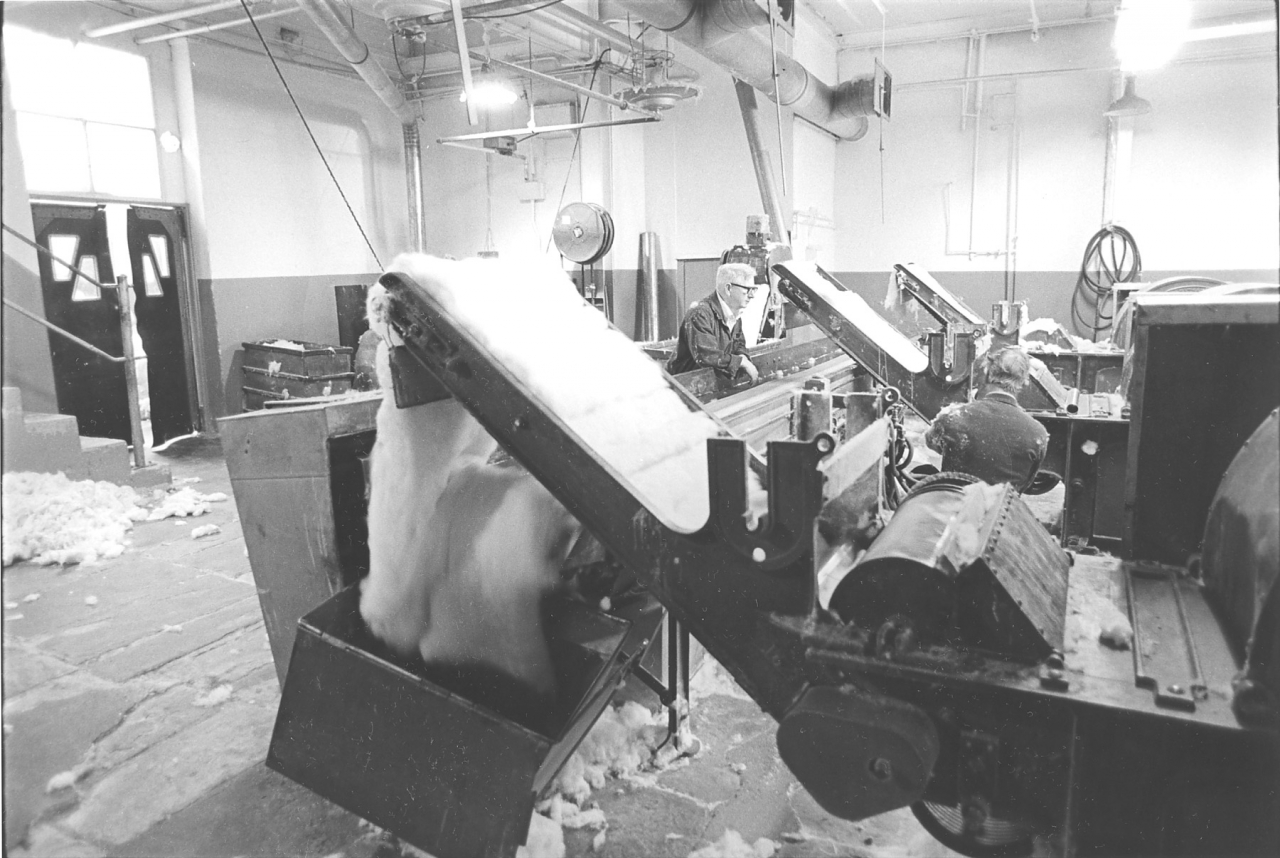
12.04. That’s near enough the same picture but from the side. It looks as though he still hasn’t got that cage unblocked. You can see that one isn’t moving ‘cause the cotton isn’t going over the top of your lattice. Now this one, you can see it bunching up, in fact he’ll have to come down to that because it’ll break off if it gets too much weight on this side of it. See, that lattice it near enough takes it’s own weight over so if you get it bunching at the back here it’ll snap it off. Just before you get to the top, on the way over your lattice. And if it snaps off there rather than on the other side where it goes over on to your lattice it breaks off so many small lattices going up that it’ll drop back down and then they don’t bung up at packing. If you are not sharp on seeing it, which could have been what happened on that one, it all scotches back on this back cage.
Why is there such an angle on that final lattice before it’s fed off?
R- For in case you ever have a fire. Because if you have a straight one there, straight on to the lattice, you have no time at all if you happen to have a fire up at that end of them. Now if you’ve got that going up and you see it you have a chance of stopping that, now once you’ve stopped that arm at the front of the devils it automatically stops.
Straight away?
R- Yes, right away. Now if it’s going up there you can get it. But if you’ve got a short one that’s going straight in you can stop it straight away but it’s down the chute and on its way upstairs and you’ve got your fires going and your insurance men are upset.
So that’s the entry point to be taken to the cotton box upstairs?
R- Yes, that’s the chute that takes it away. You can see it over the fire hose there, in the middle, on that girder, your main, the big fire hose. And if you look on the picture at the top here you can see how often them tops are dashed off because there’s no cotton hanging on the tops. We once had a small fire and it shot along the floor, right up the girders and straight across both ceilings and all along the cotton that were hanging down.
I bet you are not frightened of fire any more.
R- I never were but you hadn't to he frightened there. I think they sent for the fire brigade twice in the fifteen years I were there. And even then, each time we called them we had the fire near enough under control. Like the second time we called them we had to call them, not because we couldn’t control the fire but because we couldn’t breathe in the smoke, there were that much smoke. The firemen had to put on breathing apparatus to work, well we were working without it. And they said then that we were making a better job of keeping the fire down than they were with their equipment. But then again as I said, you know where the main part of the fire is. You know from experience, like with the firemen they had to come and then look and try to find it. While we knew where it were and were keeping it from spreading just from experience, knowing where it were.
From the little bit I’ve seen of the devil room in the few months I have been coming here, only having to get the fire brigade here twice in fifteen years is incredible. Before I started interviewing I must have been down there three times and on two occasions they had either just put a fire out or there was a smoke filled room.
R - Oh aye, it didn't take long for the smoke to fill up. Like sometimes that’s the worst part of the fire really is smoke. In fact if it comes to that, firemen will tell you it’s the worst part of a fire for that gets you before the fire does. (30 min)
I tell you what, the last time I was going home from you, on the Spring Bank Holiday Monday, over on the moors by Crawshawbooth there was a fire. Did you see anything about it in the paper?
R- No.
No well I didn’t find anything but there were ambulances going across the moor with their lights flashing. (700)
R – Kid’s hang out there, like putting a match to dry grass.
It seemed as if it was in a straight line, as though they were burning the heather and it had got out of control.
R - And It got out of control?
Probably. I just wondered if you’d read anything about it.
R- No I never read owt.
Well, that’s me going off the point now.
R- It's two of us. Now it’s 12.05.
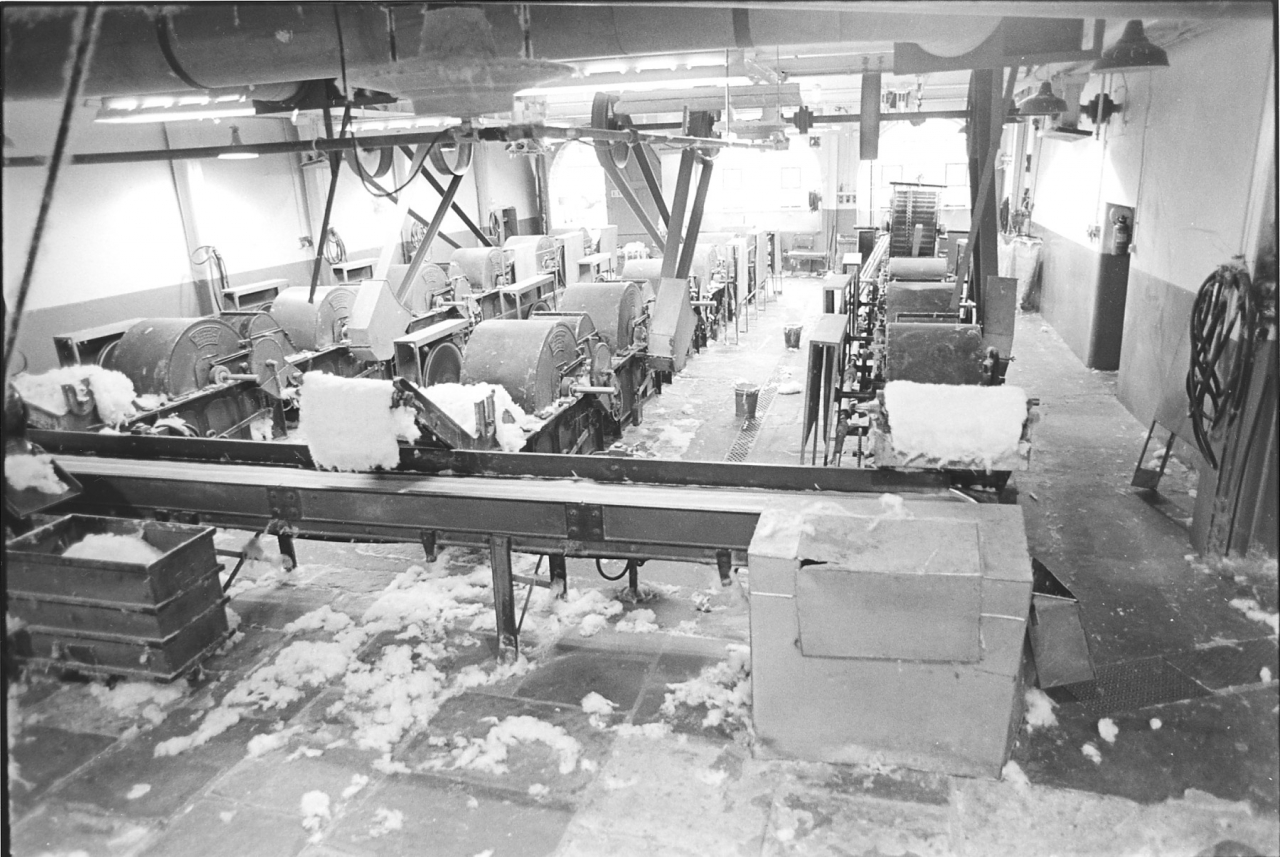
Well that’s, I think that’s quite a good photograph actually, that one of the whole of the devil room from the top end.
R – Yes it is. It's a photograph from the far end, off the steps going up to the blending room in fact. You can see where he was stood, half way up to .. Now that one's… Eh now then, that’s when they had some waste in between a roving and a thread and the single devil was broken down at the time, there was something wrong with it. So they took one of the cylinders out, in fact on this front row you can see that cylinder. They took one cylinder out moved it back and left a space where the cylinder goes. Like a half circled bath sort of thing where it should fit in and they run that cotton just through a single cylinder on there which broke a lot more than what the one cylinder on the single devil would because that’s only a five and tour tooth cylinder, while your devil had seven and six. Well it were enough to break it on that one, if you’d done any more it would have spoiled the cotton. So they just lifted that cylinder out and moved it back. Now then, if you were looking at the wood, the wood’s there to stop your spikes being damaged on the stone floor or against the other cylinder. Your spikes won’t break on wood, they just stick in it and holds it there. Now if you get it clattering against steel you’d be breaking your teeth. As I said, at the prices they are, you can’t afford to be bumping them round too much. That’s really just running the one cylinder and if you look down that side there’s a bag hung up on the right hand side. They’re bagging it up and then they’ll truck it upstairs and bale it in the normal way. (750) I don’t think there's much more there. Again if you notice, in nearly all them devil photographs taken from this end, you’ll see the big doors there are always wide open. In fact they’d be both wide open if you could open them, they get in the way of feeding your devils. Do you remember about three or four years ago it being a hot summer? Now I read in the paper once about one factory they said they’d said they’d come out because it were 80 degrees. I read that in the paper that it were 80. I were working in there with Jack Bolton in the devil hole and it were 133 degrees at this end, and 130 at that end, and they were coming out because it were 80F. Well I thought then the poor things ought to come and work here then. In fact we took the temperatures and that day we were working from half past six until half past seven.
Half past six in the morning till half past seven at night?
R- yes. Till half past seven at night. Well then we were working half past seven till half past eight at night, we weren’t starting an hour early. We took the temperatures at half past eight just before we went home ‘cause the devils were stopping and it were 133F at this end and 130F at the far end and that’s with the outside doors and the rubber doors wide open all day. You can see that big trunking at the back of the picture there, that’s an extractor for when you have a fire, it takes all the smoke out. We had that running all day as well so it were taking the hot air out yet it still got up to 130 odd at night at both ends of the devil hole. (35 min)(800) In fact the following morning before we even set on it were 120 at each end. That was before you even set the devils on, before it started warming it up, and the devils did warm things up! You’ll have noticed if you’ve been there were no steam pipes in the middle room and we used to turn it off upstairs because you didn’t need it when the devils were running. Friday perhaps you need it then if the devils weren’t running. Any other time you don't need any in that middle room, it’s warm enough. If you've got to go on the jumbo again you used to sweat while you were running on the jumbo. Like my mate Jimmy there, he got in the end he were only wearing a vest when he were at the front end. And it didn't show him in them photographs, he had his shirt on but he’d nothing on underneath it and when he first come he used to wear a vest and a shirt and a jumper. We soon got out of that habit. Now I don't think there is much more to talk about in there.
I was just going to ask you what this box was at the front of this conveyor belt. You know, that’s taking the …
R- Well, it’s not a box actually, it’s a guard. You see, on a Friday, it’s a pity he hadn’t taken one on a Friday because that’s pulled away and behind that there’s a lot of wheels that drive that lattice. And they had to be cleaned every Friday because if that clogs up, even though it’s only driving the lattice, it stops the job. Well, if there’s owt wrong you can lift that lid in the middle of it, if there is something wrong you can look in without actually pulling the whole lot away. But it’s a guard is that, it just covers the wheels otherwise you’d get cotton all over them, it wouldn’t take long for the cotton to clog the wheels up.
So that’s a guard you approve of?
R- Well, that was available before we ever got factory inspectors. They had guards on them.
When it was needed.
R- Well, when Tatham’s made something they put on what guards were needed to make it safe to run and easy to clean. As they were a firm that’s been making them for sixty or seventy years they knew how to make them and where the guards ought to go. And then you get some silly twit that’s come straight out of college thinks he knows better than them as have had sixty years experience making them. And each one has got better as the years have gone on. Are you trying to tell me a young bloke at 18 year old knows better than a bloke who's been doing it all his life? No way that I believe that.
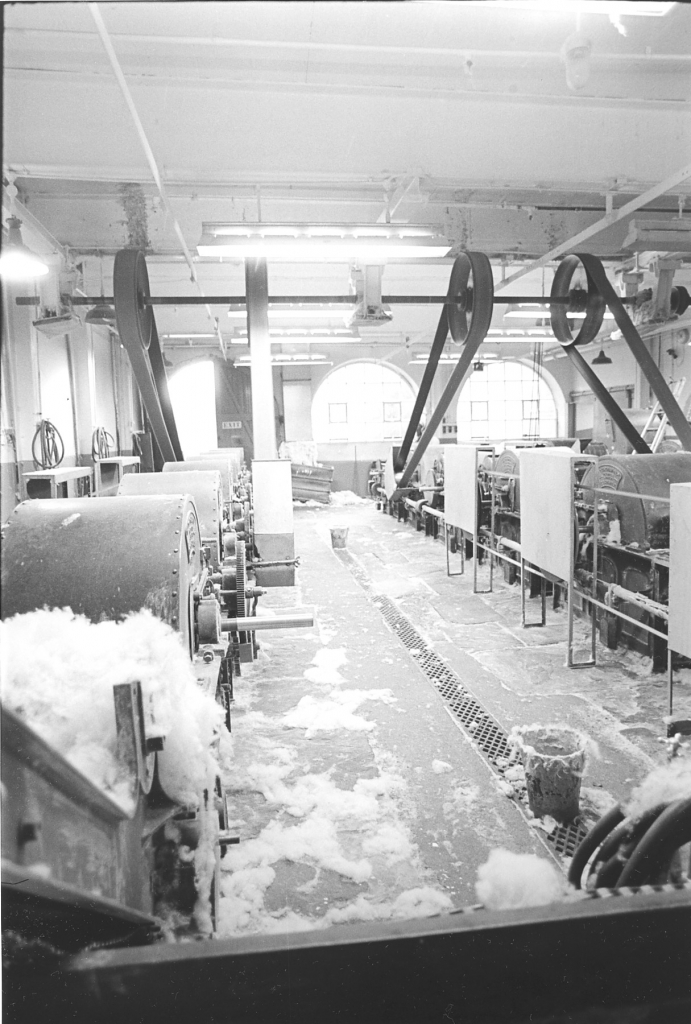
Now 12.06. He’s right up all the lattice on this. Now, on your left hand side there is what I said if it breaks off and runs back it starts clogging up that cage back there.
So we've got a fire looming up any minute, perhaps.
R- No it's not for that, it’s just that on that, if it feeds back it can scotch your cylinder back there. Now if your cylinder scotches at the back it’s a nice half hour job cleaning it out, to take it all in bits and clear it out and put it back again. Well if you catch it early enough you can just pull it away and there’s no bother to it at all. By then, I think he has actually stopped, I think he’s gone to brew (850)(40 min) up there, he were going to take that off when he come back before he set it on again. No, I know what it were now, that was Friday and he were running his machines bare. And if when it gets towards the end there is not enough weight going up the lattice it falls at the back there. Because I think I can see here that some of the cylinders is up, you know, the covers is up which means he is ready to turn them. Well they only turn on Friday so he’s running bare there. He’s getting ready to, like that row will not run on a Friday . If they’re turning, whichever ones they are turning won’t be set on in the morning, they’ll take the drive belt off. This big belt that you see here is the middle one, well there’s four of them in the picture in fact. They take that big drive belt up before they start because in the morning when you come in you’ll take that big drive belt off and lay it on the floor. It’s a piece belt with a steel bar in the piecing. You put that on the floor and then you set on because your others will run then and you can do all your mucking about while you are feeding the others. You can still get ready to turn while you’re feeding, it’s not so bad feeding two, you’ve got a couple of minutes on them each time you fill them up. It’s when you try to keep three going it’s bad stuff.
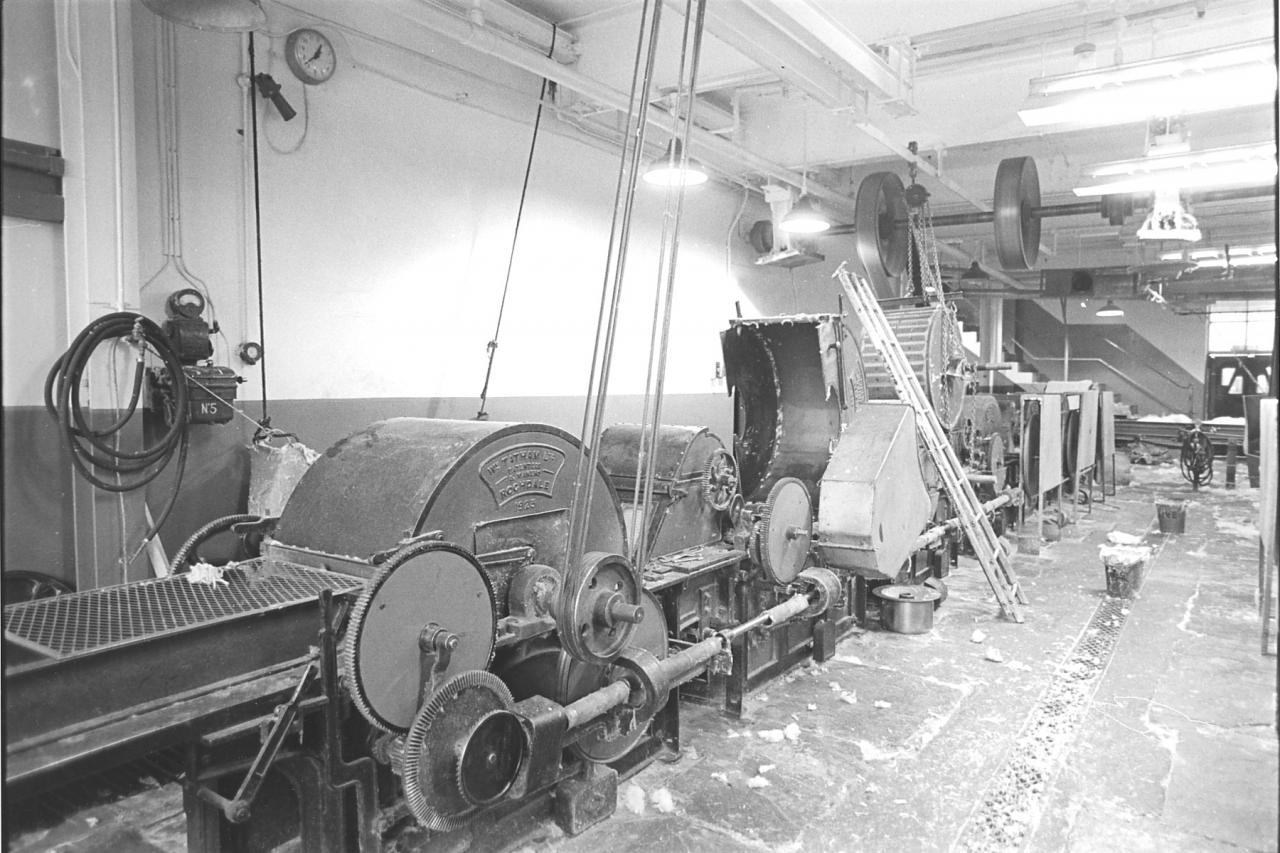
Now, what’s this one? 12.07. You can see on that one they’ve took it completely out that cylinder. In fact that were that time when I said I had one that got spoiled, and I said they were replacing it. Well they’ve turned that one and left it at the back there. If you look close at this one, this were ready just before they put it back again, but you’ll see some belts going, running up from this first cylinder, running up towards the ceiling. Now that’s running off the motor I were telling you about, just driving that one and the rest was stopped because they wanted that stuff at the time, they wanted it going even when you were cleaning your devils. In fact they didn’t stop that till later that day. But you could clean the rest without, just leave that one, that’s why they’re driving it from that top motor, so they could stop the others. In fact that’s what the ladder is for I think, ready to take them belts off there. I think they’d finished with that then and they were taking the belts off, take this belt wheel off, it isn’t normally on when it’s running, it’s like a small wheel that runs on a… You can just about see the wheel behind it, it runs on the top of that wheel, there’s like a leather under the wheel and it runs on the top of that wheel. The ladder’s there ready to take them up, I can’t reach them up at all without a ladder. I don’t think there’s much else in that one. Like you can see where the big shaft wheels are, they are on the right hand side about an inch down that picture there you can see like two trays hung up underneath the shaft. Well, when your shaft is greased the trays are there to catch any grease that might fall off. Cause it’s no joke if you happen to be running down to a fire and slip and fall, you’re going to stick your hands in, across them belts while they are running.
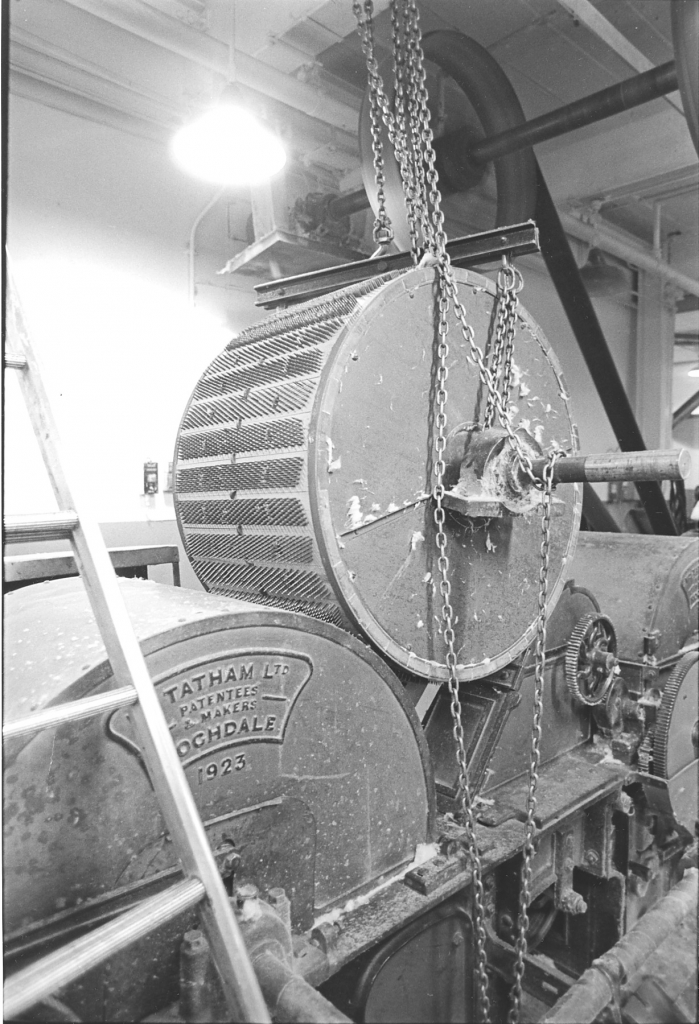
Now, 12.08. Now that’s a close up of, well, you’ve picked your cylinder out of its compound, out of its running place and it’s put behind another cylinder, you can just about see the wood that it’s resting on.
Yes.
R- There is nothing much you can say about this one. And again you can see the ‘1923’ on that cylinder, each one has a date but one or two are a year or two older.
What cylinder had been taken out there to…?
R- Yes out of the front to run just that one cylinder on that other cotton.
Yes, and these are the spikes on that wooden lag?
R- Yes well, some are on wood, some are on metal. Normally, most of the time they were on metal. Originally they were on metal but the last ones we got were on wood, again, to make it a bit cheaper. But the metal ones weren’t actually all metal, they were wood with a metal covering.
Yes.
R- Now originally, and I think that they only really had that on if you had a big fire it didn't burn your lag as well. And like, the brackets that actually hold your cylinder up you know it's a special bar with a double set of hooks, a double chain hook on it. It’s made specially for taking the devil cylinders out , in fact, this number 12.09 you can see it a lot plainer, it’s straight across. Well there is a hook on each side so there’s no chance of your chain slipping off as you’re lifting it up.
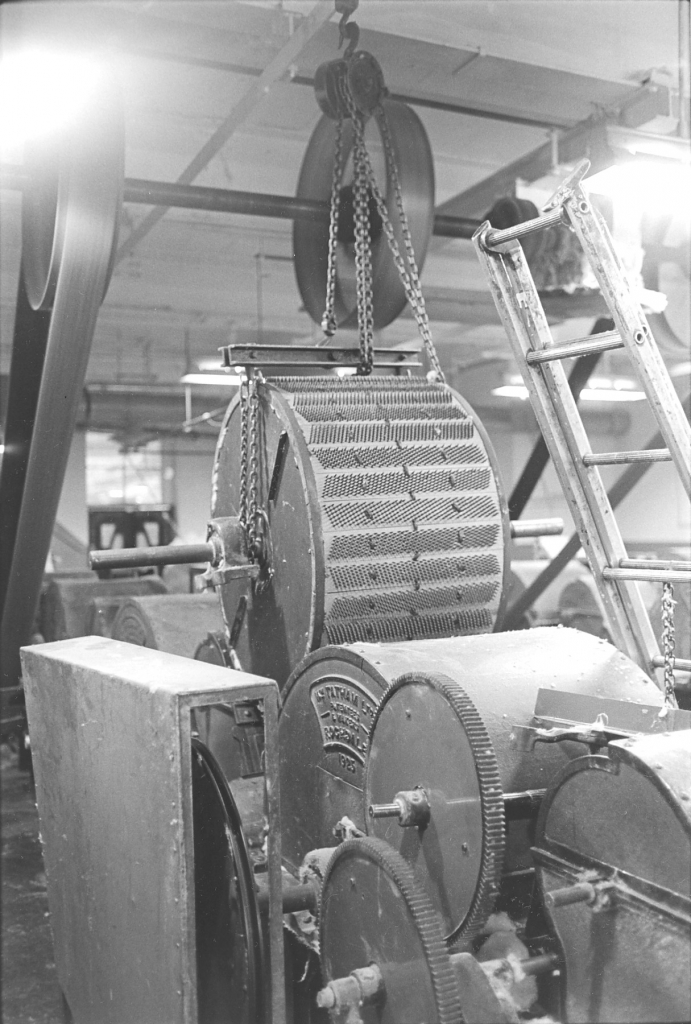
I wonder what each of these cylinders weighs?
R- Eh, I’ve forgotten now, we once weighed one and all. I think they were about six hundred and odd pounds. I think they were nearly seven hundred pounds. Like they are not solid inside, it’s empty inside. In fact these panels on the side you can unscrew them , you get cotton inside after a while and if you don’t clean them out it loses its balance and doesn’t run properly so you’ve to clean them out every so often to keep that balance. What have they put on the top there? Oh, I know what it is, that’s the cover for the gear wheels on the left hand side and they’ve put it on the top. They shouldn’t have put it there. Anyway, that’s going off the point.
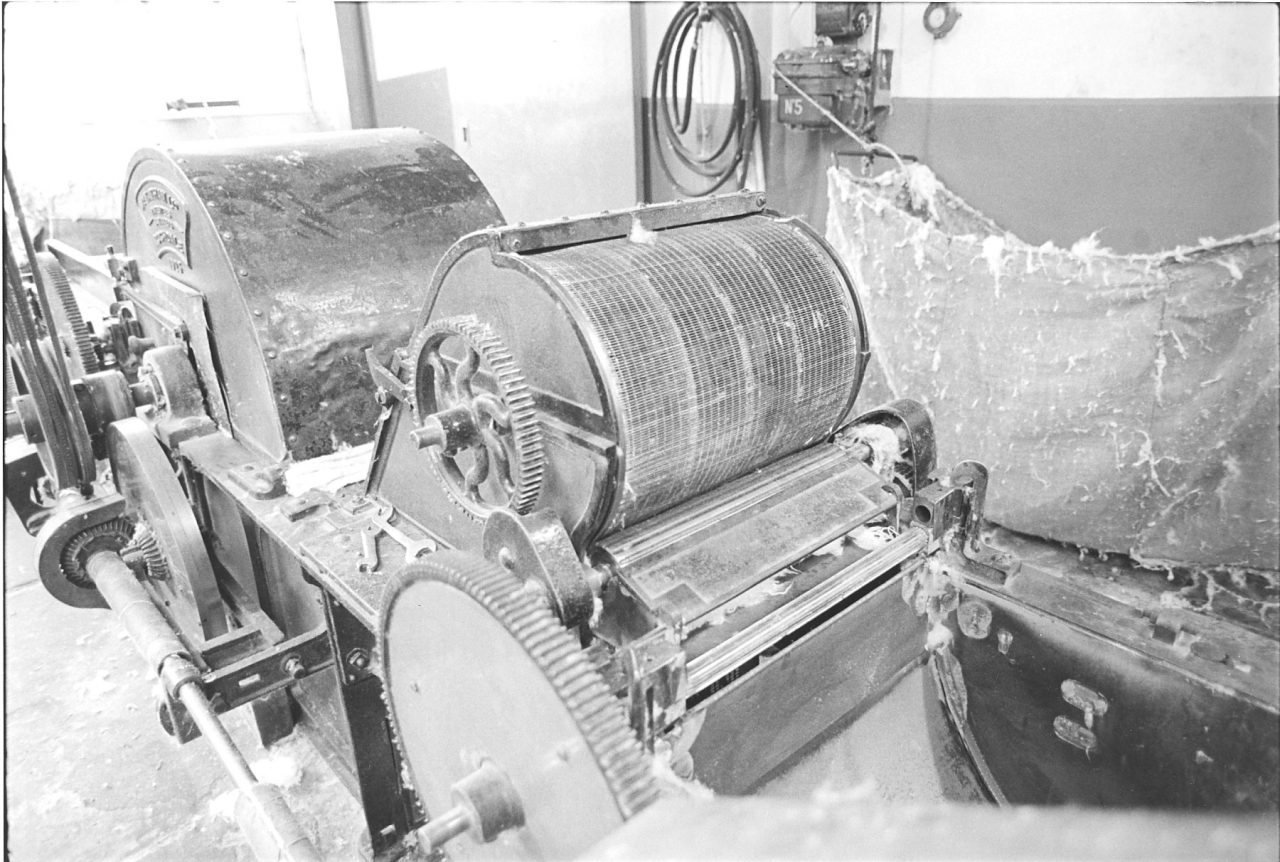
Number 12.10. Now that’s a picture of where that cylinder has come out of. In fact you can see from there, just where the cotton comes through the bottom of the cage here. Like you won’t see there because again, it’s stopped ready for cleaning and putting back again.
And then it would be manually lifted from that onto the sacking?

R- Yes, out of this and into the bag there. In fact this picture 12.11 shows it coming through, you’re getting ready to take it out in fact. It comes through like that and you take it out and put it into the bag.
Right.
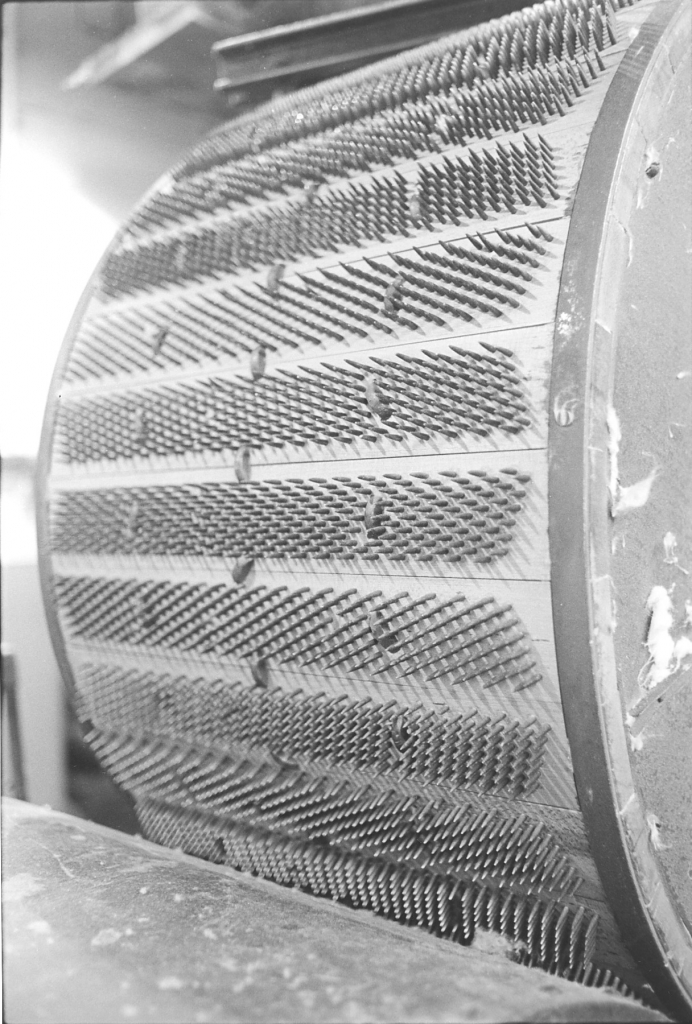
R- That’s 12.12 and that’s a close up of the cylinder. Now that is a wooden one. And I can see it’s a seven and six and this other one is a six and six I think.
(1000)
Yes, I am with you.
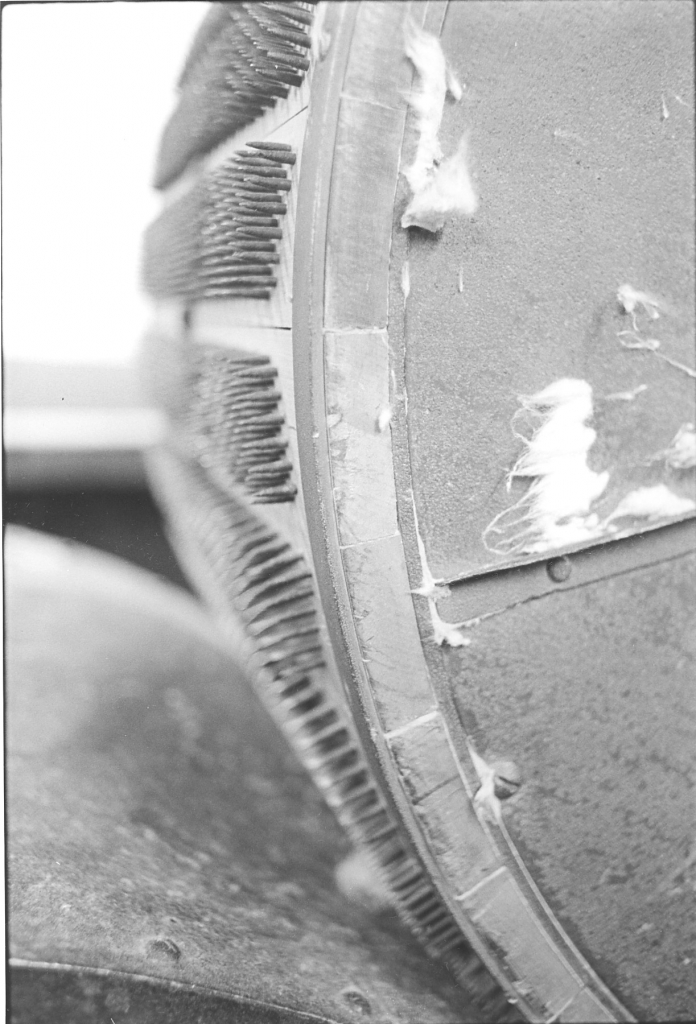
R- Now 12.13 is near enough a side view of the same thing. And there you can see the screws that fasten your side panels in.
Yes. How often would they have to be changed, one of those lags? How long would they last?
R- Well, they’ll last quite a long while. Apart from having to put new cylinders in I think they've only put, what? About 24 or 25 in the 15 years I were there.
About nine months a throw.
R- Well, more than that because you got how many? There's about 30 lags on each cylinder, six cylinders in each row and three rows so what have you? Round about 600 lags and you’ve only replaced 25 in fifteen years.
SCG/03 July 2003
6,736 words.
LANCASHIRE TEXTILE PROJECT
TAPE 80/SHJ/05
THIS TAPE HAS BEEN RECORDED ON MAY 26TH 1980 AT 119 BURY ROAD, HASLINGDEN. THE INFORMANT IS ROLAND TAYLOR, JUMBO OPERATOR AT SPRING VALE MILL. THE INTERVIEWER IS MARY HUNTER.
I think last time I was here Roland we were still talking about the way the rollers ...
R- Cylinders.
Cylinders. I beg your pardon, cylinders were made up in the devil, on the devils. So 12.14 perhaps if we start tonight.

R - Now that is a main drive motor for the devils. As you can probably see, they don’t make them like that any more, probably lucky too now they’re shutting. Let’s see now, eh, the box you can see on your left hand-side of the picture, that's the starter switch. We can't actually see, oh yes you can, there’s like a knob on top of the box and next to that there's like a lever. Well that's the one you lift up, and on your right hand-side of the big motor you can see like a red flag on there. Well that has two positions, where it is now is when it's ready to start it. On the front facing the other starting box. And the round box on the left hand side on the floor, can you see a bit of a knob on the top of that? You press that down and there is a handle at the (50) side that you wind. And there is a clock which you can’t see on this photograph, right in the top corner which shows your amps as you're starting it up. Now it you wind it up too fast it’ll knock off and you’ll have to start all over again. You can only, start it up at with your amps at a certain level, if you go too high you are going too fast for your motor to start up proper and it will knock off. So you've got to do it at a certain speed, it’s not a matter of turning a switch and it’s running, it's got to be wound out. That’s why it takes so long to stop as well. And once you’ve got it up to your speed there’s like a little switch on this small, round box.
In the middle?
R- And there’s a hook on, you know, the one on the floor here. There’s a hook on this part on the top and when it winds on the hook moves round until it clicks on that catch and holds it in that position for running. It won’t start on run because it takes too much power to start, you’ve to wind it up to that power. Not much more you can say about that.
And that’s merely to start?
R- That's merely just to start the motor before you can even set your devils on. And just to knock it off even and easy you’ve got switches outside but if you happen to be in here you just knock the button down on the square box on the left.
What sort of power are we talking about?
[The Cotton Year Book gives a figure of 8hp per cylinder. I have it in the back of my mind that the motor which drove the devils was 150hp and this matches the Year Book figure, 18 cylinders at 8hp is 128hp. It’s almost certain that the motor would be over-sized so 150hp will be about right. The running load would be about 200 amperes.]
R- I’m not sure now exactly but, well you can go off the thing they say now it'll cost £15 to start it. Well that takes a bit of power if it takes you £15 worth of money to start that motor up, that's why they don’t (100) want to knock it off once you’ve set it on. But sometime you .. if you, if you've been on holiday, like you've had your July break and you come back, some of your ropes, like I've described the ropes earlier on, they get slack with them not running, or if you’ve a change of weather and all. Well if it’s set on .. again if you try and start really too fast, like you can go, start off at, the fastest speed if you know how to do it and by watching that clock you can get it off to a fine art how quick you can get it going. Like .. with such as me and the other lads, we've, we got paid, see there were a clock there that said how many hours them devils were running, it doesn't say when the machines are actually turning cotton out, just how long they are running. So the sooner you started, your time started from then and you don't want to be hanging about waiting five minutes starting the devils up. But if you were too fast, and after a holiday, you might fling your ropes off your, off your devils. And you have to stop then and wait for your devils stopping and then put ‘em back and they're not the easiest things to put back on when they’ve been flung off. Also if you happen to be in the way they can give you a nasty wallop, because they are fairly shifting when they throw ‘em across the devil hole. And that's really all that's about, in fact the last six months that clock hasn't worked so we haven't bothered with it, there is no need to bother about what time you started it up. But it's really for the office staff to know how much production you've got for how many hours it's run rather than for anybody else's convenience and also it told you how many units of electric it's used in a week (150) and there is a clock for that as well. And that can fairly knock on in a week. I know it's doing four and five hundred units a week which is a hell of a lot of money if you've got to pay for it. Like can you imagine in your house you’re only doing, what do they say? About 50 units in a quarter of that big units.
Is that right?
R - You can imagine what 500 a week's going through.
And this is all…
R – For the amount of power that it takes to start you can keep they say a house and all its lighting, its cooking and its central heating just for starting that. It'd last a fortnight for any house, just to start it up. As I say they don't make motors like that any more. Once it broke you’d have to go on single motors on each devil.
And this is in the little room off the side of the devils isn’t it.
R- Yes, on the left hand side. Yes that's the room off on the left hand-side of the devil hole. There’s nothing more I can say about that.
Right, well number 0039 then.
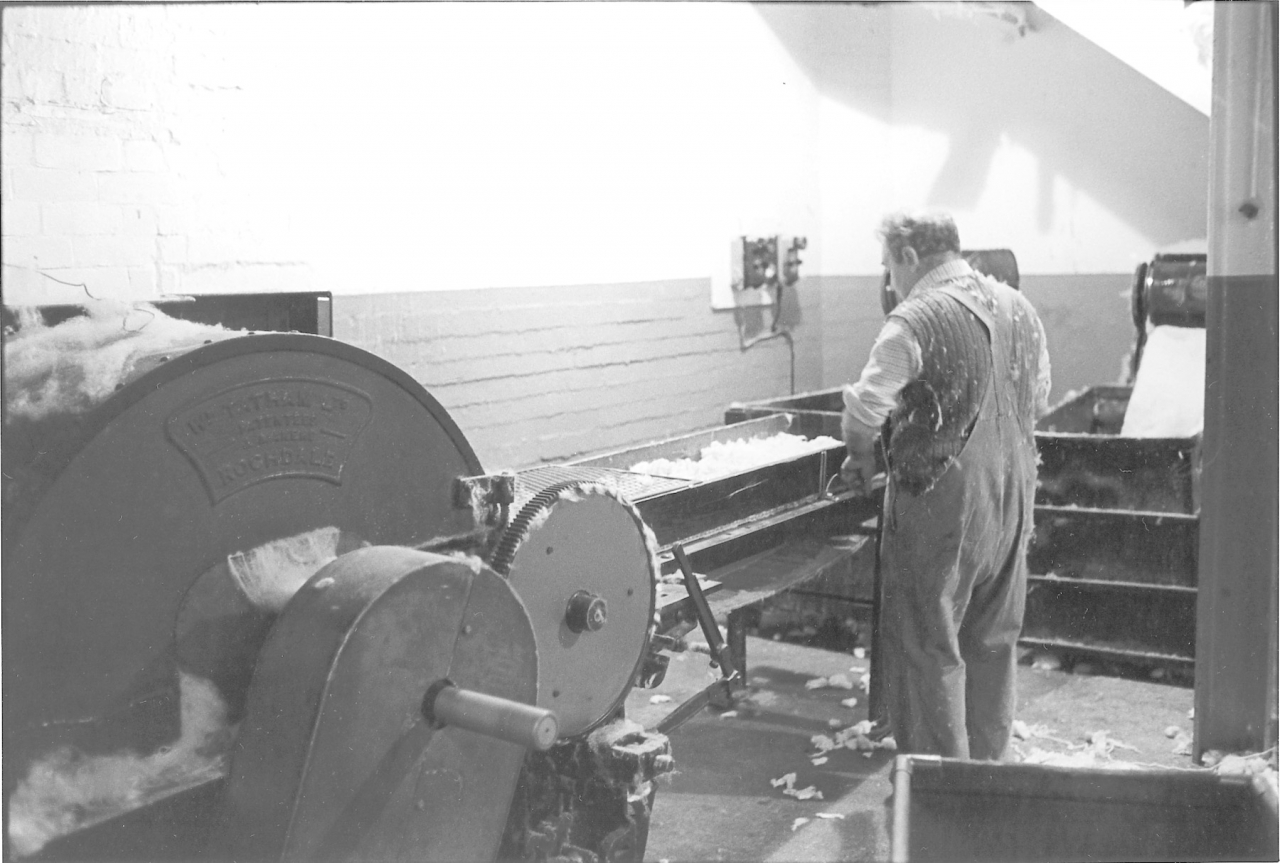
[1401] The single cylinder devil.
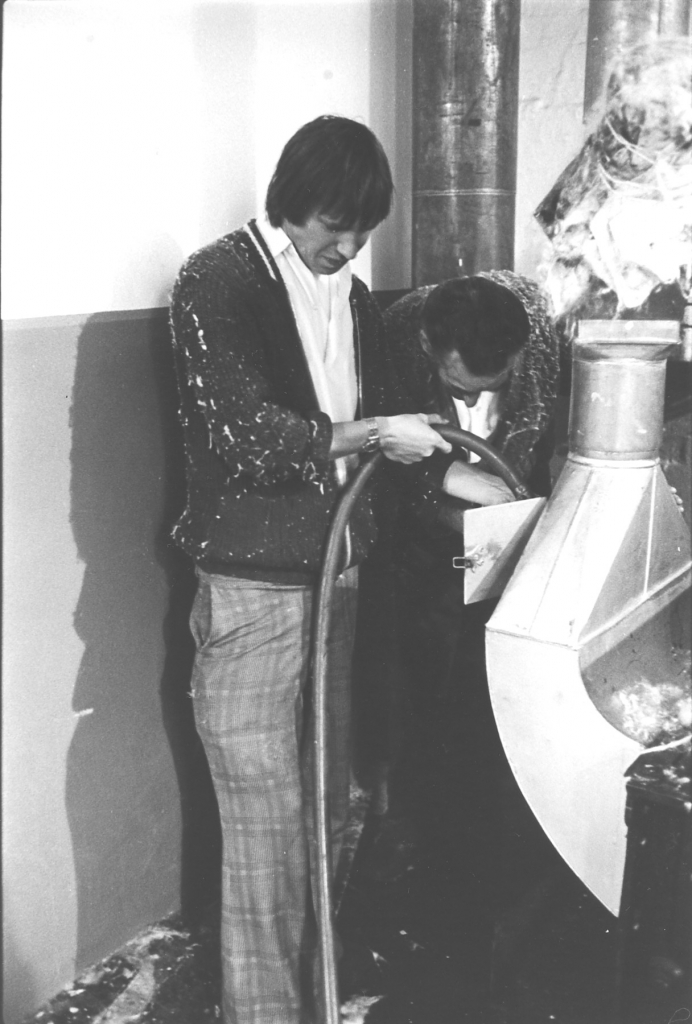
[0039]
R- Well that’s a small single devil at the far end of the devil hole. And you've got a fire there, you can see they’ve opened the door at the back of the single devil to put the water in. So it runs on the cylinder which is where your fire is. They are doing it wrong and all, they haven't switched it over, that do you see?
What do you mean, they haven’t switched it over?
R - Well there’s like a connection, you can’t see it on here, they have another trunking that runs off about half way and it goes across the room into another (200) well, we call them a side end machine. I’ll show you later on.
Oh yes, I know which you mean.
R- But it runs all to one that isn’t in use. If you pull .. like there is a lever here and it cuts that off and opens the other trunking up so it stops if there is a fire coming through there, it stops it coming into where you’ve got all your cotton. It’ll go into the one that’s not being used therefore you are not going to have a fire in some that you are using. There is nothing else you can really say about that.
How often did fires take place?
R- It all depends on the stuff you are using. If it's good stuff it’s very rare to have a fire. Well, if you get a fine cotton that’s always liable to fire, cause it’s a lower flash point. And a single devil like that isn’t normally a danger unless your pushing it to try to get finished. If you’ve got a certain amount to do, get that done and you have enough. If you start pushing it you are liable to overfeed it, you’re getting too much going through and it builds up the heat that way. And it only needs a bit of a, what shall we say, a rolled ball of cotton and that will fire it. It was the same what, last few weeks before they finished we were doing one or two bales that are really rough bales, they’re like rolled balls of cotton and it doesn’t really open, you can’t pull them out before it goes through, you’ve got to [let them go] You’ve got to put a right thin feed on and we are not used to putting thin feeds on. Most times it’ll go through but occasionally it’ll build up and then fires. You are away then. And the worst thing about these single devils is you don’t actually smell it till it’s afire. Like your big devils you can normally smell it before it fires and you can control it that way. You can get to where the smell is and put it out before it actually fires. But this one, you actually get your fire almost at the same time that you smell it. Now, number 0040….
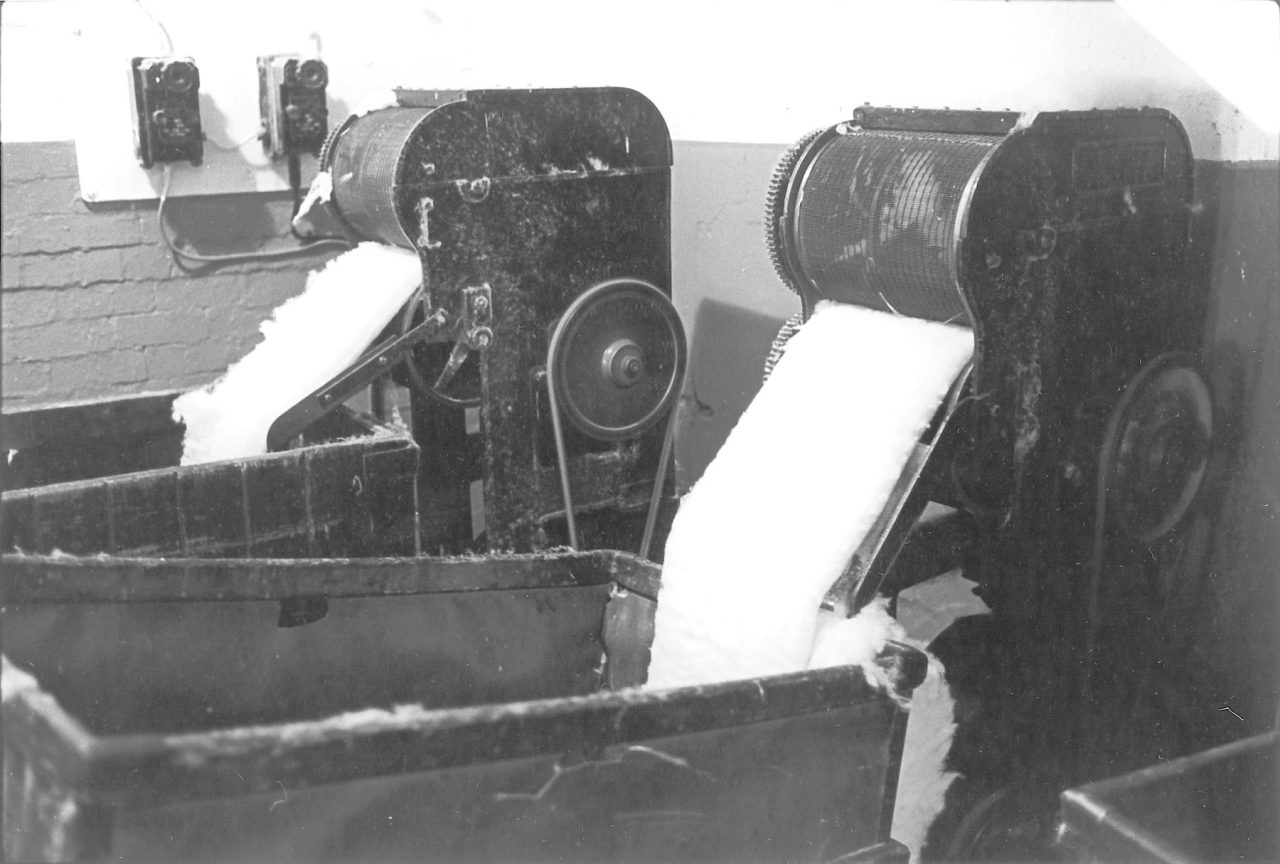
[0040] (250)(10 min)
Hang on, before you go on. What was the management’s attitude to the number of fires that happened?
R- Well, we’d cut down on fires a lot in this last two years. We used to be averaging three or four fires a day. Well the last two years they got, well if we had three or four fires a week that were on the top side. In fact we went once for six months without a fire at all.
Really?
R- And what it is, they know it happens, you can’t really avoid fire , just sometimes you get more than others. A lot depends on your jumbo, if I’m rushing it on there when it gets down here there’s a tendency for it to fire. But if I’m like in a bad mood I’d run it through me jumbo and if him in the devil hole were in the same mood and he’d give us like… When it got into the devil hole, by rights, if there were any lumps in it you should throw them out. But you got, especially since they put them guards on, where it’s made it harder work, it got so ‘Whose bothered about them lumps’ and away they went. Well most of the time they went through but occasionally, in fact when you put the lumps in you were watching that devil because you had an idea that’s where your fire could be. So you caught them before they fired, you knew where they were going to come if they were going to fire with what you’d put on. So your usually waiting for it, you got a smell, you stopped, clean it out and set it on again and you were away, it didn’t fire. Now if they counted them they’d say there had been hundreds of fires rather than none. But with catching them like that you were only losing a minute or two, well they weren’t bothered about that. If you have an actual fire you can lose what? Depending on how big your fire was you can be stopped for an hour or two while you are cleaning up after it. Now if you get water all over you’ve to dry it out as well. (300)
But presumably the management accept that if you’ve got devils in a firm then you’re going to have fires. Yes?
R – You’ve got fire risk That's why the insurance men were always here. The devils are a fire risk at any time.
Do you think it’s a certain sort of bloke that works in a devil room or do you just become so used to them that they don’t represent a hazard to you at all?
R- I suppose you can. We got used to having fires, you didn't bother. People would say “You’ve got a fire there!” and this lot would say “What are you worried about? You are used to them!” Like I say, I’ve been there fifteen years and we’ve only had the fire brigade twice and yet we’ve had a hell of a lot of fires and some of them a fair size. Like I said, when the firemen came that time with us they said we did well keeping it there, even they wouldn’t have kept it under control like we did. It’s being used to handling fires, like a lot of people are frightened of fire. If you are frightened of fire you’d be no use in here. Like one of the blokes in that photograph, well Ill tell you when we get to the photograph. When he first went in there we used to laugh at him if you got a fire. He’d be going round in a circle, literally going round in a circle not knowing what to do first. It were laughable to watch him, he’d literally go round in a circle wondering what to do first. But he got in the end he were running only you see he knew what to do straight away, he did the job. But when he first went in it were laughable, we used to say to him “Are you doing a dance?” Only he were just going round, he’d never move, walking round, not moving off the spot. In fact we had a big fire once through us all laughing at him instead of going to the fire.
It's not funny really though is it?
R- In fact we even laughed afterwards. I think it cost us two hours did that because it shot across one set to the devil, to the row of devils that were going and we were still laughing when we were putting the fire out.
Now then Roland, I don’t know. Yes, all right I’ll let you go on to number 0040 now. (350)(15 min)

R- Well them are the side ends, not the ones off the single devil, they are the ones that come from the card room, they are off them cards of Glenys’s the first lot of finisher cards. They take the waste cotton away from there and they come into you mainly because it can be mixed in with our devil cotton because it’s not bad stuff, it hasn’t really been broken up that much and it can go in with the devil cotton.
Now those are the two side ends of the finisher cards. Is it sucked off?
R- Yes.
And then they travel on the right hand, on that underground trunking? To there? And then they go through one cylinder like the devils but one cylinder just to be mashed up again. Is that right?
R- No.
I mean I know mashed up isn’t the word I should use.
R- No, like them aren’t touched at all once they come through them pipes, they go , they just come through those cages to be…
Made into a lap?
R- No. Yes, just pushed together so it doesn’t come through like a lure like it is on that picture there.
Like a what?
R- A lure.
L U R?
R- Instead of being what should I say? Blown out in fluff which it could be without them cages.
Now I would call that a lap but obviously you are not calling it a lap.
R- No, a lap in carding is when you've got a roll off it.
Right.
R- And then what you call laps, now you could make a lap out of it if you rolled it up into a roll.
But it's just being fed into that right?
R- But it’s just being dropped into the box and then going to the chute ready for going up into the devil box.
And then it’s going to he blended with all the other?
R- Yes, they’ll be mixed in with the devils. As long as it’s not for sale. If it’s sale then it won’t go in. It’s only used for our own stuff.
Right. And I gather you are not committing yourself to the spelling of the word ‘lure’? No? Right.
R- No, I never were the greatest speller in the world.
Well, it’s probably a word that you’ve all dreamt up at some time and probably nobody knows how to spell it properly so don't worry about it. And those are in the devil room aren't they?
R- Yes they are at the back of the single devil underneath the steps.
And it’s just two of those?
R- yes there are just two of them. The switches for them are on the wall on the left hand side there. They just run off two small motors that actually run them. Surprising, you wouldn’t think, but the suction for them is a big motor in the card room. These motors are just to turn the cages there so that it runs out into the boxes. And the actual fan is in the card room, the fan that draws them and then pushes it into single devil
Oh I see. That’s presumably a spike through…
R- No, that’s just a grill, a cage.
The what?
R- Grilled cages.
Right.
R- They’re just like a mesh on them and the cotton comes down, pushes into them. The cage pushes the cotton together into what you think is a lap, for it’s all fluffed up when it actually comes in there but it’s no good having it blowing all over the place. One thing it’d be damned hard work sweeping it all up.
Right.
R- So it pushes it together in say like a solid mass.
Right. OK. That’s fine. Now 14.01.

R- Well that is a single devil where, in fact you can see the two side ends behind it that we were just talking about. And that’s like a, well as the name says, it’s a small version of your devils. Your devils have six cylinders but this only has one. The stuff that goes through it doesn’t need the breaking that your big machines would give it. It’d spoil it if you put it through the big devils but it isn’t good enough to go straight into your mixing, it wants opening a little bit. So your single devil’s used for opening it just a small amount. Not so much that you can describe, it’s almost exactly the same as what you get on the big devil, they’re on the same principle as your big devils. Your feed lattice is the same apart from, like you saw in the picture of the back of this one, instead of it going up the lattice at the back of the devils this one goes through a trunking because it hasn’t normally, if we are on our own stuff and we are making sale. The main devils could be running sale, making sale cotton. Well that from our single devil never went into the sale cotton, we always used it ourselves because it wasn’t good enough really for sale. Well, I wouldn’t think so with some of the stuff we used to get but they considered that not good enough for sale stuff, they wanted the best stuff in the sale. So that used to be going to the box and then being bagged up. When you had got enough, like I mean either four or five bags depending how big the bags were, when you got enough you took it upstairs and made a bale like you would do your devil cotton. (450)(20 min)
And then it was used in the blending process?
R- Yes, that were used in the blending. Yes.
And what sort of stuff was normally fed through those?
R - Well what we call rovings.
Yes, I know what you mean I think.
R- But would somebody else who’ll listen in a hundred years, will they? Eh, I can’t think what rovings off.
No they won't, good point, telling me my job now aren’t you Roland! You are getting so good at it eh? What about things like the piked cotton of the bobbins from…
R- nearest I can tell you what it is, when you’ve seen your finishing cards that Glenys were on, you see the waste she had on the floor when she piked her bobbins off, well that can be classed as rovings because it hasn’t been spun yet so it’s still soft. Now your thread waste, your hard stuff, is like when it’s been spun and is highly, it’s been twisted and it wants more breaking up does that. Now your rovings are before it has been spun and it’s still soft. And you know it’s, what shall we say, it’s like cotton wool but it’s in a thread. That’s about as near as I can say what it is. It’s soft in other words.
Did you put on to that single devil things like the, the piked bobbin waste?
R- Yes, we used to run our own waste off our finisher cards on it.
Yes. So invariably it would he fed with cotton that has partly gone through the process at Spring Vale.
R- Yes. Well all of it and even the rovings we bought that had been partly processed in other mills besides ours.
Yes, right.
R- But it’s all soft waste where your main material were hard waste.
Yes. (500)
R- Which needed a lot more opening up. With your soft waste all you really wanted was like fluffing up.
That’s right, which is why it only has one cylinder. Very good.
R- Tea break.
Picture number 14.02.
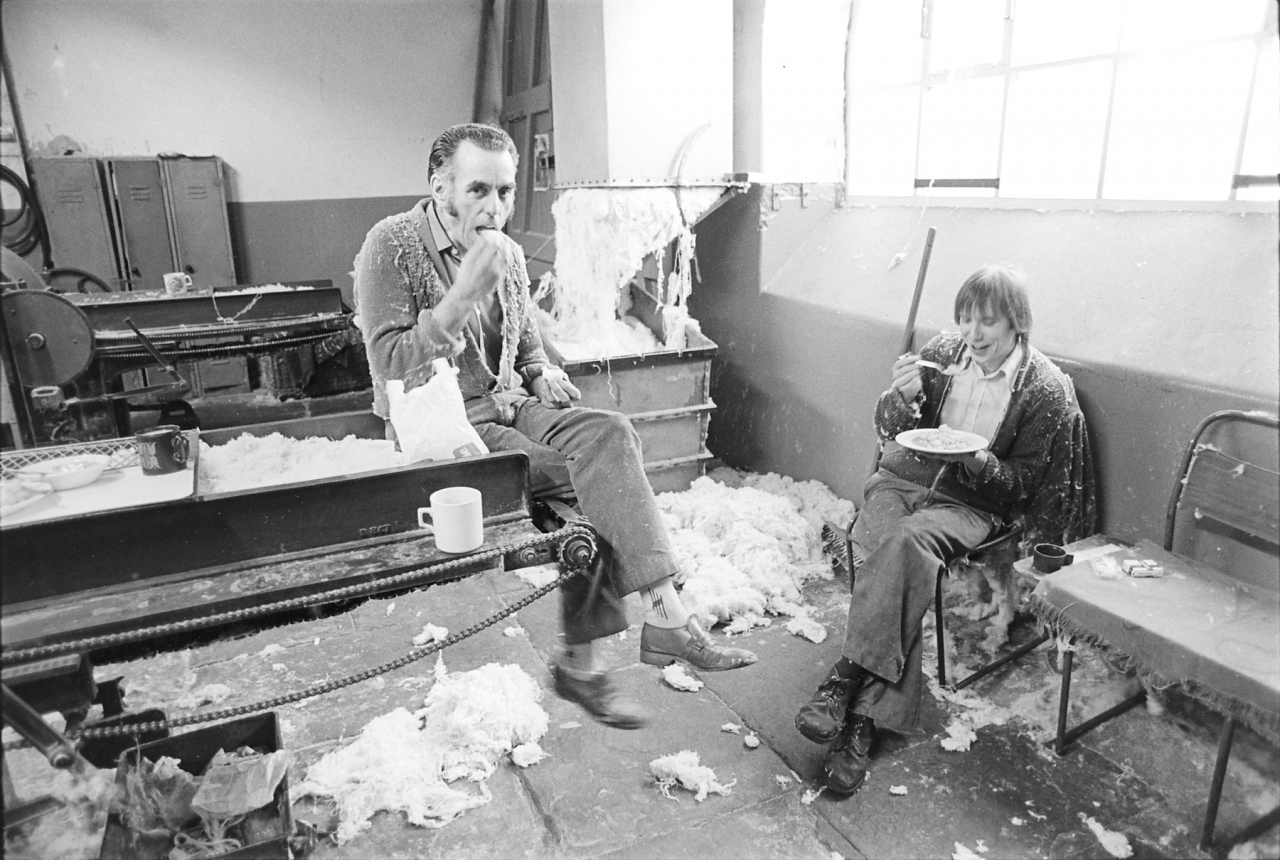
R- It makes it awkward.
Yes, I know.
R- Well that one's, in fact it's dinner time. I bet you kind of want to know how I can tell it’s dinner time and not lunch time.
Well, I was just going to ask you actually to say what you call all the mealtimes because I think that’s interesting actually.
R- Well I know because I know what they have for their dinner but the main thing is if it were tea break them devils wouldn’t be stopped, they’d be having their brew while they were running. Now to see them actually sat down means it’s dinner time, they are not running. Like even when they were running dinner times the they used to stop for about quarter of an hour for their dinner. In fact you can see, if he’s a plate there it means it’s dinner time ‘cause usually if he had his lunch break, if he had owt it were only toast and he didn’t need a plate for that. But while it were lunch break the devils didn’t stop so you wouldn’t see him sat on it, it’d be taking him through and all. But dinner time they used to, if they were running dinner time they only used to stop for a quarter of an hour while they had their dinners and it’s time they swept up too. If Johnny were there we’d have got cursed for that.
Sorry?
R- Johnny were the mill manager and you got cursed for having it all over the floor while you were eating.
Yes well, true. Now am I right in remembering that lunch time was the break you had at ten o’clockish, half past nine or whenever it was.
R- Eight o’clock.
Oh I beg your pardon, eight o’clock in the morning.
R- Don’t mention that one, it’s not an official one.
Oh so eight o’clock , where you…
R - Between, eight and half past.
Where you’d have a sort of cross between a lunch and a breakfast. (25 min)
R - A breakfast, that’s what it’d be, really most people if they didn’t have breakfast when they came to work would have it then.
A breakfast. Because you started at half past seven didn’t you?
R - We used to start at half six, that’s why we were ready for ours at eight o’clock.
And than at dinner time which was twelve o’clock you had a normal meal. Yes?
R- Yes. And you were also, most of the devils used to run all dinner time apart from, as I said, a quarter of an hour that they used to…well, in fact most of the time they didn’t have the quarter of an hour, but normally ten minutes, quarter of an hour they had for their dinner and then the devils’d be set on again. They took it in turns, like somebody’d come on at half past twelve to run the other, the second half.
But they were on piece time weren’t they?
R- What do you mean by piece time?
Well, like the spinners.
R- No, they weren’t on piece work, we’d break them if they put us on piece work. No. just ordinary day work we were on. And you know I was telling you about the bloke who used to do the dance? Well that’s the bloke sat on the lattice now, he always used to be doing a dance when he’d first come in.
Did he?
R- But with working there he got used to it and got into the habit, but when he first went in he always used to go round in a circle.
Good for Billy.
R- I don’t think there is much else you can say about that.
How long officially did you have for each break? officially.
R - Officially ten minutes.
Even at dinner time? I mean?
R- At dinner time you, officially it were 55 minutes because you went at twenty five past four(?) not at half past. That's where your five minutes went from otherwise you'd had an hour, officially that were. Got a bit lax when they started shutting, more so. In fact nobody were particularly bothered what they thought then. ‘Cause you can’t, you see it were ‘You can’t sack us now.’
What about lunch time?
R – Well. It should have been ten minutes.
Is that all?
R – Yes. That’s all it should have been. In fact they put it up enough times on the notice board but even, last couple of years we didn’t take much notice of ‘em because workers were getting scarce. You weren't getting the workers coming into cotton so you got near enough to finger thing to the management, you can't got anybody to replace us so shut up your remarks. [‘V’ sign?]
Yes I gathered from Mary in the canteen that your lunch time was usually an hour, and five minutes would be put in, nipped in at the end.
R – No. It weren't actually that. I used to get me chips and go into, I used to go down to the Social Club then for a game of snooker at dinner time and when I came back it were time for, we only used to have one game of snooker, and when I'd come back it used to be five to one when we should have been starting, well I went in for me sweet then. And there used to be one or two .. what should 1 say? I should say jealous people more than owt else who used to moan. It's like Roy, he says to her “Take no notice” and there was more than one got on to Roy about the time I spent in the canteen.
Really?
R - And they’ve gone, in fact they’ve gone on to David Hardman and all. (600) But it’s like David says, “I’ve worked with you, I know how long you spent in the canteen because you used to do it while I was here. Like I spent half an hour in the canteen even when he were going through the mill with me, and he were one of the directors. He said “But what they don’t see , and I worked with you, while you had me with you, before we went in that canteen the sweat rolled off me. I’ve never sweat like that since I finished with you. When you’ve had that half hour you’ve done more than they’ll probably do all day before you had that break.” And Roy said that he listened and then let it go in [one ear and out the other] and then ta-ta and took no notice of it. It was like Roy was saying, a couple of months before he finished, he says “I know you work better than most of them, but have your ten minutes like them and then go somewhere else and have the rest of your time where they can’t see you. If they can’t see you they don’t know how long you’re having.”
That’s right.
R- He says “What they are not thinking about is how many times they go out for a smoke and you don’t smoke.” And a lot of them they’d, most of the morning they’d be out for a smoke every half an hour. Well, it were five or ten minutes every half an hour. Anyway, we are going off the subject I think.
It's all right, we keep doing that. Picture number 0041.

R – Aye. I wonder where he took the rest of them and all, he took more than that. [Roland is quite right and it’s worth pointing out that there are many more pictures in the Spinning Archive than the ones that are in the folio used for the interviews] But that’s the finished product on the press. It doesn't even show the part where it actually goes in like. It’s made up really of two boxes like that one, the other one’s on the right hand-side behind the door, you can’t see. Well that side’s where your cotton comes from upstairs into your press. And there’s a clock again on the right hand-side (30 min)(650) which again he took photographs of. I don’t know what happened to the photographs but there’s a clock there, you set it for how many trans, we call them trans, and he puts so much in and he presses it down. Like with our own heavier comber stuff you only put about eight or nine trans in. Well you've got your sale stuff, that’s all soft so you put 18 or 24 in, that again depends on, like 18 if it were our own which had soap on because that all added to the weight, or 24 if you’re making for sale when it had no soap on and you could press it down more. Now these ones, after you’d got your amount of cotton in your, sounds like a, what shall I say, well it swings round like it is on hinges , the whole lot swings round and you get this one swinging round into the other side ready to fill up again, and your bale, like this one, comes to this side where you put your wires through. Well you can see the gaps there, at the top there where you can put your wires through and the same at the bottom. There’s gaps made in your press where you can put your wires through. And then you put the truck at the side there where the, Roy’s stood there, trust Roy to be stood there doing nothing. And after you’ve finished wiring it up, there’s a button on your left hand side here, you can just about see, about what, about half an inch off the top of the picture. There is three buttons there, there is a stop button, there is an up button and there is a down button. You want your down for pressing it when it gets into this side while you wire it up. And your up button is ready to release it so you can push it on to your truck. And like the lever on the frame, on the left hand side of the picture, that’s for when you’ve spun your bales round, that holds it in place. If that wasn’t in it’d just start turning, you’d have stopped because there are contacts on the press and if your contacts aren’t touching it’ll stop your press, it wouldn’t work. It’s got to be in there for your, either side, to feed in. If you don’t put your … in again you can’t really wire it up if it’s moving around anyway. There’s nothing else, the tares on the left are what you put over the top of the cotton, and when you’ve taken your bale out you put one on your bottom ready for your cotton falling on to it, you’ve got two, both sides of your bale. And at the left, at the back of it you can just see the wires as they are ready to wire up, and I think that’s it on there.
You use the word ‘tare’ for the sacking don’t you?
R- Yes.
And then I’m right in thinking that number 15 in fact marks the end of the blending process? [same pic as 0041]
R- Yes.
When it gets to there all the various blending processes have been done?
R- Yes.
So the process that happens immediately after that, or at least when it comes back out of the warehouse, is scutching. Now that is not called a blending process then?
R – No, the scutcher isn’t, no.
It's one on its own then. It must be.
R- It is really. Scutching is, then again though, even there, on the scutcher is really blending to a certain degree. Because you mix your bales up as you put them on your scutcher. Even them bales are all mixed, you don’t just use one bale at a time, you put four down and a bit of each one at a time it’s really being blended all the way through the line. But it’s actually the end of what they consider to be the blending part of it. (700)
Do you know if other firms using similar methods to Spring Vale would have a scutcher as well?
R- Oh aye. Nearly any cotton mill has a scutcher.
It does? So it is…
R- It’s just that they don’t have any blenders. Most of the others actually mix your bales on the scutcher.
Is that right?
R- Yes, they used to put a lot of different bales behind the scutcher and they’d have like our hopper behind the scutchers and they used to feed the hopper and the hopper used to mix in on to your lattice for the scutchers.
I see. So that’s there or four is it? Four blending machines that [gap in transcript] slightly different aspects.
R- We are different than most other mills yes.
Oh, that’s interesting. Now in picture 15.01…[SVcarding section]

R- Well, that’s your bale warehouse with your bales off your press are. Your devil bales are taken in there. Your ordinary comber ones are put in a smaller warehouse because they go back on to the scutchers when they don’t vent to be wheeling miles round the mill just to, when you are going back again. And there you've got your two sorts and all, you’ve got your… These with no tares down the side are odds on being our own. I refuse to say how bales are like that but there’s a good chance they are our own. But your ones with the tares on the side them are definitely for going abroad. Them go to Switzerland in fact, them with the tares on, or should have been. (35 min)
To what? Do you know?
R - To a cotton mill in Switzerland. I don't know what they actually do. I think they were finding it cheaper to buy our broken cotton than what it were to buy comber. Only these have them as, what should I say. On a string I wonder. In fact they didn’t get them if I remember right, they sold them to someone else, fed up of being on the lead. See, they come in with an order and then really use our storage. It could be months later before they came to take them.
Was there any particular length of time that the bale had to be to stored?
R- No. No particular length of time. In fact they were going out almost as soon as we made them were them sale bales.
So the emphasis on conditioning isn't really correct?
R - Not, not for theme sale ones. Lie how long they used to keep them after they’ gone I don’t know, but our own comber bale hadn’t to be used the same day, they’ to be left at least one day preferably two to gather up moisture what they’d lost going through the process. (750)
And that would be gathered from the oil and water, oil and soap?
R- Just out of the air, they’re gathering moisture out of the air. Like really the main reason for that actually, like when you have pressed it and you’ve put it behind the scutcher, if you put one behind and you’ve only just done it and you undo it, with it having gathered moisture and been left, it literally springs right up. You are likely to get it all over the floor. In fact they’ve gone in before today by accident and they can double the size. Like we've got it about 4ft high, they'll spring to about 8 or 10 ft. Well there is no way you can handle one that’s up to the ceiling. I think that’s your lot on that.
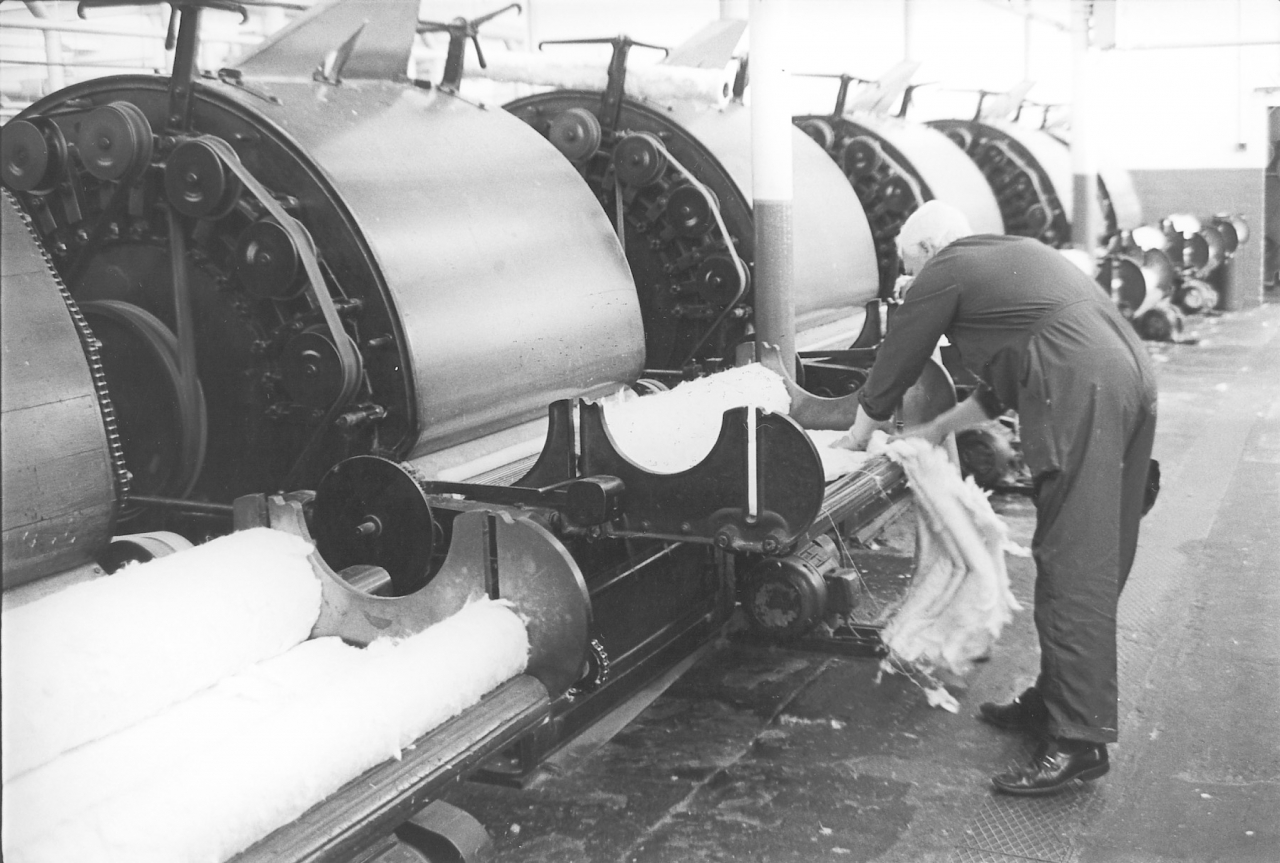
Now we’ve moved to number 0022, having missed out the scutching process and Roland’s going to tell us about the breaker cards. So, number 0020.
R- Well that’ one’s, as you say, one of the breaker cards. Well they make cans [of roving] for the Derby Doubler, the one that Charlie’s on there, and he is just breaking the end of a lap, getting ready to take a roller off, they are on rollers or shells them laps, I’m not sure which they are, I think they must be shells.
What’s the difference Roland?
R- Well, the ones on the, well they are shells now that I mention it, they are on, the breaker cards have shells [in the laps that have] come off the scutchers. Now your finisher cards have the laps that come off the doubler. Now they run on wooden rollers, probably because they don’t break same as shells would, you keep dropping them into the Derby Doubler and they’re liable to beak. And if you’re getting them, with them being metal if they crack you are liable to trap your fingers in them. It doesn’t matter so much with the scutcher because there is an iron rod through them so you don’t actually pick the shell up, where in the doubler you actually pick it out. Anyway, we are going off the subject going on to the Doubler now. But these breakers, the laps come off the scutchers to feed ‘em and the laps on the finisher cards come off the Derby Doubler. (40 min)(800)
And this is the feed end of the breaker cards isn’t it?
R- Yes, that’s the feed end. And when we get near the bottom of the shell there’s like a lot of cotton trailing off and there’s more on it than, if you get too much on your card it’s liable to , well, it means that you have to grind a lot sooner and grinding is what you don’t want to more than you have to.
Grinding being the setting of the breaker cards?
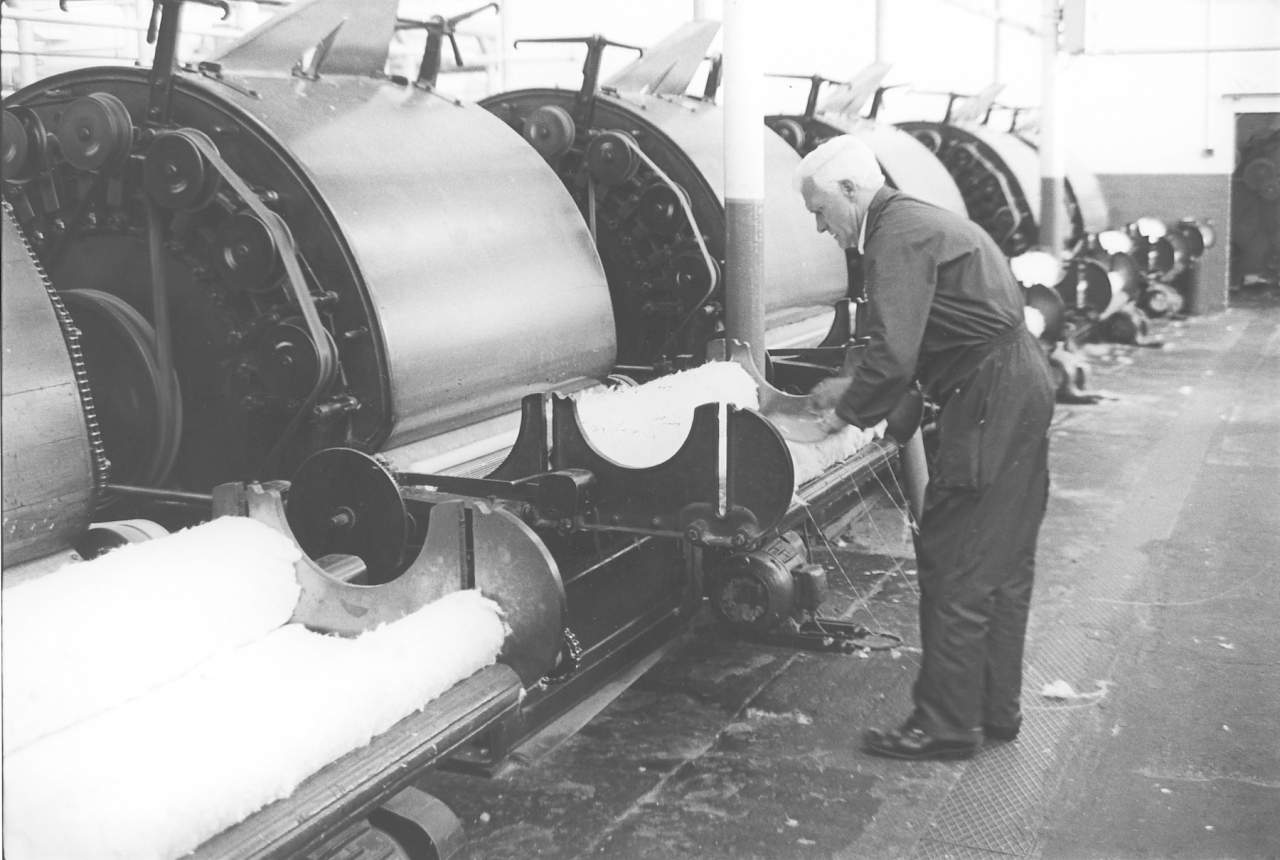
R- Meaning taking everything down and cleaning it all. 0021 shows it better, he’s actually taken the shell off on 0021 and he’s breaking it level. It does that so when you, and then tuck it under when it’s going through this other one. So when it gets, when the lure gets level with this other lap that’s in front of it he’ll pull that one back and put his new lap there. So you’ve always got the one that’s running out at the back you don’t want to be pulling one from the middle of your card when it’s running out. So when that lure gets level with that lap in front he’ll pull that back and he’ll put his new lap in the front there. And there's a rod goes through the shell. In fact you can just see the rod there, on that one in front, it goes right through the shell and out the other end to stop it moving forward or back and a mess if it does and all. Well that’s what the rod's in for, to stop them moving. You don’t really need one on the back, ‘cause with your lattices there’s like gap in it, it fits in nicely does that one but there isn’t one in the middle of the lattice.
And what sort of process is going on there?
R- Really it’s, what should I say, like opening it up again to try to get it down to cotton fibres again. It’s like a fibre when it comes off the front end. I don’t know whether it shows any on here at the moment. But it’s like a fibre when it comes out, just like a film of cotton and it goes through, oh I forget what you call them now, but it goes through the front end of the card and you’ve got, it’s rolled then, the machine actually rolls it so it’s like a thick cotton you know, about an inch in diameter.
Is that what you call a roving?
R- Some of it is yes., some of that is roving.
And it's sort of…
R - And it puts it in a can then that’s revolving and so that fills your can up.
In a coil.
R - In a coil yes.
Yes, and then the interesting thing about that if I remember rightly is that it’s fed out from the top so there’s another mixing process going because it’s fed in from the bottom and fed out from the top.
R – Yes but we are going off again then, we could get that when we get to the Derby Doubler.
Well I was just mentioning that it was another blending process.
[Roland’s being a bit obtuse with Mary here because she’s actually making a very important point, albeit slightly off the mark. One of the things that has always struck me about the processing of cotton fibre is the way that reversing the flow at each stage is used as a tool for helping ensure maximum straightening of the fibres ]
R- ‘Cause really you are blending all the way through.
Yes. What’s the process. Sorry. (850)
R - You've got two… Now you've got two laps on each card, which again must be a blending, because they've not been made at the same time.
That’s right. And they are going through really slowly aren't they?
R - Yes, they go through slowly them.
And what’s the process at the front called? You know where there is those metal bars jogging off the cotton, off those spiked bars all the time?
R- That’s combing is that.
Combing? That's right, it's a mechanized comb.
R- I was thinking then, it's that long since I did it.
A mechanised version of the old hand cards isn’t it. And then it’s set off into this sort of roll isn’t it.
R- Yes. Because it's even combed on finisher cards as well. It’s combed on to…
On to the rollers isn’t it.
R – Yes. Because I think that really that’s the only way you'll get it off the cylinder, comb it off. (45 min)
Yes, because they are like teasels aren’t they. Picture 0023.
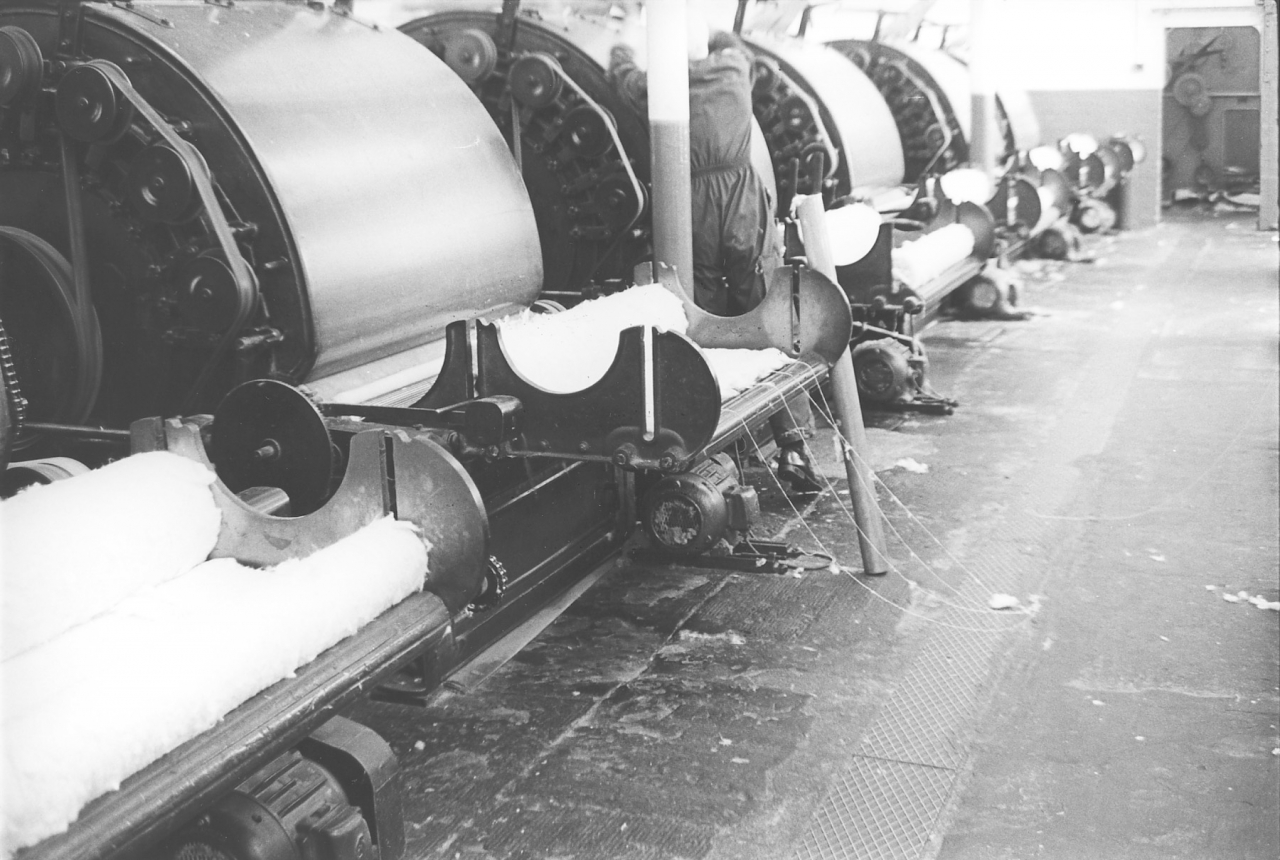
R- And twenty three isn’t so different than 0022 apart from the fact that you can see that he’s taken off the empty shell. Now that’s what your laps run on off the scutcher. I wonder what he is doing there our Charlie?
Those fine bits of cotton you can see?
R- Yes well they’re from the pirns on your scutcher. It keeps your lap in place, if you didn’t have them it’d all be …
Matted up together.
R - Yes. And it just wouldn’t run.
It just separates each layer, each roll doesn't it?
R- Yes, each turn of the lap.
That’s right, yes.
R- I think he’s got a ….
Break down?
R – A scotch. I think he has got a scotch in his fan on the top there.
A what? A whisky scotch?
R – It’s blocked up. Not that sort of scotch, like a scotch on a wheel.
I’ve never heard that expression. It’s the same one I suppose that you use for ‘that scotched it’ which means sort of broken up.
R - It stopped it. It's like people say when you've got a car, put a brick under, if it’s on a run it’ll scotch it. It won’t move with a brick under the wheel.
Yea, that's right, this is the same sort of expression.
R - Well, I think he’s got it blocked near the fan. The fan sucks the cotton you know where there’s dust and so on, off the top there. Now each one has got like a vent on the top and if they get stuck you can pull like a tin plate out to clear it and put it back on again. That’s what our Charlie’s doing there. Oh, now then, 0024. that’s the front end of the breaker card. That’s one of his bad photographs as well because you can’t see the comb.
You are quite right.
R- Now that is the front end of your breaker. Now as I’ve said, at the front, just in front of this doffer, that’s the small cylinder you can see turning. Now, you can see your cotton there, it’s fluffed up. Now it goes through these rollers at the side and it’s rolled into…
SCG/04 July 2003
7,856 words.
LANCASHIRE TEXTILE PROJECT
TAPE 80/SHJ/06
THIS TAPE HAS BEEN RECORDED ON MAY 26TH 1980 AT 119 BURY ROAD, HASLINGDEN. THE INFORMANT IS ROLAND TAYLOR, JUMBO OPERATOR AT SPRING VALE MILL. THE INTERVIEWER IS MARY HUNTER.
Right, back on number 0024 Roland.
R- Again.
Again.
R- Well, I’ve got now to where it’s coming through the rollers and it’s rolled it into an inch diameter strip and it goes through the coiler on the front. It goes through the hole on the top of the collar, comes into this can which rotates as your cotton is coming in. It’s wound round in a circle to fill the can.
And that one’s nearly full isn't it.
R- That one’s nearly full yes, there’ll be about another ten minutes on that.
Really?
R- ‘Cause you can push them down a bit, and that hasn’t been pushed down yet. In fact you can push it and that can keep them going for quite a while.(50)
Who, who pushes them down? Someone or the machine?
R- No, somebody. See them, we’d have to take them out, if they don’t want them out yet they’ll push them down a bit, keep them going a bit longer. Like normally they don't because the doubler normally goes quicker than what they are making them. So normally we whip them out about then. Now the lever at the bottom of the machine on the loft there, well that stops these rollers in case like it breaks or it snaps away, which it has a tendency to do, you’ve got to stop it while you get another end in there and you’ve to roll it in your hands so as it has got a point on your cotton, you’d never try getting it into something the same size of hole, it’d take some doing. So you’ve got to get it pointed to get it into the hole. All that lever does is stop the rollers. And the doffer lid, it stops it moving, once you lift it up it sets it on again. It doesn’t actually stop your card from running.
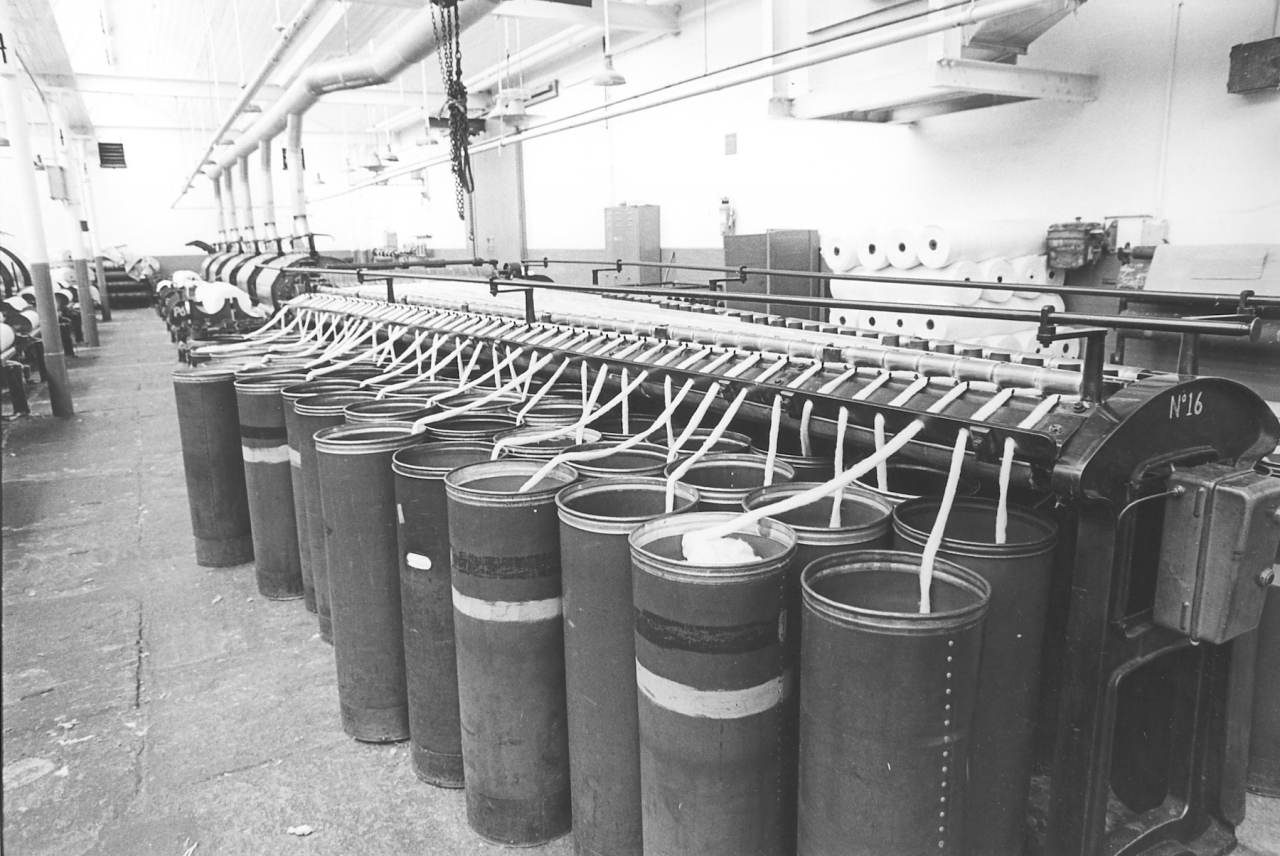
Picture number 0025. Now that’s a view of the smaller Derby Doubler, and this one isn’t, doesn’t run of the same cans that you’ve just seen in the other photograph.
Doesn’t it? Oh I thought…
R- No, that’s what I say, it’s a different one. If you look at your cans there and look at the cans on this one… (100)
Oh, it hasn’t got a stripe on it.
R- No. Have a close look at that one.
Oh dear, now comes the test.
R- Can you have a close look at that one?
Right…
R- Now, what’s the difference?
One's taller and a narrow neck and the other is smaller with a wider neck.
R- No. They’re actually smaller, they're the same size, but one of them's a lot bigger in diameter than the other one.
Did I pass the test?
R- Just about. Now this one runs off .. well we call them pups, they're smaller cards that the ones you were just looking at. You can laugh but that’s what they call them, pups, because they are smaller (5 min)(150) than them. And I forget how many cans there are on it. There's about 100 cans running this one. I think there is only 40 on that other one, if my memory serves me right. And this one, it's a slower doubler than the other one, why I don’t know but it is, and this for ... the one on 0026, is nearly all back view. It’s from this back view, and ... your starter for this one you can just about see in 0026 is on the right hand-side of your picture. But the other end which you can’t see at the moment is the end where your finished lap comes out. He's taking all the wrong end in here. (150)
[026]
Isn't this the way the lap comes out?
R- No, because your starter motor's always at the opposite end to where your lap comes off.
Oh.
R- In fact, we were saying with the other doubler…
Yes.
R- Now your rods on the top, on your arms there. Them’s for stopping your doubler from running. Those bars they have, where you see your cotton going on to the top just before the rollers, like a hinge. Well, loops on a bracket, and normally, if your end breaks them loops lift up and it’ll stop. Well sometimes like we weren’t [effective] and it’d keep going, they don’t always stop when it runs off or breaks so you’ve got to keep your eyes open in front because if it runs too long there you’ll get a gap in your lap where there is an end missing. Well you have to stop it then and put your fresh can on. Now, where are we, I don’t think there’s much else there…
What does that machine do?
R- It puts your cotton, well you can see on the right hand side, it makes it into laps like that stacked on the right hand side there.
Oh, beyond the doubler?
R- Yes, on the right hand side of the doubler there. And they are for your finisher cards. It make it easier to run on your finisher cards. Where are we now? Nothing more there. (200)
So basically it's turning this inch roll into yet another lap.
R- yes, it’s another lap. It make it, what shall we say, well really it’s to get rid of your cotton mostly. You know, when you saw your lap on your back of the breaker card and had your cotton that were hanging down. Well you don’t want that on your finisher cards. Well it breaks it up before it gets there, what you’ve got to, see that breaker till it gets rid of that cotton. Now it’s got rid of your cotton but now you want to get it back into lap form again. Like I say, all this really again is blending all the way through because your mixing all the time you get cans from different machines, you’ve got different laps in different days and so on.
[This is slightly confused. The process of combining up to a hundred cans on the Derby Doubler is of course another blending operation but additionally, the fibres are better organised when they come off the breaker card and the combining and pressing of the large lap on the doubler produces a more compressed and organised sheet of fibres which is easier to convert to mule roving in the finisher card. This re-organising of the fibres is just as important as the blending element.]
And those, the laps that come off the Derby Doubler, they are quite heavy aren’t they?
R- Yes they are a fair weight. Not really a ladies job but there used to be ladies do it, and they go on to your finisher cards. In fact you can just about see some on the left hand side in the photograph, on the bottom there, they go on to them cards.
So in fact if there was another part of the breaker cards that was actually producing a lap instead of a coil the Derby Doubler could be done away with. So it’s just a link process.
R- Yes and I think they do have them now like that. It could be made into a lap instead of having just one roller on your things, having a lot of them, it’d come out in a lap. In fact I think they do make them like that now. And you wouldn’t need your Derby Doubler. Well, that’s near enough, are you right there?
Yes.
R- Picture 0026 is near enough the same picture but on the right hand-side instead of the left. And there you can see your finisher cards a bit more plain, where the laps off the doubler go. In fact if you look down on the bottom of each picture you’ll see what we call the pups where they make the cans for this doubler. In fact there’s only about a dozen altogether in for running for this. ‘Cause it runs a lot slower than the other one. It doesn’t need as many. Looking for ends down, there isn’t , he’s being lazy is the lad leaving empty cans there.
When I’ve watched that machine in operation it seemed to stop very frequently with ends breaking as it just goes through those feed bars, feed rollers. Is that normal? (300)
R- Well sometimes you see a lot depending on the stuff. If you get rough stuff in it’s liable to do it.
Because presumably it only needs a slight inconsistency in the width of that roll of cotton and it will…
R- Yes if you do get like a knot in it it’s liable to do that.
Yes. What happens in the actual drum before it comes out as a lap?
R - What do you mean by that?
Well, what process does it go through apart from these fifty or so ends on each side being fed in? What happens in the actual drum before it comes out or is it just matted into a lap?
R – It’s just rammed together and put into a lap. It goes through a lot of rollers, again, you haven’t got the photograph.
I think perhaps later.
R- Aye that’s later on. But there’s rollers at the other end, they go through a series of rollers that rolls it into a lap.
But there’s no breaking down again.
R- No. No breaking down, no.
OK. That’s fine.
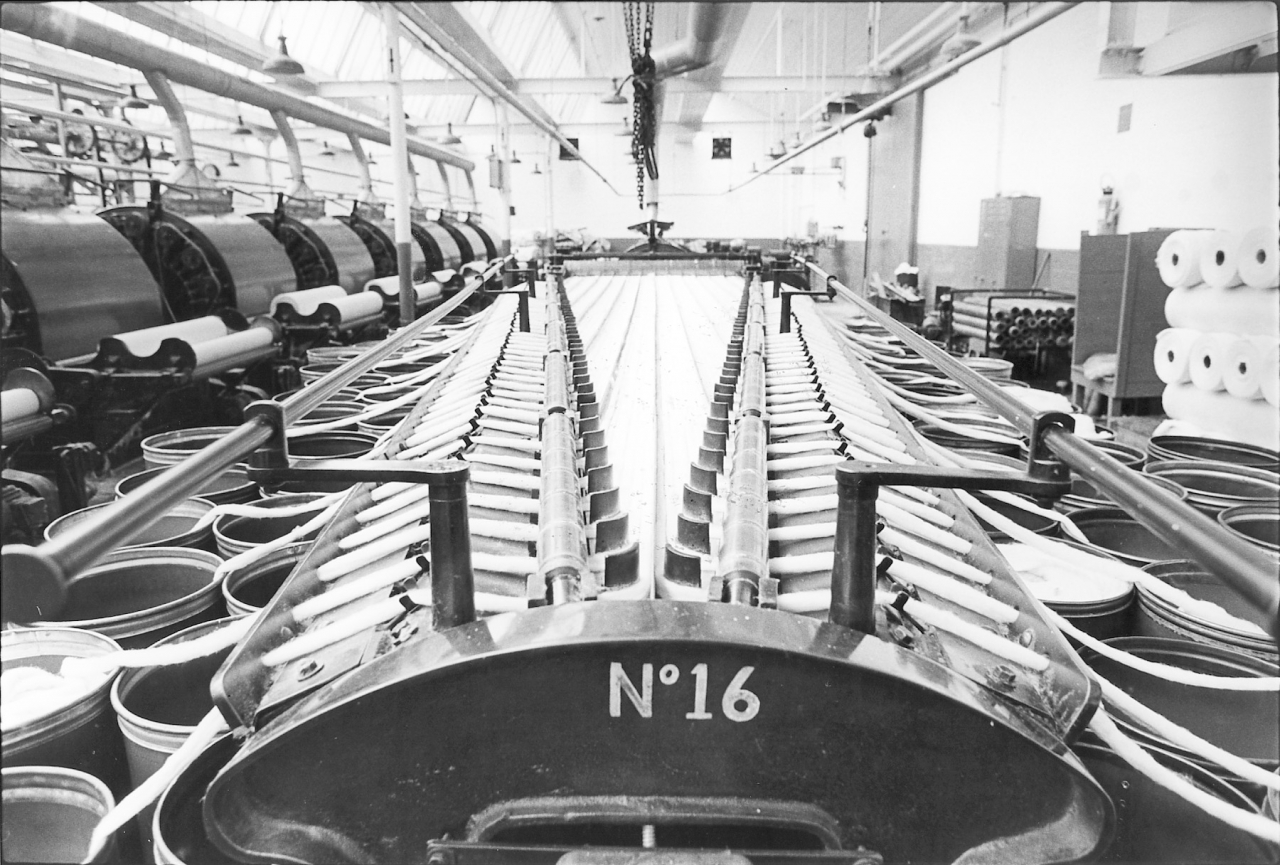
R- number 0027. It’s a photograph right from the back of this Derby Doubler. And there you can see where all your ends actually go together and meet at the front end there. They’ve run along in channels, tin channels that runs down in all them channels. That’s just to stop it from twisting up as it’s running down. You don’t want it twisted before you start making your lap, it’d only break down every time you’ve made your lap. I don’t think there is much to say there. Like on the right hand side there you can see further down in your full laps, there are wooden bobbins that they use to put your laps on. (350)
For the Derby Doubler?
R- Yes, for the Derby Doubler. And they’re wood not metal like you’d get on the scutcher. Brian’ll probably tell you why. You know, technically why ones for one and the other’s for the others.
I shall have to remember to ask him.
R- I’ll remind him when I go down tomorrow.
Right.
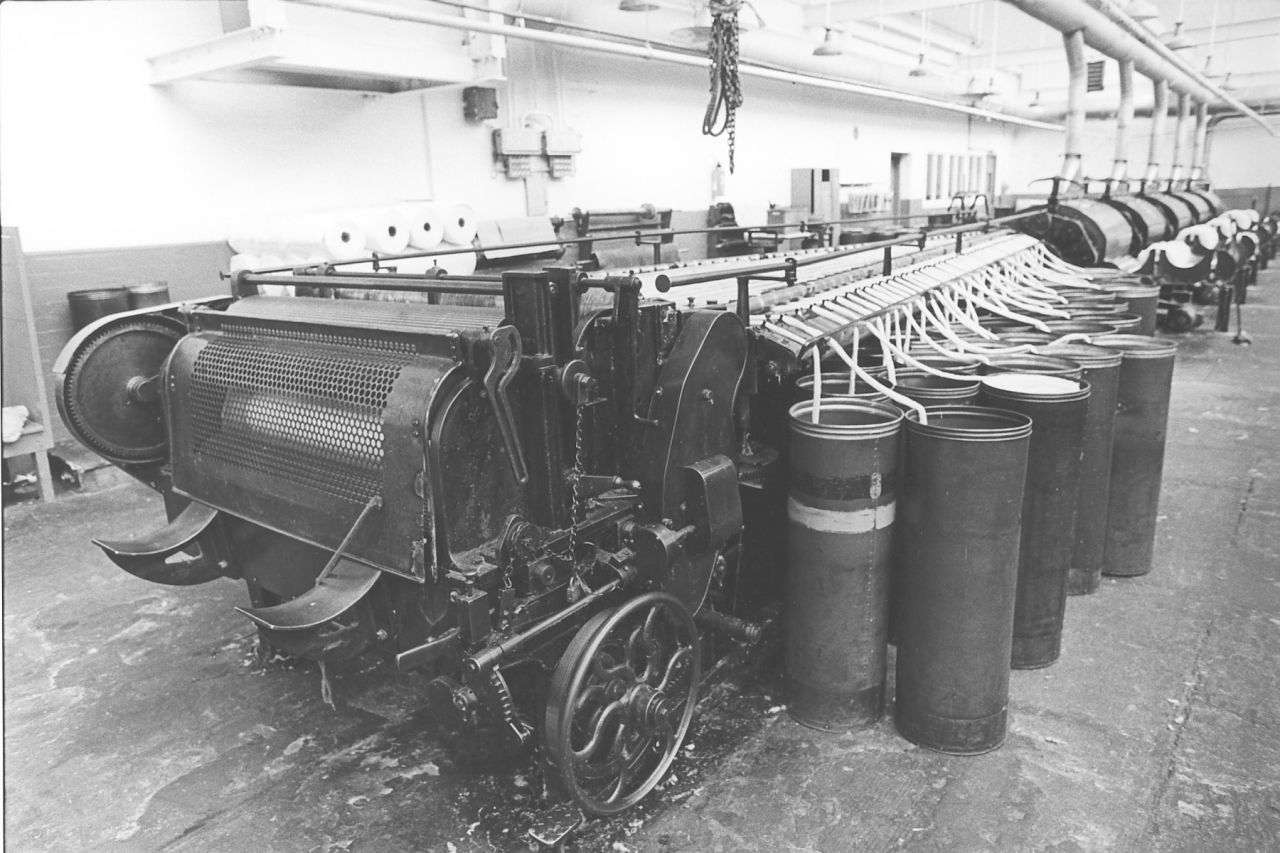
R- Now then, number 0028. Now that’s your front end of your Derby Doubler. Yes, it’s like stopped and all. Where do we start? Now when it’s making a lap there’s like a cage in front here, like a grill, and that’s down while it’s making a lap. Now when it’s made the lap, that lid door starts lifting up and when it’s fully up you’ve a foot lever and a wheel on the right hand side here. Now you turn that wheel to lift up the rollers off the top of the lap because the rollers are to keep it flat and even. Well that lifts the rollers up so your lap will roll forward on to these two ledges on the front of your doubler for it. And after you put your fresh wooden roller on you push your rod on a bit to send your cotton through so you can just wrap it on your roller to start with. And you turn your, lift, there’s a lever again on your left hand side. You lift up and turn it down so it’s set for how long it has to run and again, you turn your wheel down which fetches your roller down onto your lap before you start making your lap again. (15 min)(400)
So it’s set to stop automatically when it’s full?
R- Yes, again, it’s set on a lot of teeth is that arm, get the teeth run up and when it sets in the one you want that’s it. But then again, if you’re rushing you’ve a tendency to drop it in too early and that’s when you get a small lap and it happens occasionally. [When you’re] running if you don’t quite drop it in the right tooth and it makes your lap quicker therefore it’s not as big as it ought to be.
Yes. Do you know why this chain's hanging down here above it?
R- I think that’s the, it’s not actually there for a particular purpose, just if there is any breakdown, if your rollers go at the front there you can’t lift them out by hand, they've got to have a block and tackle job and it’s not that long age that they did that, that’s why it’s still there. Like if they'd done another job somewhere else in the mill they*d be moving them. So if they haven’t a use for that block and tackle they’d leave them where they’ve last had a use for them. They had to take them rollers out not long before he did them pictures so that’s why your block and tackle’s still there. Nothing else to say really about that.
Right.
R - 0029. I don’t know why he’s took that one.
Fire buckets perhaps.
R - Might have been. See, if you notice in a lot of the photographs there are fire buckets all round the walls which are a necessity in a cotton mill anyway. Because even your motors on your cards could cause a fire and set some of your cotton afire. And they’ve had fires before today in the card room, not so often, I think they’ve only had about three while I have been there. But they do happen, they are supposed to be kept full and all. I know the fire inspector comes round every now and again so if they are not full there are words said right from the top to bottom then…(450)
And those are at the back of the breaker cards aren’t they?
R- Yes them are, them are the breaker cards belonging to the other Derby Doubler. And it could be because you can just about see the other Derby Doubler about half way down, after the fifth card you can just see the other Derby Doubler sticking out there.
Yes.
R- And well on this what. About half way on your picture, on the ceiling, about half an inch, you’ve got a fan there. That’s for during the winter when they are working it’s for blowing hot air in to try and keep them warm. Cotton’s like a lot of other things, if it doesn’t like running. And like neither do we.
It's a nice tidy alley there.
R- It is, but it used to be cleaner than that, every day when Johnny were there. It got a bit untidy after he’d finished.
Now we’ll move on to 39.14. [Svstripgrind section] We’ve missed out the finisher cards because Glenys has already covered them so we are moving on to grinding. OK Roland..
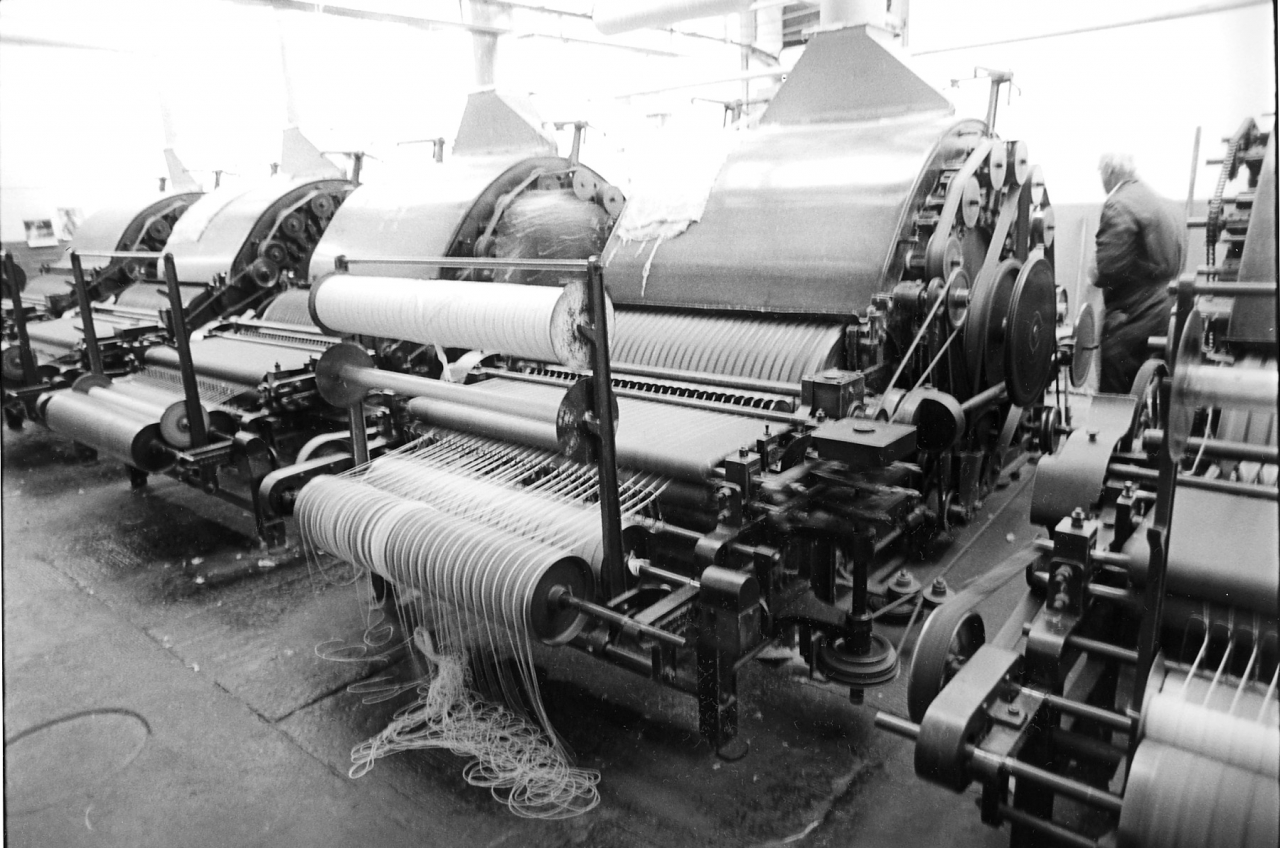
R – Well, 39.14 They've just started running the cotton off at the back there, they’ve took the full lap off and they’re running the card bare. You can tell they are running it bare when you see the cotton going over the rollers at the front, and no bobbin in to wind on. Not much more you can day because they are only waiting for it running bare in that one.
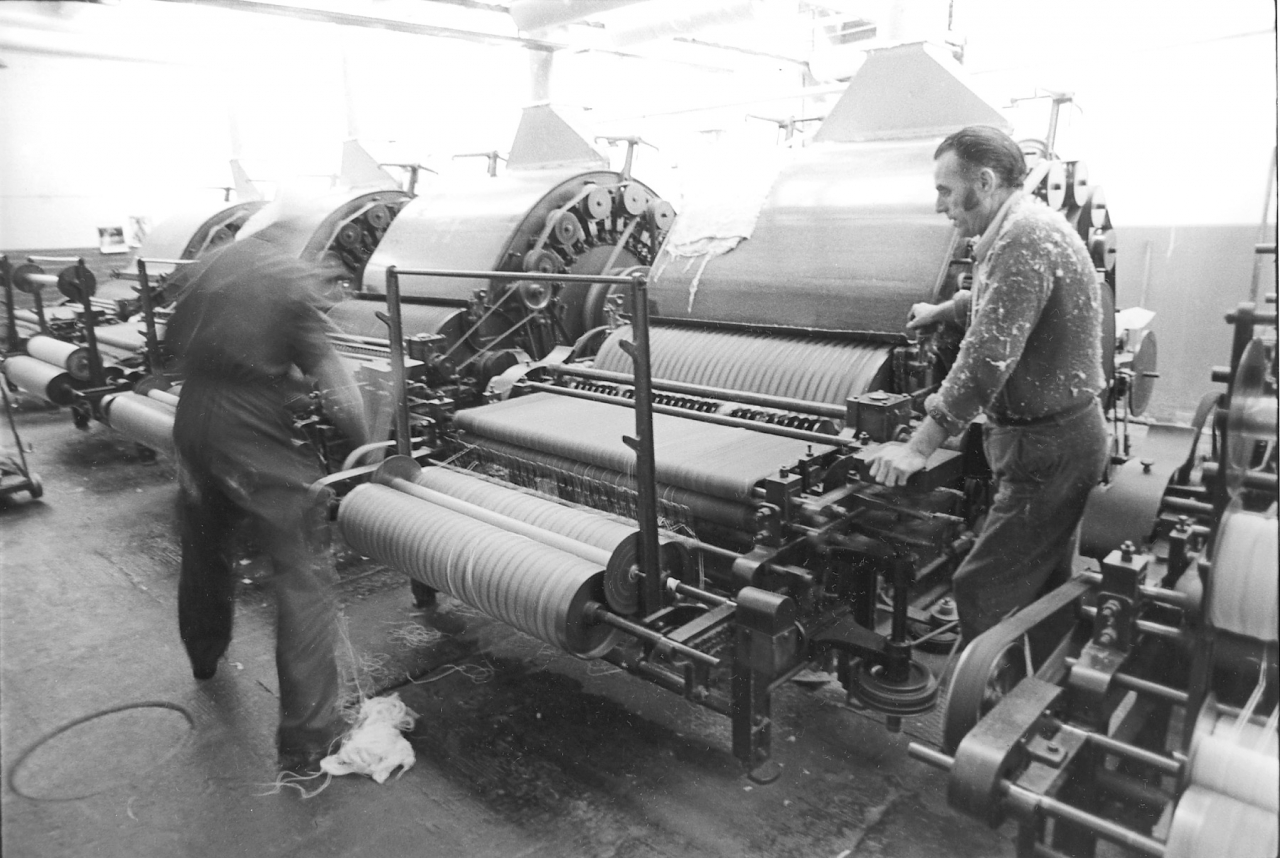
39.15, like they’ve near enough run it bare on that one and he’s, if you can see he’s cleaned it off the roller where it were lapping, it were lapping round [wrapping] The wooden rollers at the front, he’s near enough cleaned it off there. Again, nothing more you can say about that one
You need two people to grind then?
R- When you grind you need two people yes. You can’t lift them out on your own.
And how often would grinding be done?
R- A lot depends on how much they’ve run or how dirty the stuff’s been. When they were running fully and they had full staff on they used to do say two, at least two or three cards a day on one set so that’s what? Say six cards a day were being ground. So in three weeks or a month they’ve all been done, well, definitely in a month when they were going, running full production and full staff. If you got short of staff then they’re let go a lot longer, you haven't got the staff to do it with. That's when we used to do a lot of our grinding at night, we used to do it in overtime.
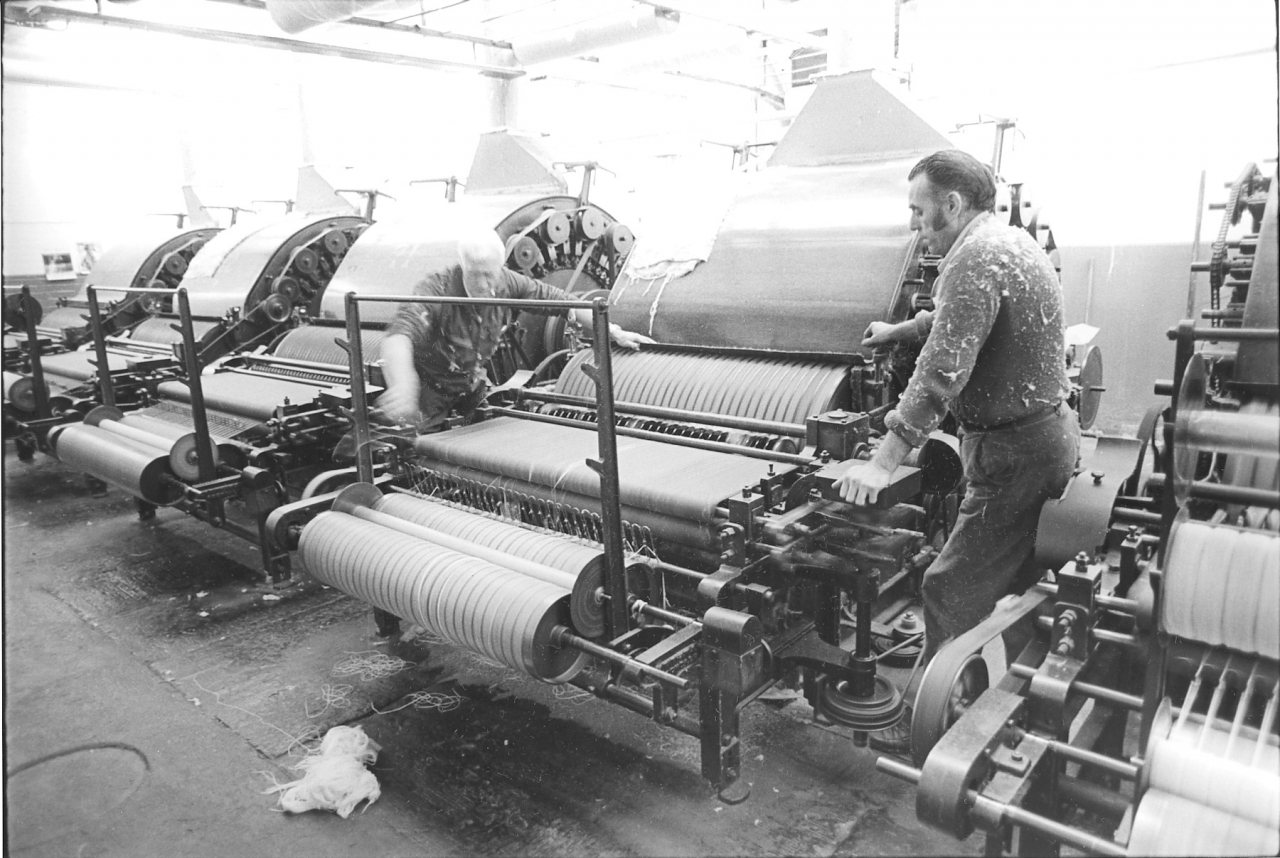
Then 39.16, I think they are just waiting for it stopping now, they’ve run it bare, they are waiting for it stopping. Again you can't go lifting things up while they’re running, well they can but you get shot at if you are caught doing it, specially if you hurt yourself. See, they’re just waiting, you can see that doffer just leaving a bit on the end of the rails there where they were watching. Once it stops they’ll be ready to start grinding, well getting ready to preparing to start grinding, that’s more like it.

Now on 39.17. It’s stopped and they are lifting the front cover up. And under there you can see the rollers and the, well they call them rollers and clearers, the big ones are the rollers and the (550) small ones are the clearers.
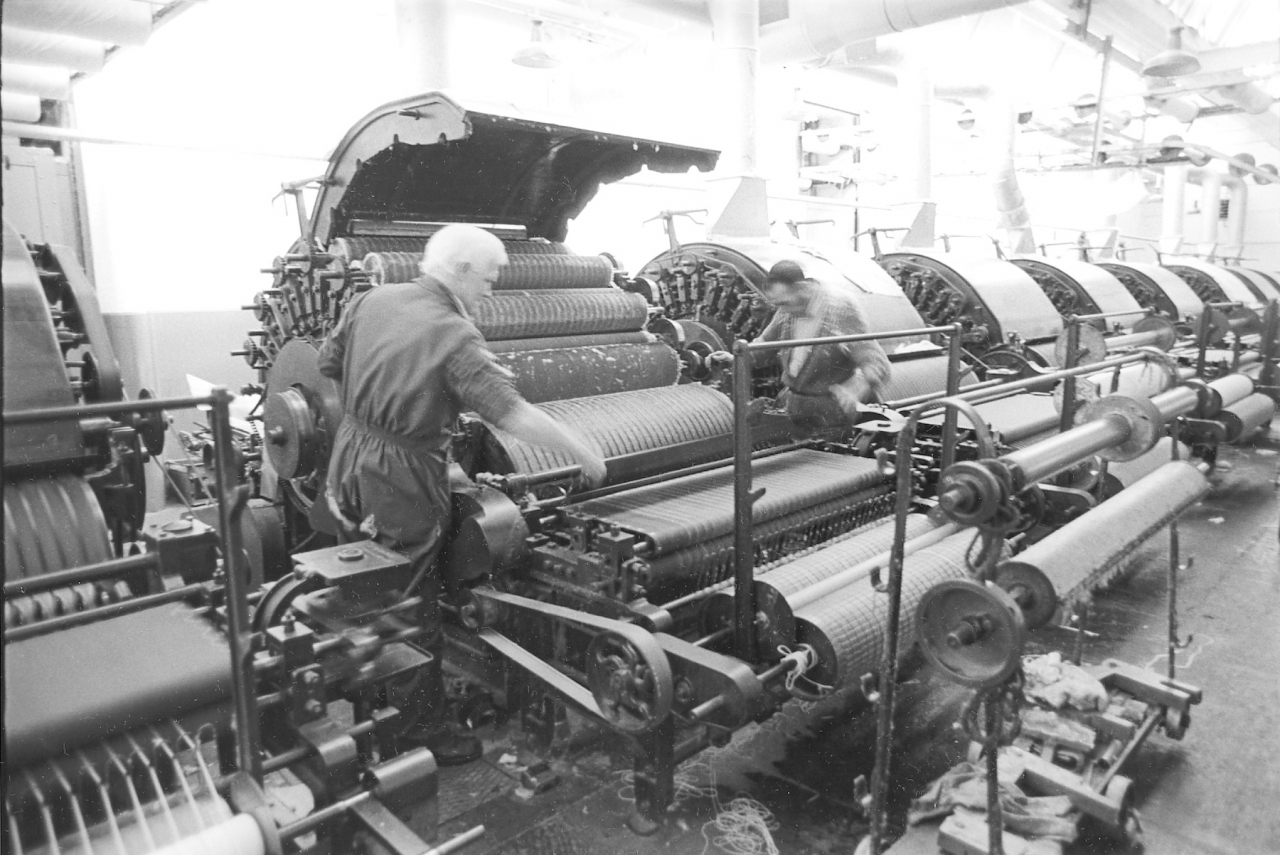
Now you've 39.18. This is a guard on the front of this little doffer where Charlie, he’s the one with the light coloured hair, has got his hand, I should say white rather than light shouldn’t I? Well, they take that away so that they can let that doffer run free, because it has to run when they start grinding it. When we get to the photograph I’ll explain why. Now this trolley they’ve got in front no, they have two light rollers on, one has ? a roller on the top one and there is a small one. It runs, as it's running it runs along that roller, it goes right across the big cylinder but that's really used to sharpen up that cylinder.
Wait a minute, how does it do that?
R- Well, there is a rope and it runs on to one part of your card when, it’s actually when you put a rope on, when you set it on, when it's running, when they are not grinding they have a chain and a belt drive. Well when you start grinding you take your chain and your belt off and you have two special belts. I’m not sure you can see them on there. No, you can't see it on the trolley, they have probably [got them] down the side of the card, but they have two special belts that they put on for when they are grinding and it just runs what they want to run. Like them chains and belts they run the rollers and clearers ‘cause they don't want them running ‘cause they are not there. So you’ve got two special belts, they just run the cylinder which is a big one, which all them are on. And the little one, the doffer, that runs that. Now you, the one with the sharpeners with this small roller on that runs across, goes on your big cylinder. And there is one underneath which is like a brush, now that goes on the doffer and that brushes the doffer, it doesn’t really need sharpening or owt like that, it just wants cleaning off.
And when you way sharpening, do you mean that the individual spikes on the big drum need sharpening?
R- Yes. They get blunt, they get worn down. It really lifts them up and sharpens them. (600)(25 min)
So it’s the same principle as sharpening a knife but it’s on all these hundreds and thousands of spikes as opposed to a single blade.
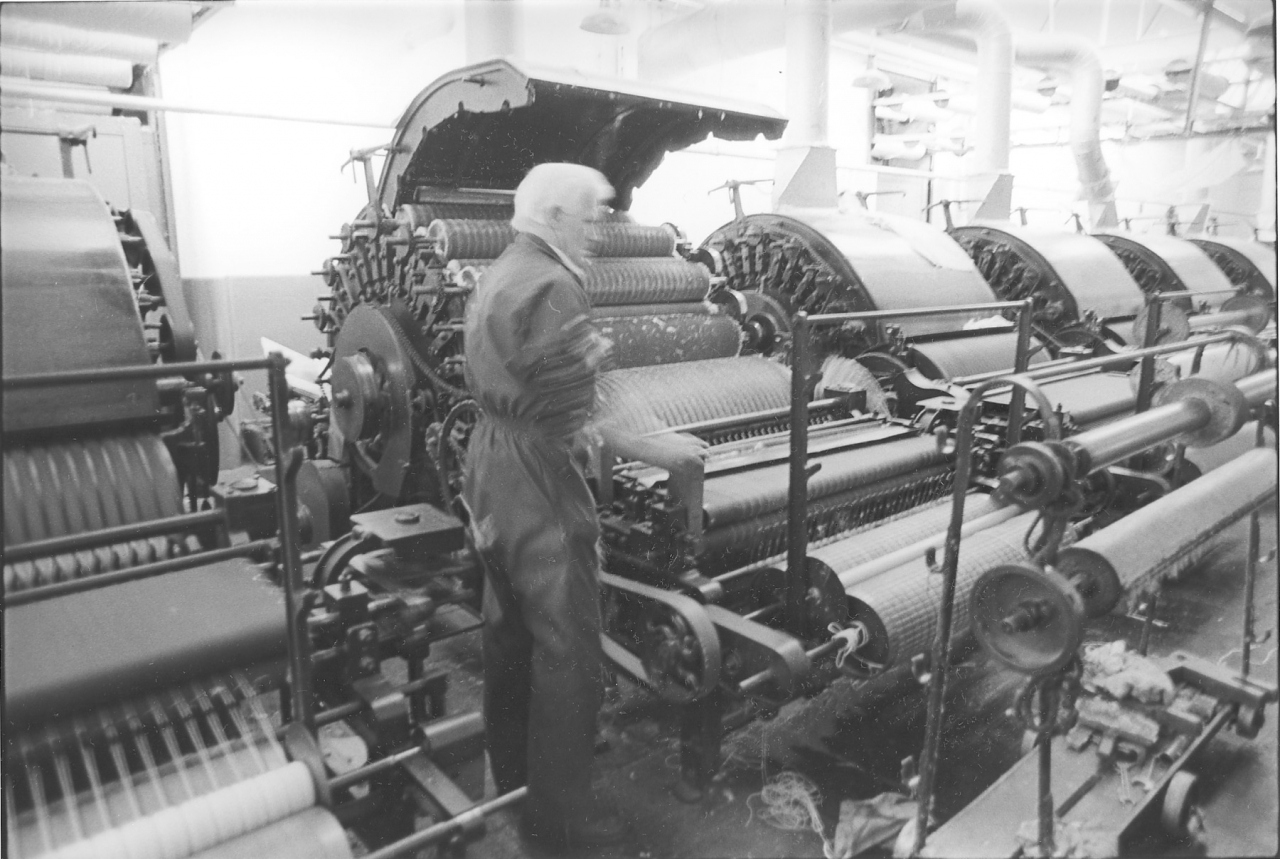
R- Yes. Like on 39.19 you can see the plate they’ve just removed on the belt there. They’ve laid it across there, well you always put it there so you know where it is. See, that won’t move now they’re grinding, them leathers won’t move at all, that belt.
Presumably there is a lot of team work involved in grinding. If you know what your mate’s doing it’s easier.
R- It’s a lot easier aye.
Yes, because it’s a bit like moving by numbers isn’t it?
R- It’s also a lot easier if you’ve got two [blokes] the same size. If you get two people and one’s tall and ones short it’s hard work one way or t’other because you’ve either one getting the weight or the other one’s getting the weight. If you’ve got two about the same size, well if you notice, if you look when they, whenever you see them together you’ve got two near enough the same size so it makes it easier to lift your rollers out.
Am I right in thinking it’s a bit like working by numbers. You have to do it in a certain order and back in a certain order?
R- Yes, back in the reverse order. See there is an easy way of doing it and a damned hard way of doing it and the easy way’s not easy so you can imagine what the hard way is like.
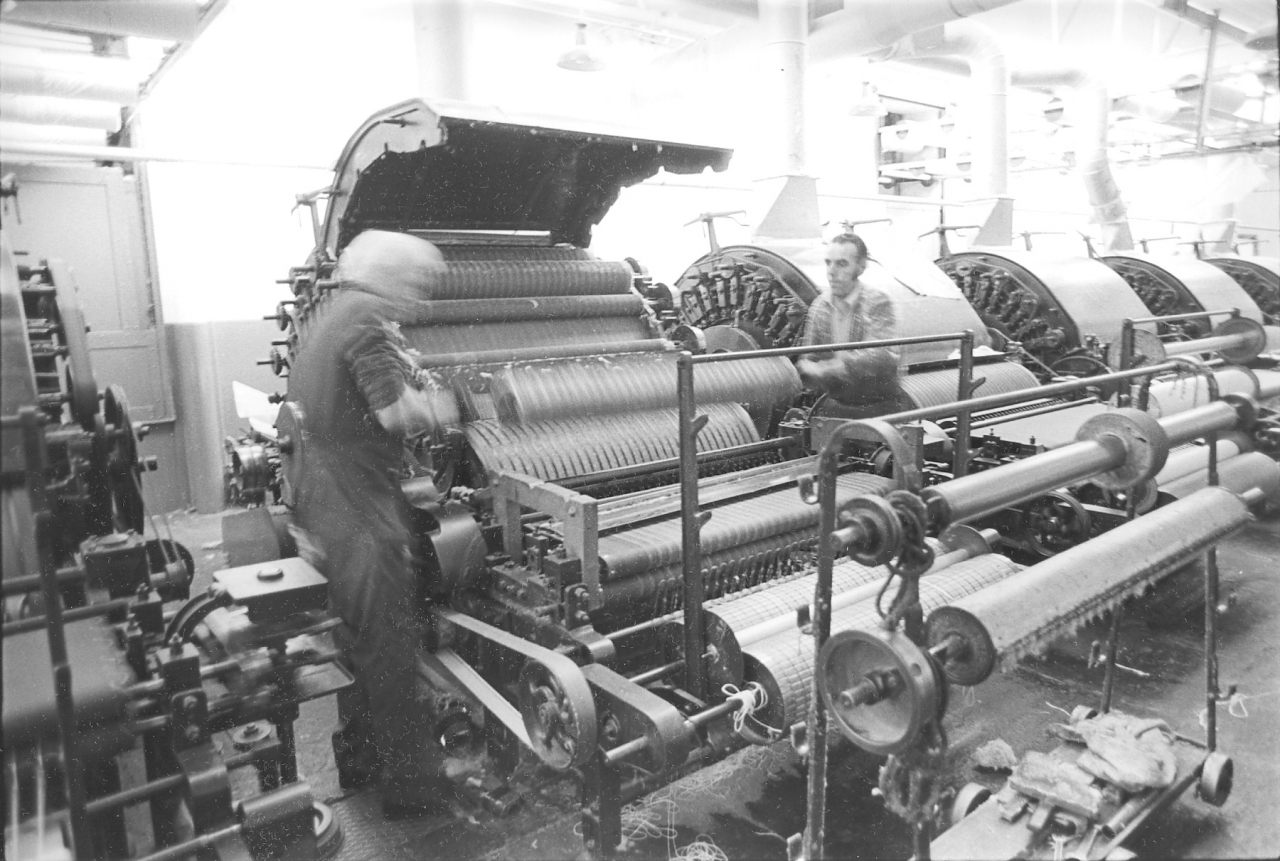
Now, 39.20 you can just see ‘em taking the first roller out there. He’s blurred it and all, not like our Stanley. [Everyone’s a critic!] Well they’re just taking that first roller and see, over this, like them leathers again you’ve got what we call, I forget what they call them myself.
Stirrups?
R- Yes. And they fit over the shafts that ran through your leathers. Now they are to hold your rollers while you're taking them out, because you can’t put your, well your sharpening roller on until you can get at your cylinder. So you use them, you always carry them around on the horse. That’s what them are on is called, a horse. (650)
The trolley? It’s called a horse?
R- Yes they call it a horse. Well, they normally, if you see the other photo you’ve see them in the bottom.
Yes they were.
R- They are always in the bottom there.
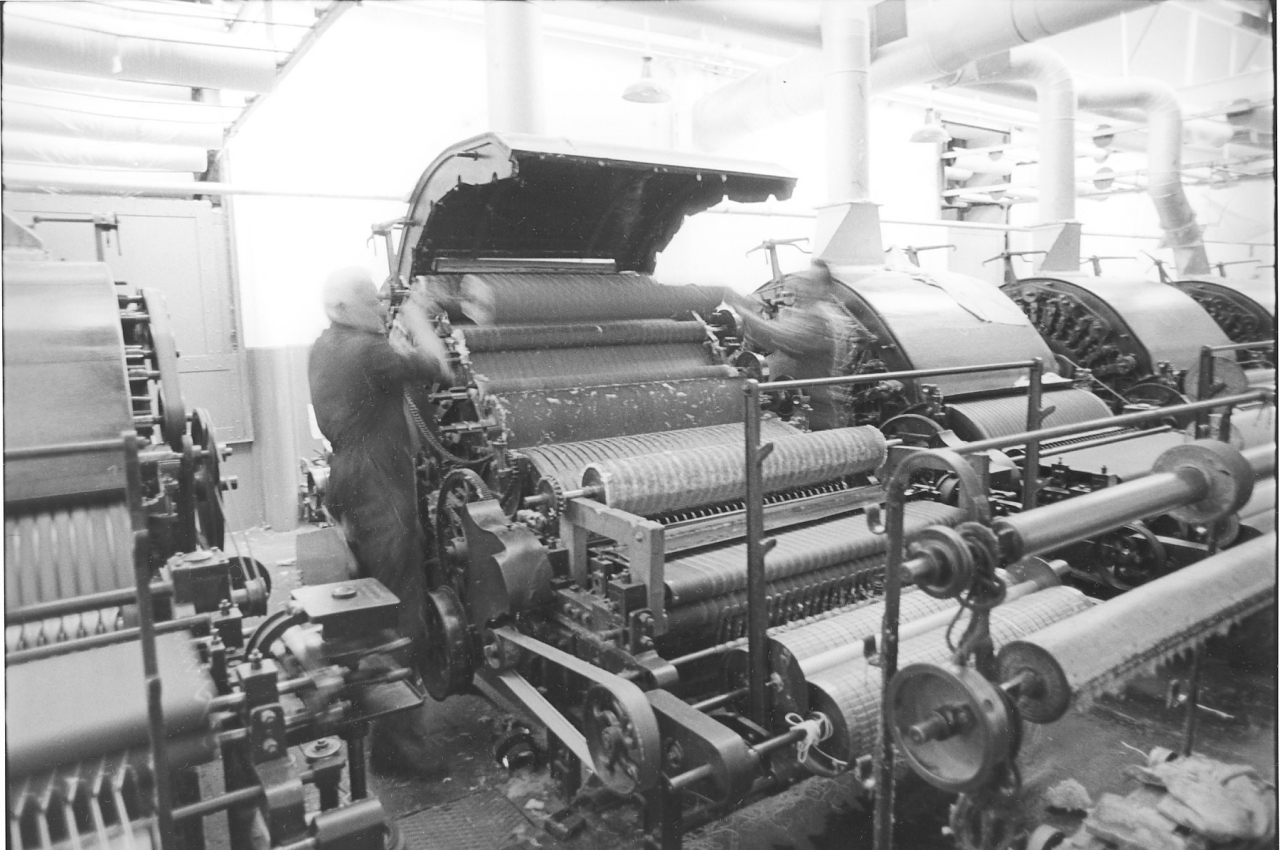
Now then, 39. 21. You see they are taking another roller out. Now you always take your rollers and clearers out together. You don’t go say, a roller, a clearer, a roller, a clearer or you’ll muck yourself up. Now you don’t always grind your rollers and your clearers together ‘cause a lot of the time they don’t both need it, normally it’s your rollers that need grinding and not your clearers.
So the roller that they are lifting out in 39.20 is the roller that's now in position in 39.21?
R- That’s the one. And the one they're lifting out now will be going with it. And [you’ll] find out on one side there’s only three rollers and on the back side there’s four rollers. And you’ve to lift them all out before you can start grinding.
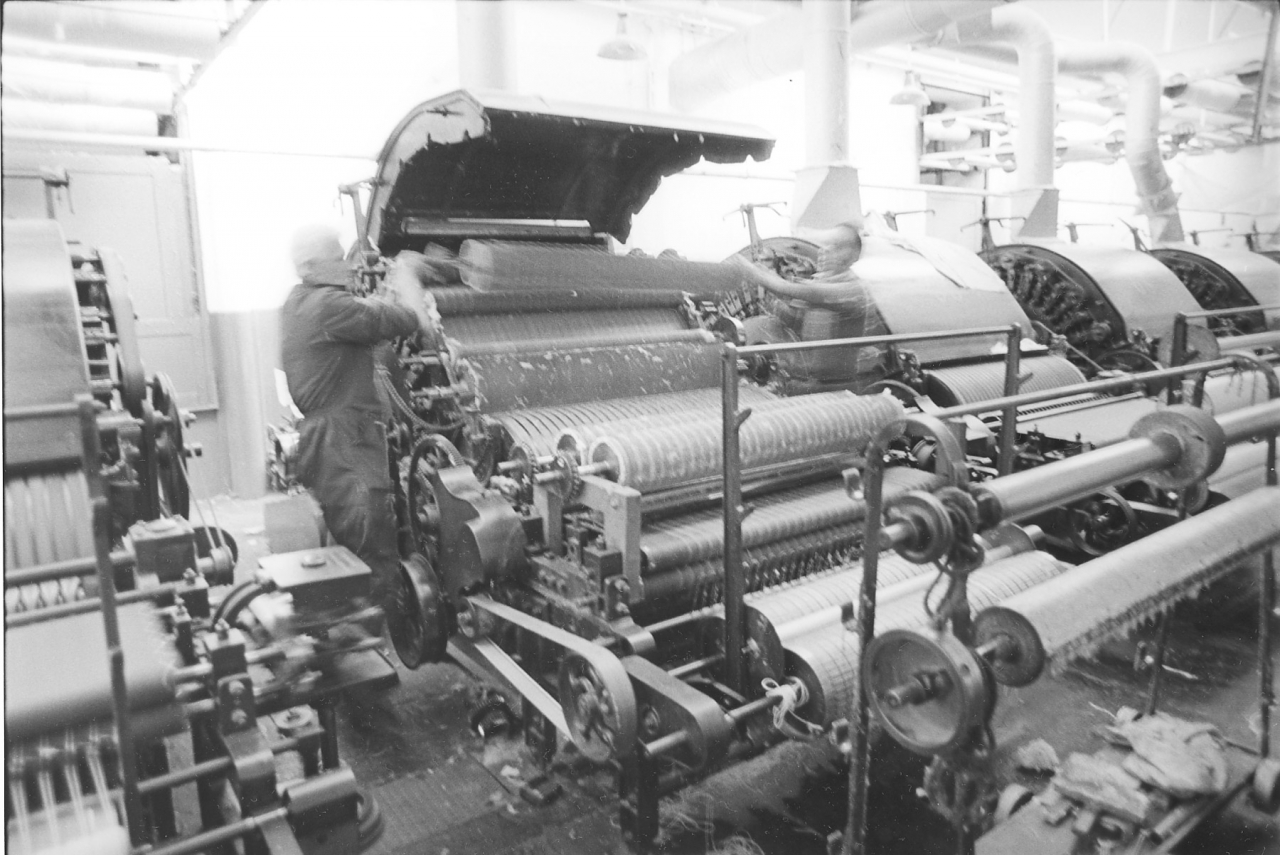
Now 39.22. You’ll see that that roller they were lifting in the previous picture is again in that saddle and they are lifting the top one out on that side now.
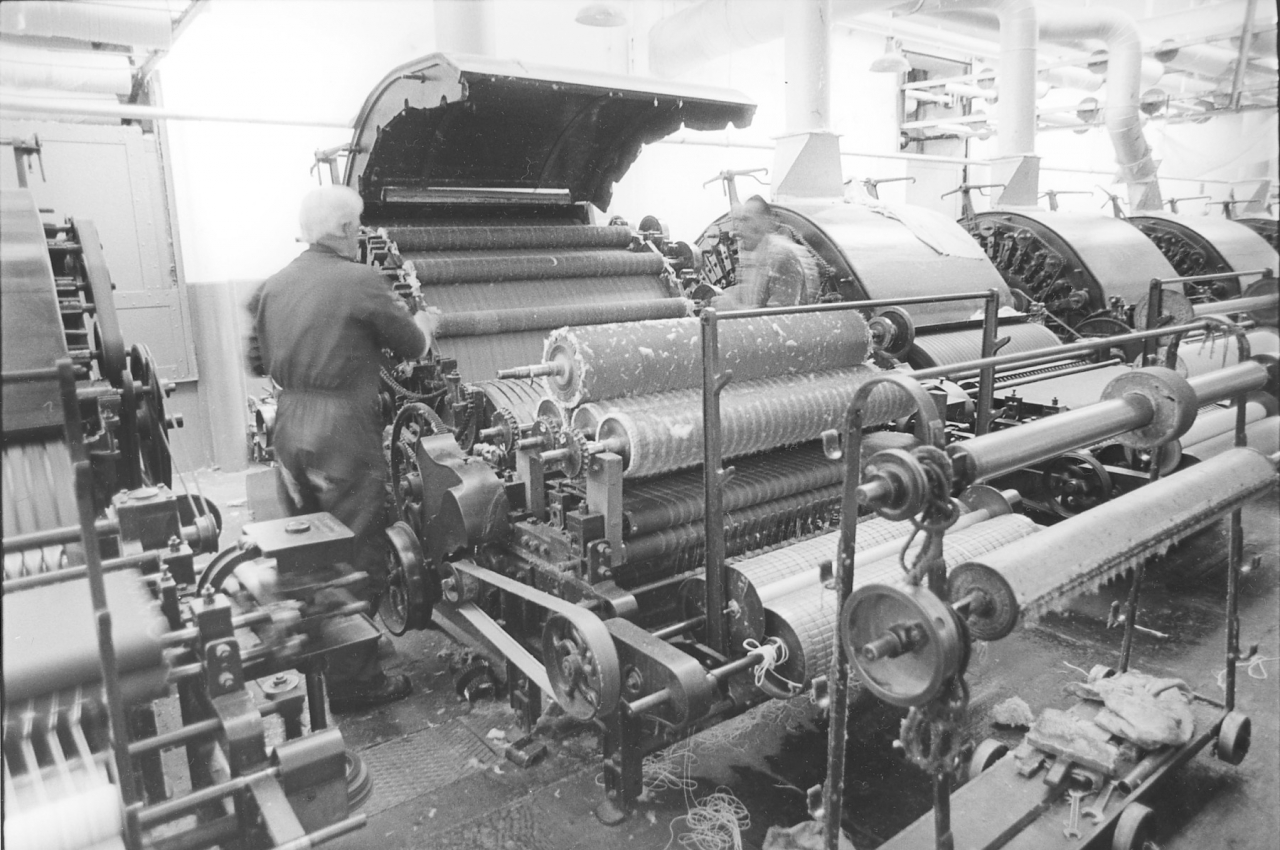
On 39.23 you’ll find out now that they’ve not only taken that one out, but they’ve got the one right underneath the ?, that’s your four on that side and you have three on the other side. I’m not sure whether they’ll take them rollers out… Yes, that’s what they were doing. You see normally, whichever ones you see on the saddle there, they’re the ones that don’t need grinding. See, it looks like they are grinding the clearers on this one. See, they only put them there now, they have another horse, it’s not for… Well, it depends on how they’re working it but when I did it I used to put these off me horse on to the card and the ones I wanted to grind, like they have grinding frames at either end of the room. I’d have put them on to the horse I’d just taken my stuff off to move them down. It saves having two horses in the same alley like you can get short of room when you’ve got two in. (700)(30 min)
So what are they actually doing in 39.23.?
R- It looks like they are getting ready to take the clearers out and they are the smaller ones. He’s missed a lot there,
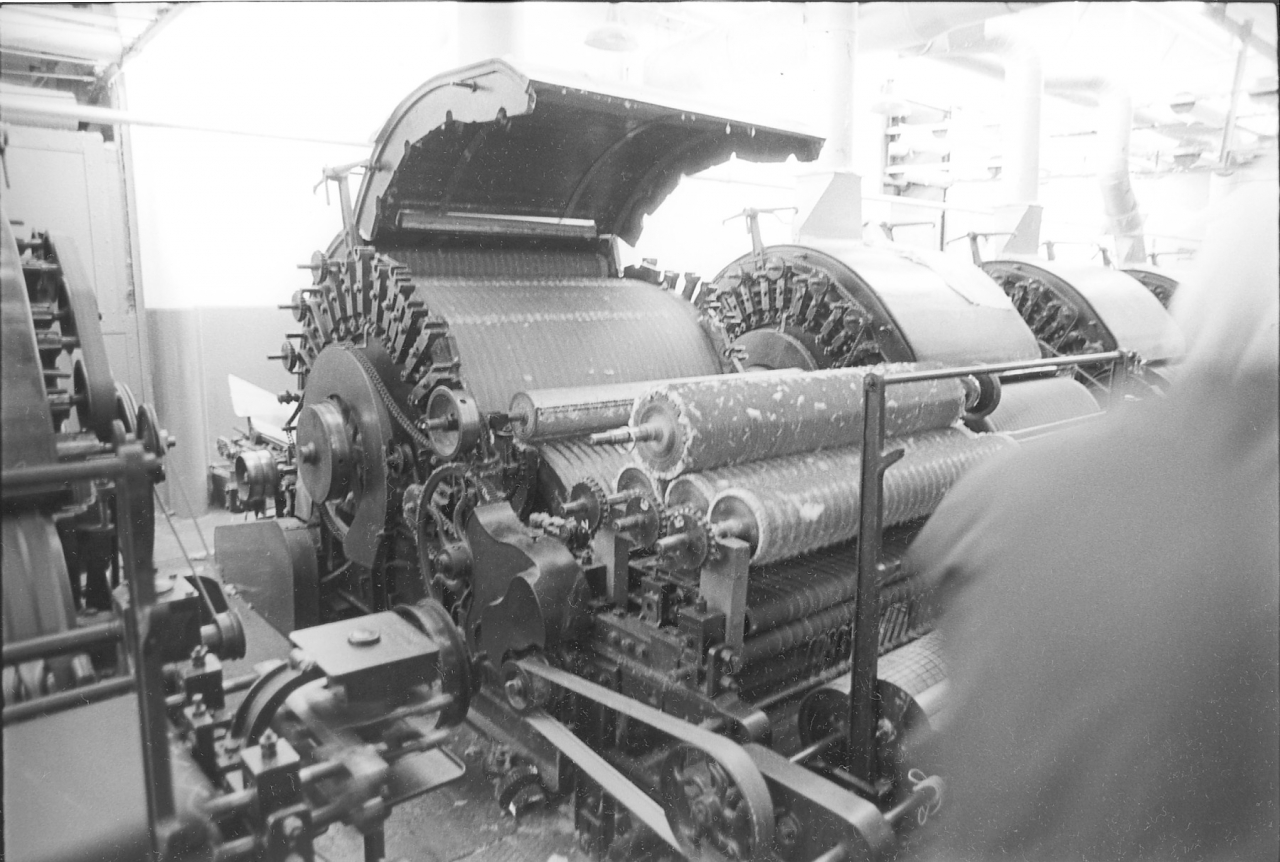
39.24 now, you can see them here, they’ve moved all them clearers out and they’ve put the brush onto the small doffer. It looks like they are getting ready to put your, it looks like they are getting on the horse there to lift the one that actually sharpens ‘em on to the card.
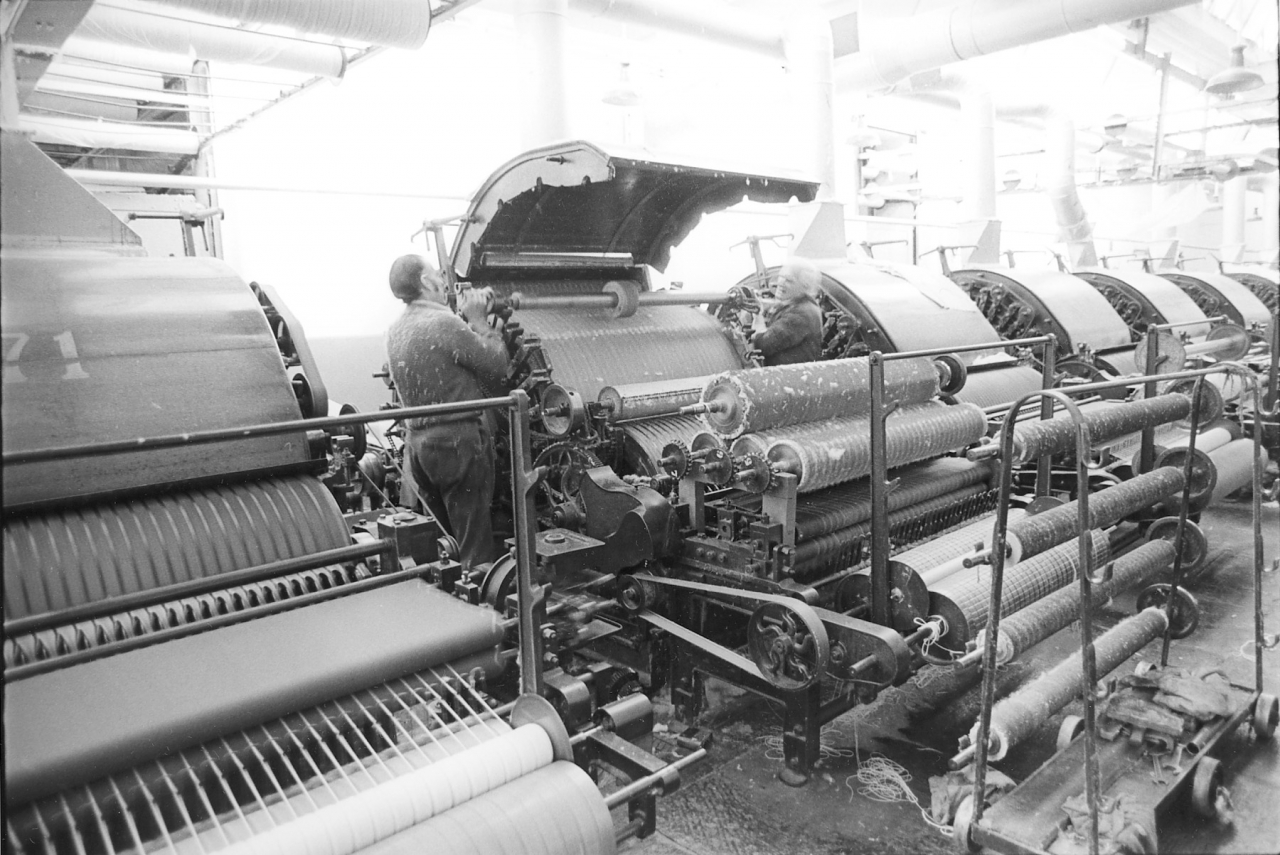
Now in 39.25 you can actually see them lifting it on, you can see by the look on Charlie’s face that it’s not light! When you come, as I say if it’s not team work it’s damned hard work. And they are getting ready now to start the card to do what they actually call grinding, which means this one weren’t that bad ‘cause if it had have been they’d have cleaned it. In 39.24, if you look at it on that one , they take them all out at the back as well and they’ve like a long brush with a fine toothcomb on it as well on a stick. A long arm on it. And one turns the cylinder while the other one brushes it up so it takes [the dawn] off before they ever put the grinding stuff on.
What’s this small wheel on the bar made of?
R- It’s a steel roller with like emery paper on, like a rough emery paper.
You'd think it would… Presumably they set that spinning. You’d think it would blunt them rather than sharpen them.
R- It doesn’t because it goes the opposite way to what [they are wearing]. Like the cylinder might go in that way, and that’ll be going the other way just to turn it to the opposite… See, they’ve been knocked down with the way the cotton [hits them]. Well, it’s going the opposite way.
Oh I see, right.
R- Really it’s lifting them rather than sharpening them. See, with them being knocked down they are blunt. If you lift them back up again… See they’re steel and all them teeth on it and it’s only a matter of lifting them back up again that makes them sharp. [Roland is essentially right but my understanding was that grinding the tops of the individual card wires gave a flat top with sharp edges and this made the carding action more efficient because those edges gave the card clothing its ‘bite’]
Got you.
R- It depends how long they’ve been running for how long you leave that on for turning them up. I mean if you leave it on too long you’ve got to start again because you’ve mucked it up, you’ve blunted it the other way and then you are really for it, they jump down your throat then and luckily, touch wood, I never did it.
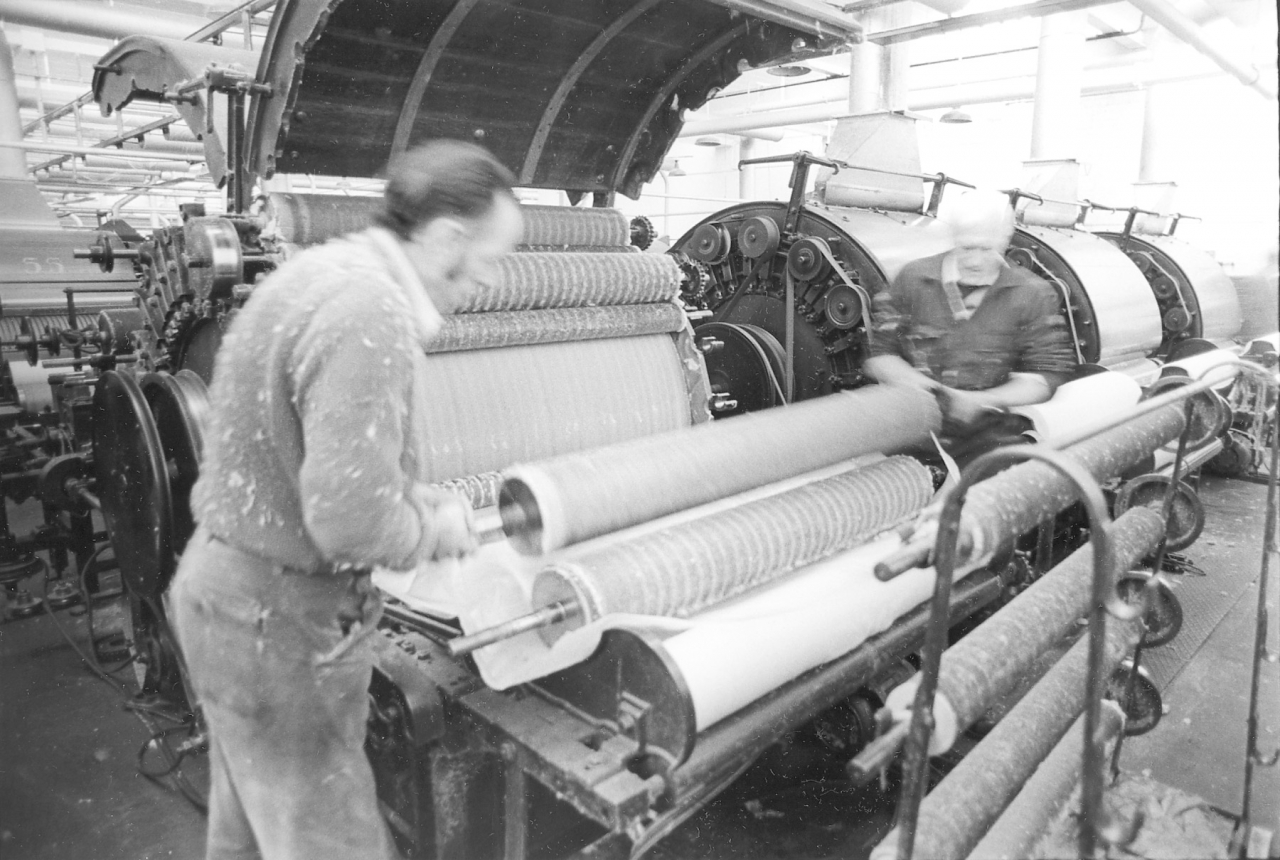
Now, 39.26 you can see they’ve gone to the back of the card now and they are taking them off at the back. You just cover them over with a cloth or something and you rest your rollers on them, it makes it easier to rest them otherwise you ? down like waves on the, thing’s are liable to fall off. And it’s surprising, them shafts there, you only have to drop one and the shaft hits like that and it’ll snap the shaft off and I’ve done that.
And then you were for it!
R- They weren’t too happy with us. We did it twice in one day. One of them were the foreman’s fault, we got hold of one, I had hold of it and he let go so the spikes came down onto my hand and I had to let it go, it hit the floor and it snapped off. And they weren’t pleased with either of us. Specially as they had to go to Higher Mill to get another one because it were one of the funny sized uns.
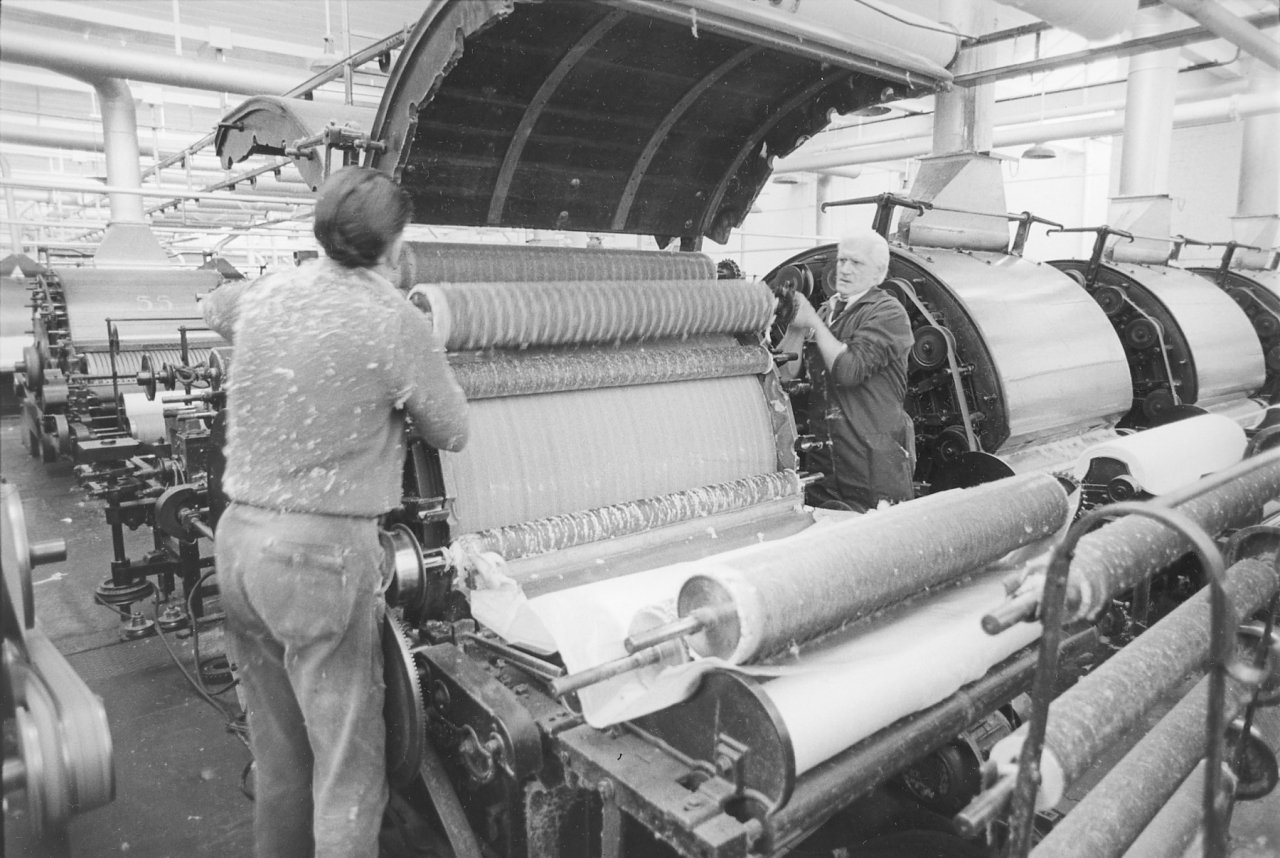
Now then, 39.27. You’ll see ‘em lifting another of the rollers out and putting it on the back of the card. As I say they do ‘em in turn, you’d take the rollers out first, and in fact you can see they’ve got the clearers on the horse at the back there. See, they’re smaller than them, they’re going to take the other clearers that’s on there and then they’ll take them to be ground on the grinding frame.
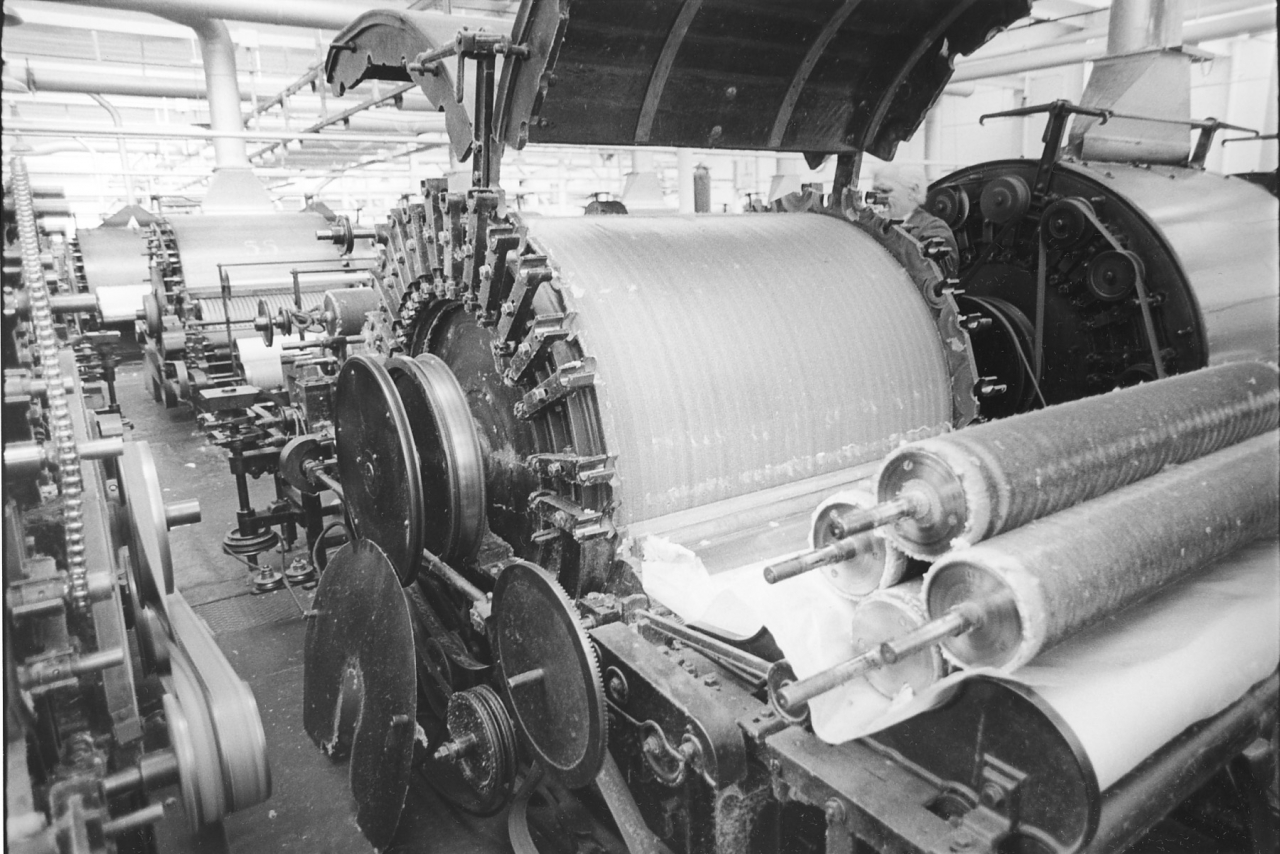
Picture 39.28. Now there you can see the card with them completely off it. ? mention it though, they’ve taken them clearers, it could be that they are going to use that thing I were telling you about for cleaning the cylinder in the next one, do it from the back. I used to do it from the front, it were easier for me. But everyone has their own ways, whatever is easier so somebody else, it might be harder for someone else.
So you do both front and back at the same time?
R- When you are scraping with that, it’s like a scraper, it just scrapes the cotton off. Well, with these rollers they’ve probably left it so as it’s not touching the cylinder. That’s the one, stop doing that it’s going on… (?) Nothing else you can say on that one now.

Now, 39.29. You can see Bill at the side horse there and you can just about see Charlie at the back here with his head there with what we used to call the scraper ready to scrape it off. Now Bill, at this side, turns the cylinder with a wheel, you can see, well you can’t, but you’d see his right hand on the big wheel there. Now you turn the cylinder with that big wheel so the bloke at the back can scrape off.
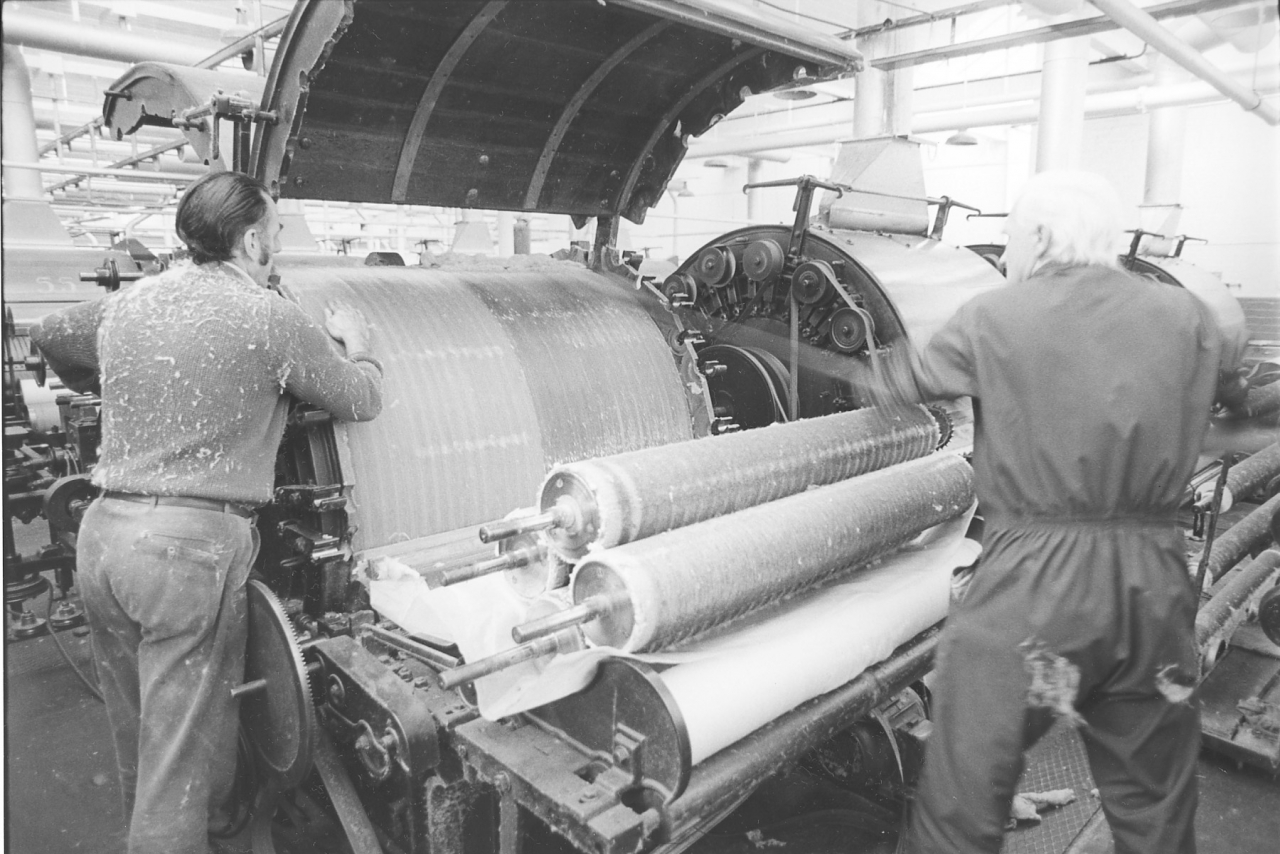
Now 39.30 you’re getting a better view of it. Now Bill’s gone to this side ‘cause he’d sooner push rather than pull. Like when he’s turning the wheel he’d rather push the wheel down than pull it up. Now you can see Charlie, you can see on that side of the cylinder where he’s scraping the cotton off while Billy’s turning it.
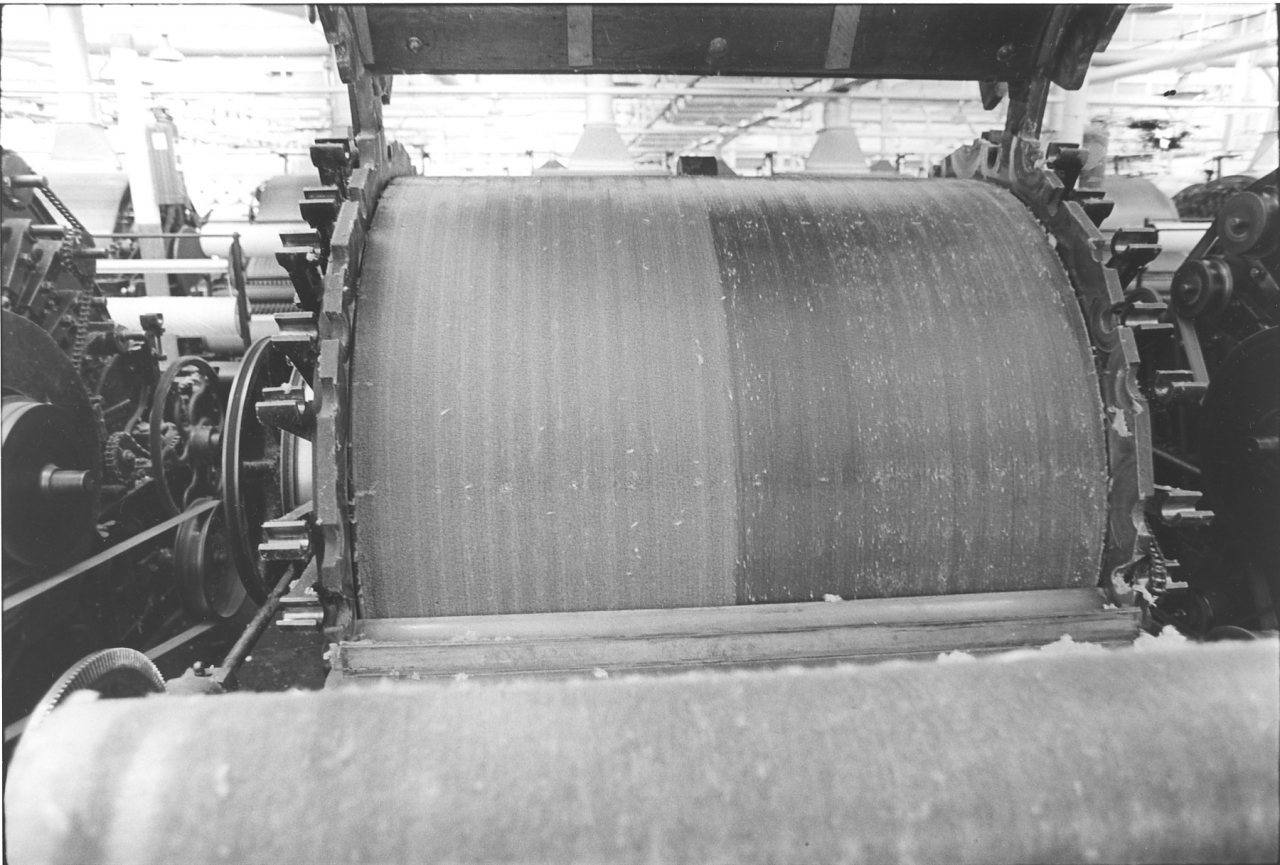
Now 39.31 it shows them stopped while he took that photograph and you can see the difference that just a handscrape will do. But when you got your grinder on the other side doing it, it fetched it really clean.
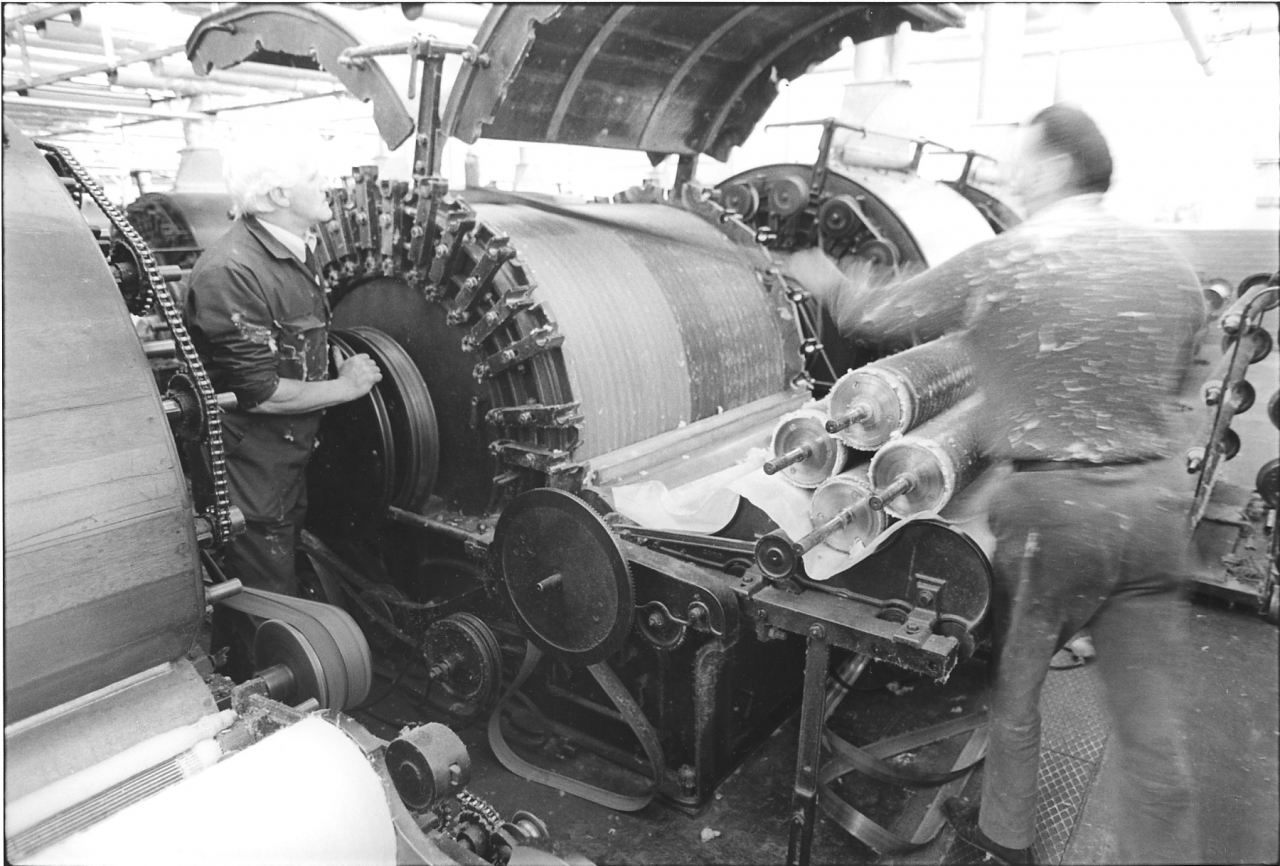
Now, 39.32 you’ll see they’ve swapped places and see that Charlie’d rather do it the other way. (800)(35 min) Now as I say, everybody has their own opinions, whichever way is easier for everybody. As I say, some people like pulling and some people like to push it. Then it’s ? I don’t think you’ve ever seen them doing it.
I haven’t, no.
R- But it’s hard work scraping that stuff off and it’s hard work turning it as well but it’s hard work scraping off and if you’re doing it, I’ve done one or two actually, full ones where by the time you’ve done about three your arms feel like they don’t belong to you. And they are scraping the other side there for you.
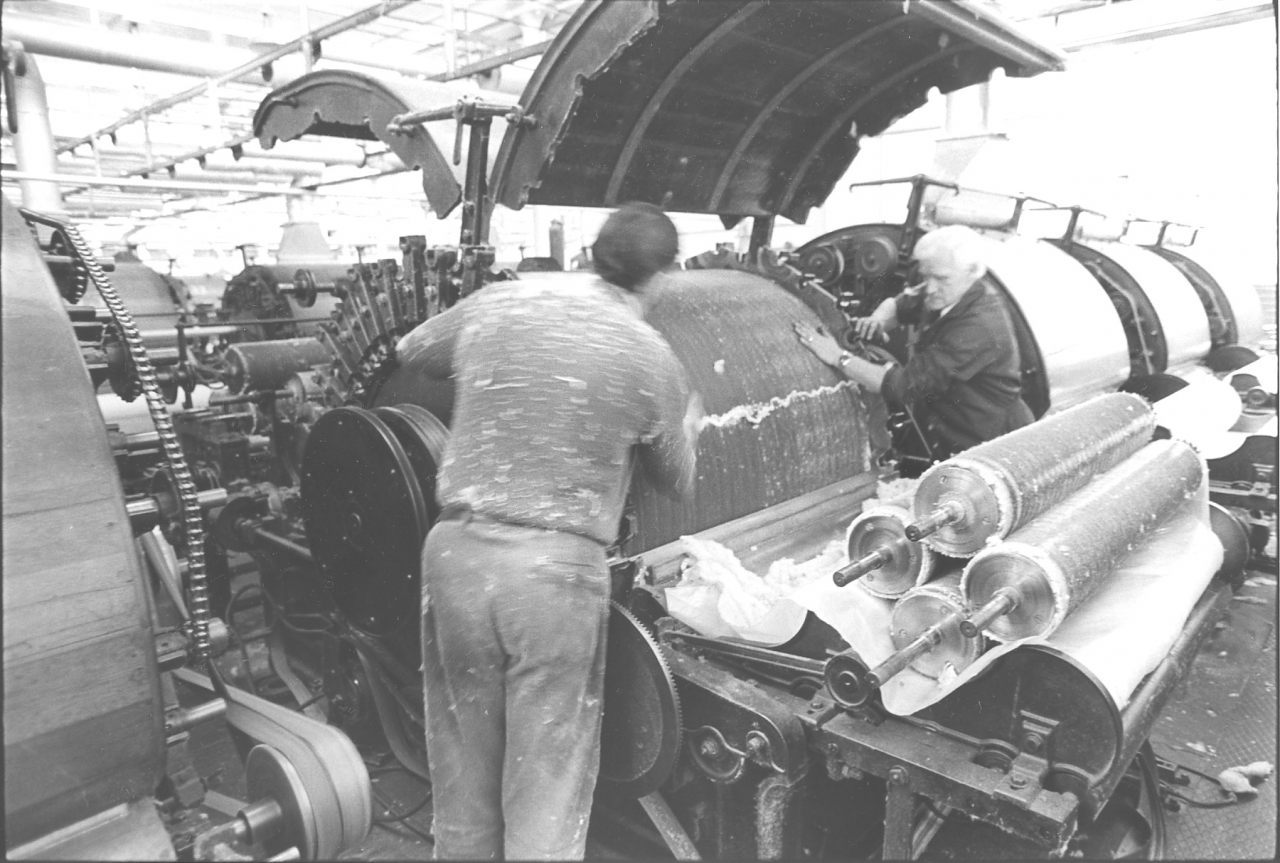
Now on 39.33 you can see they’ve done the whole side now and you can just see a mark where they’ve stopped and there’s cotton in a line across. Well they’ll pull that off before they set on ‘cause it’d only stick under the roller at the front. But I think that what they’re doing there is testing to see how long they’ll have to leave that grinder on, they’re feeling [the card clothing]
By feel?
R- yes, by feel.
And that of course is where the skill in using this sort of machine comes in. The knowledge and the skill of knowing.
R- Yes, and that only comes by practice.
Right. (850)
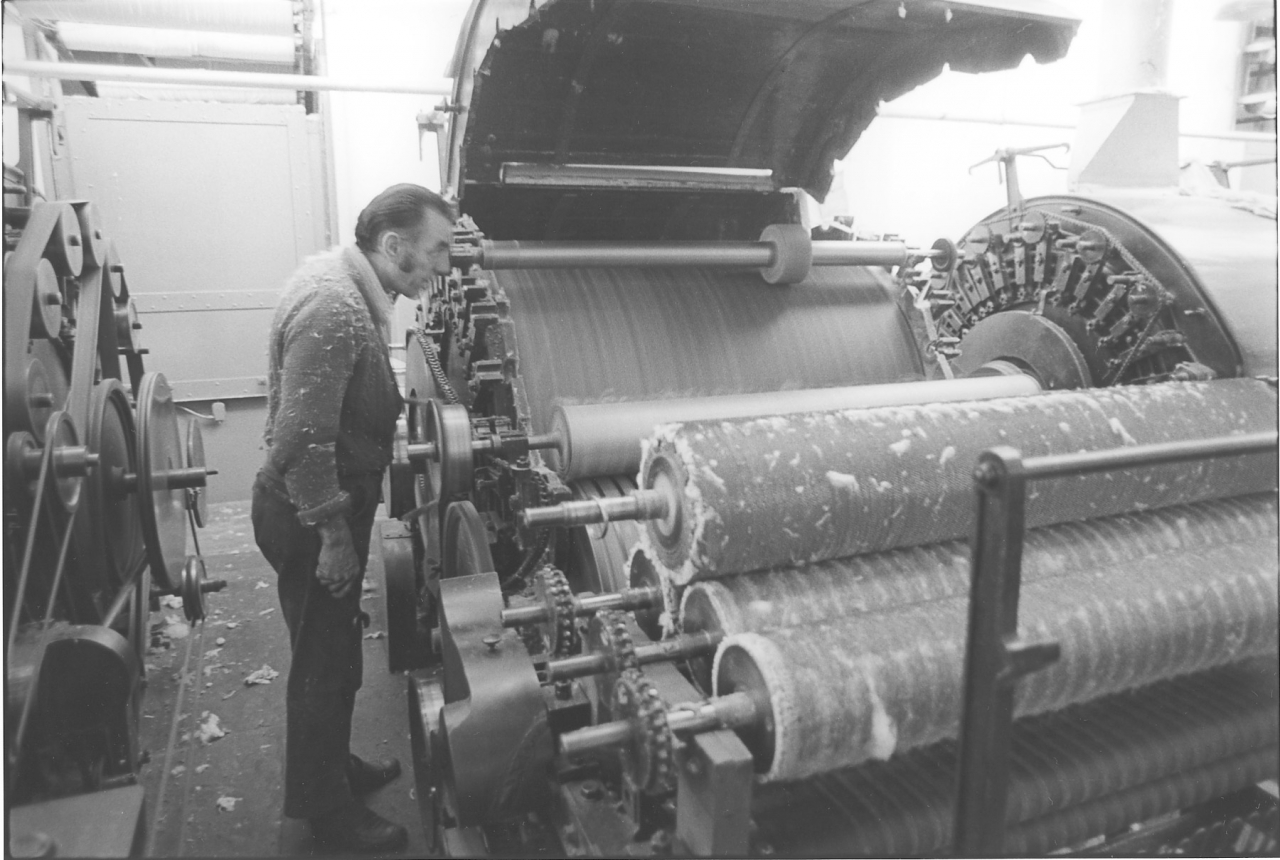
R- Now in 39.34 you can just see, I think, well you can see the speed that that's going at now, that cylinder. It's fairly shifting round. Now in the background on this other one you can just see the brush now that’s going too and that’s cleaning this little doffer as well. In fact you can just about see the dust coming off it, that’d be dirty, there's a big cloud coming up off them.
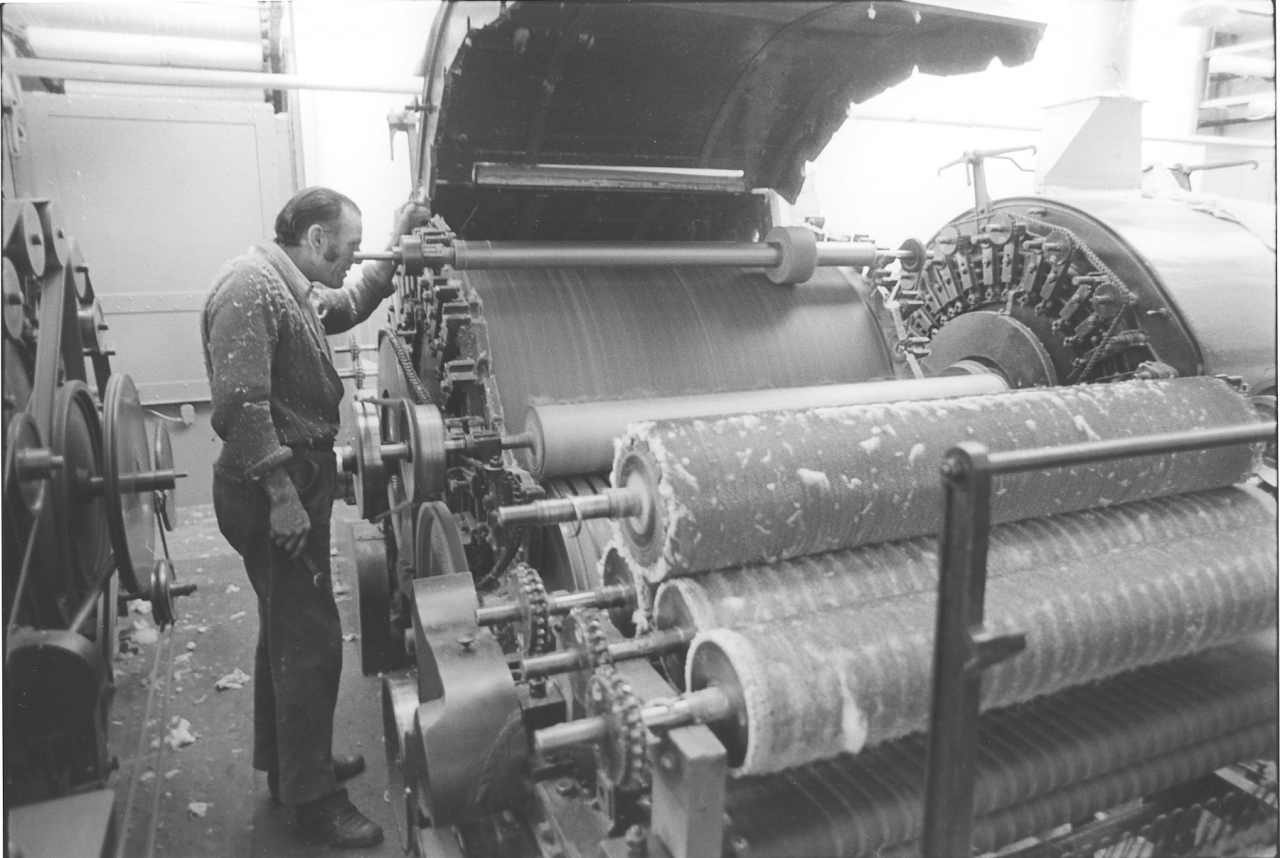
Now on 39.35 I think they, Bill there is checking to make sure that is there level right the way across. Like you set from each end and then you don’t want it hard at one end and up off it at the other end, you’ve got to set it level going across.
And that you do only by sight?
R- No, not normally. You can do. When you first start you do it be that. Like Bill left it to me when I were working with him, you do it by ear.
So is he listening or looking?
R- He is looking there because, before he set it completely right you’ve to see it [running] first. You can see if one end’s lower than the other to a certain degree but once you set it going like your {incomprehensible type] ‘cause you’re setting by one ear. Bill being at one side listening with his ear and Charlie at the other listening with his, well they’ve both got different hearing. So you’ve got to set it with one bloke listening at both ends with the same ear. Otherwise it’s surprising, if you do it with either ear it can be different at each end. They’ve found out with practice, many years ago. You know if you use a different ear it could be uneven and you’d have one half of the card sharp and the other end dull, that doesn’t do either.
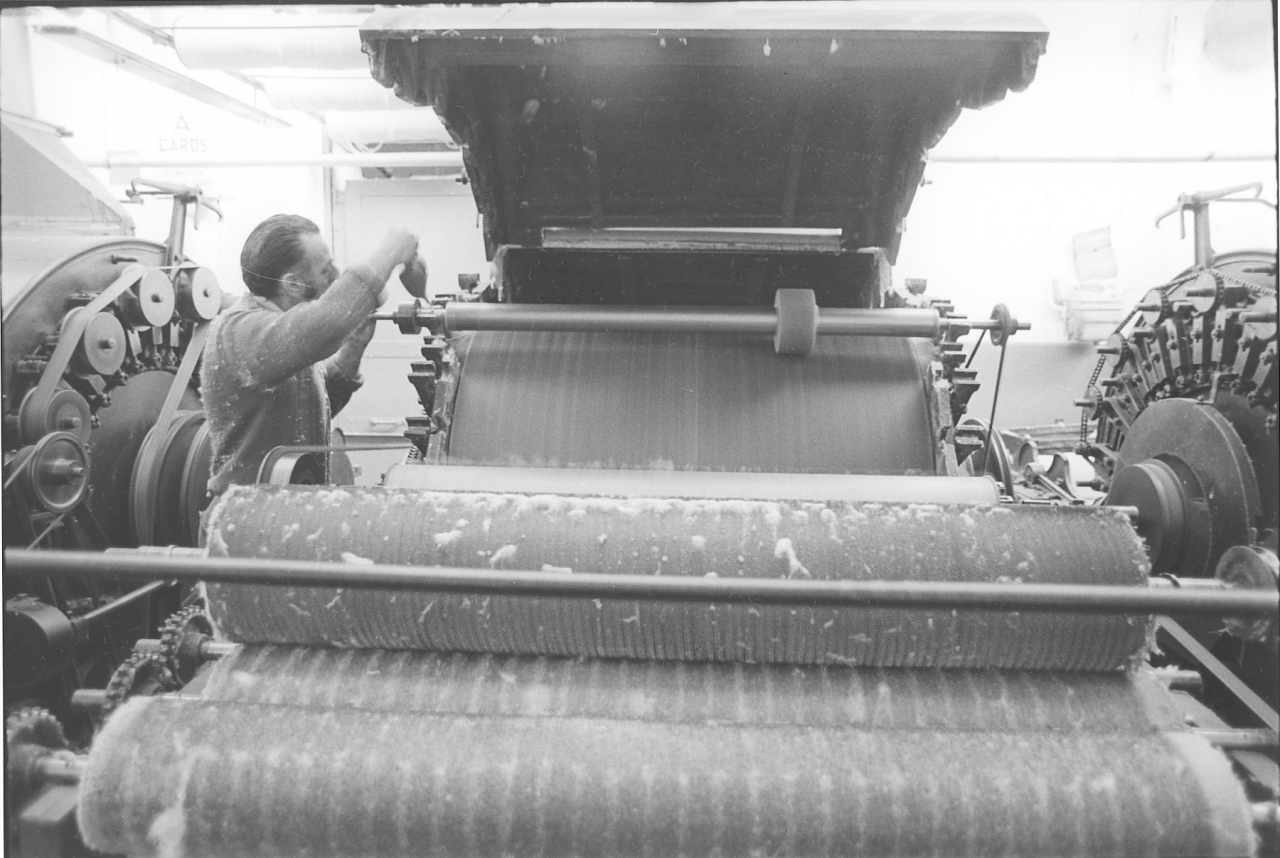
Picture 39.36. Now he is doing the most important job and that's oiling up while it’s running. That’s got to be oiled up every five minutes while it’s running for grinding. It’s liable to get rather warm while it’s running because it’s only running in half a bearing. It doesn’t really have a proper bearing on it, just like a cap and that’s to be kept full of oil while it’s turning in it. (40 min)(900)
How long would you leave that roller on in general? I know it could vary from card to card but…
R- Aye it does vary. And again it varies from how long it’s been since it were ground last.
Well, say every three weeks a card.
R- Normally three quarters of an hour.
Really.
R- You leave them on. If you are lucky you can get away with half an hour.
Does it make a terrible noise?
R- Not a row. It makes a fair bit of noise because the cards themselves make a fair noise but no, nothing excessive.
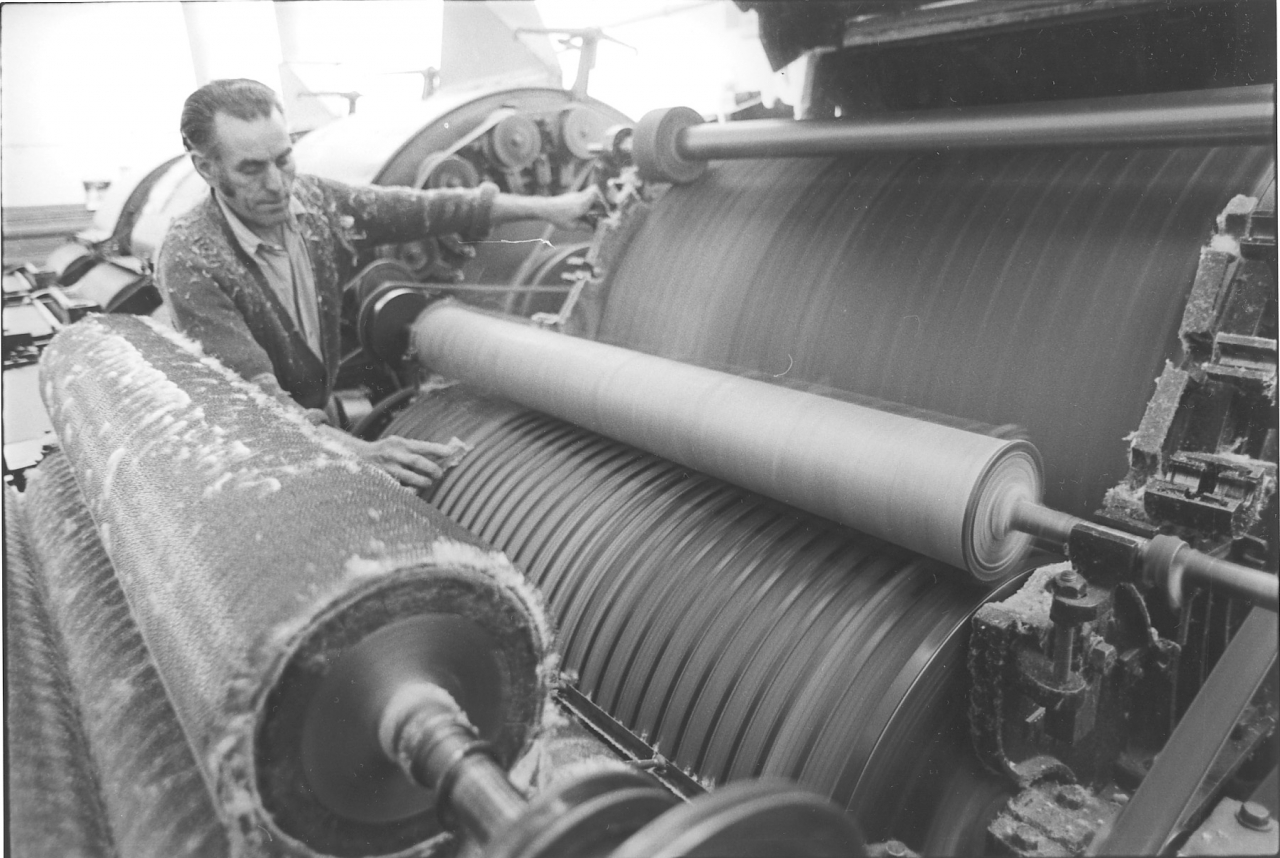
Now in 39.37 you can see Bill and he’s got a small brush and he puts that on in between each, eh, what do we call it?
Groove ?
R- In between each level. Yes, you could call it a groove. In between the leathers, you see the leathers in the…
I see, yes.
R - It just fits in, in between each one. And if you can see where he’s just been, they’re really clean on the left hand side you can see where he has got to. In fact I think he’s done the right hand side and all and he’s gone to, see, you can only go half way along with your arm, then you’ve got to cross over to do the other side.
And he holds that in position while the drum’s turning?
R- Yes, while that is going.
All right as long an you keep hold of the brush?
R And you never do it at the other side. One thing you haven’t got the room to go at the other side of this brush.
Oh I see, right.
R- ‘Cause the other one will take your fingers off.
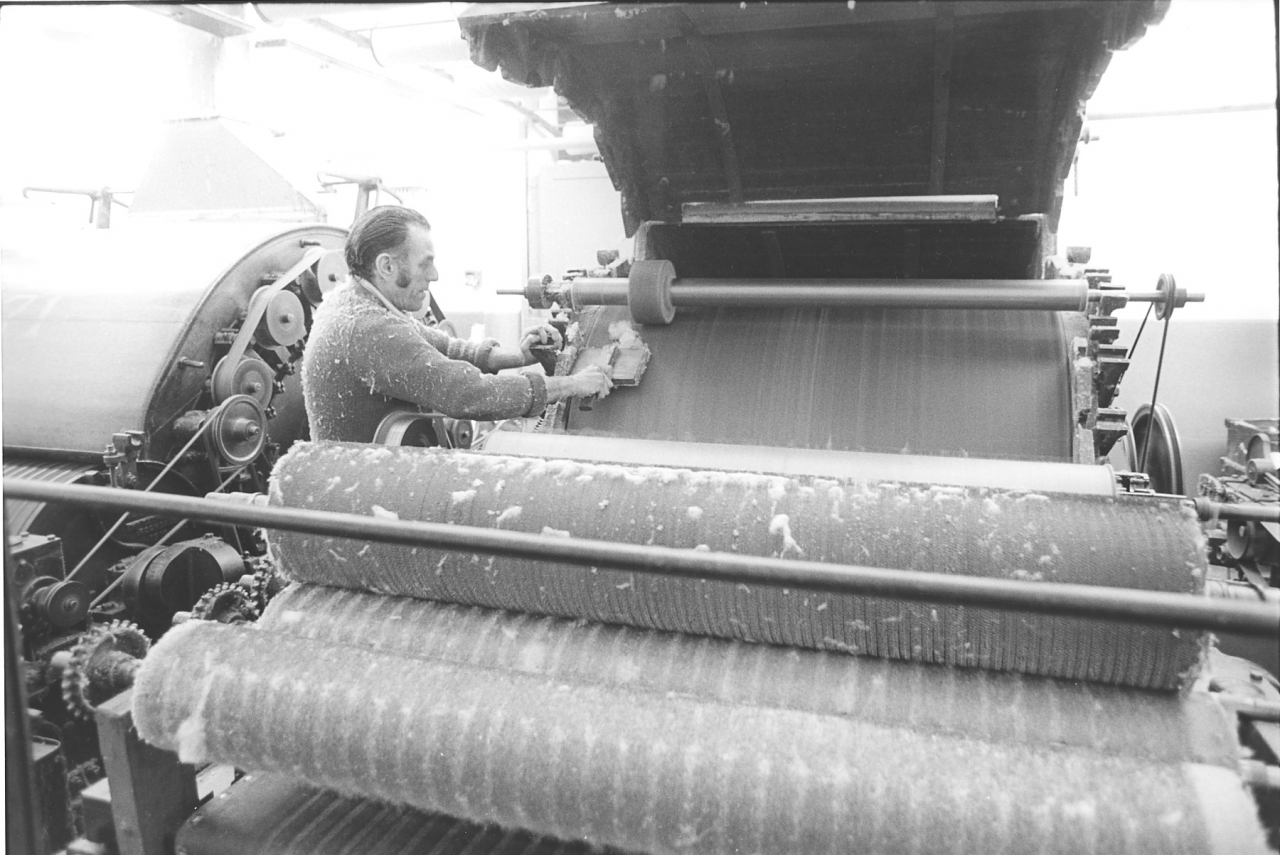
Now 39.38. He’s doing the same now with a wide brush on the big cylinder. He’s, you go right, in fact I think he’s done the right hand side here again. You have to watch with that brush that you don’t press it too hard or it could whip out of your hand and your hand would go onto the cylinder then and you’ll be sorry. You can see there on the right hand side that it’s driven by a rope see? Round your cylinder, when it’s running next the cylinder will have a belt on there, all round your rollers on the other side there’ll be a chain round your clearers.
So that’s the special one they put on for grinding?
R- Yes, just for the grinding job.
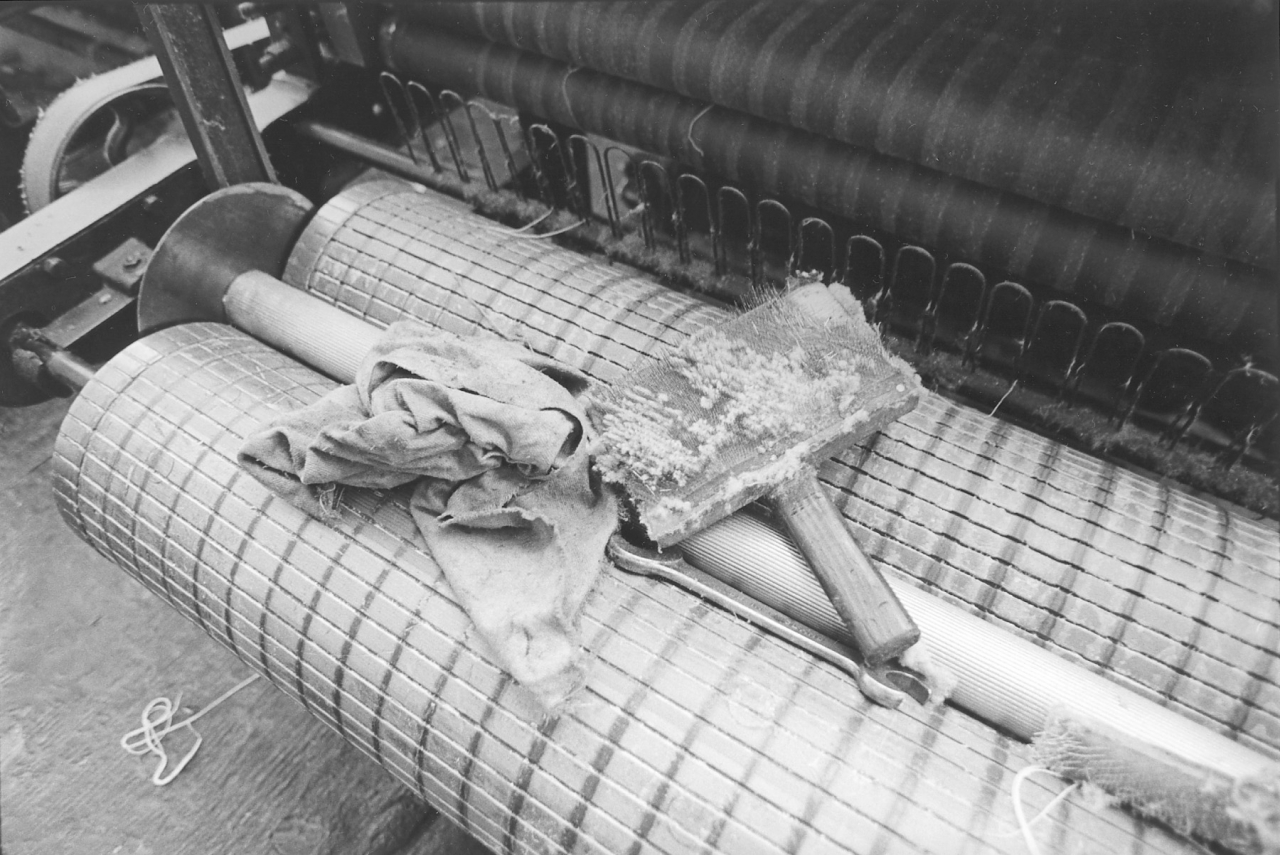
Now then, 39.39 you've got what were called the tools for the job. You’ve got your small brush and your wide brush and your setting spanner and you’ve got a rag there and all. You need to clean down your sides with all the dust that’s been coming up.
This one on the right hand corner is the small one to get in between each leather right?
R- That’s the small brush yes. And your other one’s for your cylinder. Now your spanner there that’s for….

[3938]
You see here on 39.38, do you see in a groove there? Well underneath there, inside there is a nut on each side. Now whichever way you try to wind it up or down with that nut, it either lifts it up or pulls it closer to your cylinder. Well they’re all, or are all supposed to be the same size nut or 99% of them are. You only get the occasional one that’s awkward, they’ve been broken and replaced [with a different size] (950)(45 min)
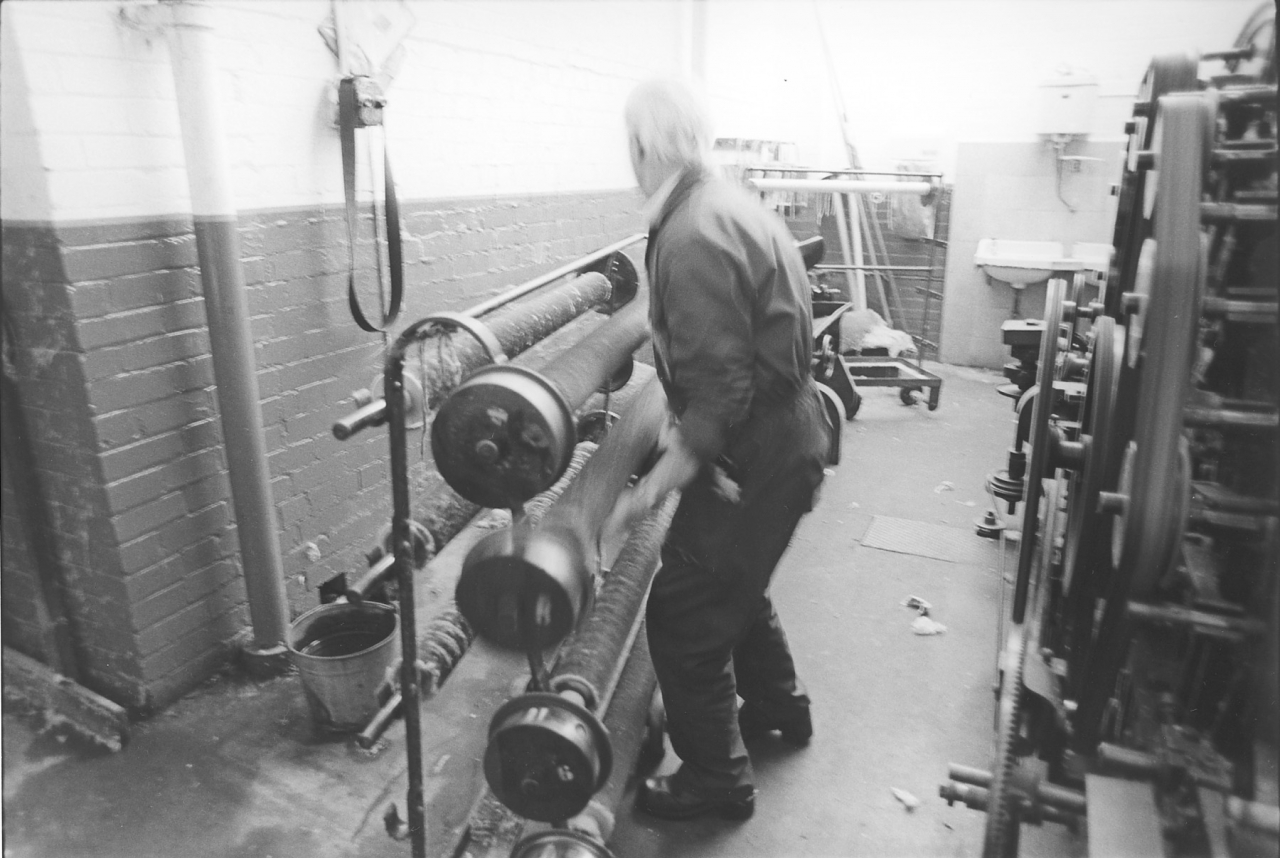
R- 39.40. Now what’s our friend Charlie doing? Oh, he’s lifting one of the clearers off the horse, he’s going to take it to the grinding frame.
He’s not slipping a disc I hope?
R- No, they’re not so bad, it’s the rollers you want to get a lift with, clearers are all right, there’s not much weight in them.
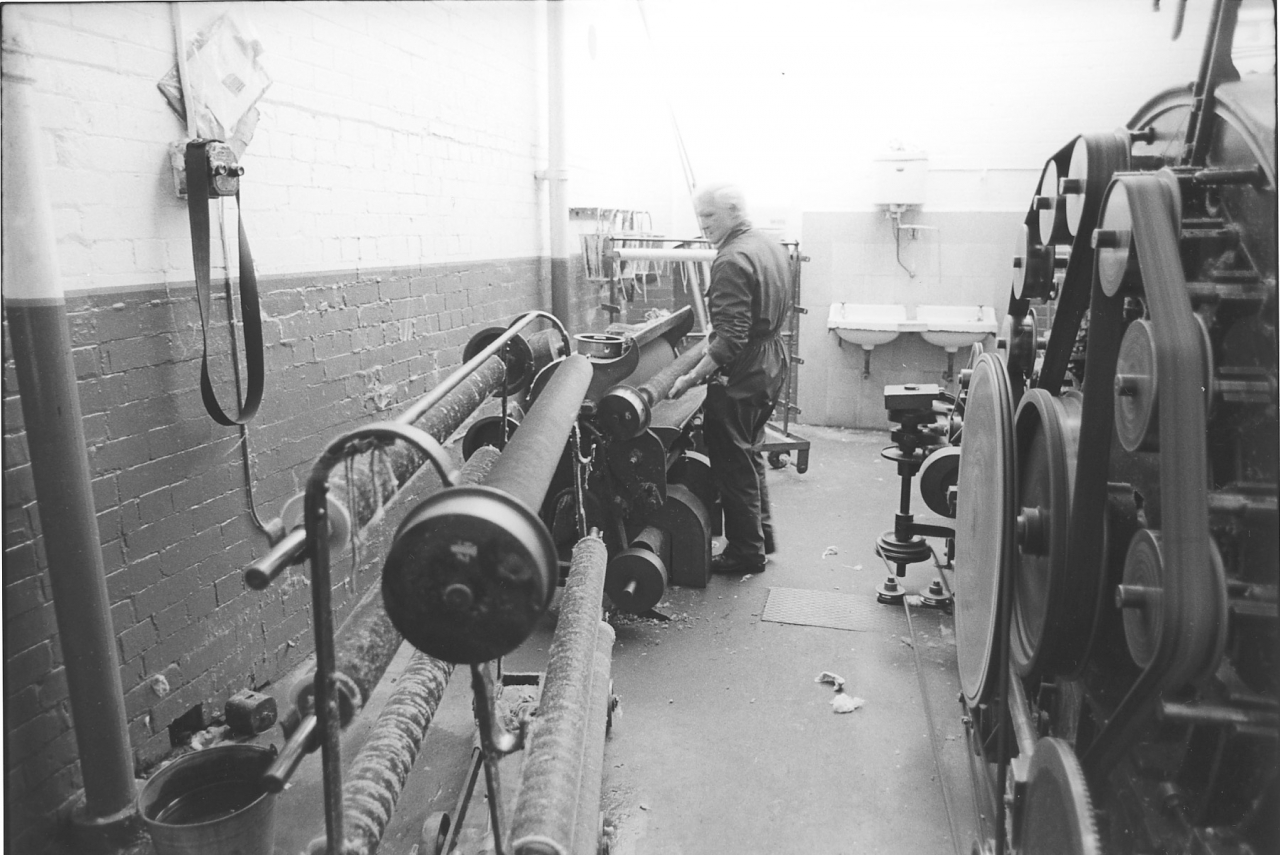
Now in 39.41 you can see him putting it into the grinding frame. Now on the left hand side you’ll see a switch. Now that belongs to that grinder frame. You’ll see there is a belt. Now that belt has to go over the flange on the clearer he is putting into that machine and the wheel at the bottom on the floor runs that. When you are doing your rollers you’ll see that there is a wheel on the top of the lid on that grinding frame, that’ll be fitted on each roller as you’re grinding them otherwise your belt wouldn’t be able to drive it. Now that’s fairly done that one.
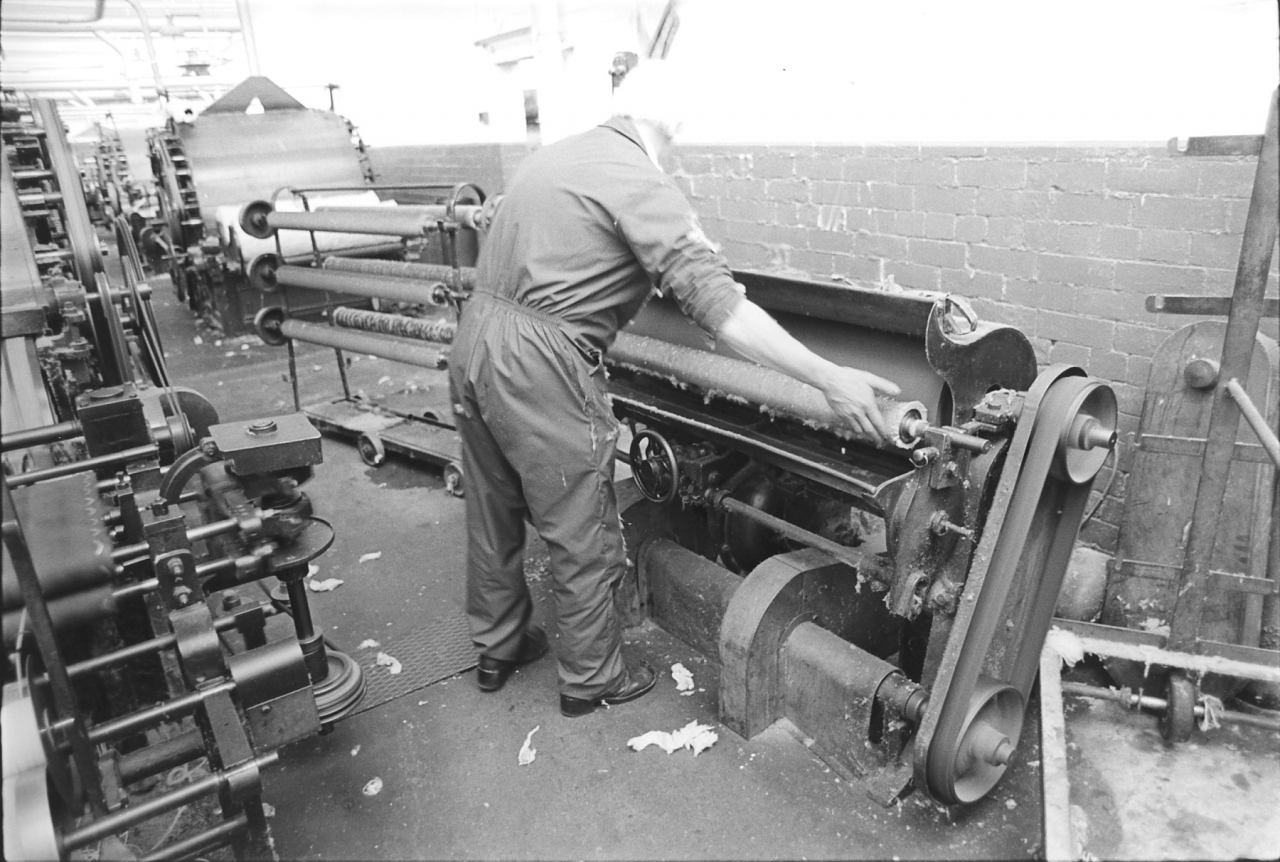
Picture 39.42. Again he is just dropping it into the grinding frame and you’ve got a better shot altogether of your grinding frame there. And that [grinding wheel] is similar to emery paper in texture but it’s steel, but on the same principle of emery paper. Now hang on a second, I were looking at that other photograph, I’m not going to describe something until he’s actually using it, a bit daft.
OK.

R- Now 39.43, you can see him now putting, well it looks like he’s another belt as well, normally he’s one or two belts, I were wondering where the other were. He’s just putting the belt on the, well he’s put it on the flange on the clearer, he’s just putting it on the bottom pulley and he’s getting ready to set the grinding frame on.
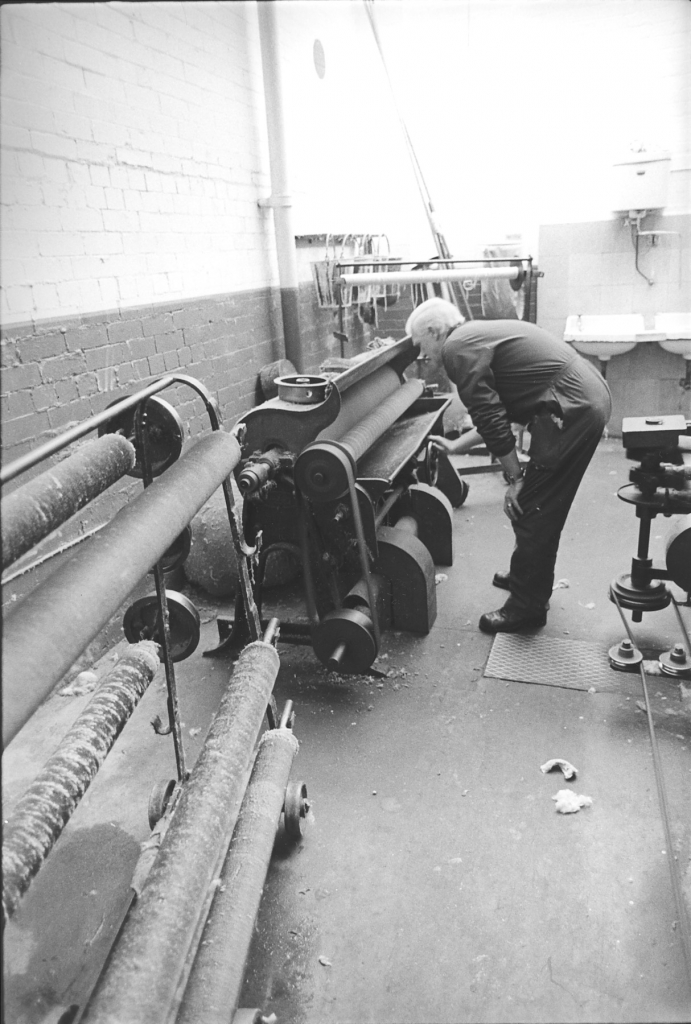
Now in 39.44 he’s set it on , you can just about see you are [running] it’s not a right tight belt. And what he’s holding now, it takes your clearer up to the grinder itself. And that one you do set by ear, you can tell with your ear whether it’s on too hard or too soft.
And can you hear even with all the other cards working around you?
R- Oh aye, you can hear quite well without having to stick your head into it.
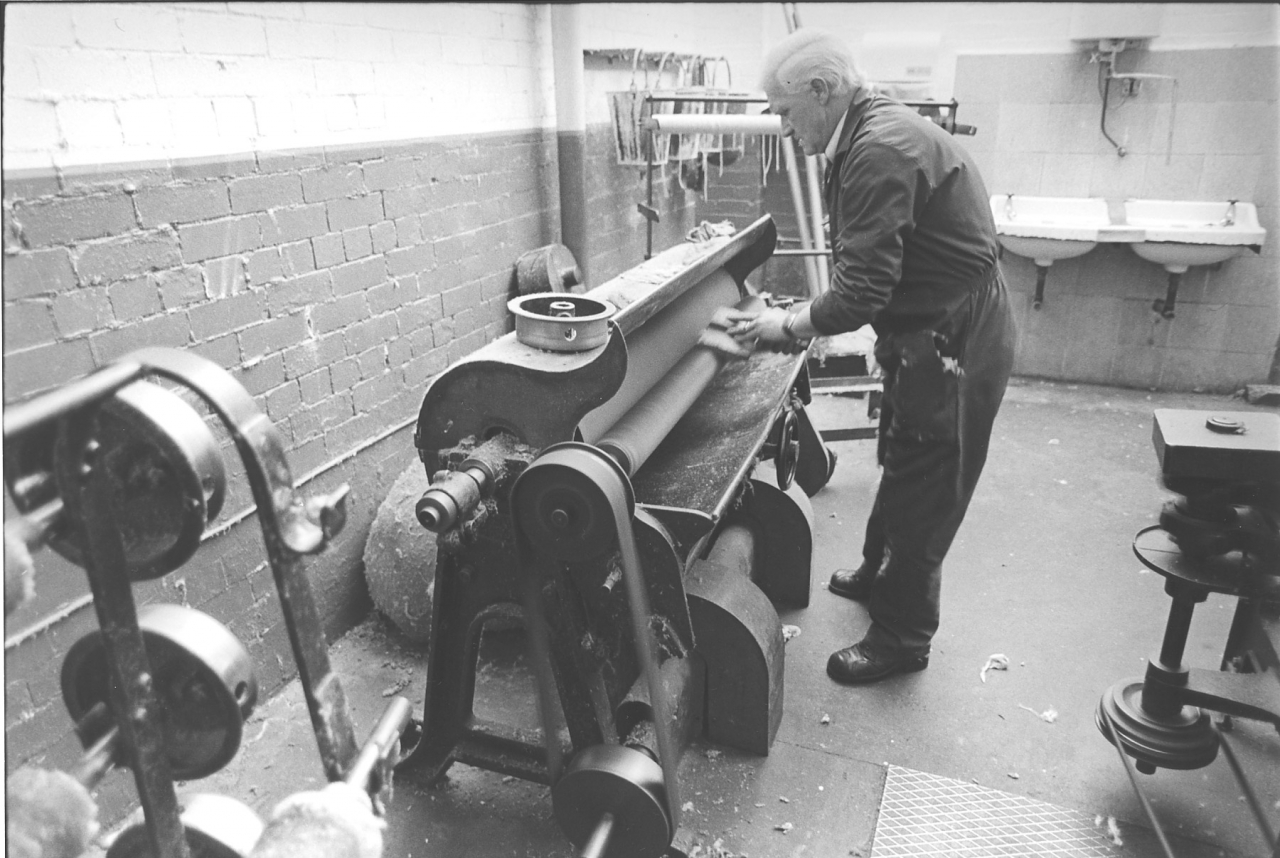
39.45 now, you’ve got the same brush that you used on the cylinder and again, your grinding frame is sharpening that clearer up, what he’s doing now, he’s taking the top cotton, the loose cotton off and you run along it as it’s running again. You don’t press too hard because it’s liable to fling your brush off at you.
The clearers are spiked as well are they?
R- Yes like a fine , eh what the hell do you call it now.
All right, don’t worry, it’ll come to you probably.
R- I’ve forgotten now what you call it. But they are like small teeth through a cloth. [card clothing] And there's hundreds and thousands of them over the cloth on each one.
And can you be doing that while the roller's spinning on the …?
R- Yes. See well, Bill will, well the other bloke will be watching that [the card] while he is doing that.
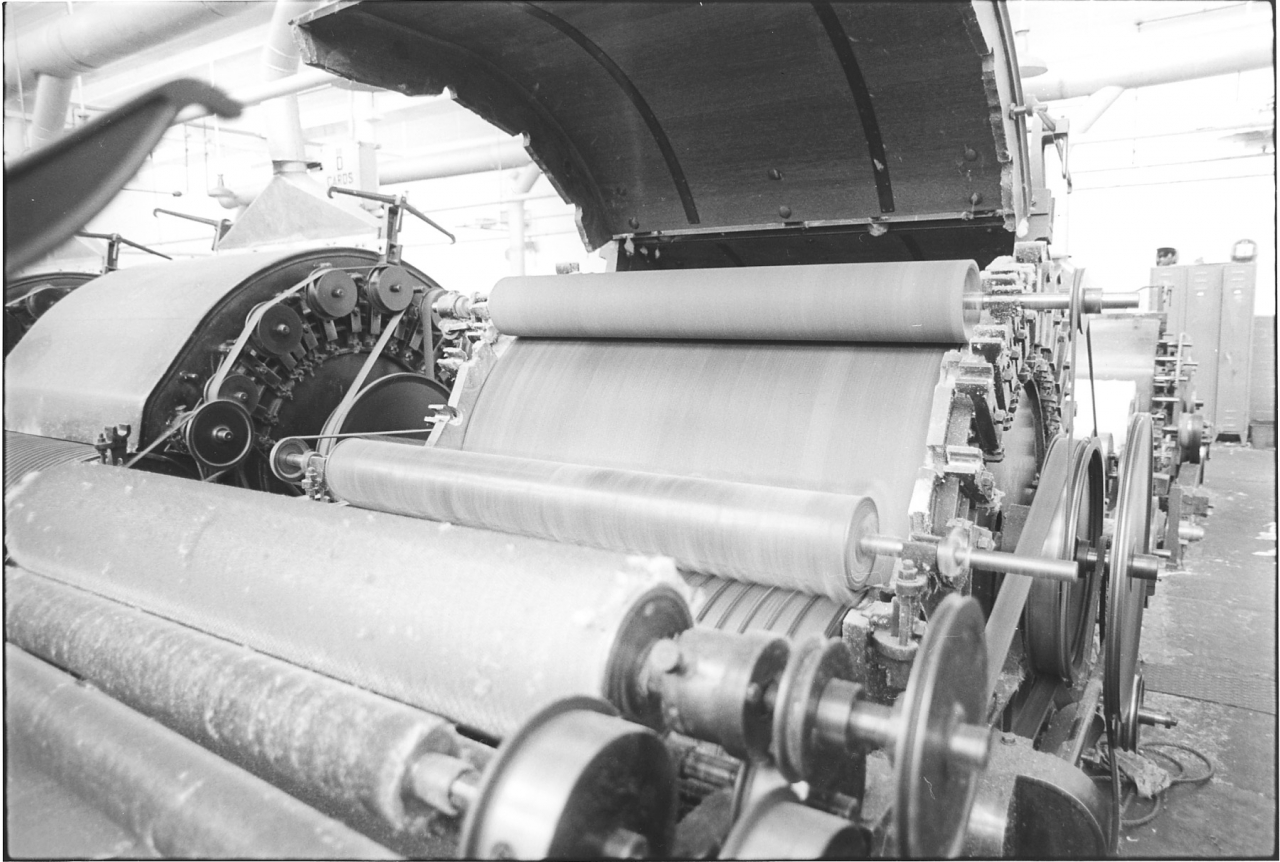
Now, 39.46. Now that one is your, well really that’s just for finishing off like. Like with grinding a knife, you use one side of your stone and then tidy it off with the other side. Well actually it’s the same principle, that tidies off what your small one’s done but it does it so all the lot’s getting the same amount. (50 min)
So it's like the sandpaper is to the plane on wood, it’s the finishing off part/
R- Yes, it’s the finishing off part.

Well again, 39.47 is just a close up, it’s running off the same rope as your small one runs off, that as I say is just to finish the job off. And again, that’s normally only on about a quarter of an hour. Or twenty minutes.
SCG/05 July 2003
7,136 words.
LANCASHIRE TEXTILE PROJECT
TAPE 80/SHJ/07
THIS TAPE HAS BEEN RECORDED ON MAY 26TH 1980 AT 119 BURY ROAD, HASLINGDEN. THE INFORMANT IS ROLAND TAYLOR, JUMBO OPERATOR AT SPRING VALE MILL. THE INTERVIEWER IS MARY HUNTER.
Right Roland.

R- Now, in 39.48 you can see they are just starting to put the rollers back in. As I say they have a special order of going back in.
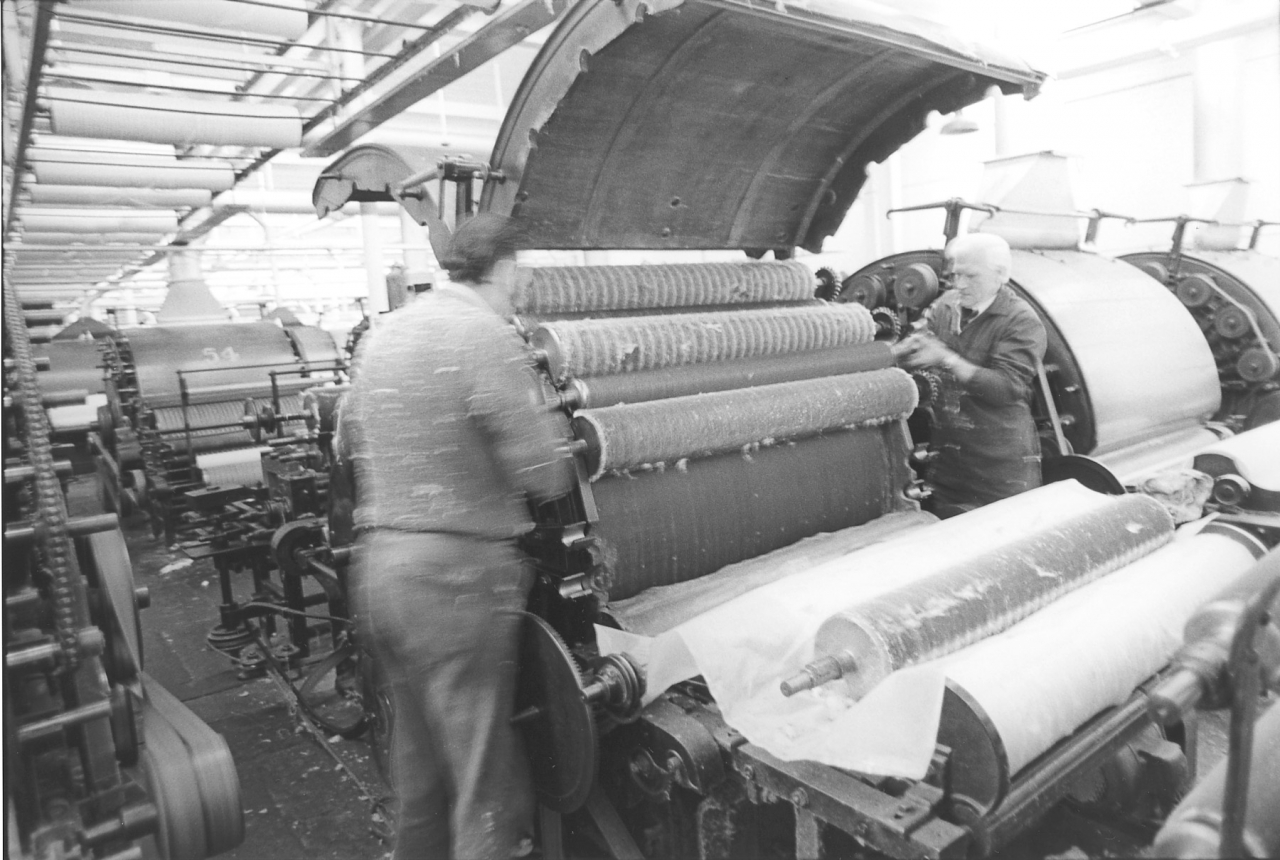
Now, in 39.49 you’ll see they're putting a small one in before they’ve actually put the big one back in, one at the back side, one or two of the clearers have to go in before the big uns go back in otherwise they won’t go in, the big uns has to go lay across the back of it. And that again, if you look at the face of the lifters, they are not the easiest things to put in like. More than once you can get your fingers trapped in the …, I can't think of the name for ‘em. Like in the brackets that they actually go in, if you’re not careful and you don’t get your fingers out at the right time , the end of the shaft can drop on your fingers.
I’m sure yes.
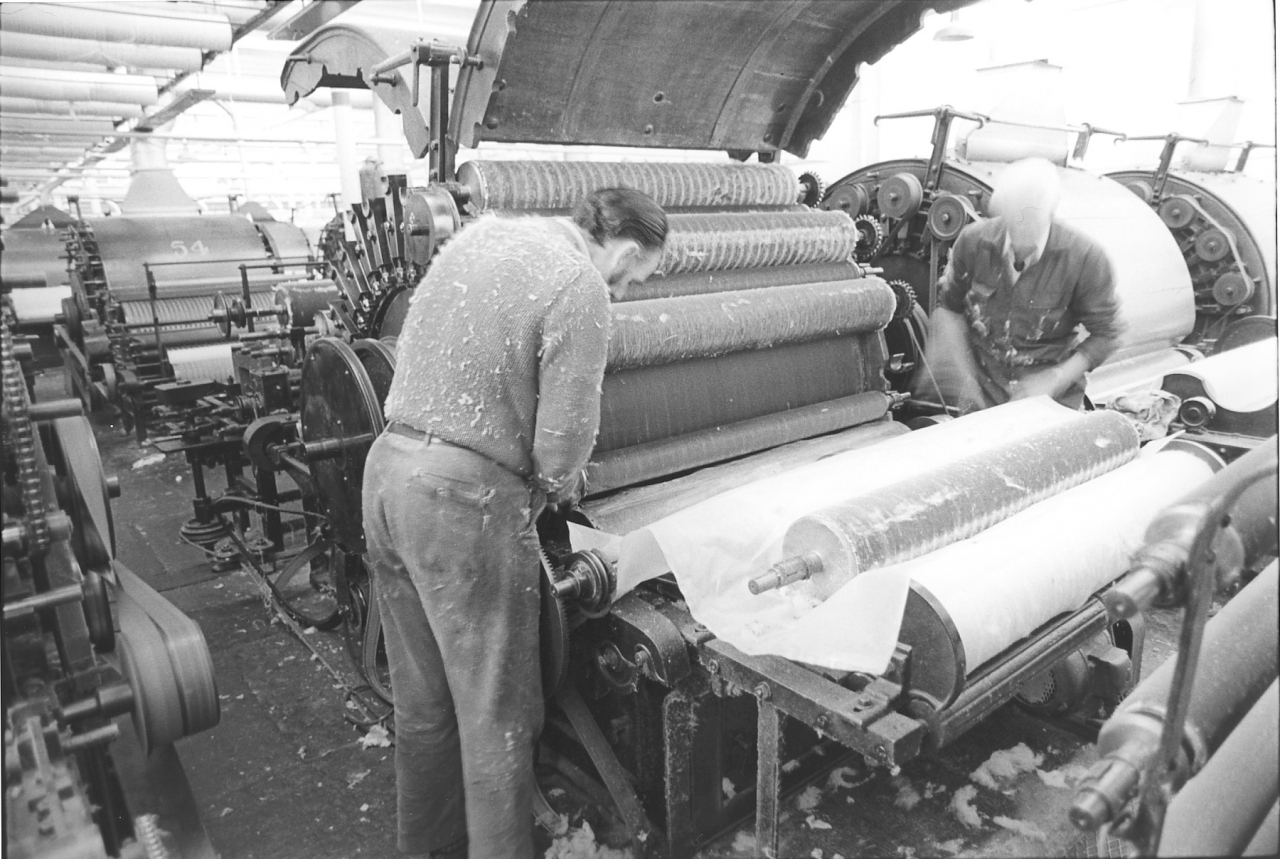
R- And you shout. Picture 39.50. Looks like they’re just putting that bottom clearer back in there. He’s missed one or two picture with looking at that. And they're putting the, there’s a cover and he didn’t, they didn’t show that in them photographs, that's the cover you take off at the back and all it shows is you taking the front one off and he hasn't shown them taking the back one off. There's a cover there and all that screws over the top up there. They call it the licker-in at the back. Now that, it’s all steel, jagged spikes on there, and I don't mean just teeth, they are thick steel ones, and I’m not joking, that will literally take your hand off. I know because I know a bloke lives up there, had it done at ? , took his hand right off. And that was through them not having a guard on so they had to find him a job. He had a job for life, he is mighty powerful in that one arm he's got though.
Just to go off the subject for a minute, do you know someone who lives in Haslingden, whose got no hands at all?
R- No hands? I know one bloke who, in fact Brian knows him right well, he's called Roy, he only has one hand, he lost his right hand through, on a job in the card room.
Yes, because there is someone at Whitaker’s Social Club who plays snooker and he’s got [both arms off at the elbow]
[I feel confident to make this insertion because the bloke in question beat me at snooker. He lost both forearms in a set of calendar rollers at the paper mill.]
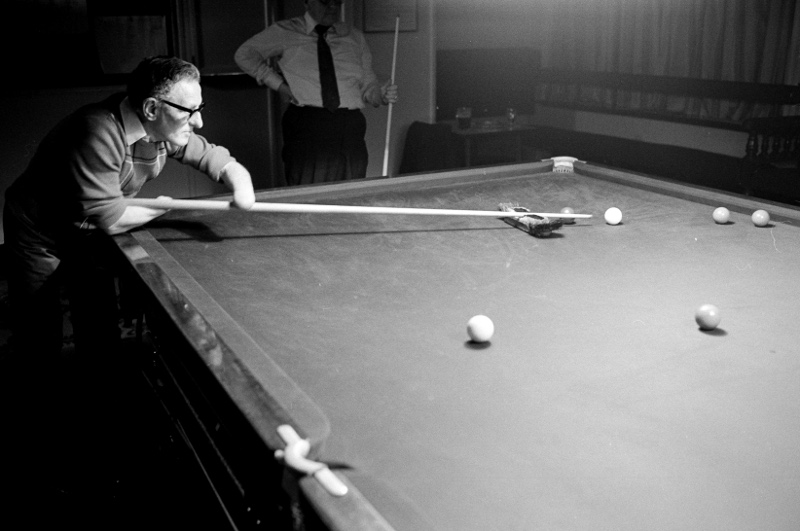
This man was playing snooker in the Sunnybank Social Club when we were there. He had lost both hands at the wrist in an accident with calendar rollers at work. He was an excellent snooker player.
R - Oh, I know who you mean now. No I don't, well I know him to say hello to and that but I don't actually know him to talk to but he's been at that club for years on end. He were there when I were at Porritt’s and I can remember ...
He’s an amazing fellow isn’t he.
R - 'Cause he knocked me out at snooker.
Did he?
R- Aye. Or rather I knocked meself out against him I played like a twit against him, I had to go to last for losing it. ‘Cause I was well in front of him, I should never have let him catch me. Trying to be clever though, it doesn't do. Now then, as I say they're just putting the cover over the licker-in there.
And what’s the job of the licker in?
R - Well that’s really in to break it up before it starts going on your cylinder. It really rips it apart does the licker-in, that's what I say, you get your hand on there and you’ve no hand any more if it's going in.
And which one is that again? Or can't you see it?
R- You can't see there, 'cause they've just put the cover on it again. The cover’s on it there, but it's not fastened down. I mean he hasn’t got one with it right off.
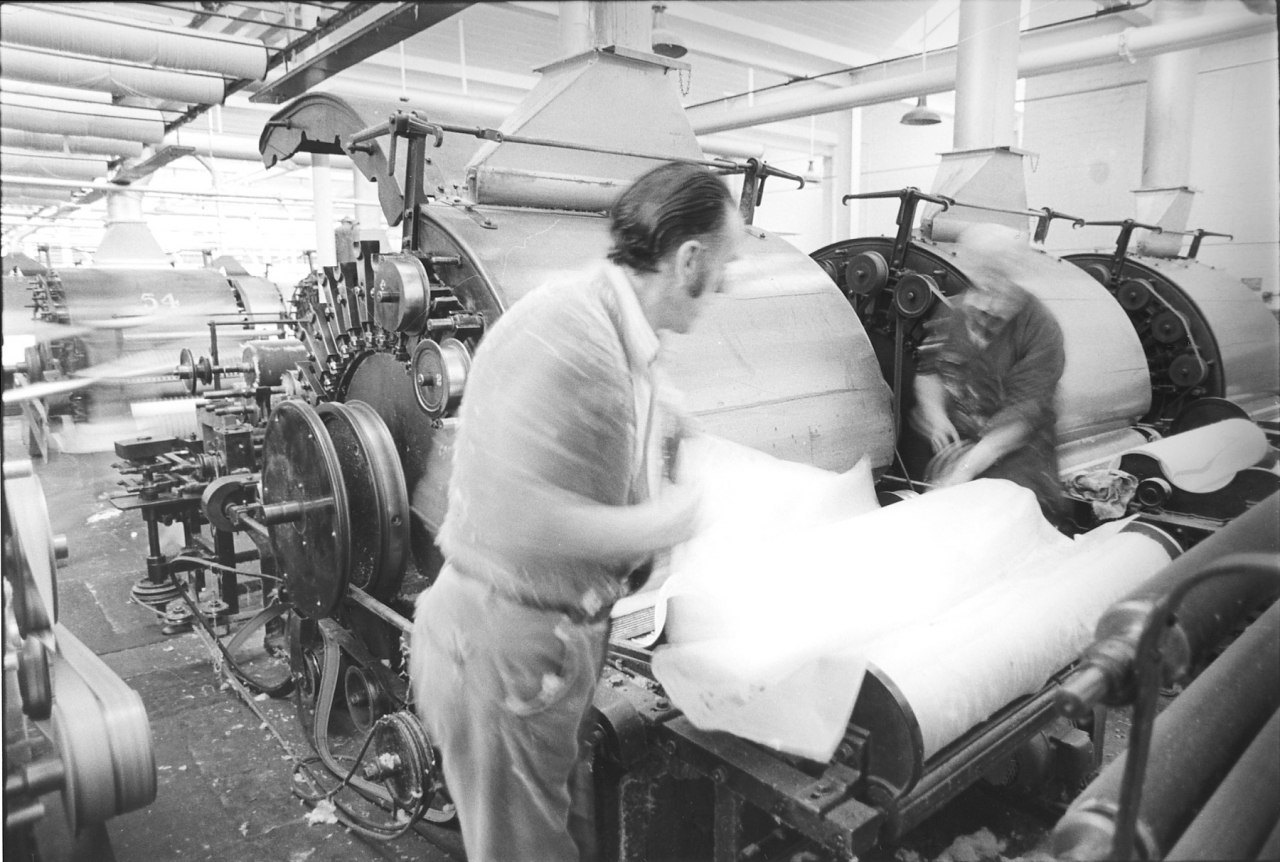
Now 39.51 you can see they've finished putting your rollers and clearers in and they've dropped the cover down at the back. Now they're taking the cloth off the back, I think they're getting ready to wind it in there.
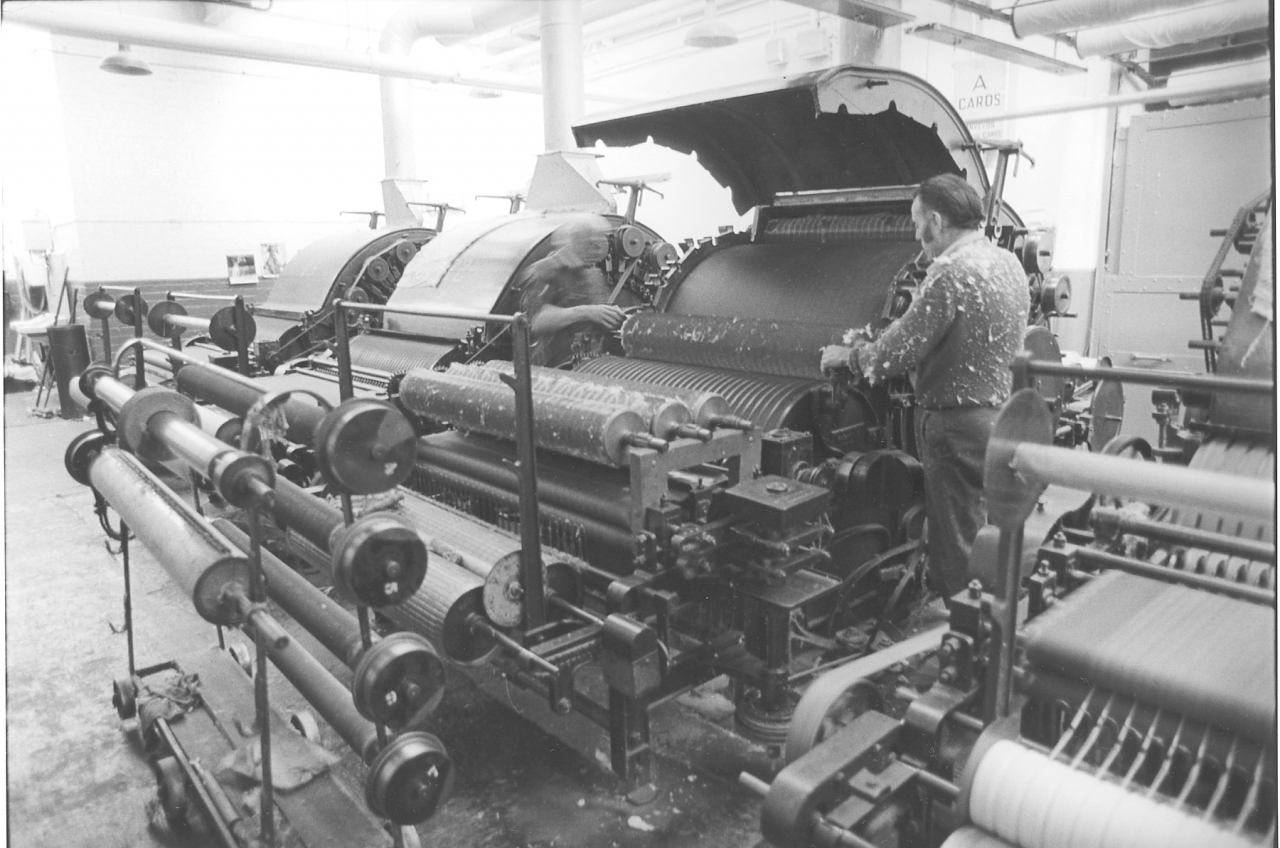
Now they've come round in 39.52 to the front, to replace the ones at the front end. And where are we? Yes, I think they're just putting them all back there.
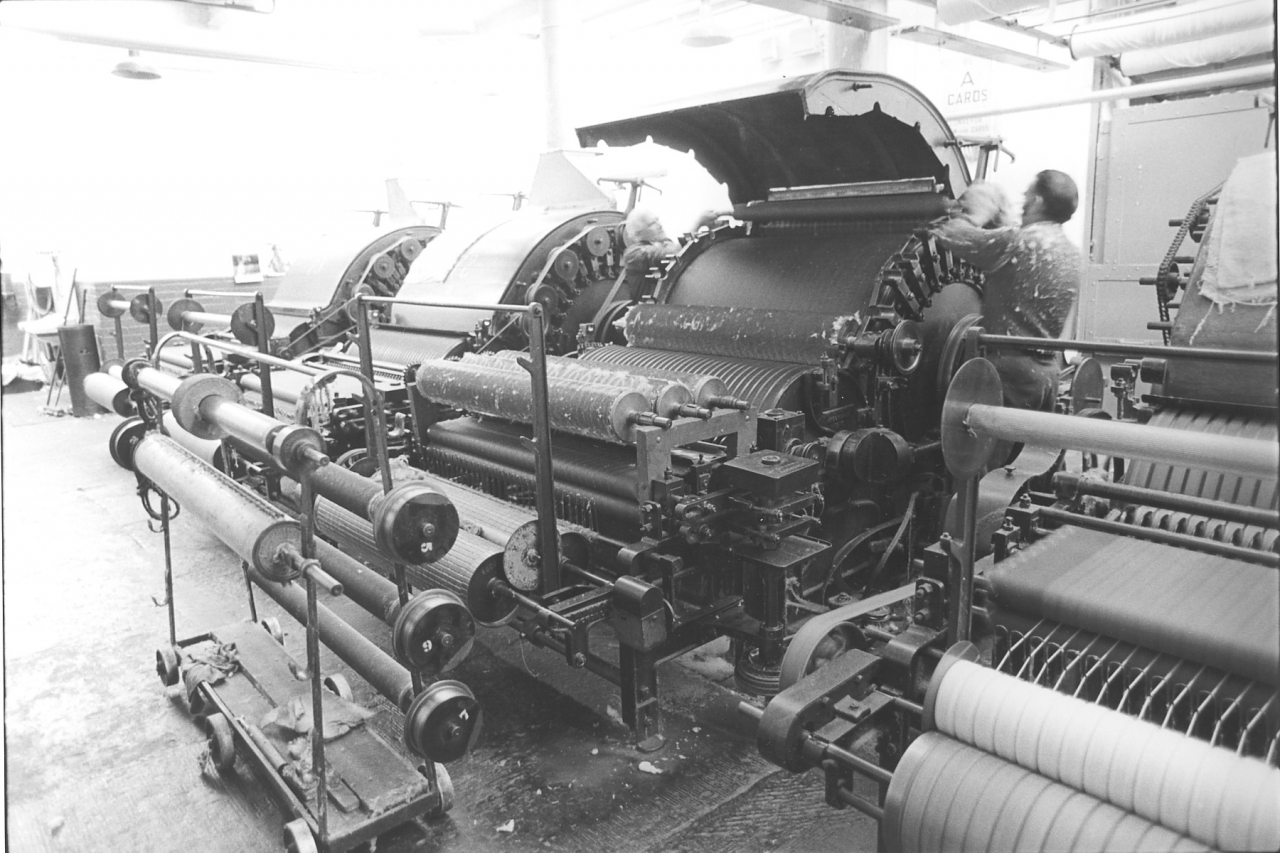
And 39.53 they are starting with the rollers at the top and the clearers and working down again. And if you notice on the horse they've already put the things back on there, the small sharpener and the brush, they've put them back on the horse already. (5 min)
This, the one roller that's sort of in the middle between the two big cylinders, it looks still a bit dirty with cotton.
R- Ah well, that is all right is that, it's only like, really like a brush. It's metal and that but it's only really for brushing, really, excess dust off and that. And it only picks the occasional cotton, you never clean them really. In fact the most you shall ever see on them is about that much.
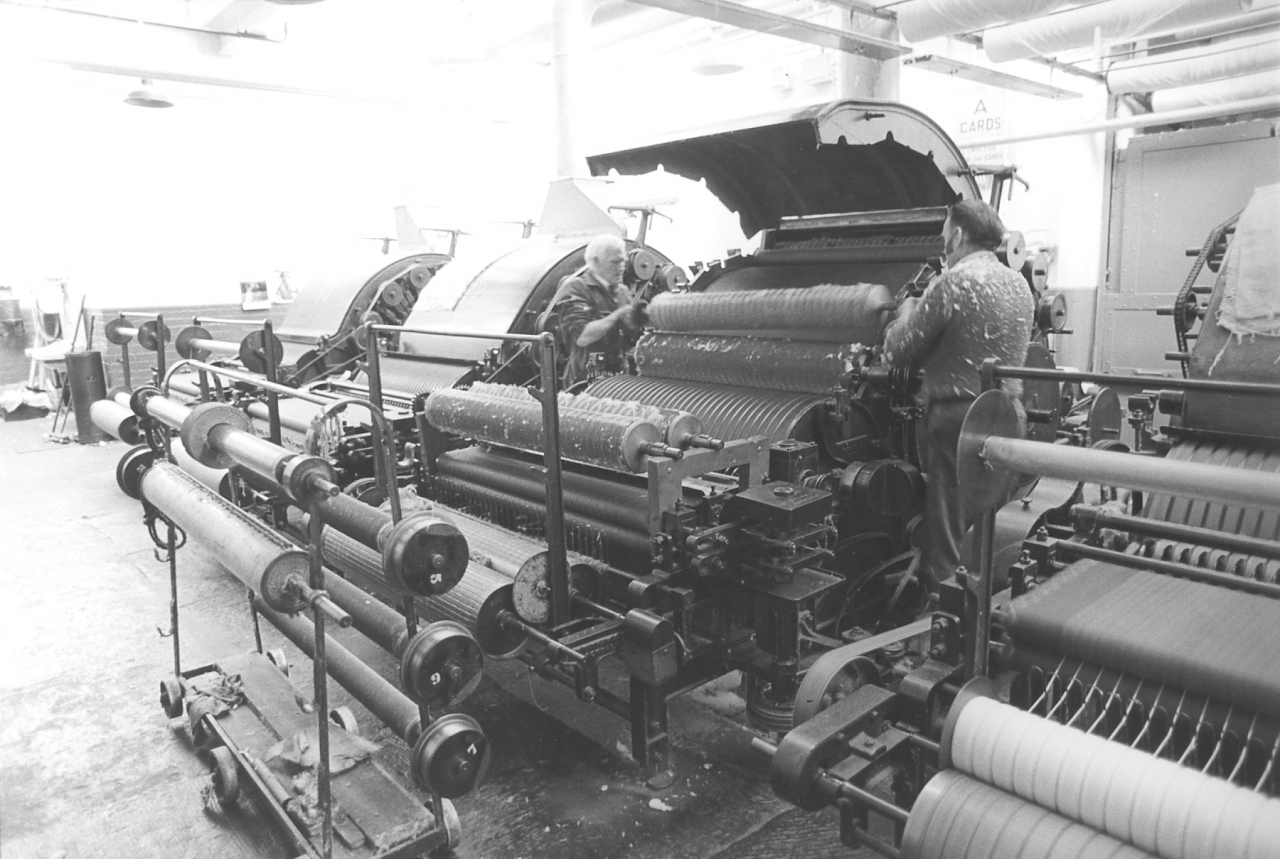
Now in 39.54 you can see ‘em again putting the rollers back, slow but sure. Again if you look at Charlie’s face it's not light. Really on that one Bill's slightly taller than Charlie so Charlie’s really getting all the weight. That's why Charlie, if you notice, his end's going in first 'cause he is getting the weight so Bill’s put his in last.
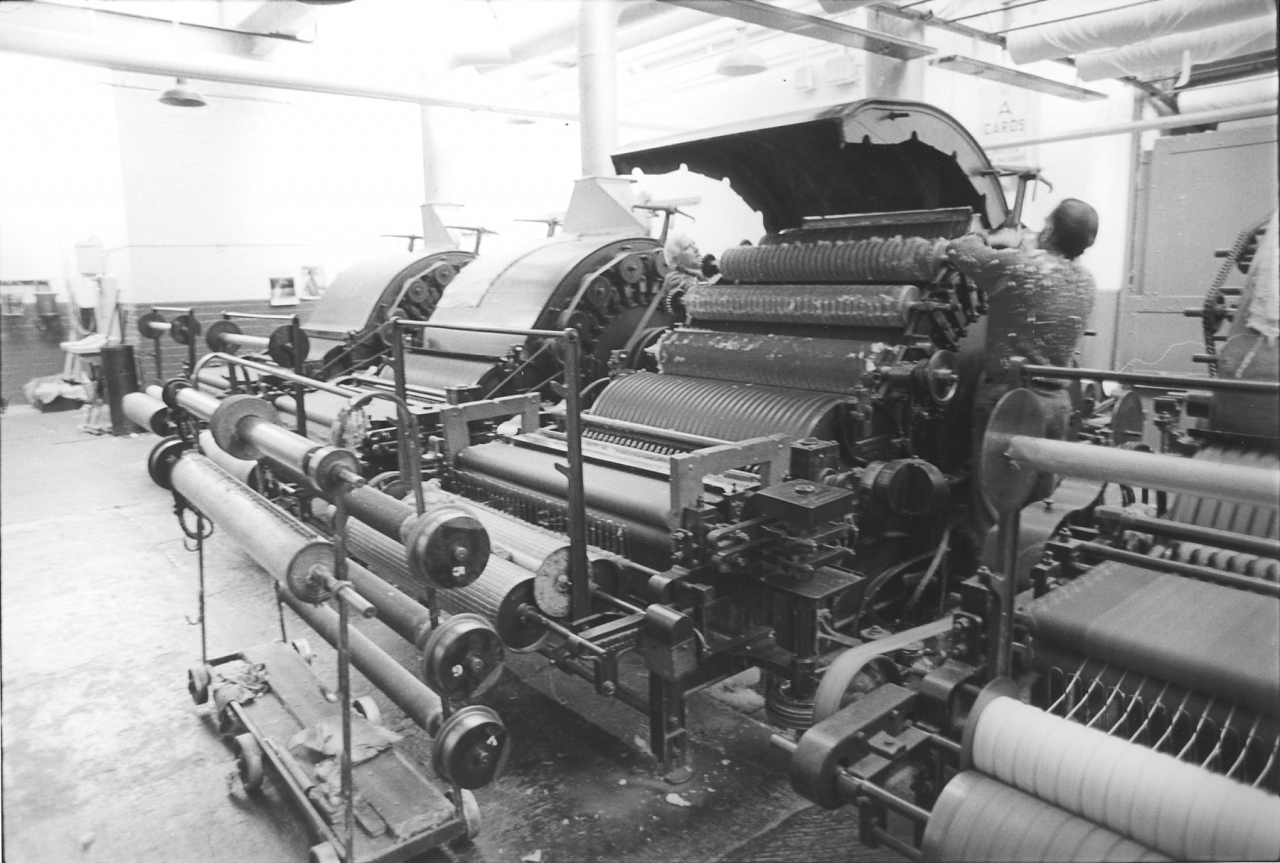
And 39.55, now that's the hardest one for them because nearly everybody has to stretch to reach to the top on them. Anyway I wonder if Bill, no he hasn't .. Bill used to have a box that he could stand on so he could get up easier, but I think with him being a bit taller than Charlie he wouldn't be using it. I know one or two that have had boxes they can stand on to make it easier to get up on to that top there, you are really stretching your arms up to it.
Charlie Gowers would need to have a little box wouldn’t he for that purpose?
R- Charlie has got one, but it's very rare he does any grinding now, and I mean being carder he can tell the rest to do it.
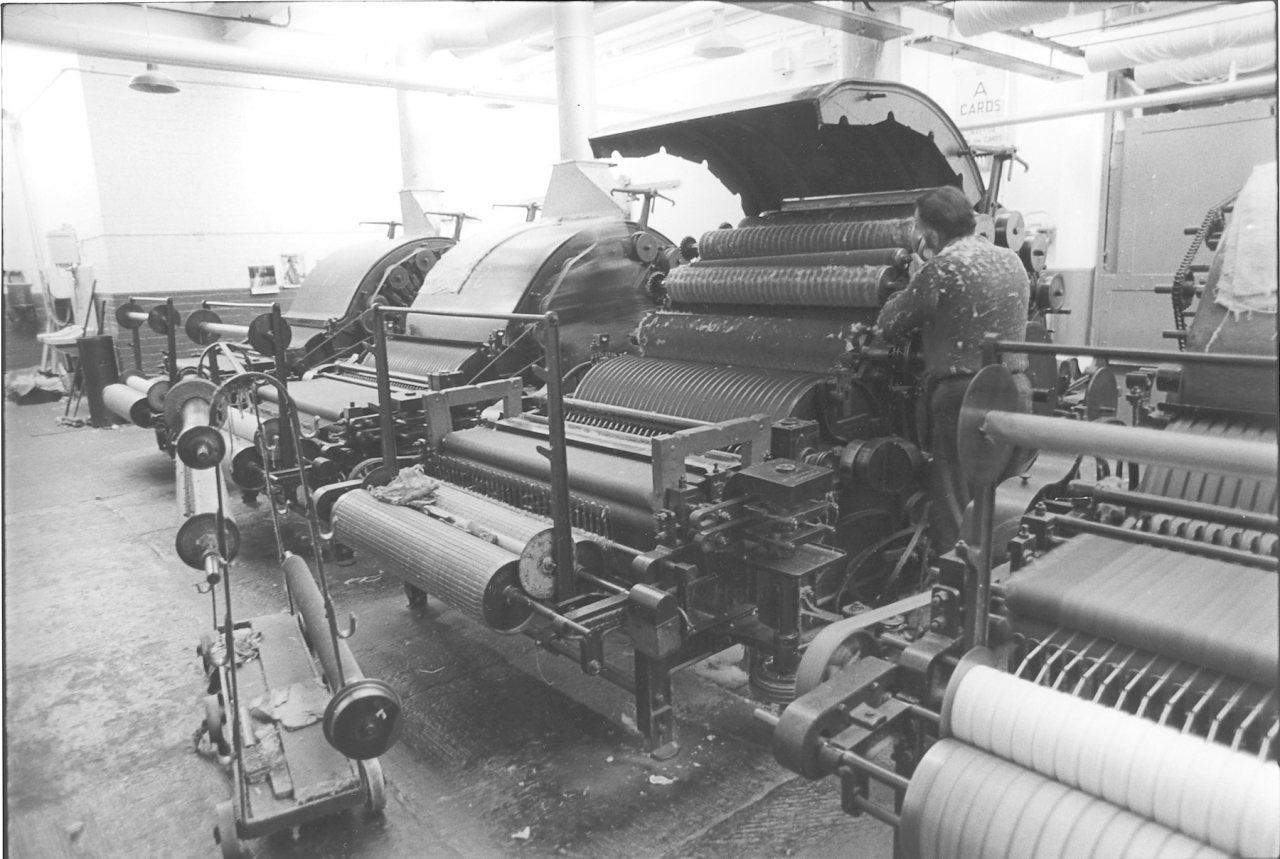
Now 39.56 it looks like they are putting the last one in. I wonder it Charlie is supposed to be there. I think he blurred it a wee bit. And I think they are just putting the last clearer in there, not the big one, it's a small one what they're putting in. No they have another one more still. Oh no, that’s the top one, that one that’s on the horse now will go right on the top there.
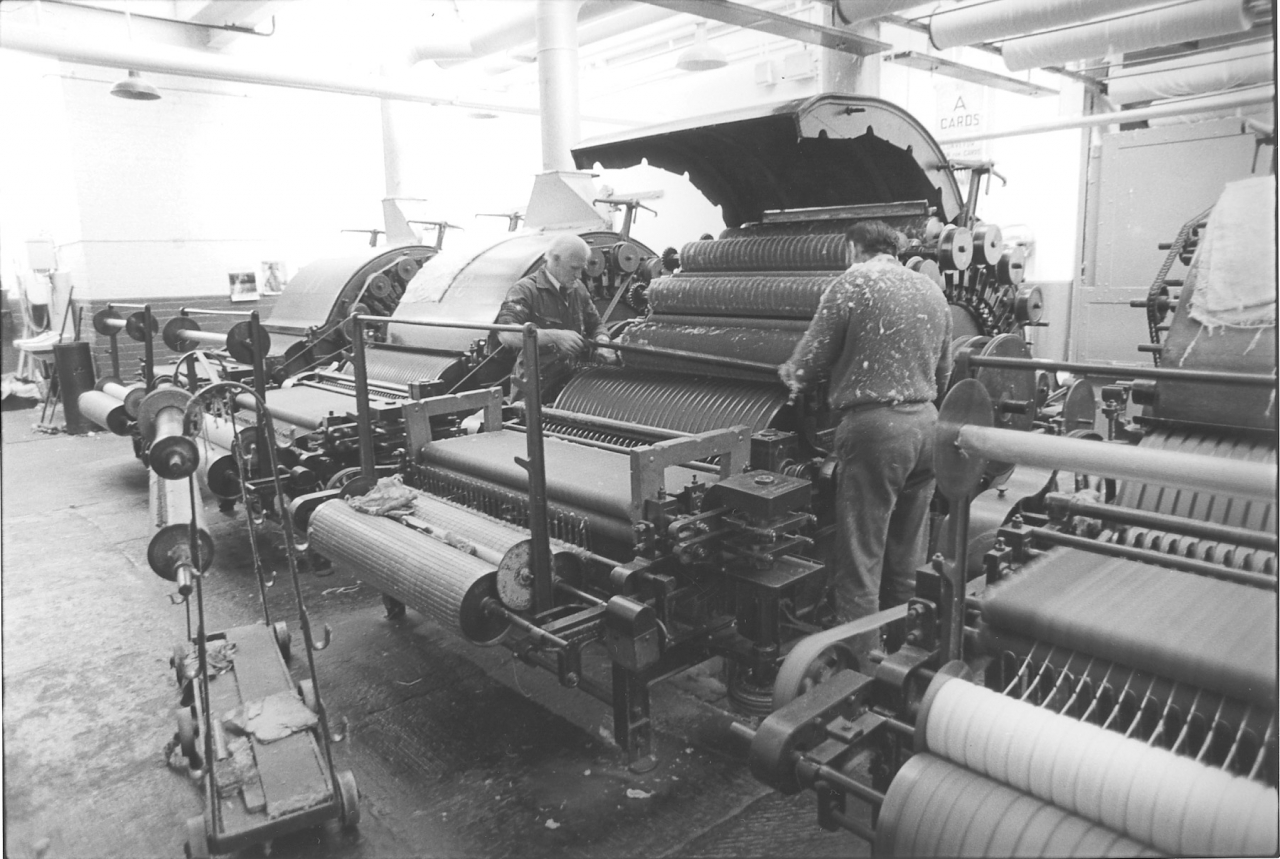
You see on 39.57 they're replacing that guard we saw them taking off in the first place.
Yes (200)
R- Well they're replacing that now, which is next to the last job.
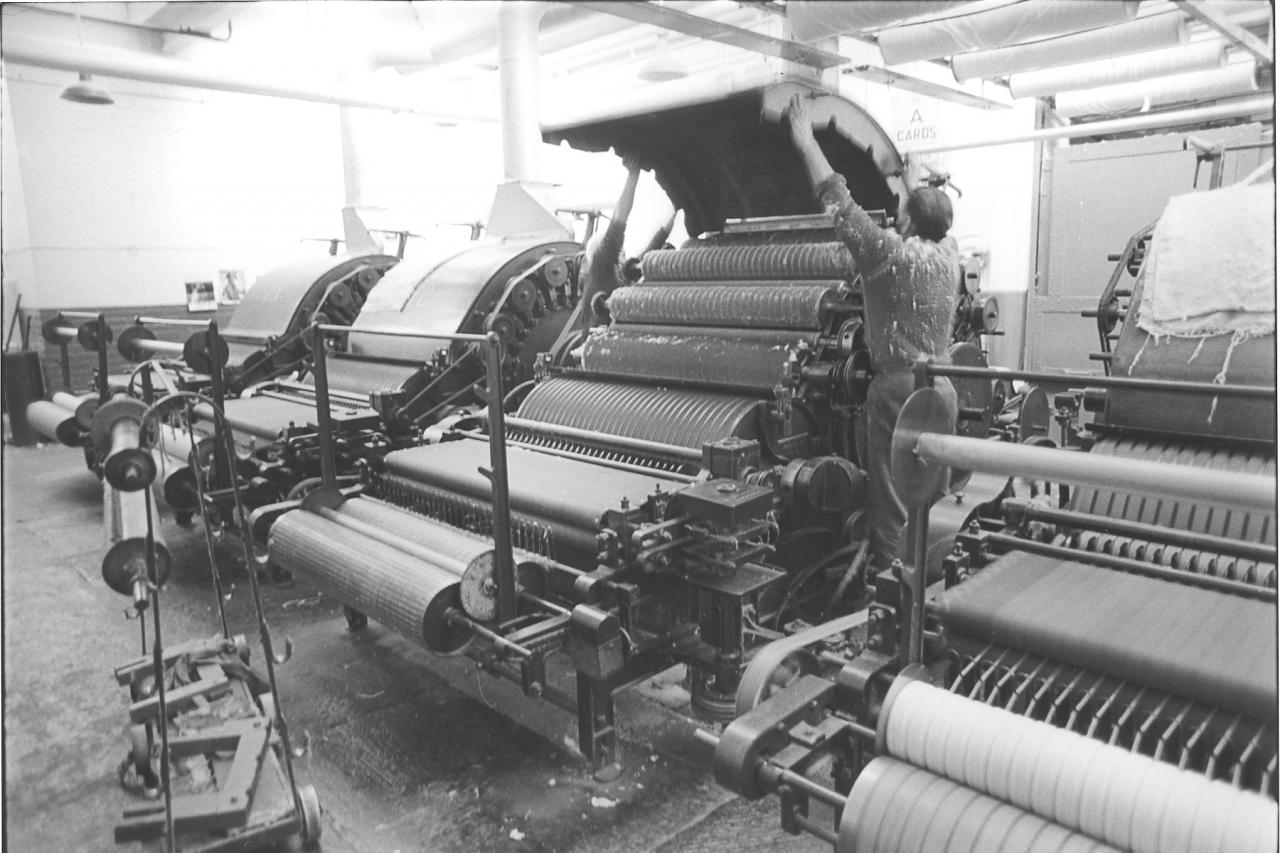
Now that 39.58 they're just putting down the other cover. Nothing much you can say there. Oh and you can see now they’re back on the horse now, and this other saddle's back on the bottom of the horse.
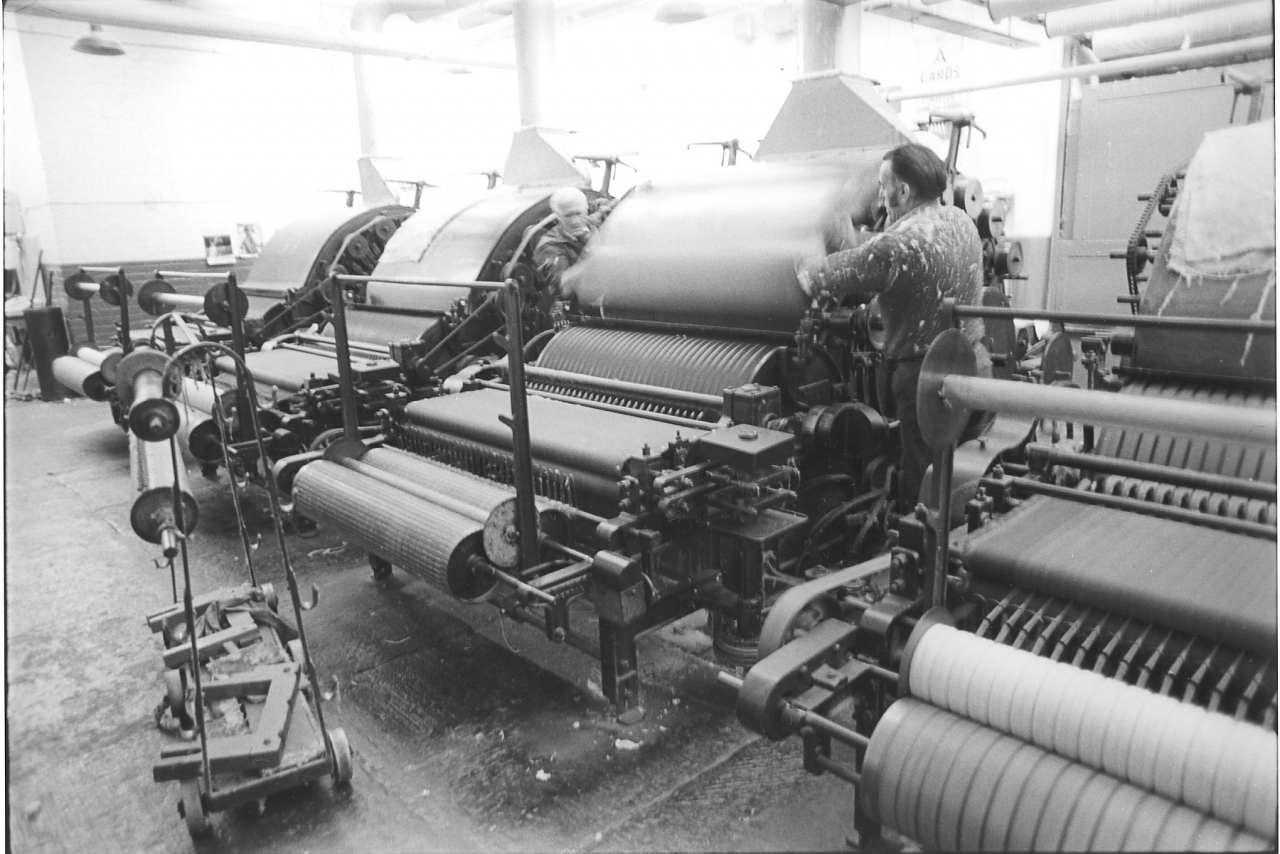
Now in 39.59 they're just completely shutting the cover down now on that card they've finished grinding.
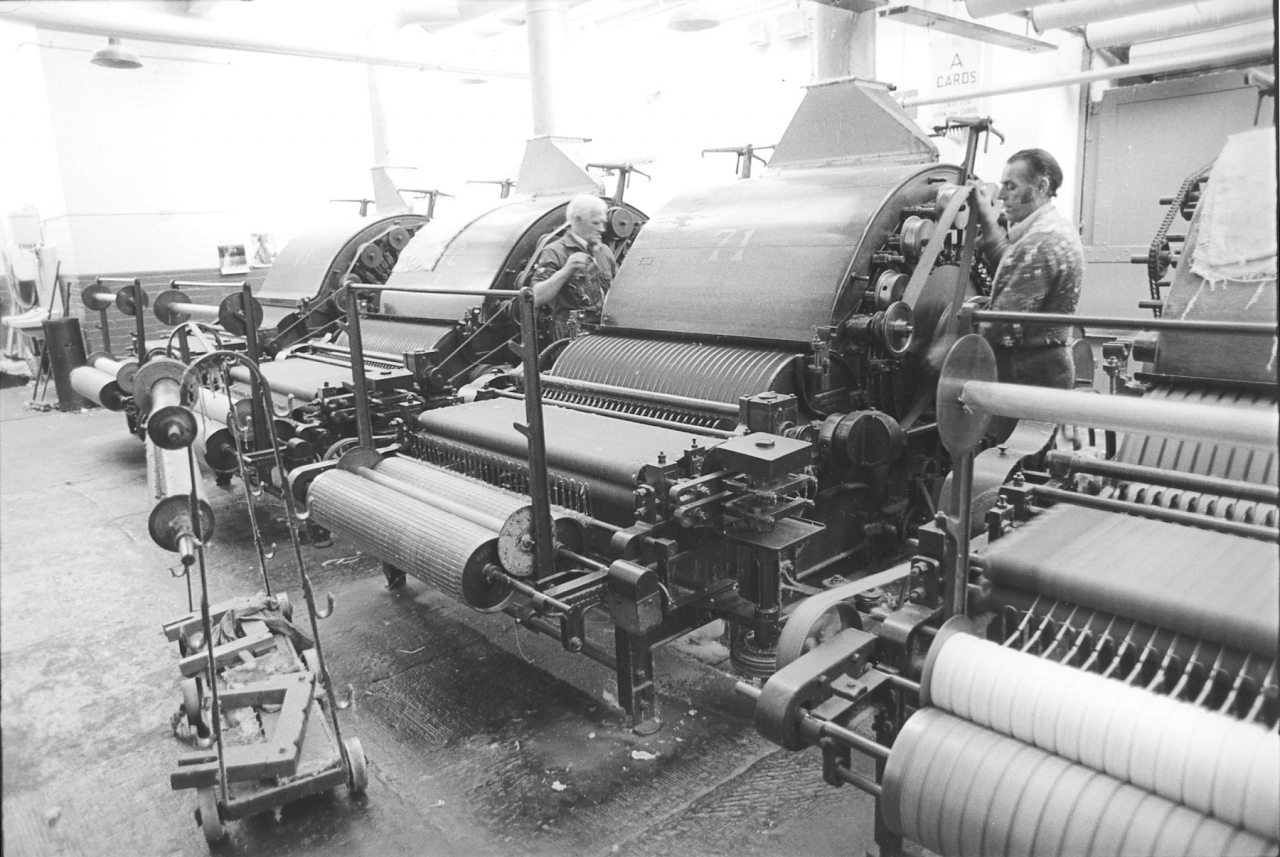
Picture 39.60. There you see Charlie’s on one side now he’s got hold of a chain. Now they go on to your rollers, they have a chain drive with ‘em being bigger and stronger, they need a chain to drive them. When Bill, on the right hand-side here, he has the belt ‘cause them are awkward because if you try, only put a half one you know, just put them half way over the flanges and don't push them right on you’ll never get it on, you just slightly go on the flanges and go to the other side and get it on then push them all on at once because if you push all the, right to the end of the flanges to start with, it's not long enough to go over the flange at the other side.
Presumably when running those belts are perfectly tight so it's not easy to drop them in the first place.
R- Yes, they’re tight. Now the chain's a lot easier, because you've got a weight you can slacken it off with, you lift the weight up and your chain’ll go on, then you drop the weight down it pulls your chain tight. But again you can’t see it ‘cause he didn't take a photograph of that side.
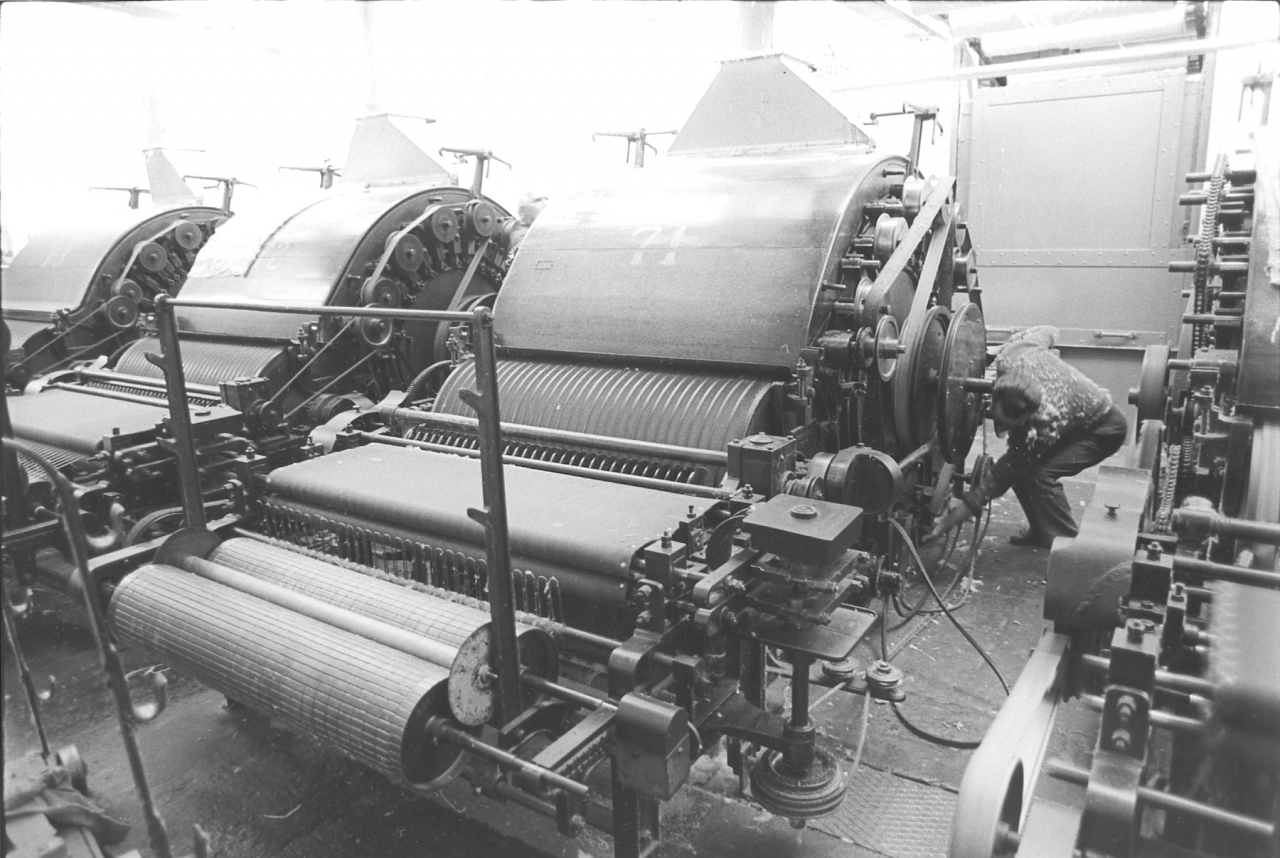
Now on this 39.61 you can see Bill's just starting to put the ropes back on. Now the ropes are, they drive from the bottom of the front of the card and go round the cylinder, the wheel on the cylinder on the end there. There's a fair size rope on ’em on the quiet ‘cause it's surprising what distance they have to do. I think they are about ten or eleven yards long so they cover a fair bit of distance. (250)(10 min)

[39.62]
39.62 now. Now there’s 39.62 and 39.63. They’ve been misplaced, they go before 39.40. And it's again, just as he's taking the clearers up to be ground in 39.62, again he's just studying which one he's going to do first. Like some people start at the top and some start at the bottom and some even start in the middle. Now a lot depends on which he thinks is worst. You normally do your worst first, so you're easing up be the time you get to the end.
So when Charlie in fact is stood right by the grinding frame, and the card that we can see here is a completely different card. Right?
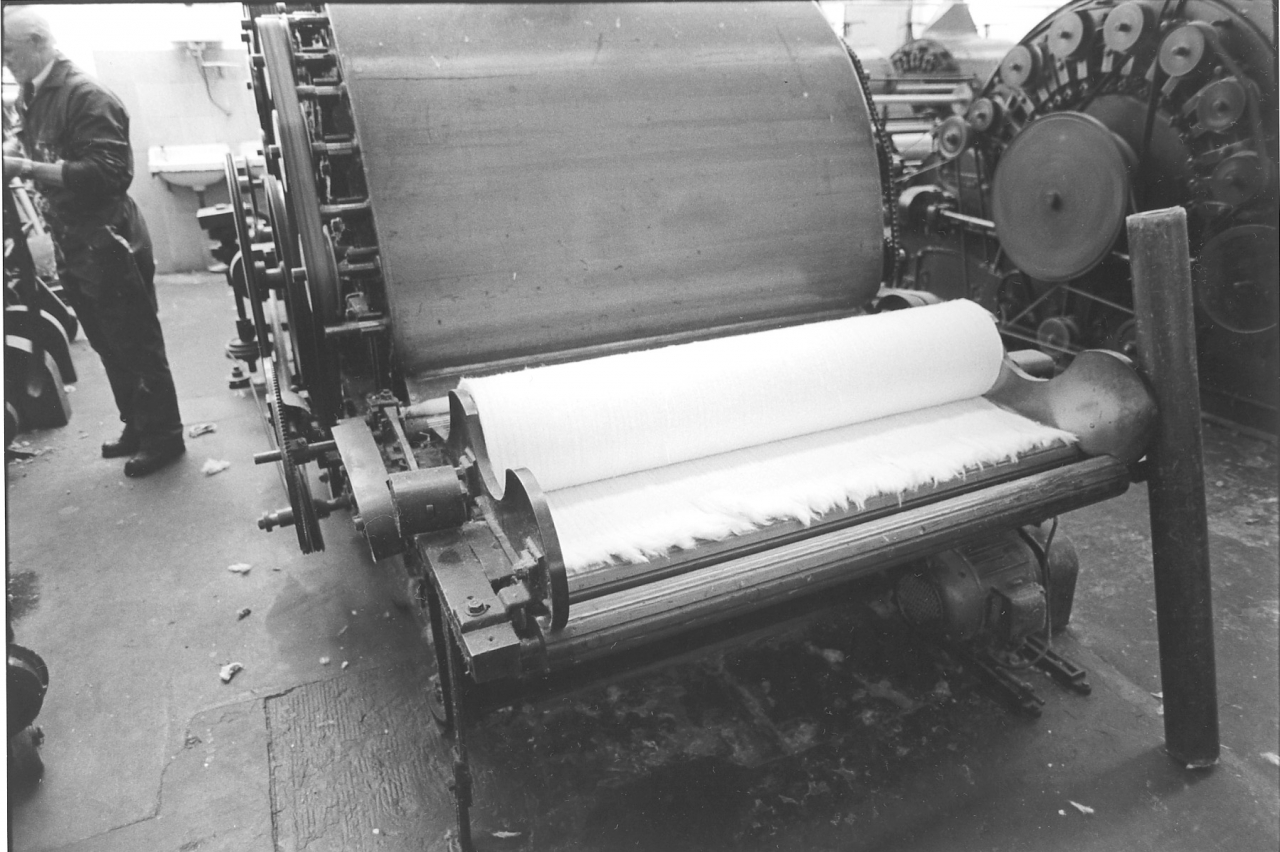
[39.63]
R – It’s a different card. Now that one, they are carding you see, they've taken the lap off the roller and you can see the ends ending now and they are all different lengths. Then you can see 39.63, you can see they've levelled them off. Well ... we'll leave them, the two pictures that follow 39.40, there's nothing more you can say about them. You’ve really gone over that part on the grinding frame.
Right.

R- Now your 39.64 continues from your 39.63 where they’ve straightened up the card and you see .. he's put another lap on the back of the card there. You see you’ve tucked it under so it shows where it is and you know where to piece it up to. And you see he's level ..
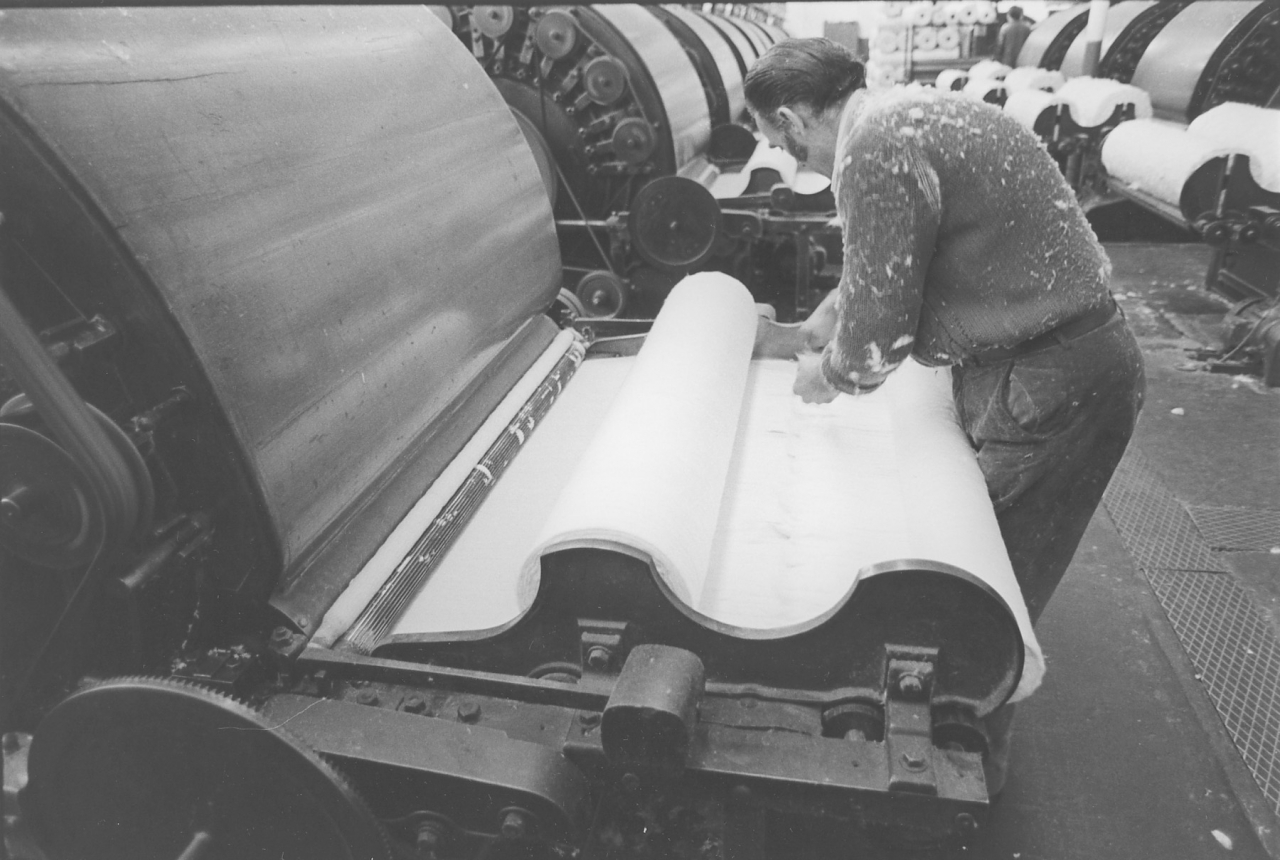
and 39.65 he's actually levelled it off with, They’ve tucked it through your end, the end of your lap, you've tucked it through the one on top, so you can see where it is. No good letting it go through and just having to search through it to find out where the end of your lap is. You, you tuck it through so when you're fetching that next lap then, like you know roughly how long it'll take to run through. So you'll allow yourself that time if you, like you might have another job to do before you come back to it. Like it’ll take about ten minutes, five or ten minutes to run off that from hanging down to go in through. Where if you tuck it through you know where it is, when you fetch your next lap you just open your lap up till you get level with where you broke off.
I’m with you. Well it's already down, we are on 39.64 isn’t it. I can’t see it hanging down.
R - No, it's on the top now, you can just see it in the middle there. Where his right hand is there’s a lump, that's where he’s hung it through. Like normally they'd let it go until it's on this other side. See, a lot depends on how much time they’ve got. If you’ve plenty of time you put it on early like he’s doing in that one. In 39.65 in fact you can see he’s, you can see roughly where he's levelled it off there as well. And I think that's your lot for the new grinding frame and your putting your laps on.
Well you've worked hard Roland, you've worked hard.
R - Well you’ve worked hard to listen.
Well I hope you've enjoyed doing it and I’m very, very grateful for you giving up your free time to do it. Thanks very much and I hope someone in the future will be grateful too.
SCG/05 July 2003
2,183 words.
